The Friesian horse and Friesland
Coincidentally,
the province I live in, which makes me proud
![]() I grew up with
those horses.
I grew up with
those horses.
Many weekends I could be found among the Friesian horses at the marina on the IJsselmeer in Hindeloopen. Entire groups stood there with their foals. Popular
by water sports enthusiasts and the village is a well-preserved, authentic harbor village on the IJsselmeer. Also 1 of the 12 'pearls' of the Elfstentocht skating tour.
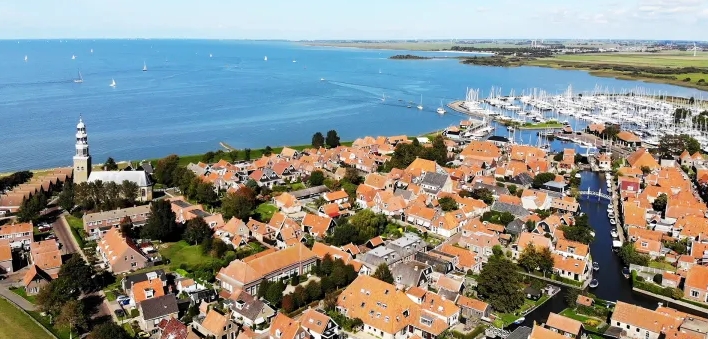
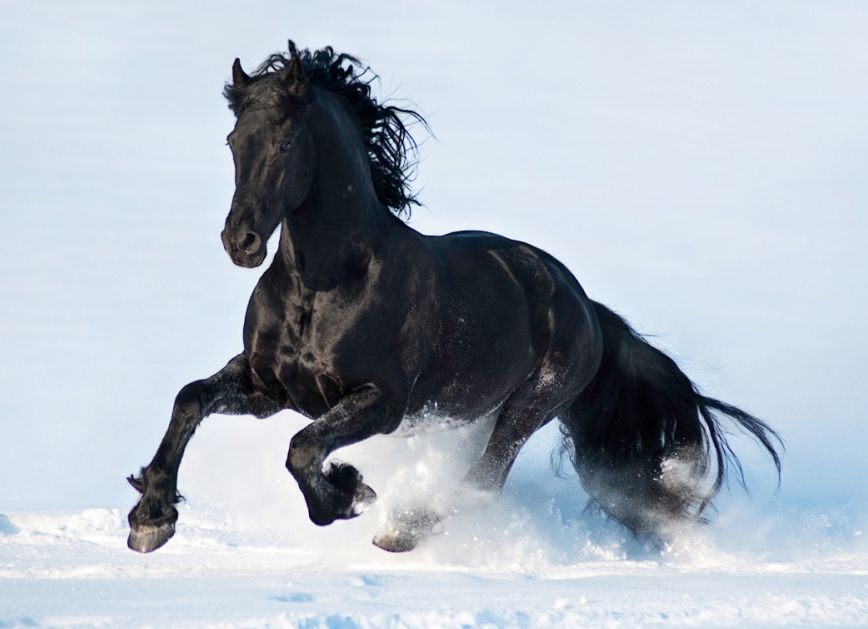
Proem
On this site you will find almost everything about the Friesian horse and the Friesian province. It's about who rode on Friesians in Crossbow. Also people who have a close
relationship with these horses or who have entered into a large partnership in sports, theater or film or musical.
Although the Netherlands is small and divided into 12 provinces, 1 northern province is quite large. There have been times when the province wanted to separate from the Netherlands.
Friesians are a sober people and have their own strong way of doing things.
There is also quite something to say about it and then I have left out a lot. This link has therefore become quite large. Why? There are many (Friesian) horse and culture lovers from over the whole world.
I sometimes receive emails from teachers for teaching material and children who giving lectures. I'd say ... read what you like and skip what you don't find interesting.
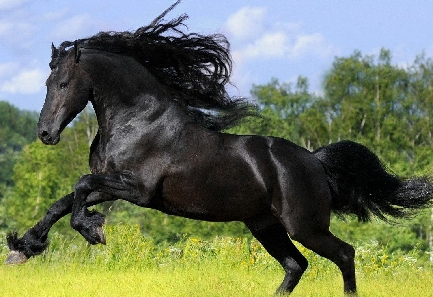
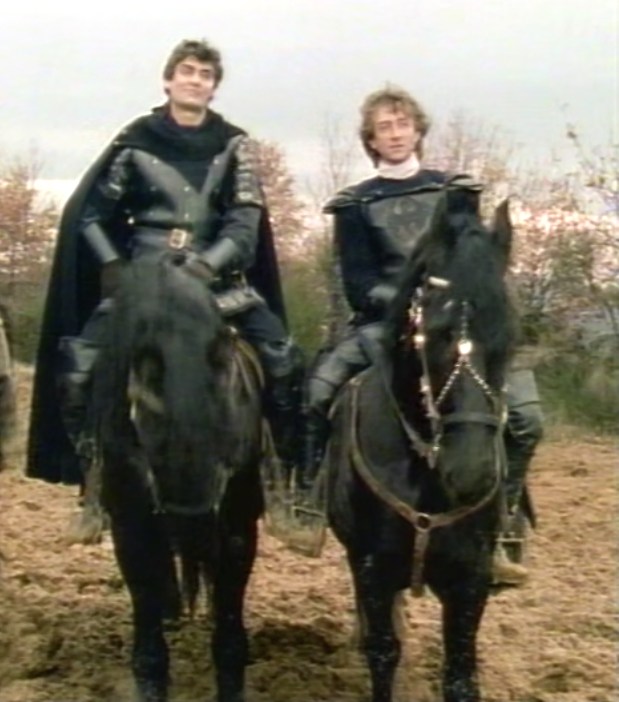
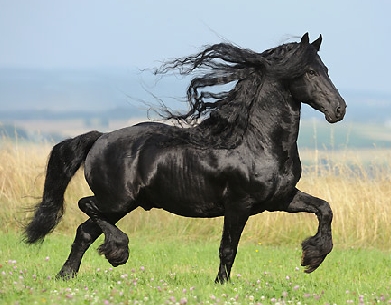
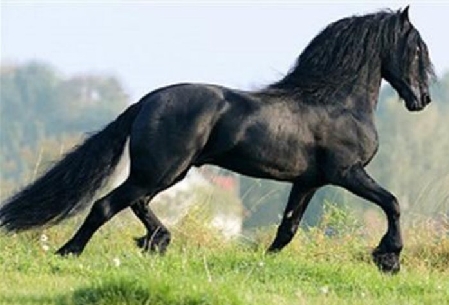
The Friesian horse, the history and the commitment to Fryslân (Friesland). This province is one of 12. It's located in the north of The Netherlands and is unique. The tracks of the Friesian horse in history goes
back to the Middle Ages. In old texts the breed is described with the same admiration and appreciation as nowadays. At the moment, the Friesian horse is the oldest studbook in the Netherlands and is
far beyond the national borders of Friesland immensely popular. There are 70,000 Friesian horses registered at the Royal Fries Horse Studbook (KFPS) and the breed is in 72 countries represented.
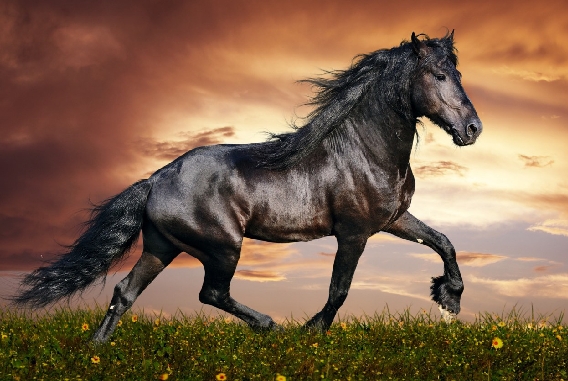
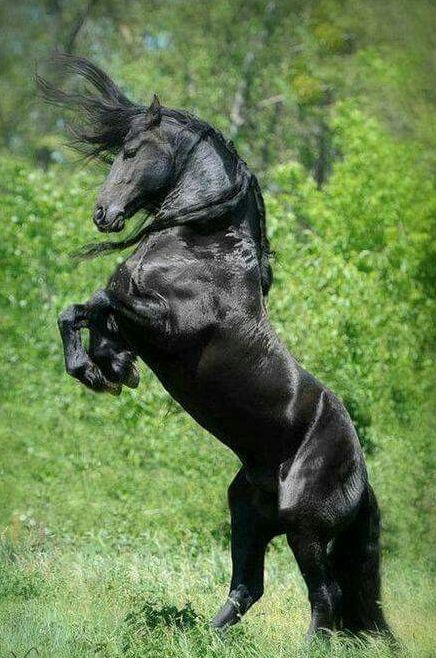
In the nineteenth century the trotting sport became popular and breeders tried to improve the already high grazing trot by crossing with trotters. This made the Frisian even lighter and less suitable for farm work. In
the sixties, the Friesian horse was threatened with extinction. Only a thousand horses were still registered in the registers of the studbook. Thanks to the efforts of a small number of breeders who wanted to keep the
Friesian horse, there is no cross with other breeds and we now have a Friesian horse. In 2003 there were even forty thousand Friesian horses. The breed has gained worldwide recognition and popularity among horse lovers.
Nowadays, the European Arabo-Friesian Studbook (EAFS) is breeding a small part of Arabian thoroughbred in the Friesian horse, to make them more suitable for the sport.
Arabo-Friesian horses are not included in the Royal Friesian Horses Studbook (KFPS).
Wikipedia
The Friesian Sporthorse is a Friesian crossbred of sport horse type. The ideal Friesian Sporthorse is specifically bred to excel in FEI-recognized sport horse disciplines.
Thus, "sporthorse" refers to the phenotype, breeding, and intended use of these horses.
While some consider the Friesian Sporthorse as a breed and others consider the Friesian Sporthorse as a type, others sometimes use the term "Friesian Sport Horse" as a generic
all-inclusive term to describe any Friesian crossbred. Friesian horses inhabit royal stables and they are used in films.
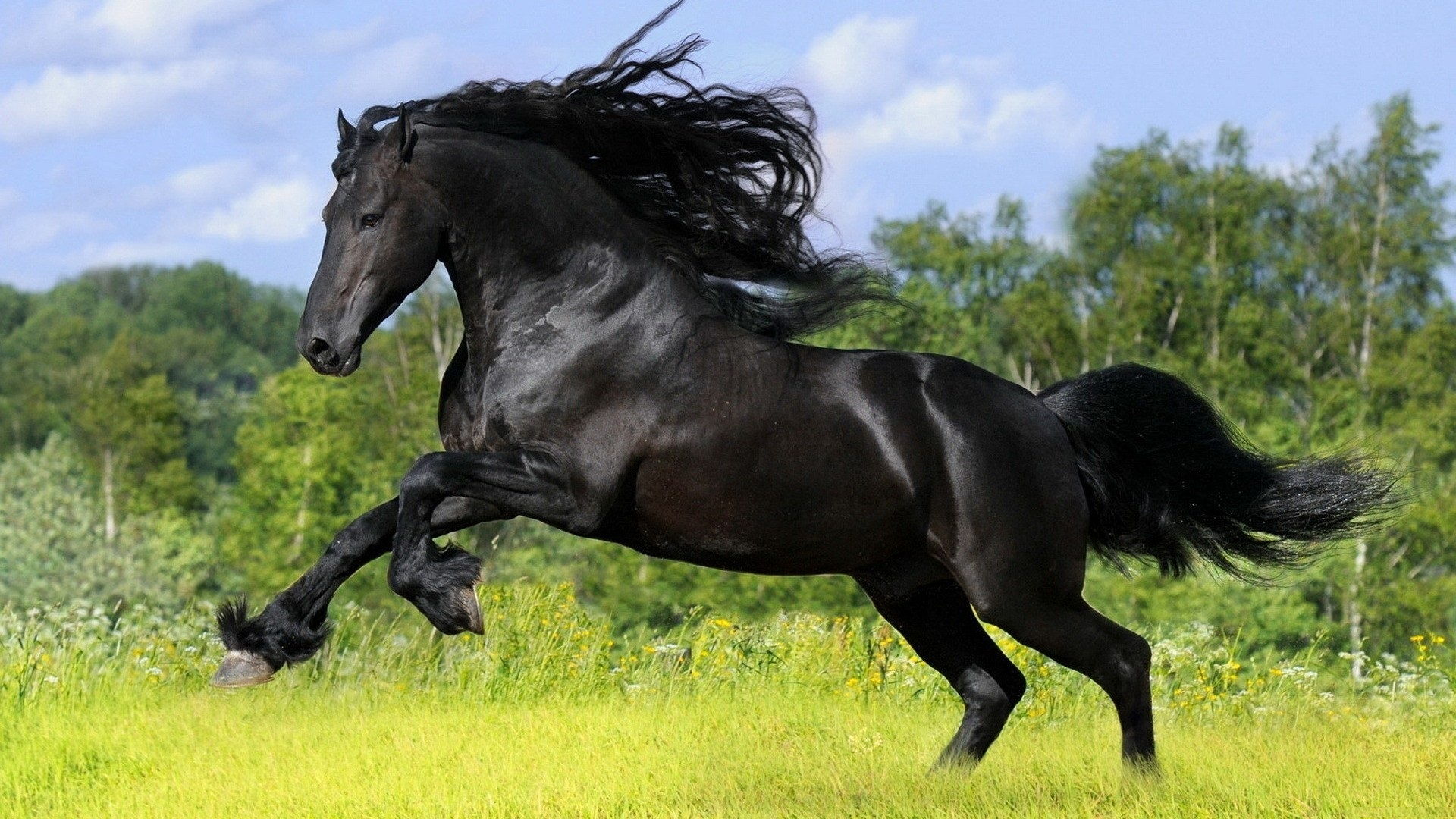
Black Gold
In 'It Swart Gold' program maker Piter Tjeerdsma tries to get an answer to the question why the Friesian horse is so popular all over the world. Artists are also inspired by these horses. The series
It Swarte Goud (The Black Gold) tells about the history, future and the succes of the Friesian horse. There is filmed in several countries like France, America, China and South-Africa.
In this documentairy you can also see the search of the Friesian horse from the film 'Legend of Zorro.
The documentary 'It Swarte Gold' about the Friesian horse has been selected for the Equus International Film Festival in New York. The festival for films about horses will be held in April 2017.
His roots go far back in time. Already in the 13th century the Friesian was known and the horse still shows similarities with his distant ancestors.
Below: The Friesian Flag. These are no shapes of hearts but red leaves of the white waterlily. But in a way you can see it as 'hearts' because the Friesians are proud people.
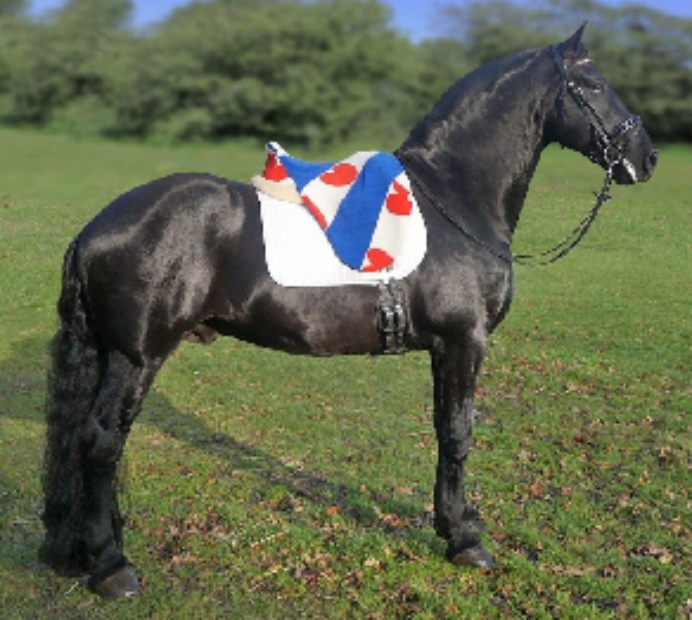
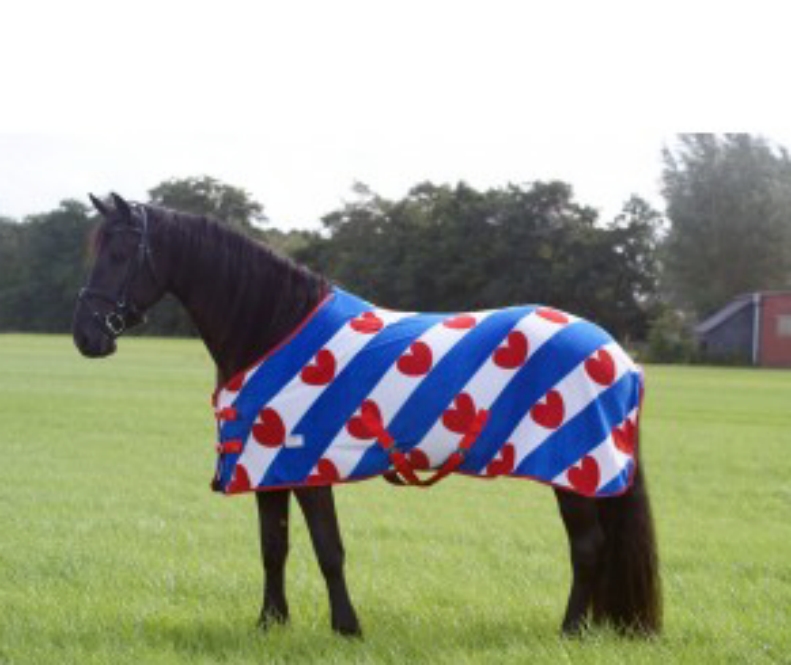
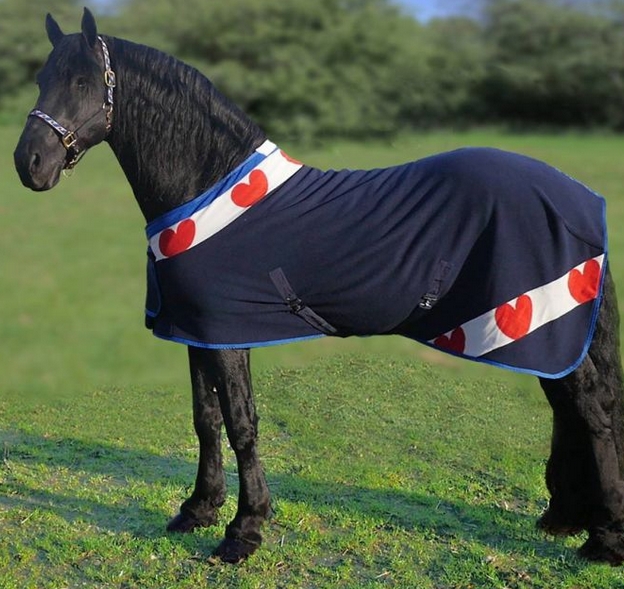
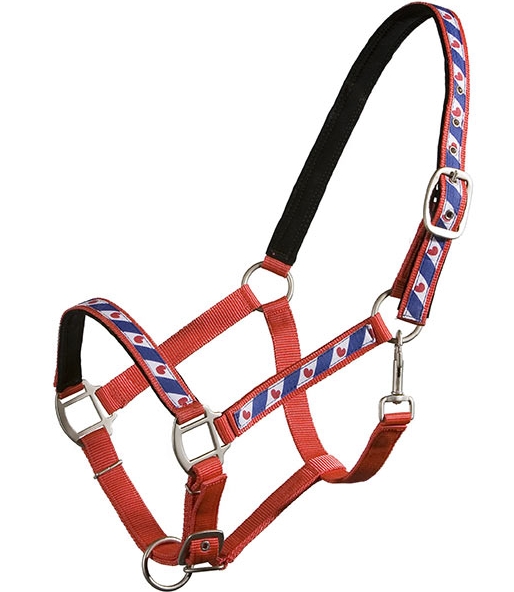
Friesian horses were probably used more than three thousand years ago. From sources it appears that the Romans greatly appreciated the breed. They took the Fries as a war horse for campaigns in Britain.
In the Middle Ages, too, the Friesian was used mainly as a hare. During the Eighty Years' War, crossings with Spanish horses, mainly Andalusians, resulted in an active and versatile type of Friesian.
the family film “Albion: The Enchanted Stallion” tells the story of 12-year-old Evie Flynn (Avery Rath) and Dag Dia, a kind, beautiful and powerful stallion who changes her life. Producer Dori Rath and
writer/director/actress Castille Landon, both life-long horsewomen, knew they wanted to cast a Friesian for the role of Dag Dia. Landon explains, “Growing up in the horse world, everyone wanted a Friesian.
They were universally admired.” Source and the search to mayestic movie horses.
Friesian horses on TV or in the cinema.
Due to its flashy appearance, the Friesian horse has become popular in the film industry. The breed owes much of its current popularity to the appearance of the Frisian stallion Goliath (real name: Othello)
in the 1985 film, Ladyhawke, who sparked a worldwide interest in these horses. Films such as Eragon, The Mask of Zorro, Alexander, The Chronicles of Narnia, For Greater Glory and The Wolfman
have also characterized Friesian horses. An episode of the TV series Lost contained a Fries / Saddlebred cross. Most recently Frisians were seen in the remake of Clash of the Titans 2010, where two horses named
"Boech" and "Gallo" took turns playing the winged horse, Pegasus, and they were also used in the 2011 remake of Conan the Barbarian. Frisians are also used for the Tribute Parade in The Hunger Games
and in Catching Fire. Below Albion. The Black Gold documentary in Frysk, Dutch and English. Worth watching.
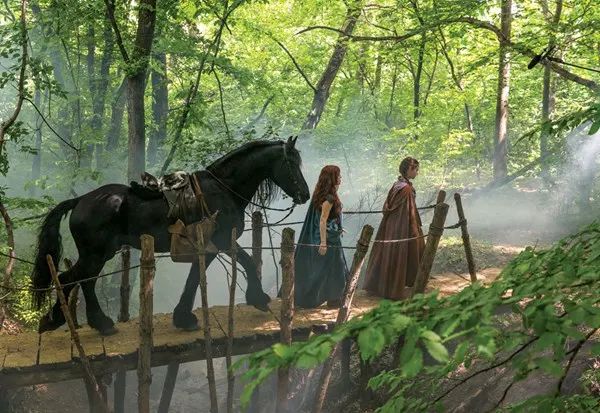
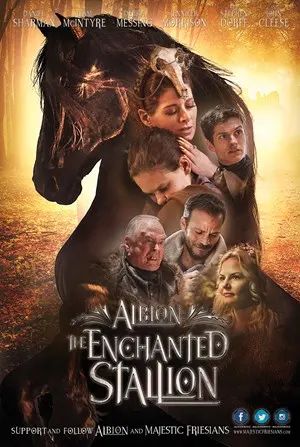
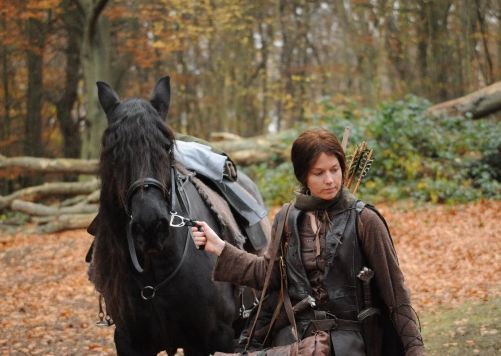
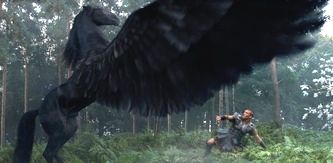
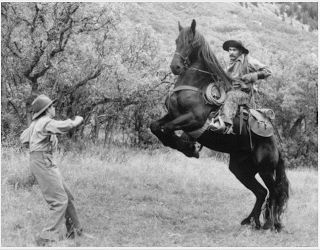
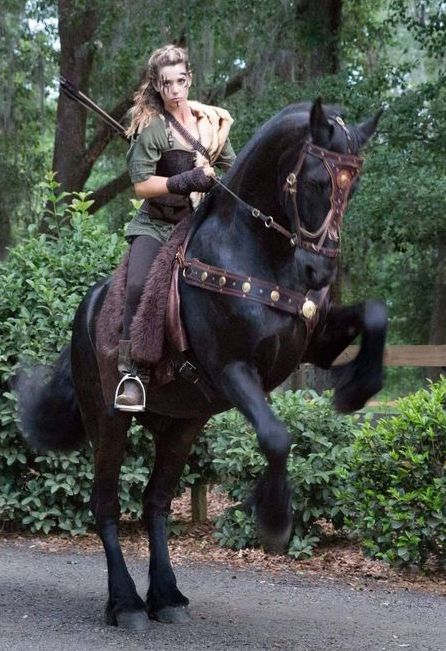
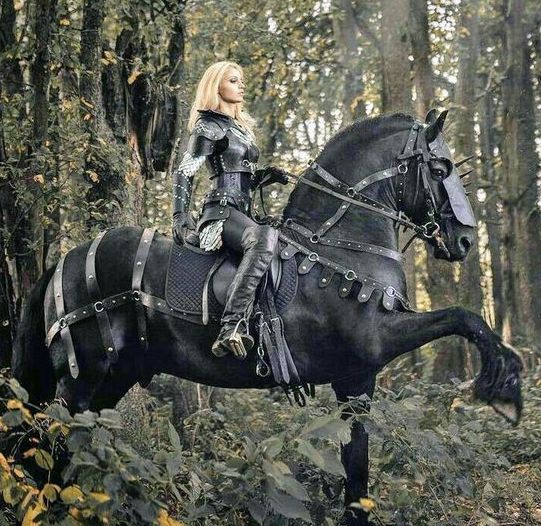
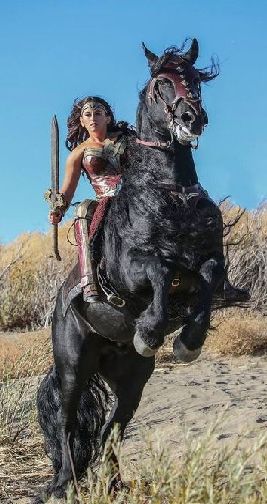
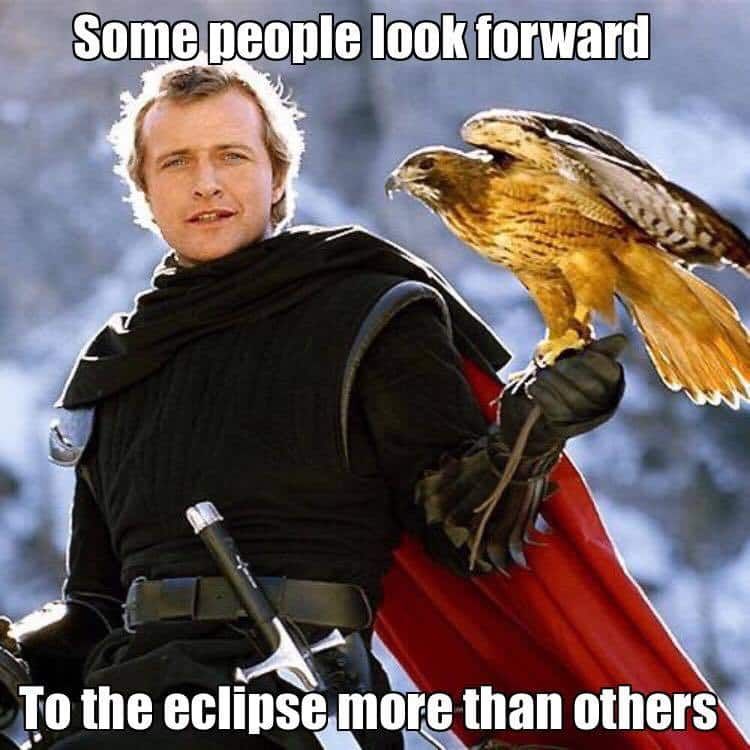
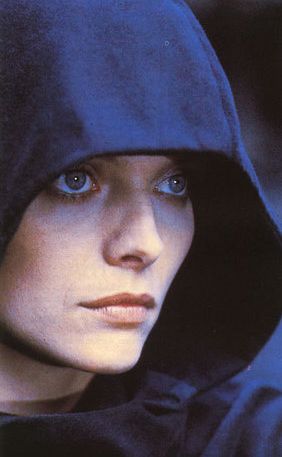
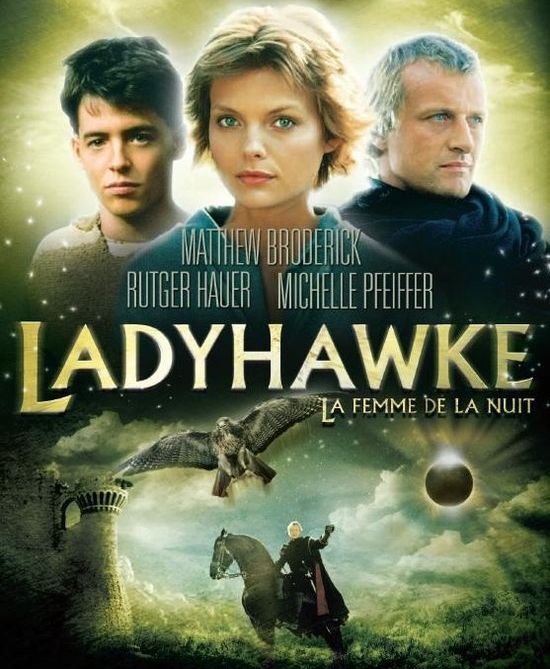
Prince of Persia
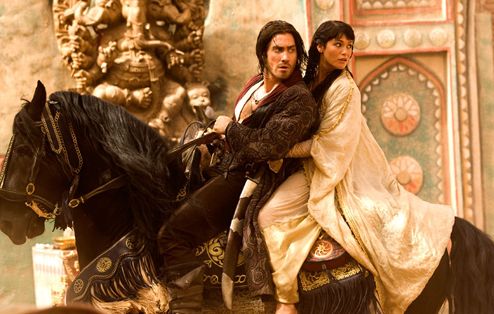
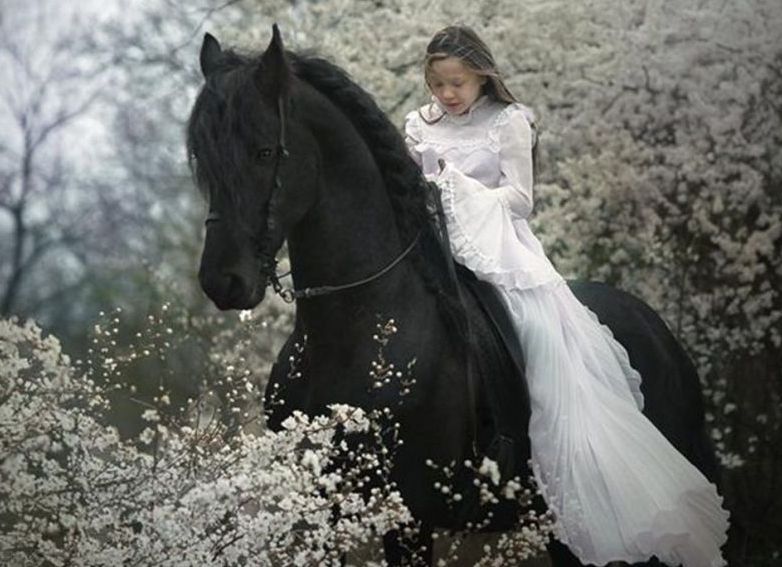
Prince Caspian in Narnia
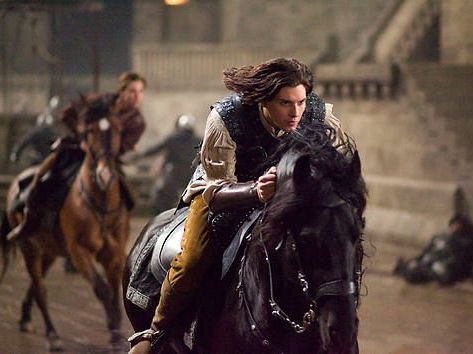
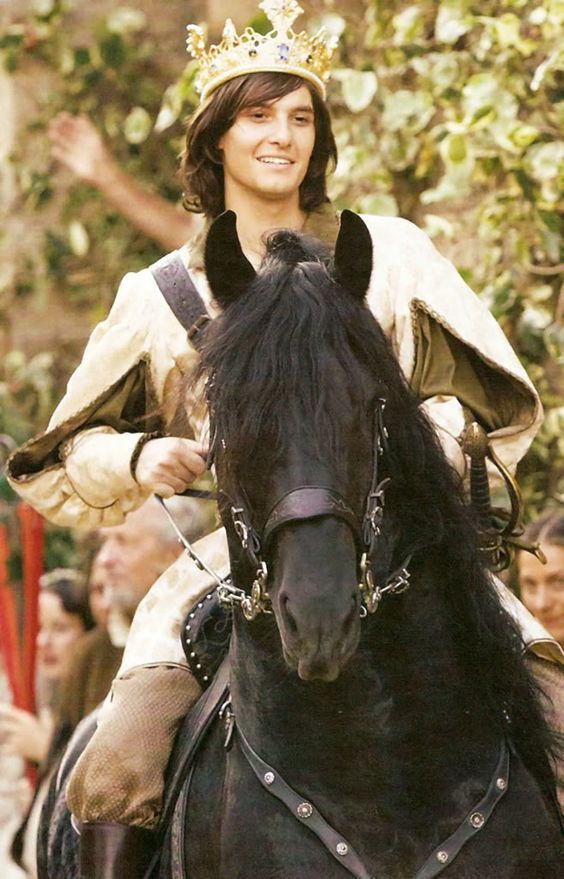
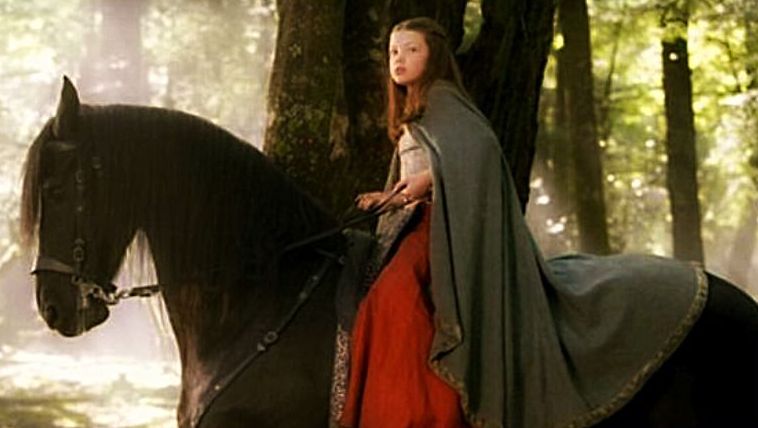
Joe Perry of Aerosmith and the Friesian
Perry and his wife, Billie, moved to their ranch outside of Boston in 1987 and immediately fulfilled a lifelong dream when they bought a Quarter Horse and a Paint.
But after watching the classic movie Ladyhawke, the pair fell in love with another breed — the Friesian. Joe Perry may be the star guitarist in band called Aerosmith,
but he’s also an equestrian. Excerpts taken from People We Know, Horses They Love by Jill Rappaport and Wendy Wilkinson.

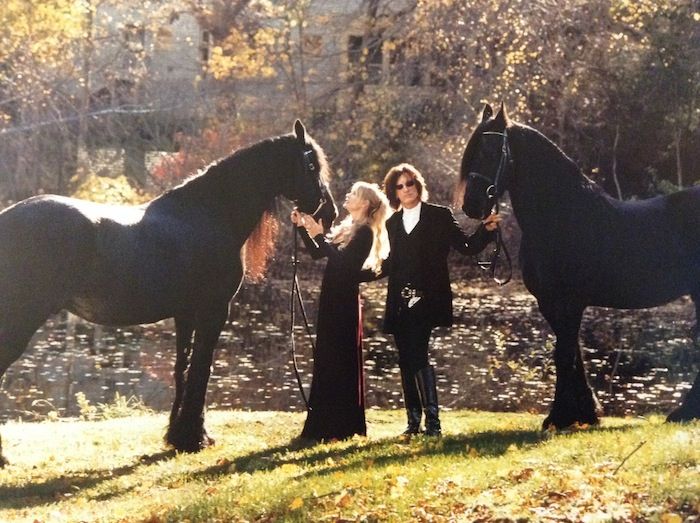
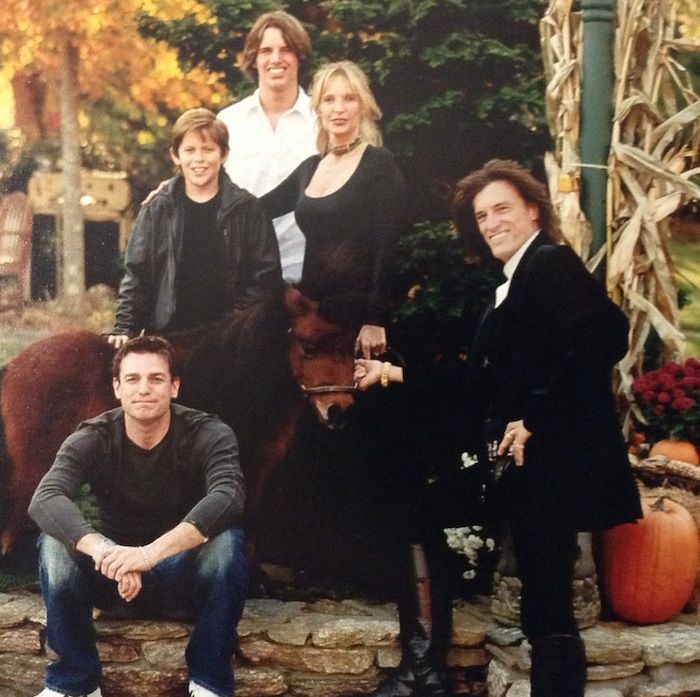
Finding a Friesian in 1987 America, however, proved difficult. Joe told People We Know, Horses They Love, “This was before the Internet, so it took Billie and I a while to see one in the flesh.”
The chance would finally come in 1990, when the band was on tour in Nashville, Tennessee. Afterwards, finding Friesians while on tour became a hobby for the rock star couple.
Their first Friesian purchase was made at a dairy farm in southern California. Billie states, “Magnum was the horse that Joe rode for years. Then we got Nico…. Our next Friesian, Orien,
was two years old when we bought him. He was a half brother to Nico, and we have had him for 13 years.” Joe adds, “To see a Friesian is to love it. Just being around Orien and Franz is therapeutic.
I like coming down the driveway and seeing them greet me. They are artistically beautiful.”
She notes that horses have been an integral part of her marriage as well. “For Joe and I, being with the horses is something that we both love and enjoy together, and this bonding experience
makes our relationship that much more special.” Joe and Billie just celebrated their 29th wedding anniversary, no small feat in today’s entertainment industry. Go Riding!
While reading I found, next to the story of Joe Perry of Aerosmith, also some quotes from Gere and Redford about horses. Not about Fresian horses but I like to share them with you...
Richard
Gere:
Gere is passionate about Appaloosas, bred by the Nez Perce
tribes of the Northwest. They were probably the first selectively bred horses in America. Gere and his
wife Carey Lowell own four Appaloosas. Gere is very active in the "Chief Joseph Foundation," which focuses on the Nez Perce cultural preservation, emphasizing
kids and horse programs. Gere really loves his horses. Rappaport quotes him as saying, "First horses are like your first girlfriend. You never forget."
Robert Redford
"Roy Rogers and Trigger inspired Robert Redford and gave him his passion for Palominos." Redford's love of horses is very
much a part of his being an environmentalist and getting back to nature.
Film
Looking robust and beautiful. A model.The 'Fries' performs well under the saddle too. De 'Fries' has a clear talent for
dressage and he is also widely used as a high school horse in, for example, the circus and movies.
From Xena to Zorro and many other movies with Friesians
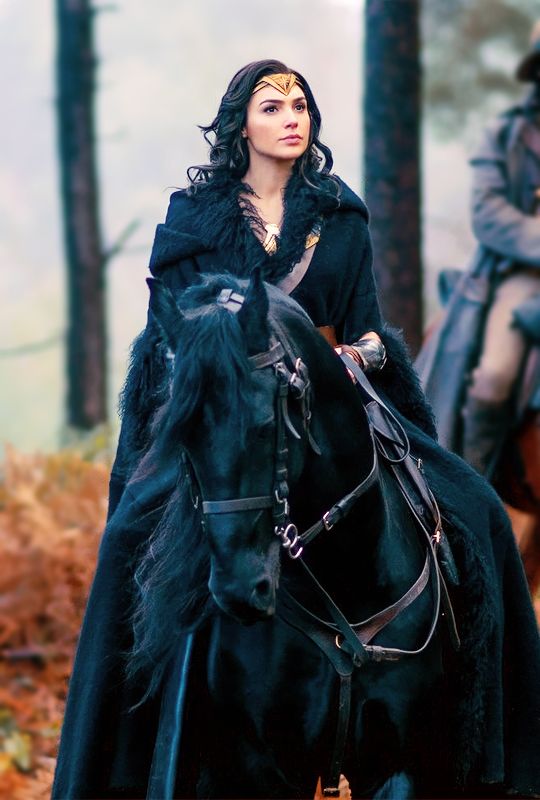
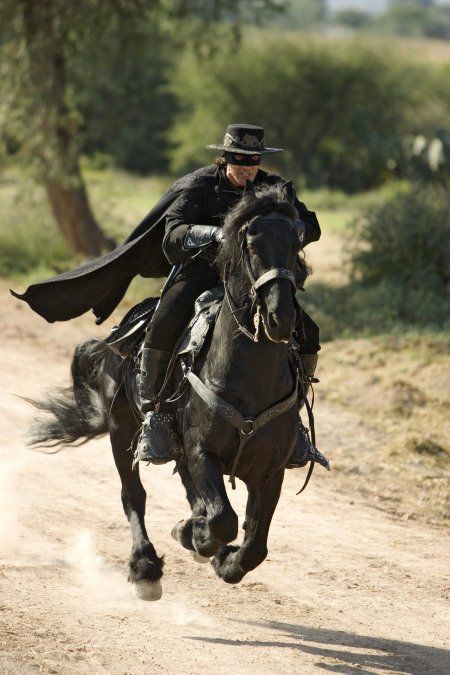
Rutger Hauer
Ladyhawk: Rutger Hauer on a Friesian, sadly he passed away in July 2019 Our Friesian / American Rutger Hauer

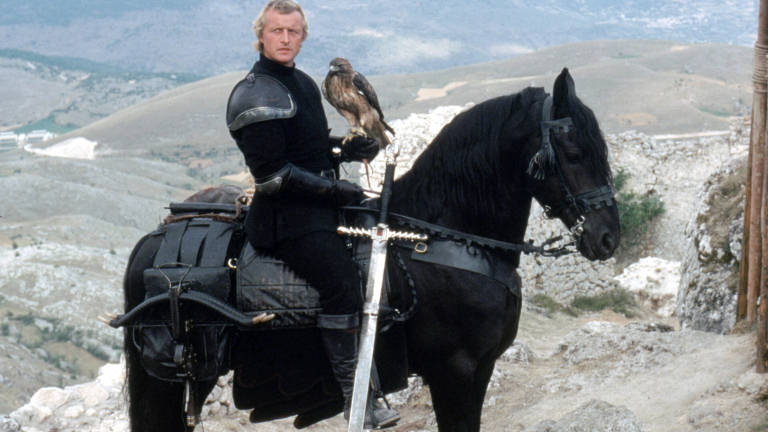
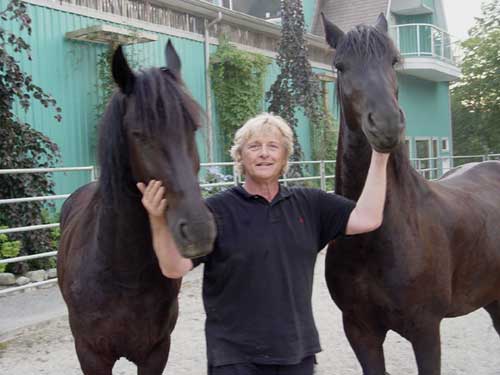
Rutger's was the biggest actor of The Netherlands. While I was working on this link he unfortunately died. He stayed very down to earth. He has played in more than a hundred films,
won a Golden Globe for his role in Escape from Sobibor in 1988, and received two honorary Golden Calves. He used to live a somewhat reclusive life together with his wife Ineke in a Frisian
farmhouse (and he also resided regularly in the US). His funeral was a last journey, he on a black wagon covered with a Friesian and American Flag and two Friesian horses in front.
Paul Verhoeven and Rutger Hauer
These are two links below show a great recent interview with Paul Verhoeven, as a starting director in collaboration with Rutger Hauer. They go back 40 years to the place where they
used to film in Dutch castles with the old cast. I only saw Floris (Rutger as warrior) once, was more impressed by Crossbow ;) but despite not being a big fan, I really enjoyed seeing
Paul and combine the shooting from now and then. First part and Second part.
The Frisians are mainly known from the numbered shows, in which they run for the Friesian shees (see right above and a sled on the left) and are driven by farmers and peasant women
in Frisian costume. The Friesian horse was originally bred as a workhorse that had to plow just during the week and was tensed for the carriage on Sunday when the family went to church.
variety is also used in the American film industry. When used in historical film versions, this is usually not historically accurate, since the breed in its current appearance is not older than four hundred
to six hundred years. The Friesian horse can be seen in Lady Hawke, Eragon, The Mask of Zorro, Alexander and The Chronicles of Narnia, and also in Clash of the Titans, in which two Frisian
horses in turn play the winged horse Pegasus.
Me and a Friesian horse
My daugther, Me vacation job in my teenage years
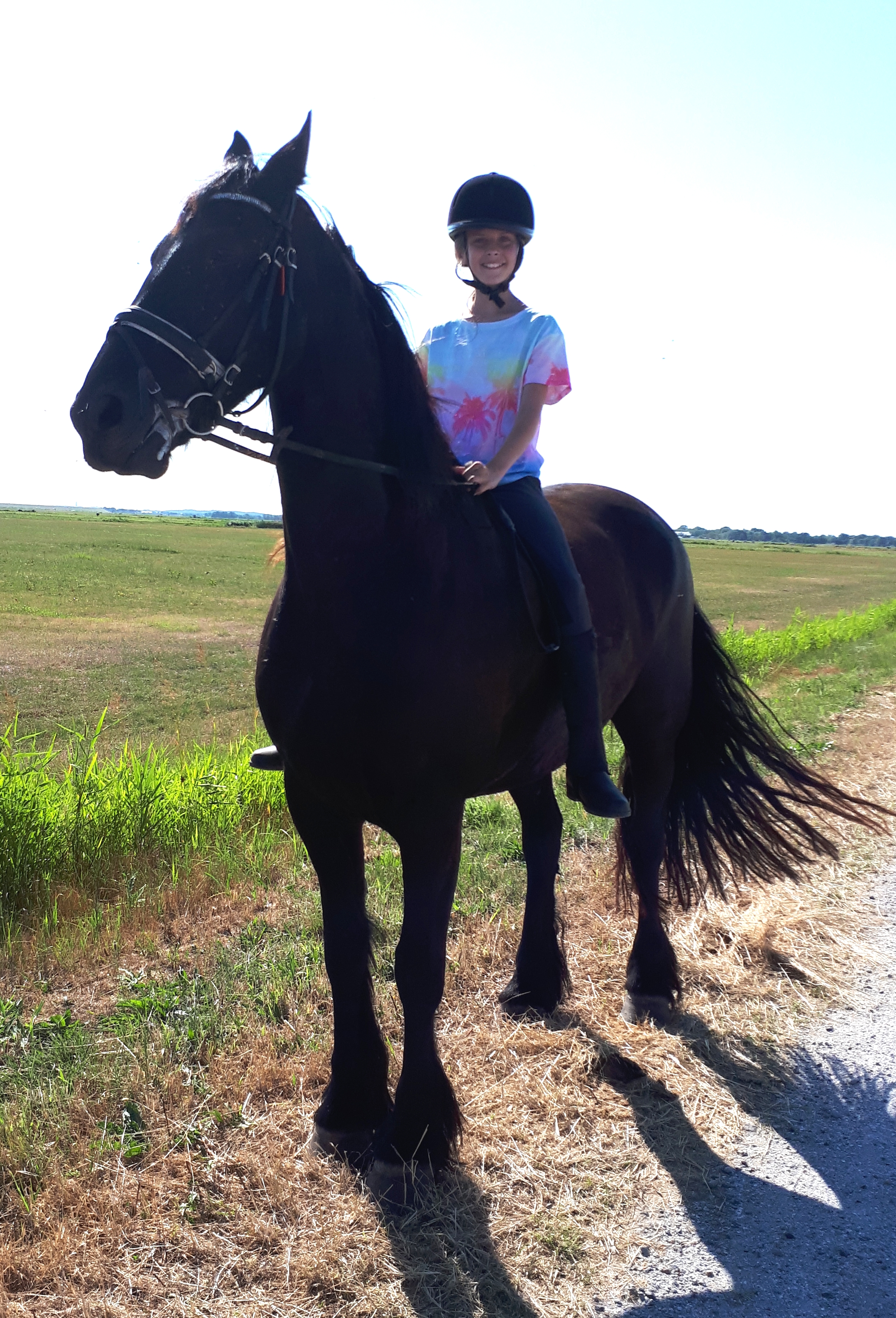
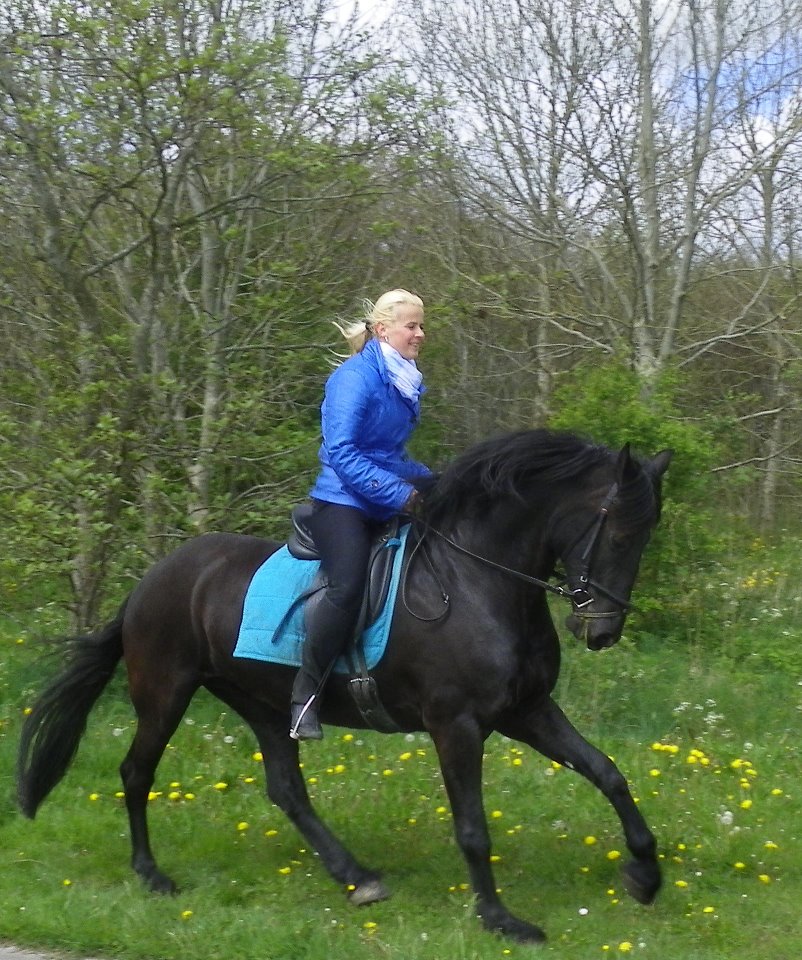
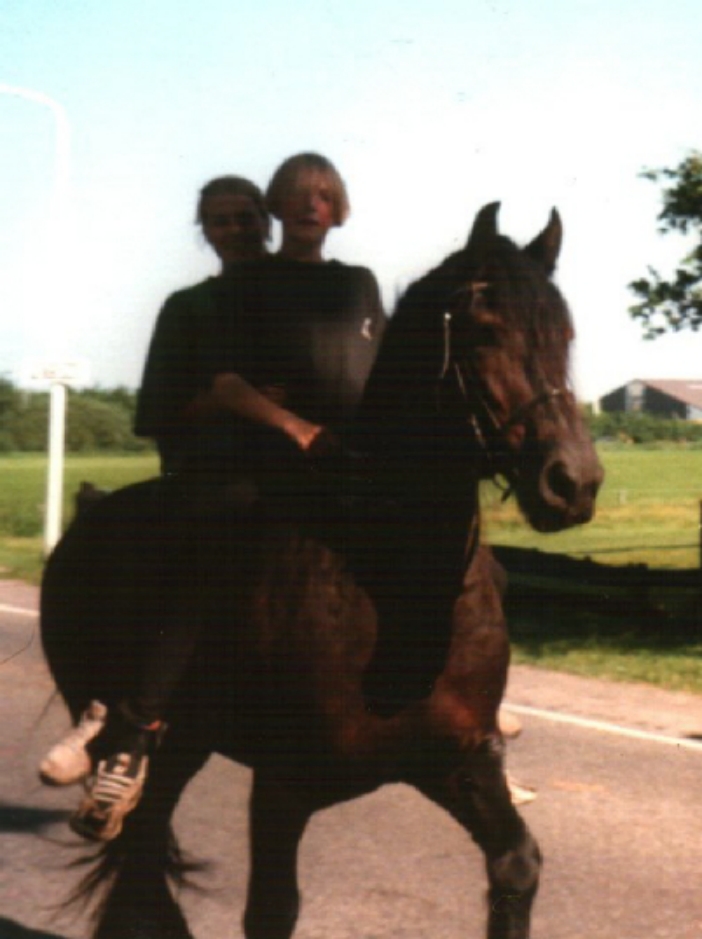
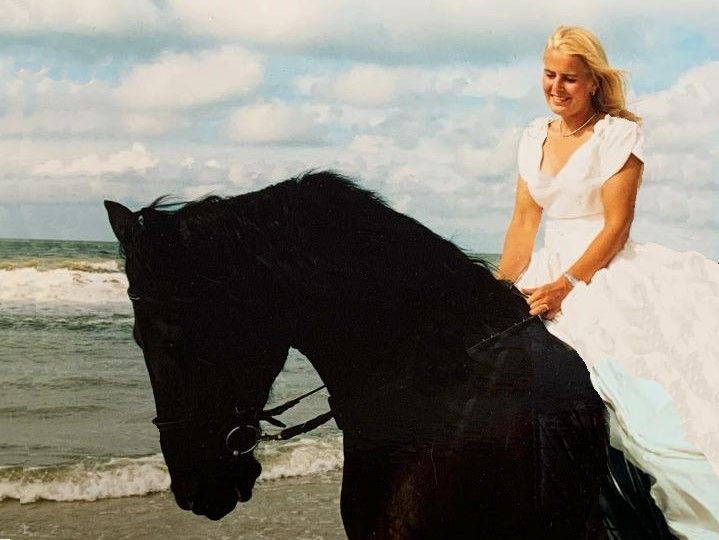
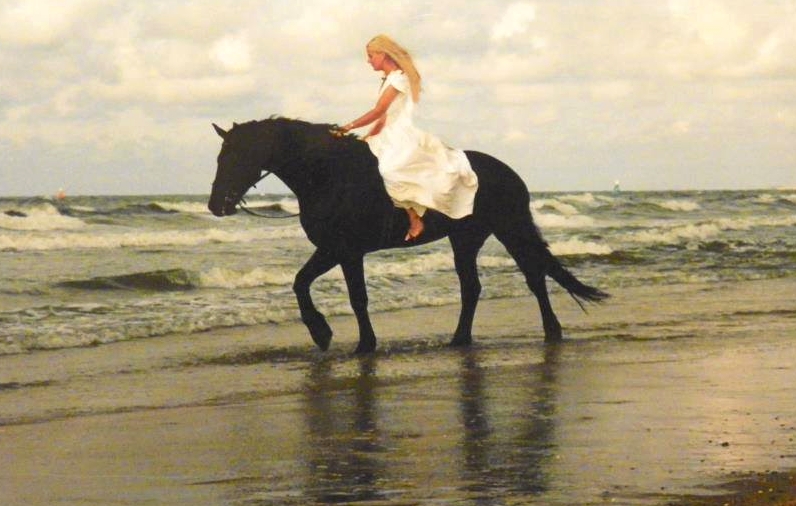
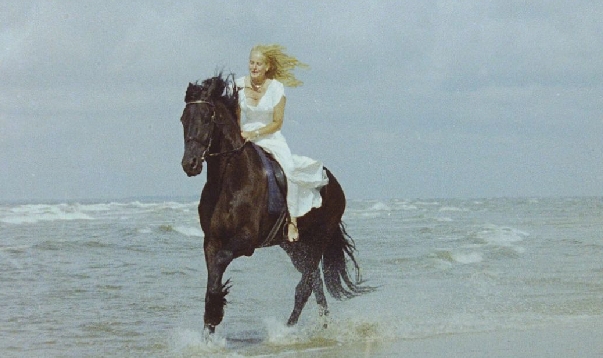
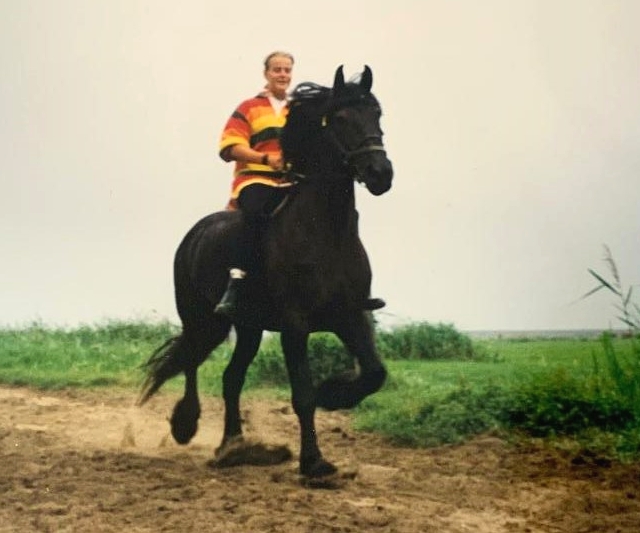
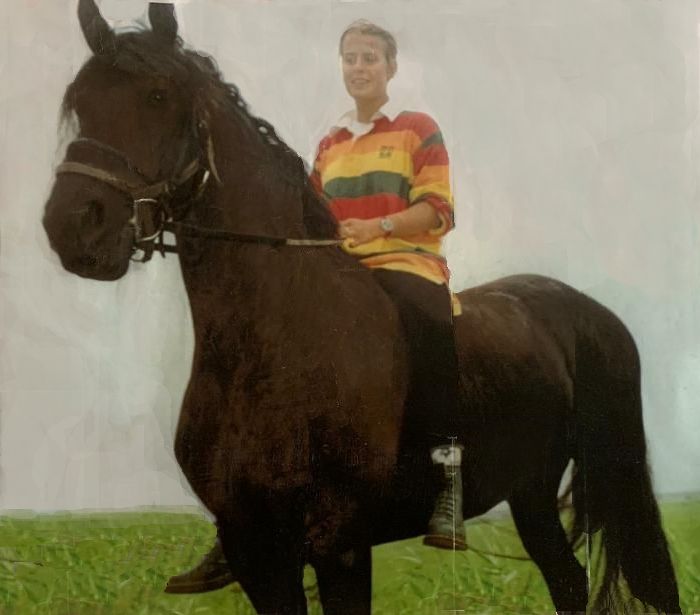
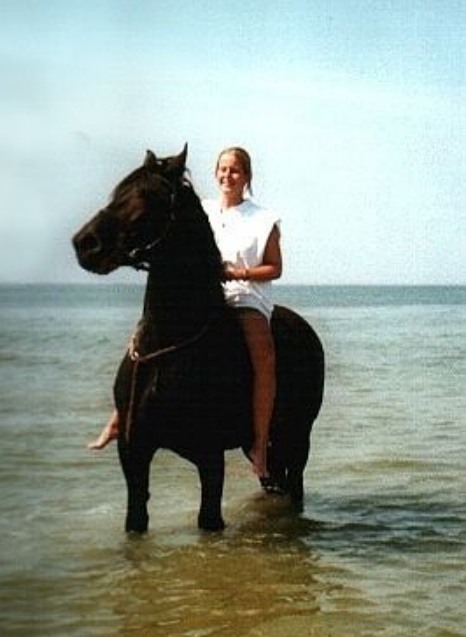
Movement
The Fries has a large and high movement, for some characteristic, that combined with a nice character, and people never want another horse, but there are
also people who less appreciate this same movement and choosing for a finer dressage horse. For me i like the horse but not for always, variety is good too.
Anatomy, appearance and character
De Fries is friendly and lively, smart, intelligent, eager to learn and loyal, and a willing worker. The Friesian horse also has a cool head and is therefore suitable for
recreational riding and outdoor rides and is also suitable for dressage because of the high knee action and its reliable behavior.
The Friesian horse is a graceful looking horse with lots of wallpaper and a proud attitude. The body is compact and strong. Manes: The manes are long, full and wavy, just like the tail.
Head: The Friesian has a fine head with short, pointed and motile ears. Neck: High neckline, long, slightly curved. Shoulders: The shoulders are powerfully developed. Legs: Fairly short, but firm,
long hairy and with sock. colour: A Frisian is almost always black without markings. Markings are therefore forbidden, although a small ball is occasionally overlooked.
Occasionally a very rare brown variant occurs. Withers: Between 1.55 m (for admission to the studbook) and 1.70 m. At the age of three, 1.60 m is considered ideal
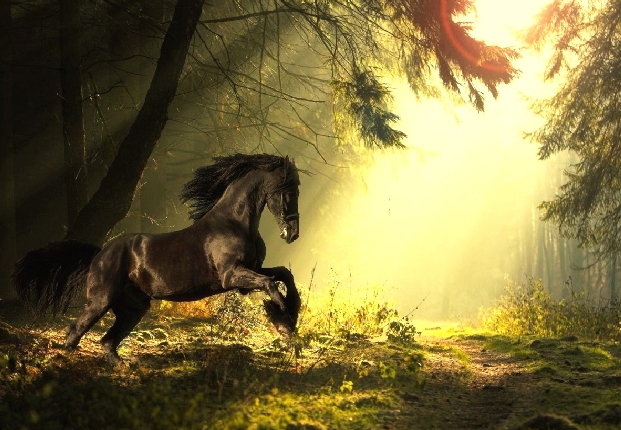
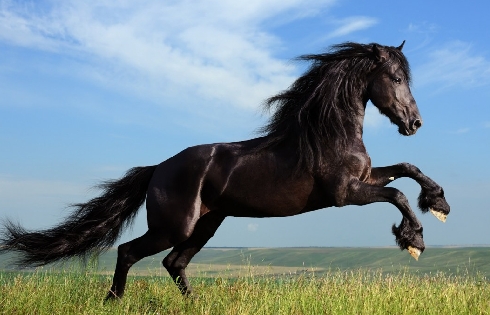
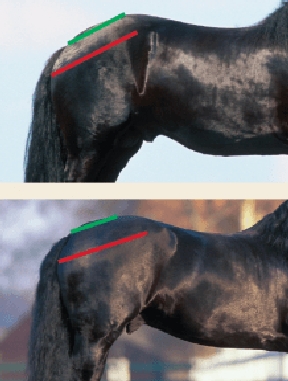
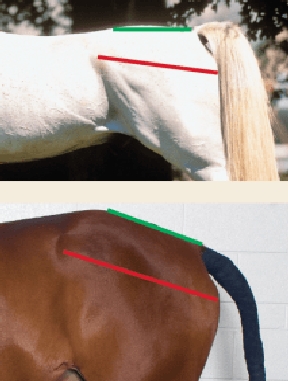
The Fries were originally bred for use in warfare and agriculture. The breed is still popular as a light carriage horse, and the top Friesian photo is an example of the Baroque type used for driving.
Note the steeply sloped croup and pelvis (both 20 degrees) and the consequent low-set tail. The Friesian sport-horse bloodlines, as illustrated by the horse in the bottom photo, are becoming increasingly
popular for dressage. This Friesian sport horse has greater length and less slope in the hindquarters compared with the horse above.
Uses
Friesians today are still used for working on the land, and have become
increasingly popular as carriage and harness horses where their flowing mane and
tail and flashy leg action
make them a popular sight in the show ring. Their docility and willingness to learn makes them suitable for the sport of dressage, as well as being pleasant all-round riding horses.
Frisian horses in sport
The Belgian dressage rider Peter Spahn rode together with the stallion Adel 357 in the international Grand Prix. The stallion Goffert and his rider also participated in a Grand Prix
(in America). The stallion Adel retired after the stallion inspection in January 2009. Peter Spahn is currently driving the Grand Prix internationally with the Adel son Anders 451.
Another Adel son has made it to the Grand Prix in 2010 (Hearke with Kristel van Duuren-Bodewes). The horses Tietse and Ielke are also eligible for the Grand Prix.
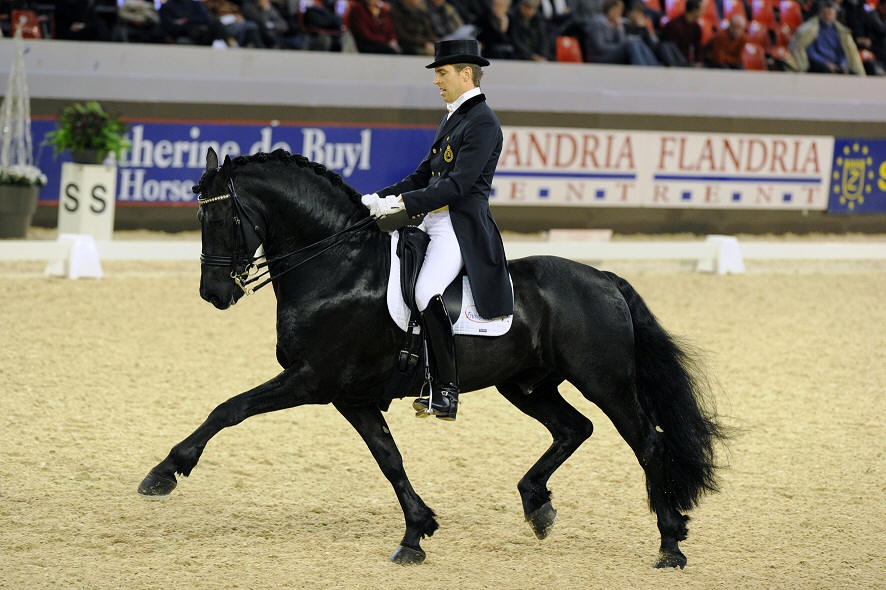
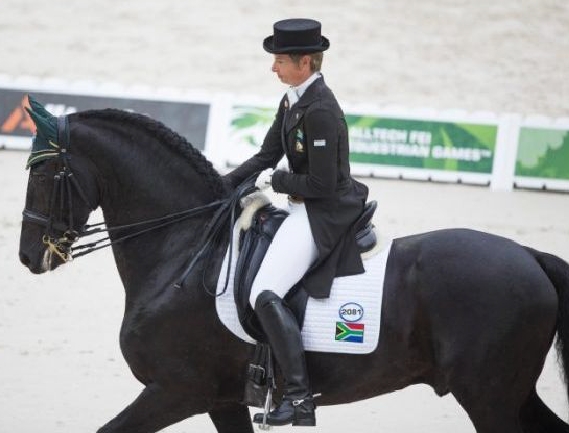
World Equestrian Games in Caen, the South African Chere Burger and the Frisian stallion Adelprag Anders. Together they were good for two "first times": Burger was the first South African to
start dressage and Anders the first Frisian. Anders was still in the Netherlands at that time and had a "long-distance relationship" with his horsewoman, who regularly came to the Netherlands
to train him and bring him to Europe.
Bloodlines
Different registries have different standards that define what is considered to be a Friesian Sporthorse. One registry regards Frisian Sporthorses as a breed, with strict breeding requirements in addition to performance
recognition. In this case, Frisians are crossbred primarily with warmbloods and Thoroughbreds, although limited percentages of American Saddlebred, draft and Arabian breeding are also acceptable into lower books
of the studbook.
Other registries contend that "sporthorse" is a type, and rather than breed-specific requirements, they require that horses meet certain performance requirements before the registry will deem them a Frisian Sporthorse.
Either way, the goal is to produce animals suitable for the sport disciplines of dressage, eventing, show jumping, and combined driving. Most registries agree that Friesian Sporthorses also must be a minimum of 25%
Frisian. Although the crossbreeding of Friesians with many different types and breeds is popular, it is worth noting that the resulting offspring are not always considered Friesian Sporthorses (see Frisian cross.)
Friesian Sporthorses can come in a variety of colors and sizes, with no limitations on acceptable colors or markings. Their body type can range from a sport horse build to a heavier more Baroque build. A higher-set and
more arched neck is also common among Friesian Sporthorses. They tend to have the gentle temperament and striking appearance of the Friesian, but with an increased athleticism, stamina, and hybrid vigor, when
responsibly crossbred. They are most commonly used for dressage and carriage driving, but have also been successful as jumpers and eventing horses, as well as for all-around riding. They are also
valued as pleasure and trail horses.
People have been crossbreeding Friesians for more than a century. In 1879 the Friesian registry created two books for registration, one book for purebred Friesians, and another book for crossbreds. Crossbreeding had
become so common by 1907 that the rules were again changed, combining the two books into one book again. This changed again in 1915, with concerns over the potential extinction of the purebred Friesian,
and two books were again created. Eventually two separate Friesian registries were created, Dutch and German
Today the Dutch Friesian registry (FPS, Friese Paarden Stamboek) and its American counterpart (FHANA, Frisian Horse Association North America) prohibit their registered horses from being used to create crossbred
horses. However, the German Friesian registry (FPZV, Friesenpferde Zuchtverband e. V.) and its American counterpart (FPZV USA) do allow their registered horses to be crossbred with other breeds, but they will
not register the crossbred offspring. Both the Dutch and German registries have recognized the severe risks of inbreeding this has created in the breed,and have created policy committees to try to
reduce these risks In the last decade, the popularity of the Friesian crossbreds has increased, and additional registries have been formed specifically to register and recognize Friesian cross horses and Friesian
Sporthorses as separate breeds.
The studbook for Frisian Sporthorses was founded in 2007 by the Frisian Sporthorse Association (FSA) and in 2008 the FSA trademarked the name "Friesian Sporthorse". The Frisian Sporthorse Association
was initially founded in the United States, but shortly thereafter a branch was added in Australia, and the Frisian Sporthorse Association now registers Friesian Sporthorses worldwide.
Origins
The Friesian horse is an ancient breed descended from the primitive Forest Horse
(Equus caballas silvaticus). It is the only horse breed native to
Holland, and has been important in the development of some native
UK breeds, such as the Fell Pony and the Dales Pony.
As far back as Roman times, the Friesian was noted for its value as a powerful utility animal, however the Roman historian Tacitus (AS 55-120) felt compelled to make note of its ugliness!
The breed had been refined somewhat by the time the Friesian and German knights rode their Friesian horses into the Crusades 1000 years later, but still retained their endurance, strength and docility.
The Friesian was refined further by crossings with desert horses and later with Andalusians.
Although the Friesian is relatively small, for centuries it was considered the top warhorse in Europe.
The horse nearly became extinct during the early part of the 20th century, when its popularity as a trotting horse resulted in outcrossings which made the horses faster, but compromised the purity of type. By 1913,
there were only three Friesian stallions left in Friesland. The fuel and food shortages of World War II encouraged Dutch farmers to return to horsepower and in 1954 a new breed society was formed.
The Friesian Horses in Crossbow
I made some stills to find examples of the varieties/races. I found out many black horses were Friesians.
William Tell
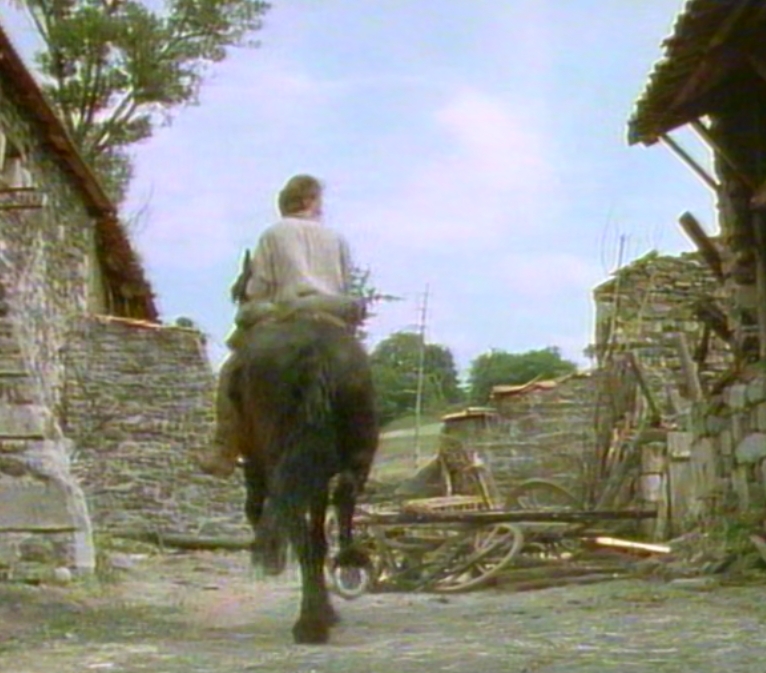
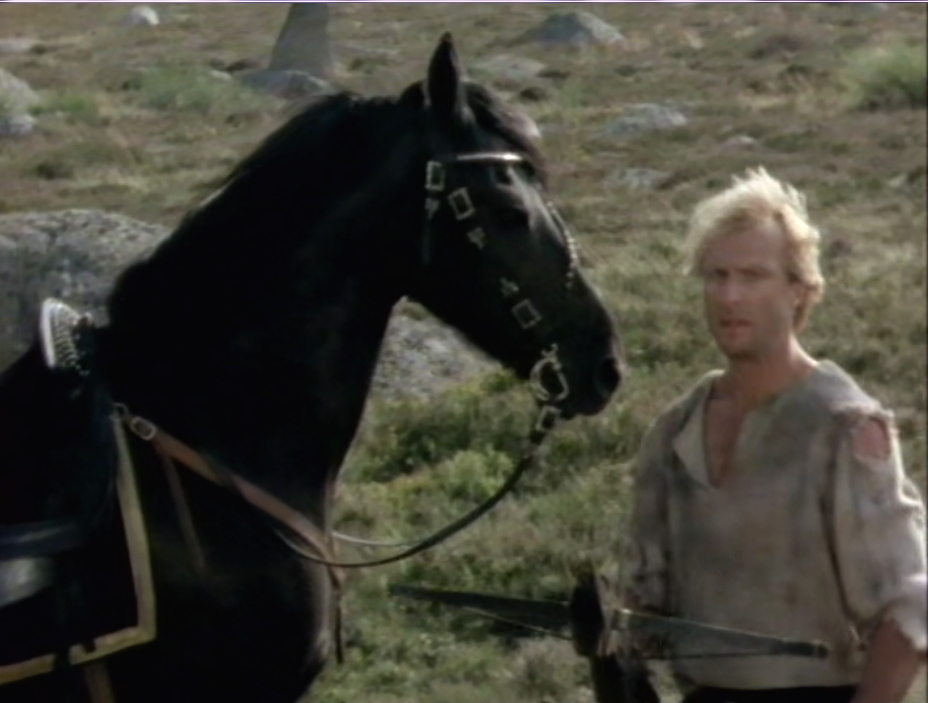
Tell mostly rode the white Lippizzan horse called 'Napolitano.' In the first episodes Tell had a brown giant horse called: 'Guitano.' This horse was also Dantes' horse (Dominique Hulin)
Dantes once said his weight tired the horse and he needed a strong horse like Guitano. I don't know the race of this nice brown horse. Tell rode a few times an Andalusian (in fast stunts in episode
The Nightmare) and three times a Friesian horse (in episodes: Little soldier and Trailbreak). In season 3 Tell rode less horses. But if he did it was a small Marrok horse (you see it mostly in episode
The Gods) and a fox-colored horse (Doppelgangers, The Silverrider, The Magician, The Amazon).
Tell on a Friesian horse..it's rare but it happened, it was taken from a black knight. In Episode 10 'The Stallion' you can see Tell's riding skills without a saddle.
Below in 'Little Soldier,' Arlempdes Prince of the Wasteland Plateau Boissets, Lozere
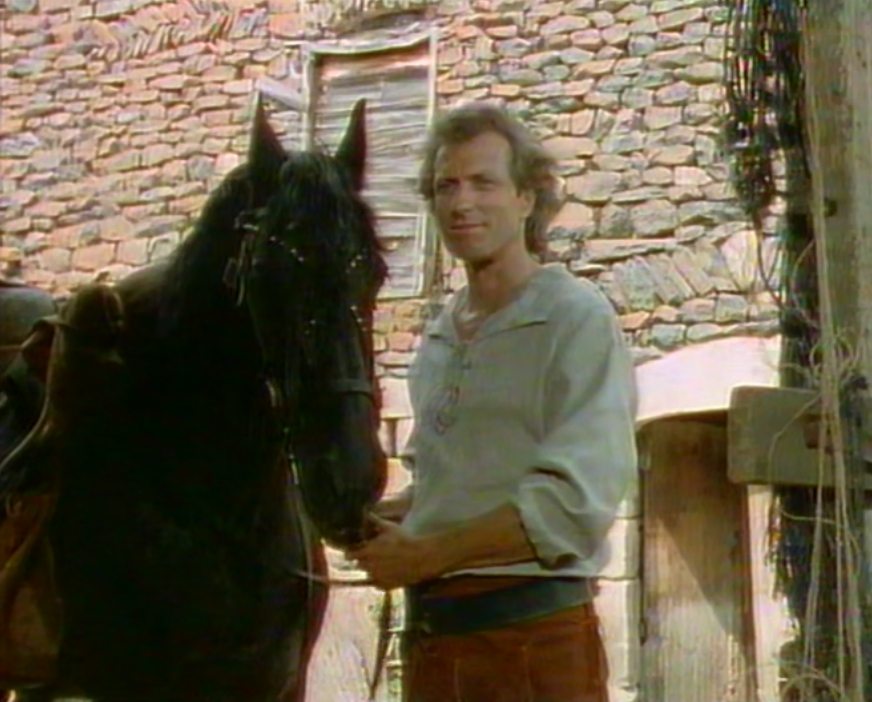

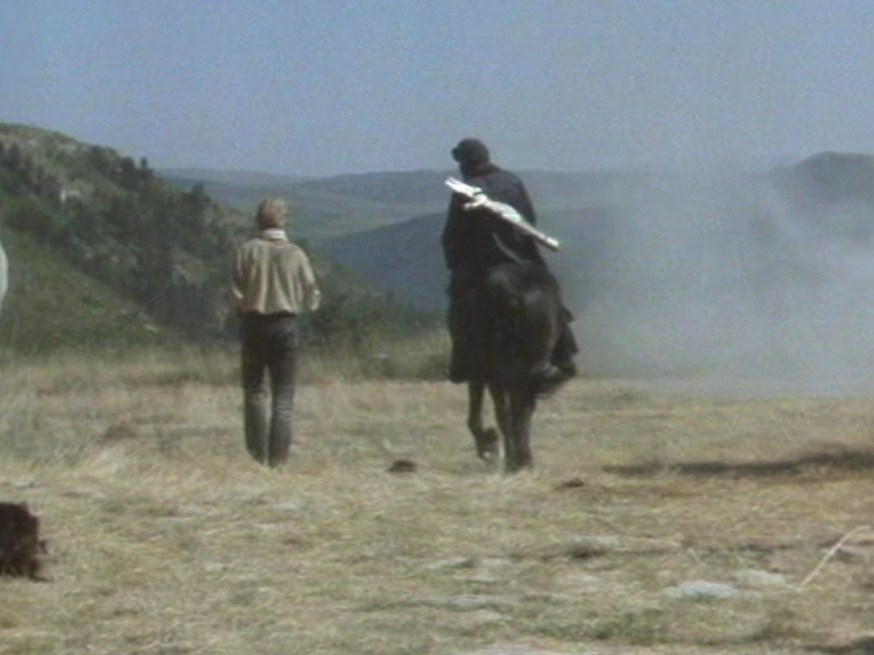
Friesian in 'Trailbreak' in Lozere
It's quite rare but here Tell with a Fries, probably Gessler's horse. In the wasteland he rode in episode Trailbreak this horse (again taken from a Black Knight).
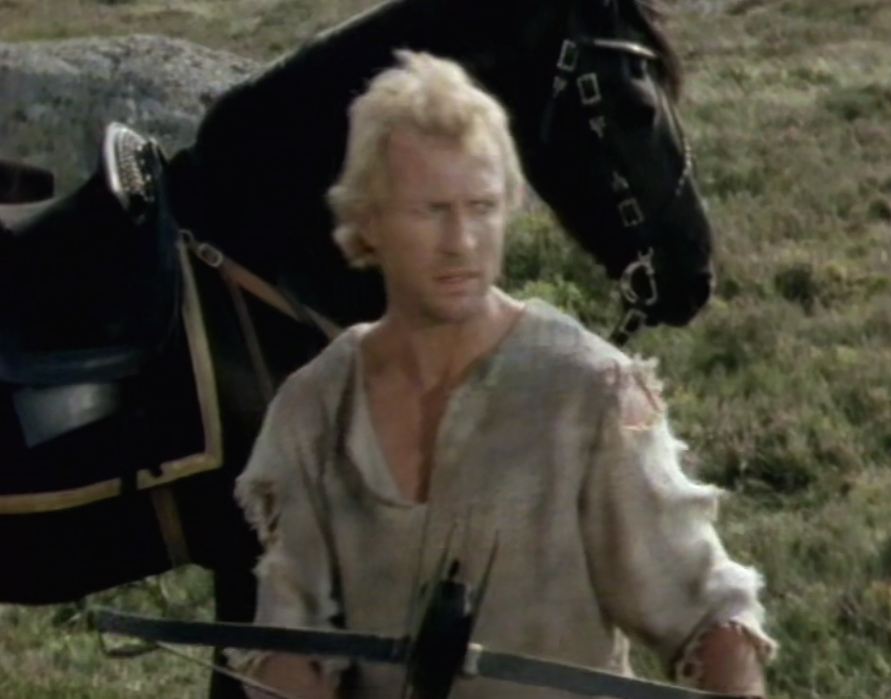

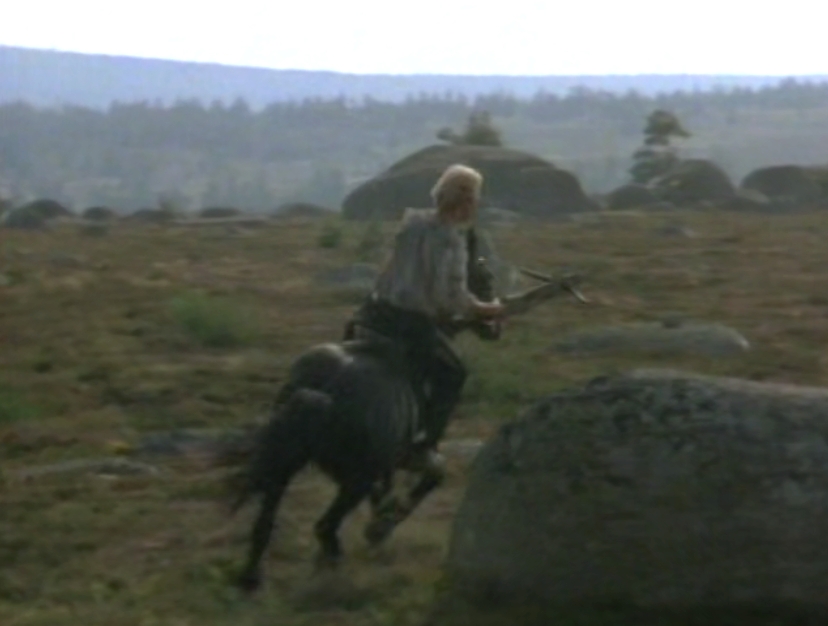
Scene of episode 'The Nightmare.' Rare shot Tell on a black temperamental Andalusian. While entering the stable (another location) The horse is changed into a Frisian
(socks and movement is different). 3 pictures below: The same scene but split. Right photo is other location and another horse, less temperamental, easier to get off.
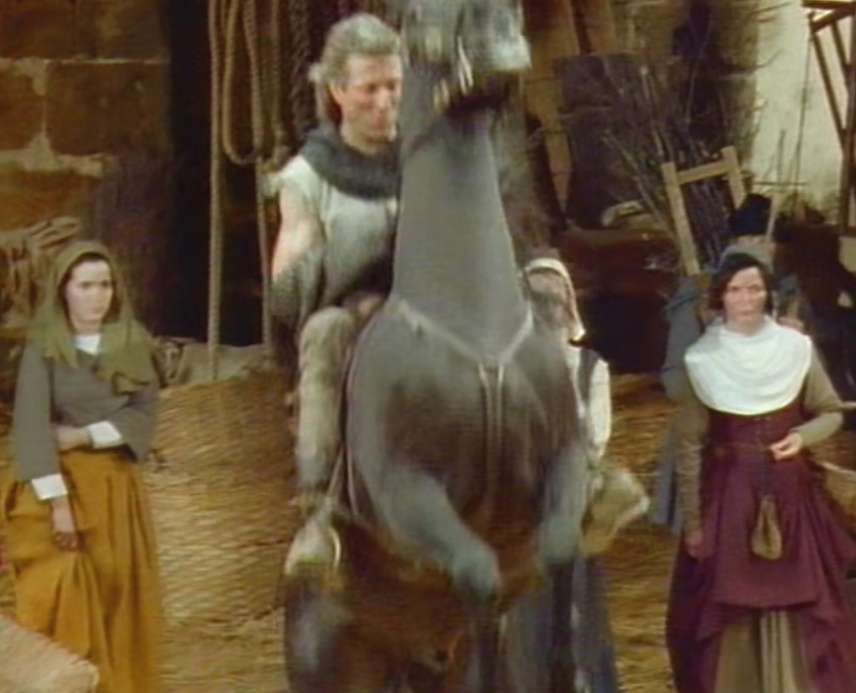
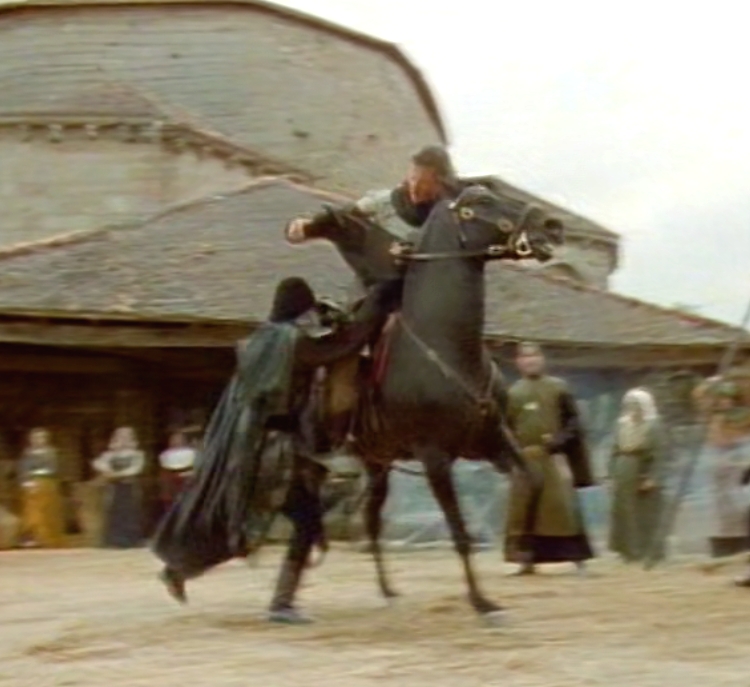
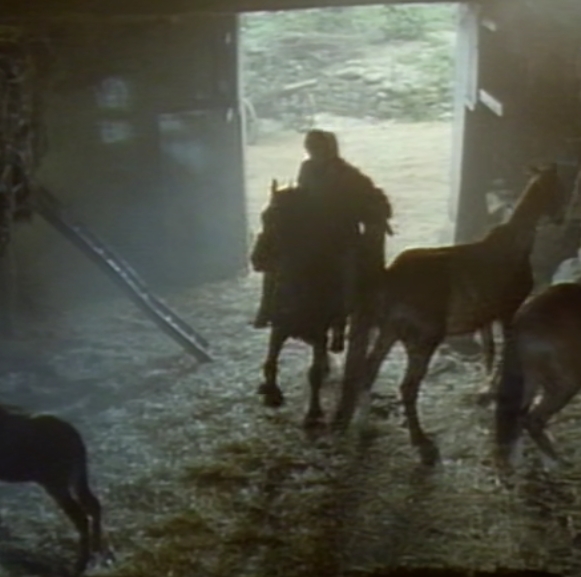
Gessler
Season 1 Gessler: always a combination of black Andalusians and Friesians Season 3
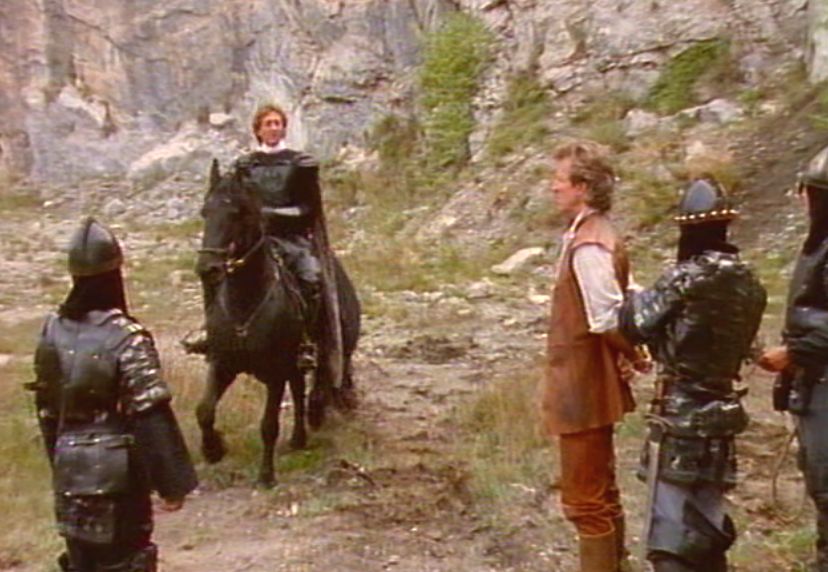
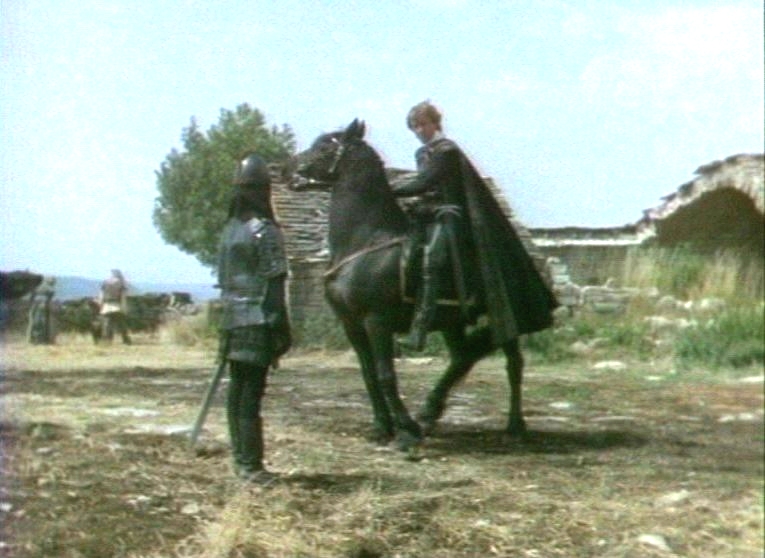
Combining Friesian and Spanish horses
Left below: Good example of two black horses. First one Tyroll on the Friesian with socky leggs and the one behind Andalusian, their temperament is different and their bodies, but as a laymen you
centainly don't see that. The movements of the Anduslian are smooth and fast and the horse has smaller legs and no socks. The horse is dancing around Tyroll's calm Friesian. Friesans can be strong
and fast but in the basic they are easy.
Good example is the entree of Gessler in the castle episode the Bet. This temperamental black horse is a Spanish one. In 'The Bet' here you see Gessler's riding skills and not fear of horses. He grew
up on a horseback. See below the Spanish horse. I believe it's name is 'Pablo.' Pablo is also present in the stuntteam.
Gessler on the temperamental Andalusian Pablo. Gessler on a Fries, less temperamental and differently built and with socks. Gessler en Horst on Friesians (very right stunman with Andalusian)
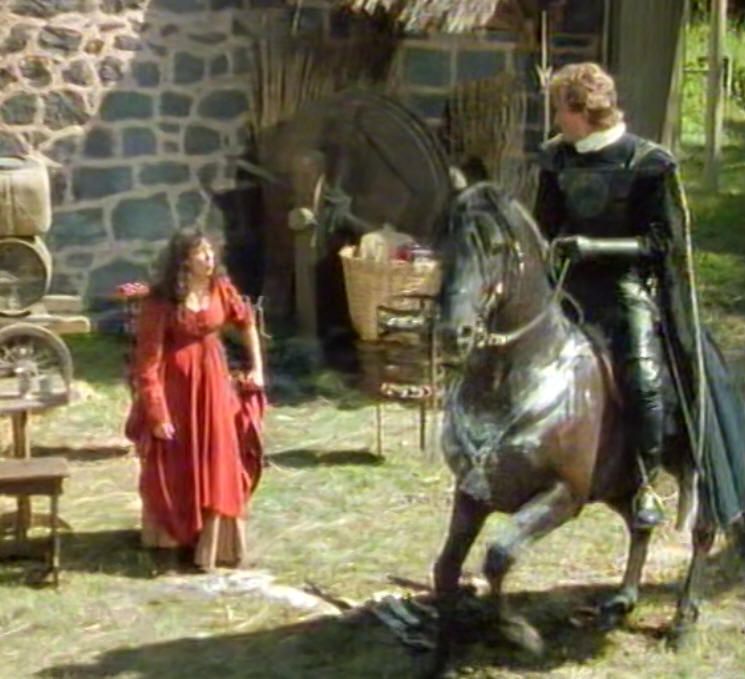

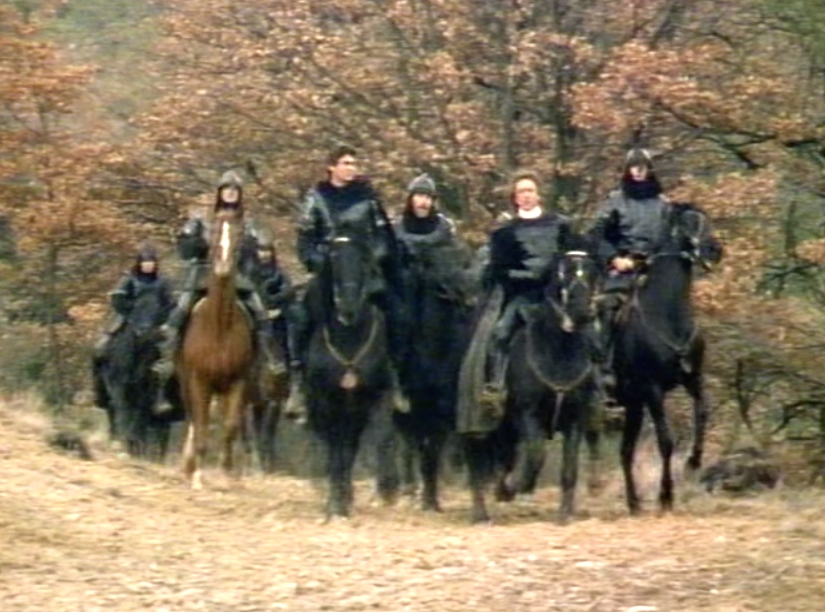
Beside the same thing; Those horses might look all black and the same (except one), but there is a difference in temperament, body and movement.
Here Gessler and Horst riding Frisians and on the right an Andalusian (Spanish horse). Without moving you can see the temperament of the right horse in comparison with Gessler's horse.
Scene: episode 'Rebirth,'
Tyroll and Friesian
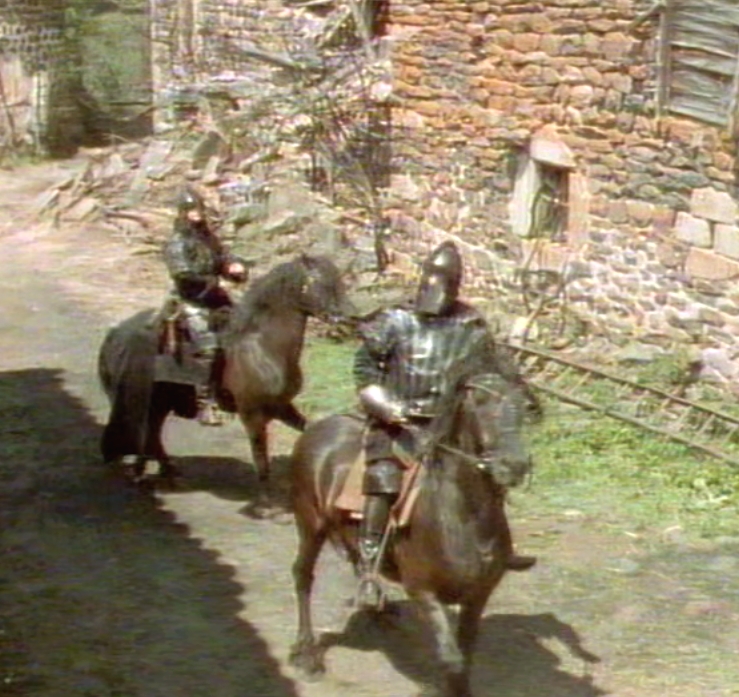
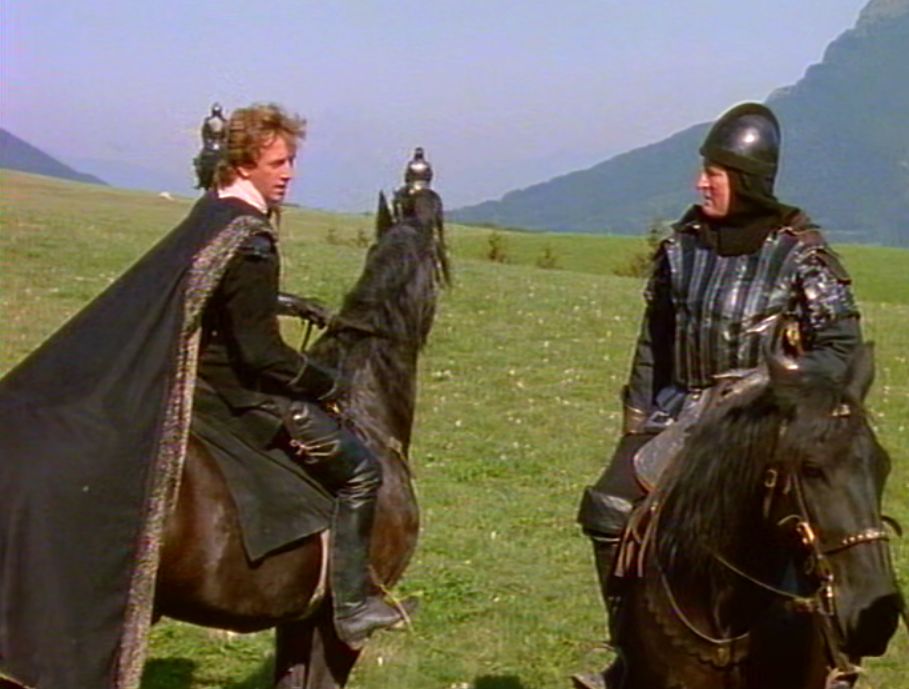
Horst always rides a Friesian
Episode Ladyship Episode The Physician Horst on this horse in episode The Mission, Lozere (season 3)
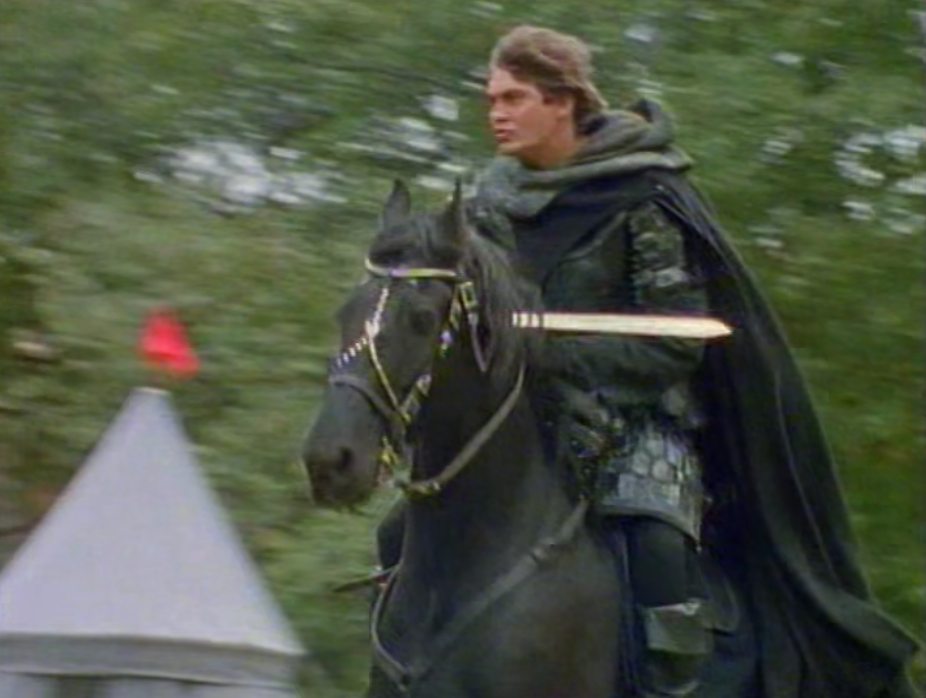
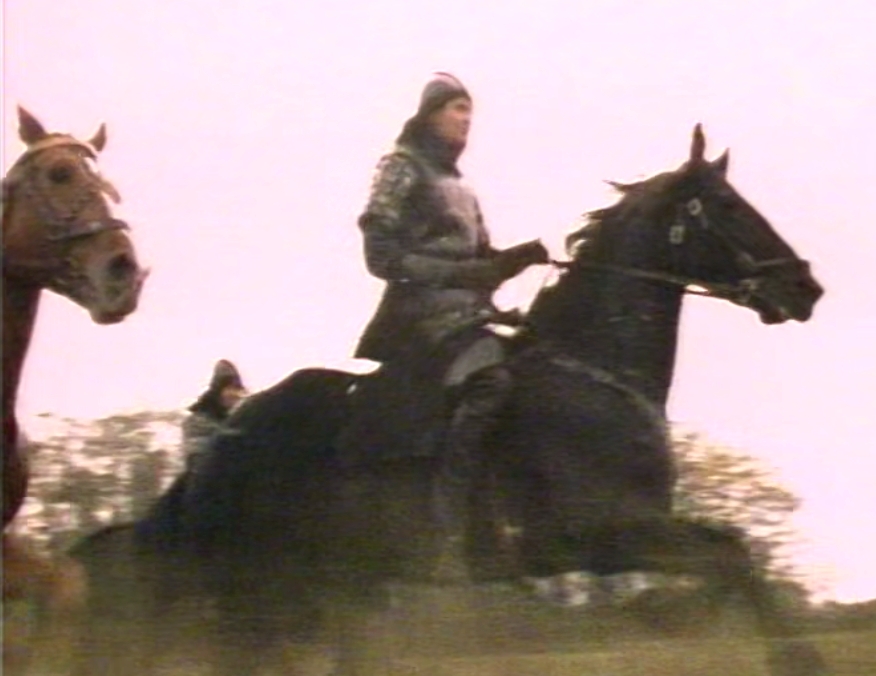
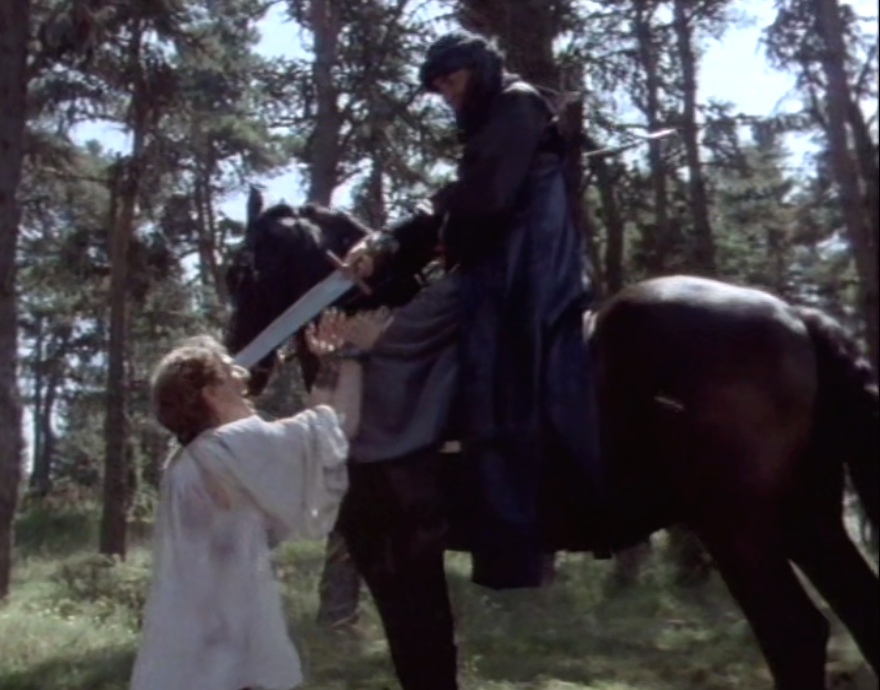
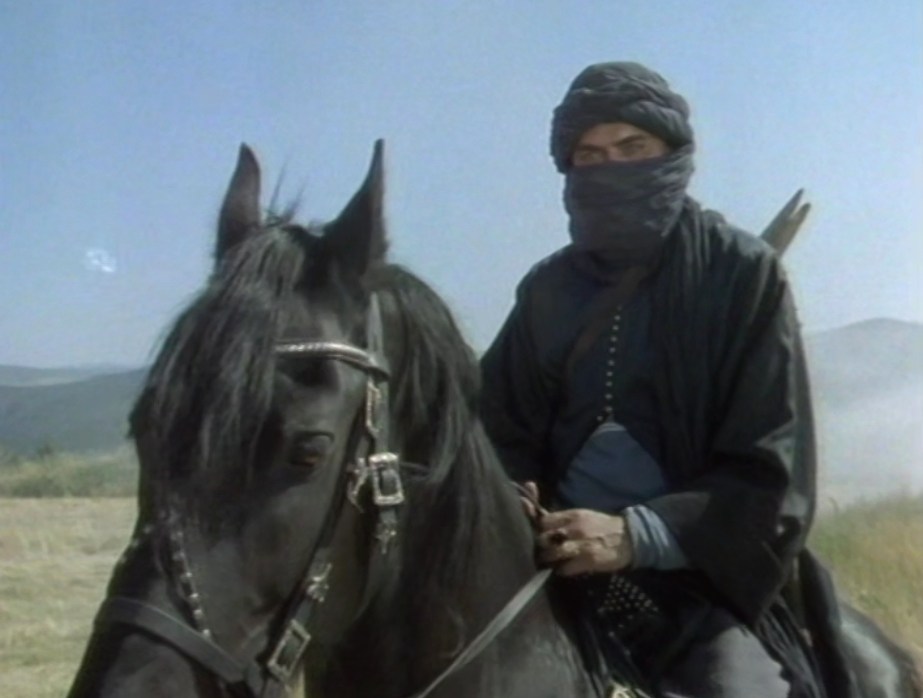
Eleanor
Mostly a Fries, a few times Andalusian. Eleanor has been to ponycamps. She can ride and is not afraid. I don't know why she mostly has a Fries, perhaps it's safer for a small girl.
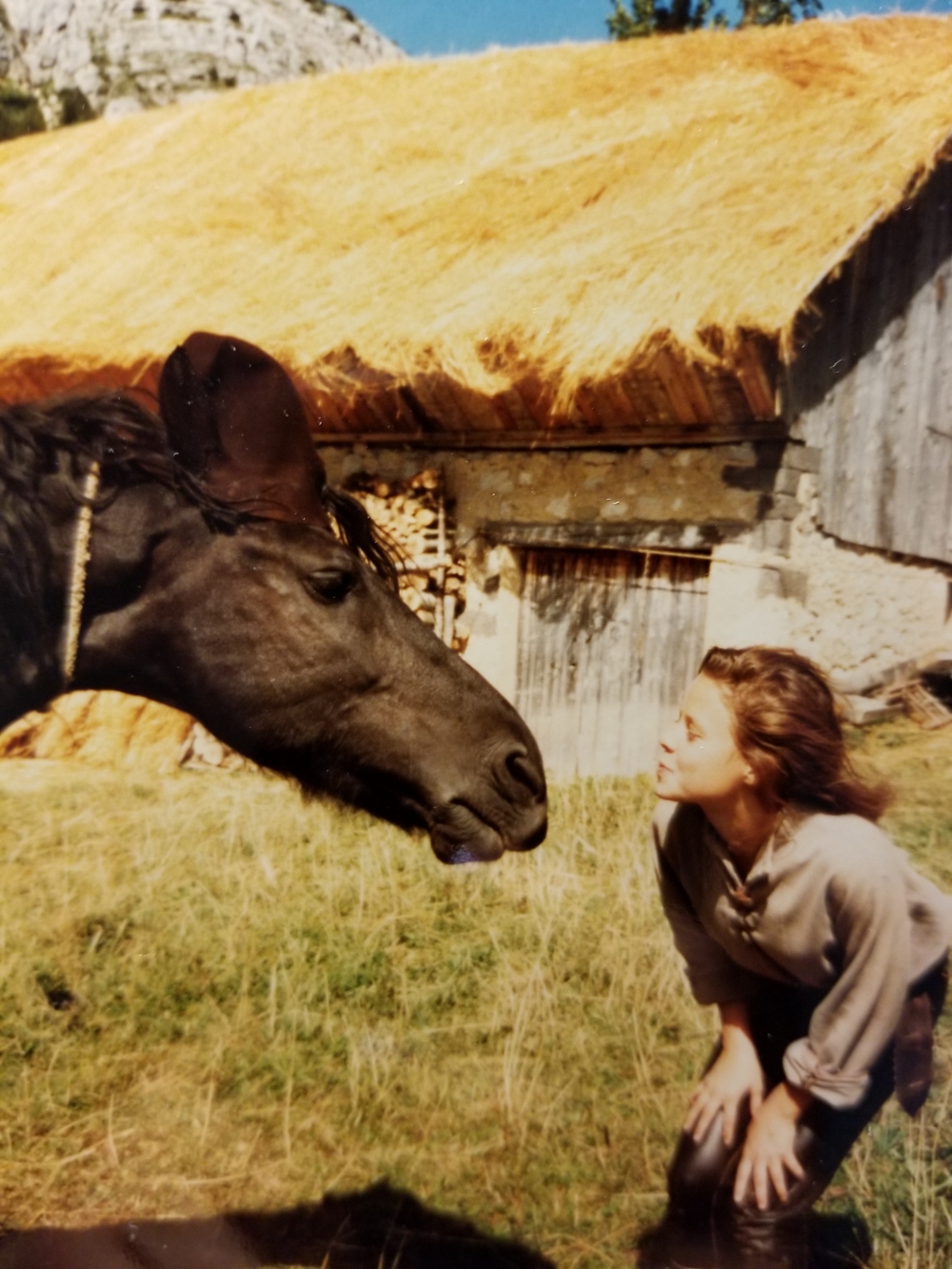
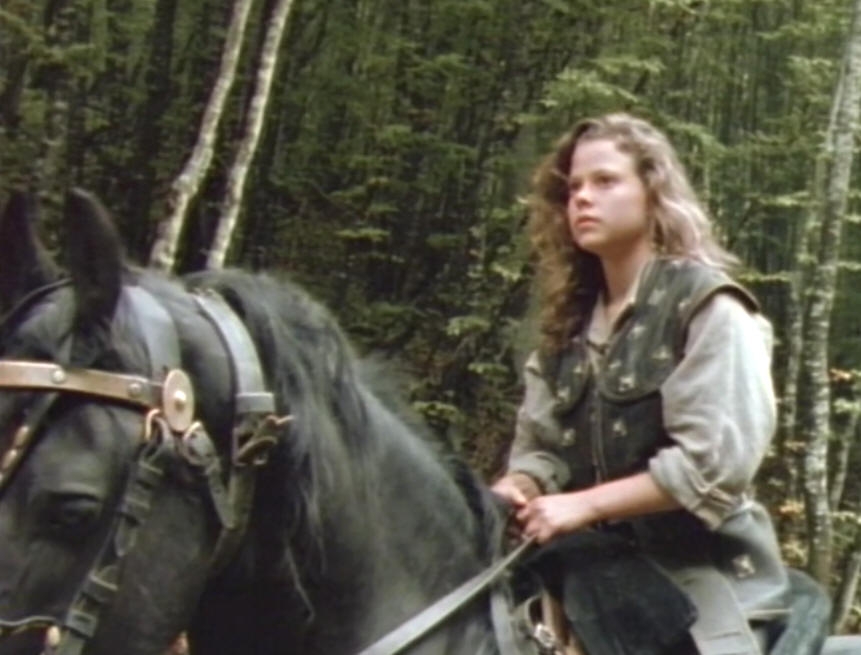
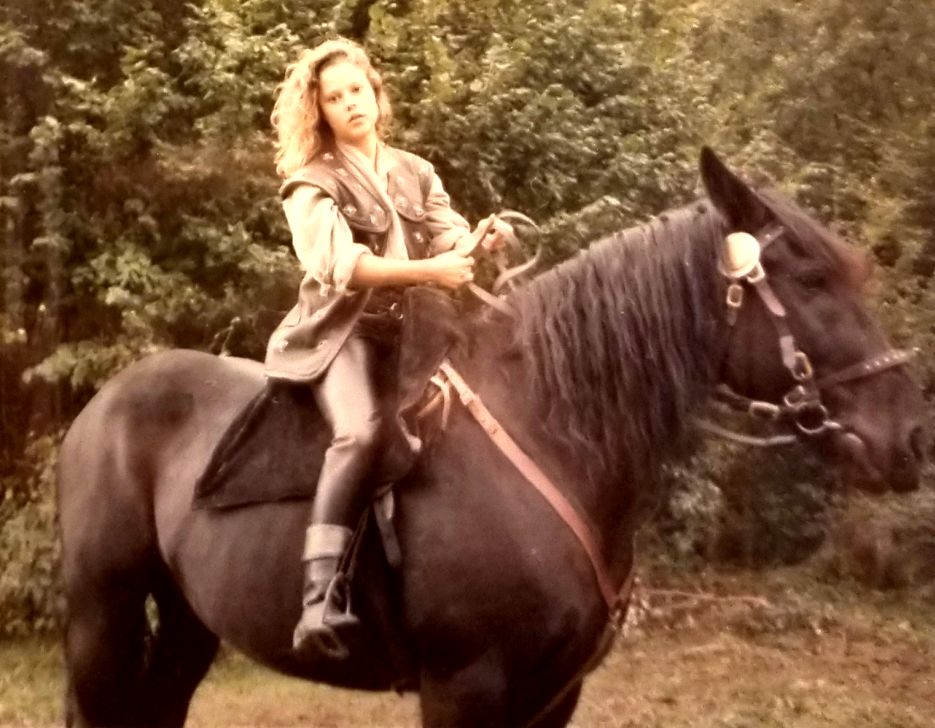
Perhaps the horse has a kind of cap for eczema. Some of these horses suffer from it. Then they get itchy due by summer flies. (see the horse 'hat' on the left photo).
On summer days there are now specially developed eczema blankets for Friesian and Icelandic horses, these two breeds can be susceptible to summer eczema.
Thanks to Dana for the photos.
Stefan
A Fries for Stefan. (his stand in sometimes a Spanish horse for the action shots with a stunt rider).
For actors who are not experienced riders, the Frisian horse is a very gentle, stable and relaxt Horse. And It looks impressive. Horst, Tyroll, Yanek and Eleanor
rode Frisian horses. Eleanor is a practised rider she sometimes had an Andalusian, I think they mostly choosen a Fries because she is pretty small. Andalusian horses could be
very temperamental. Gessler has both horses. Jeremy Clyde grew up with horses and Will Lyman took riding lessons as a kid and Mr. Lyman remembers going on horsetrail with his mum, long ago.
Blackknights we don't recognize and ride very well, are probably stuntmen from Mario Luraschi's team.
I like this beautiful photo of 'Stefan!' The clear high knee action
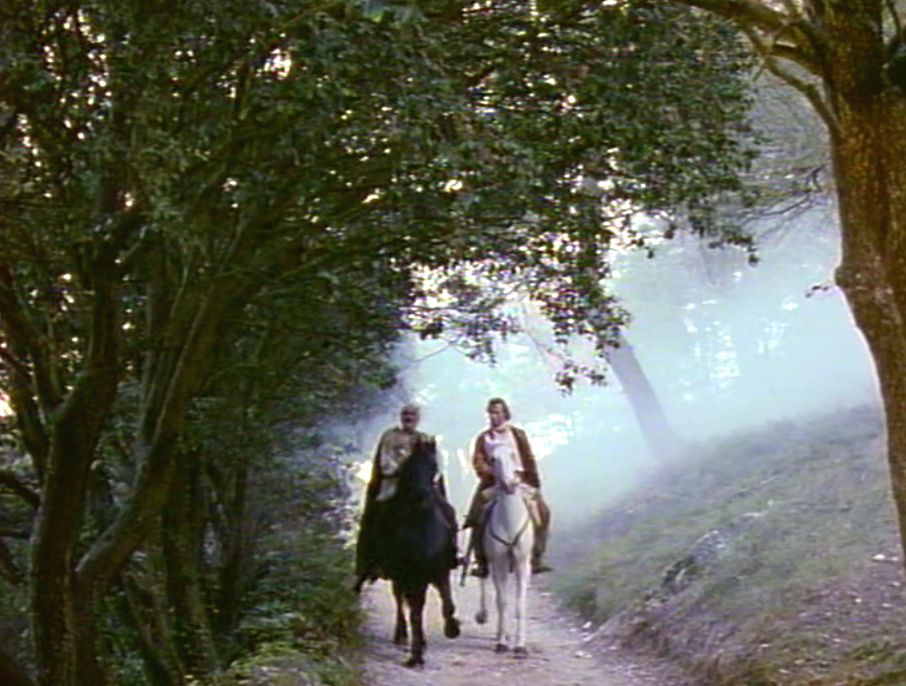
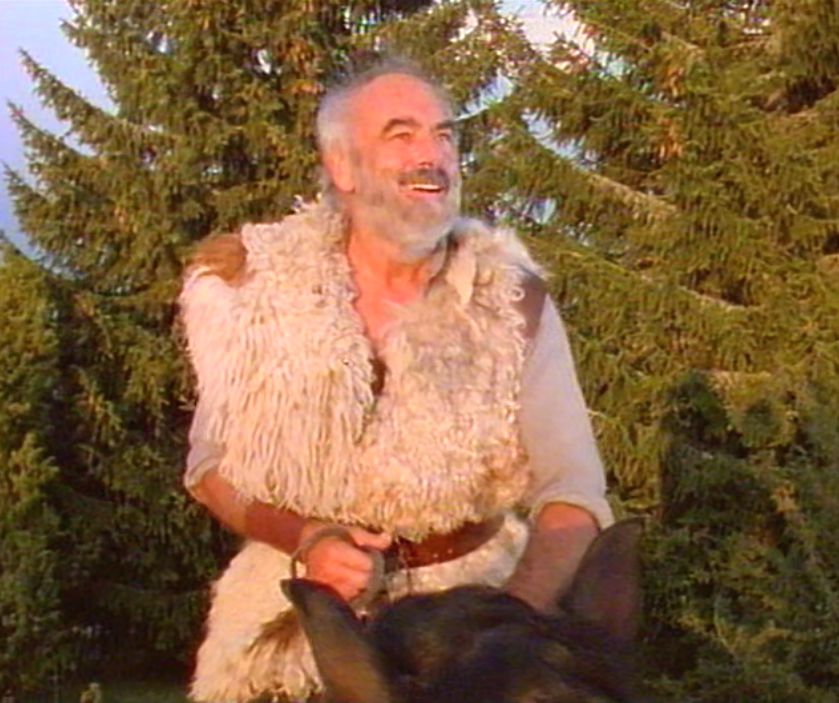
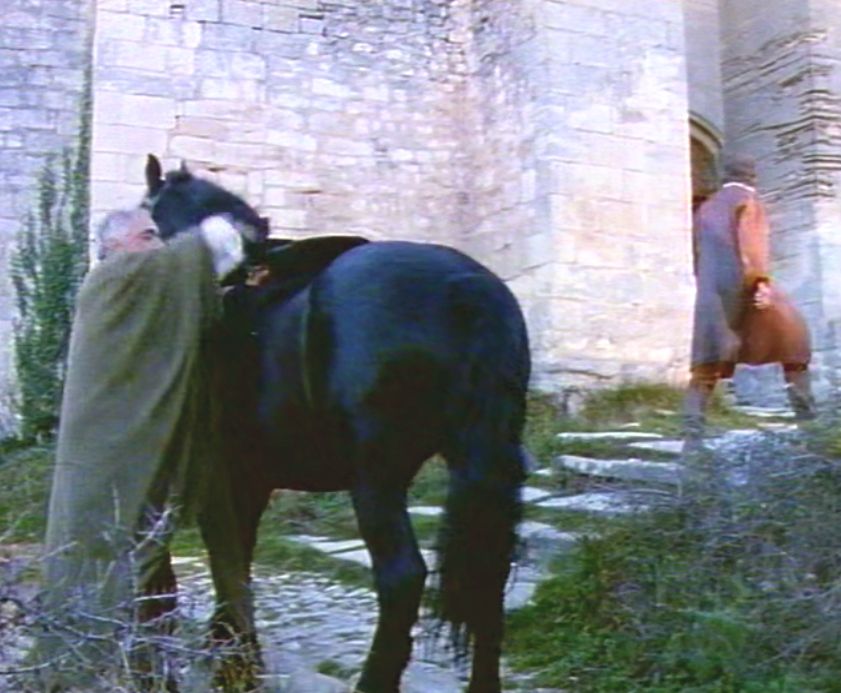
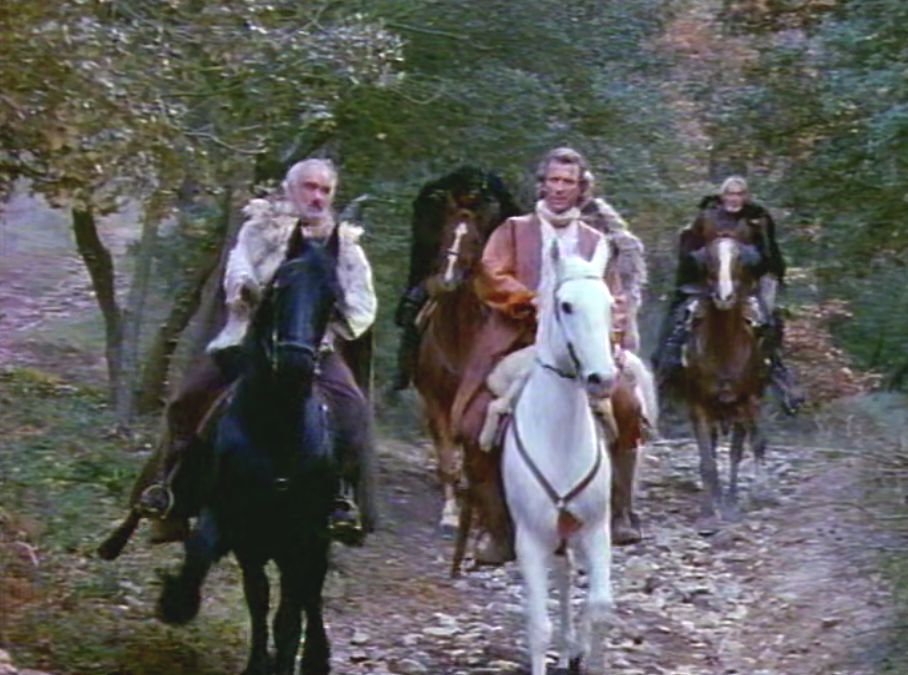
The Stills with 'Friesian'
More Friesians in Crossbow than I first thought. below some shots to make it more visual to you.
The socky legs of Yanek's Hors 'Nemesis' Yanek Tyroll and Horst on Fries in the 'Banquet'
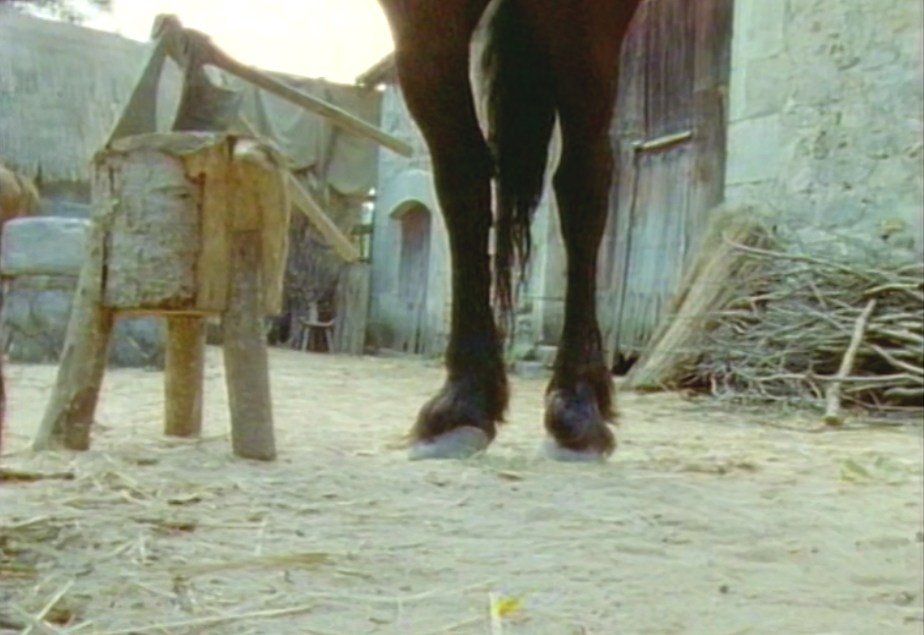
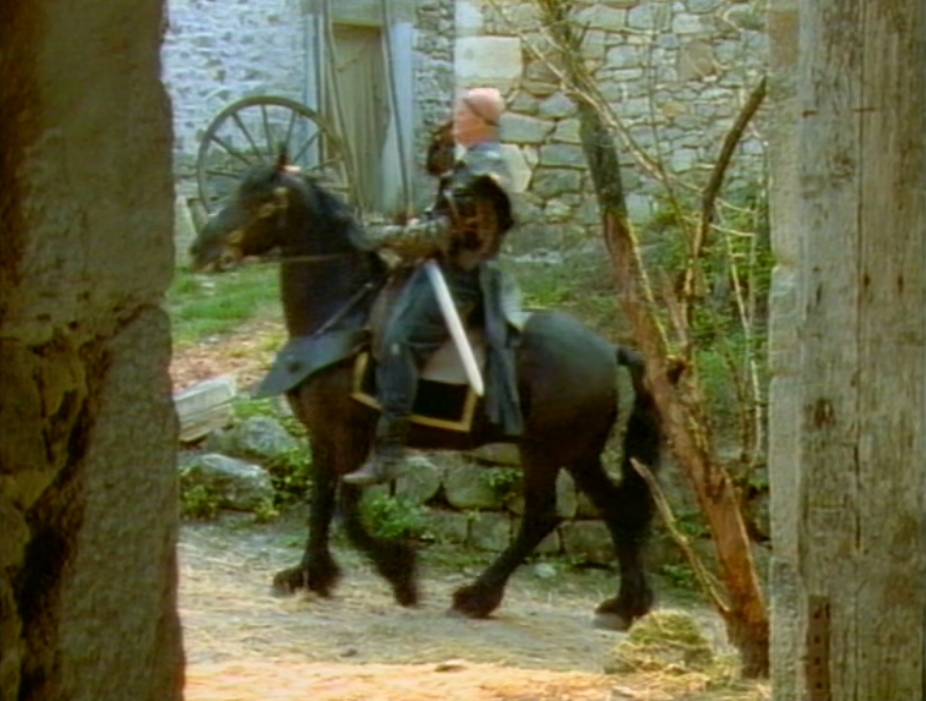
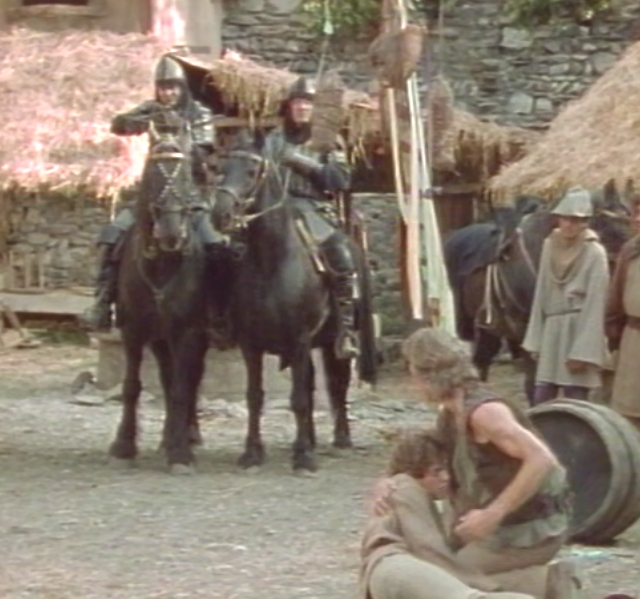
Friesians at Saint Andre, Avignon
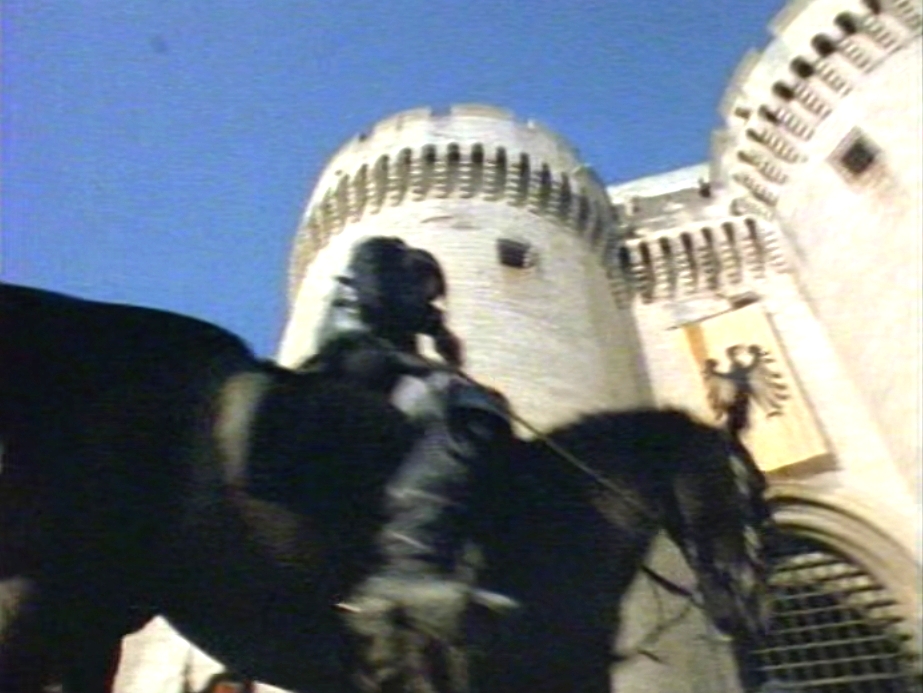
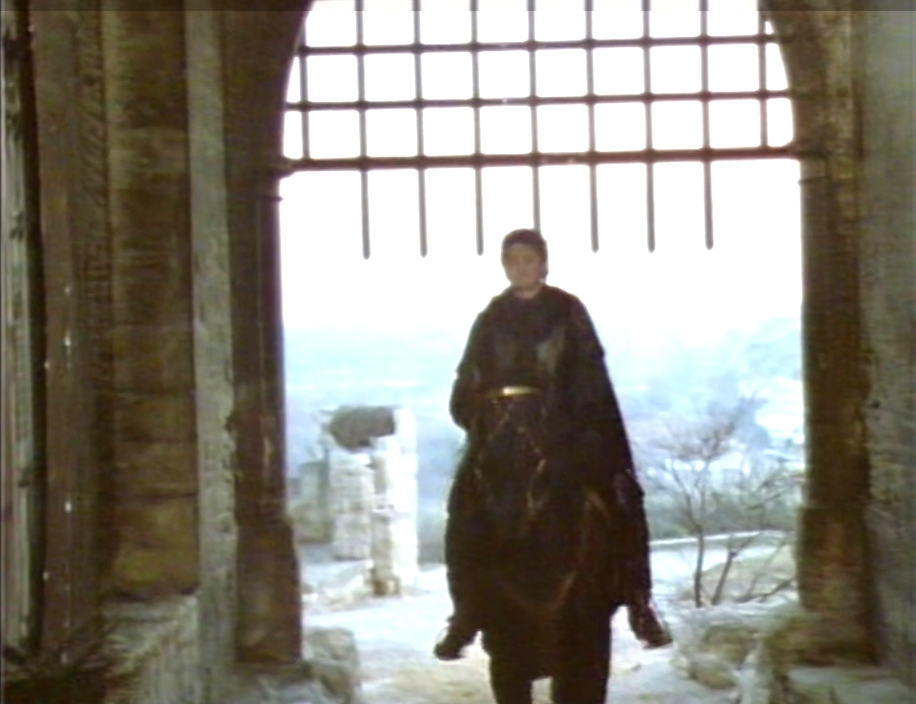
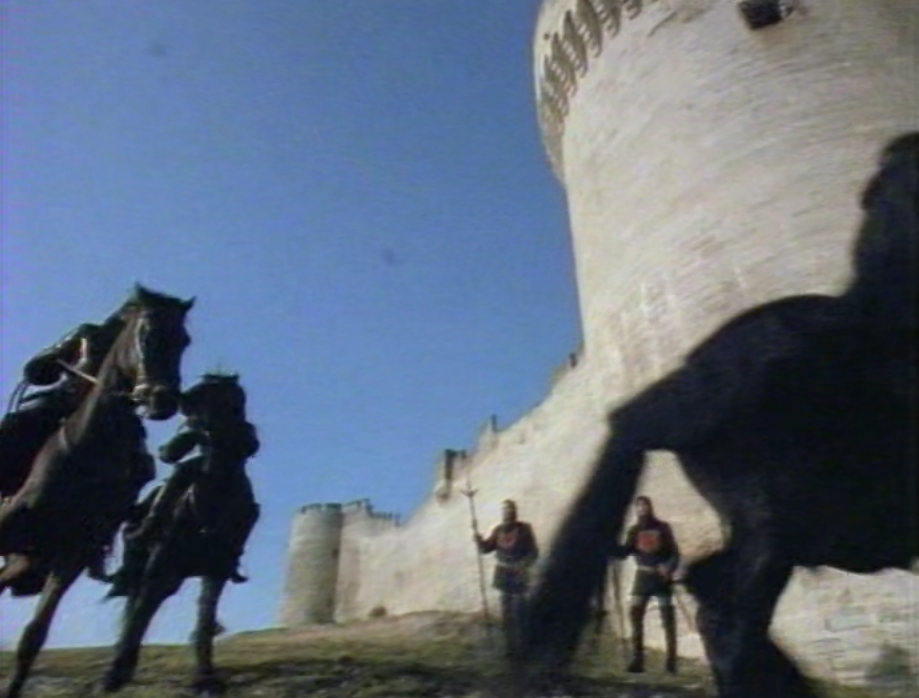
See the socks
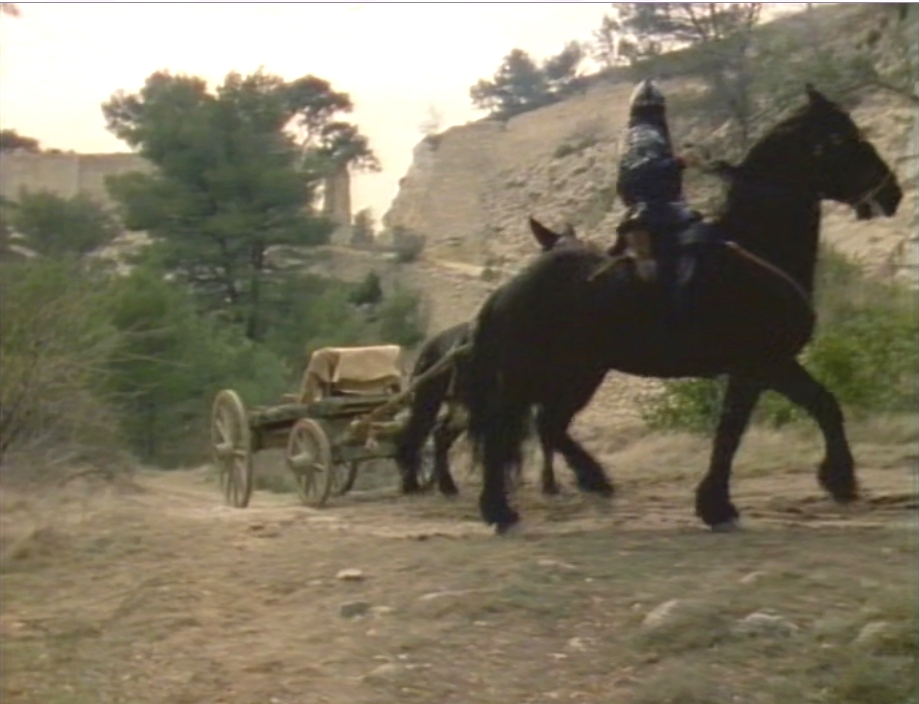
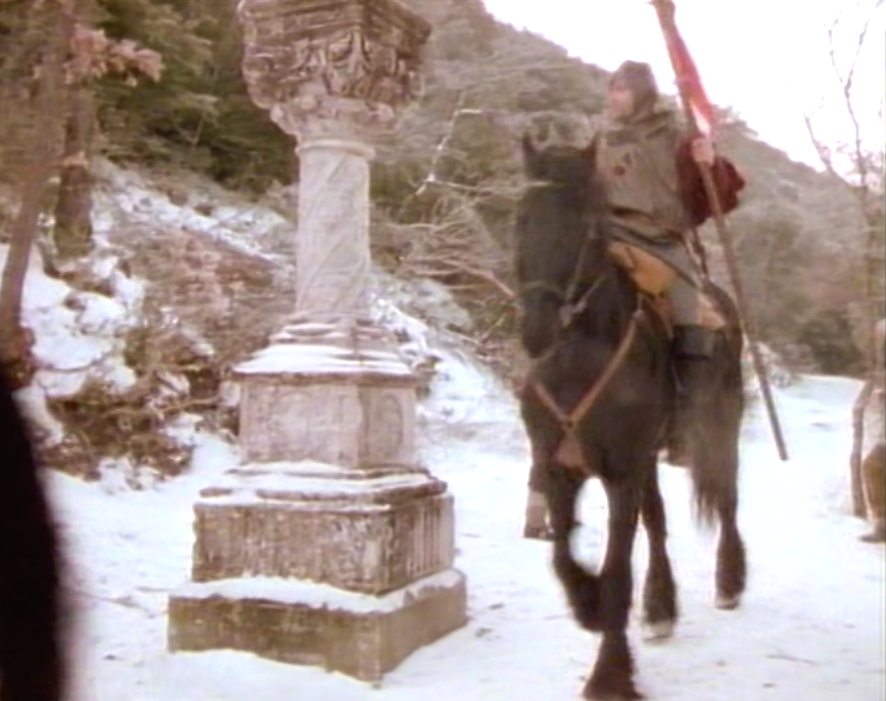
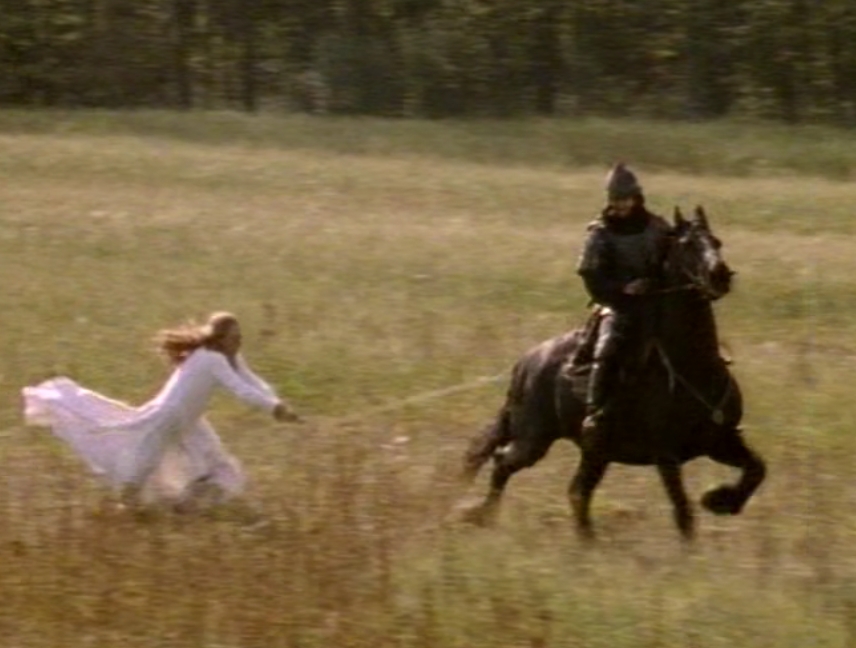
Above you could read about this beautiful breed,
From here related posts about the breed and the province. The Friesian Culture and their horses.
De Stormruiter (The Stormrider) and Dan Brown
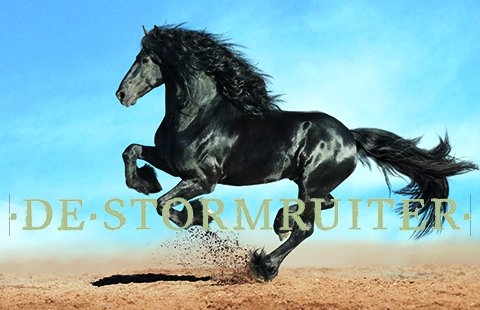
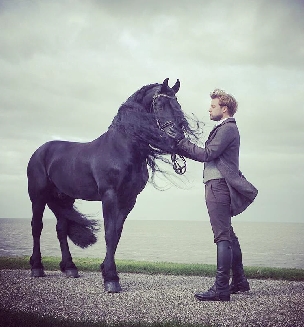
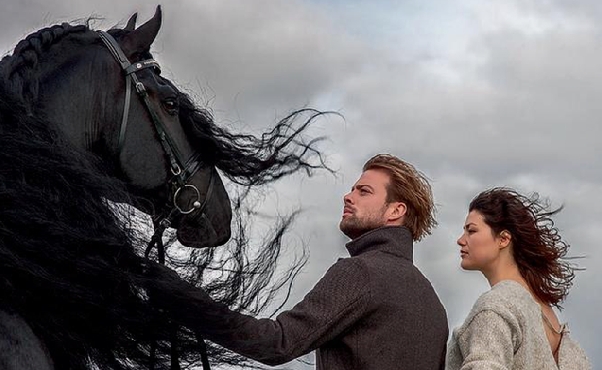
One hundred Frisian horses, the Leeuwarder WTC rebuilt into a dike landscape and sold-out shows. Over one hundred thousand people visited De Stormruiter (The Storm Rider) in September and October:
one of the absolute highlights of Leeuwarden-Fryslân 2018. This unique music-theater piece tells about the eternal battle of The Netherlands against the water and the history of the Frisian horse breed.
Have you missed it? Come and see it on the big screen! Omrop Fryslân, in collaboration with Stichting Faderpaard, made a wonderful registration of the extraordinary theater spectacle and the result
premieres at the film festival. Below: Nice to see these pictures are shot in my own street, the last street of the Dutch mainland.
They shot promotional pictures and films here and on the beach of one of the islands. Below: Jelle de Jong and Annemaaike Bakker.
The horses are part of Historic Runnymede Farm, a beautifully restored stud owned by top author Dan and his wife Blythe Brown. Dan Brown is an ambassador for The Storm Rider.At Historic Runnymede Farm only
Friesian horses can find a home and Blythe Brown is the driving force behind it all. Dan Brown: ‘Blythe originally comes from California and in her childhood used to ride on horseback in the desert. When a child she
saw the picture of a Friesian horse and years later when she decided to pick up
riding again here in New Hampshire she was adamant it should be one of those
majestic Friesians.’
The author of, to name just one, the Da Vinci Code, instantly fell in love with
the Friesian breed too. ‘This was the first horse I came across that didn´t
frighten me. It made me think of a big Golden Retriever dog,
a friendly puppy, when I was at the farm it would run up to me, lick my face and sniff. I am completely in love with this breed’, Dan Brown tells us. ‘Huge power, combined with an enormously gentle and spirited
personality. Friesian horses work for you, fight for you but they’re also as gentle as you can wish them to be.’
Dan has been Ambassador of The Storm Rider and Leeuwarden-Friesland
2018. He is hugely looking forward to The Storm Rider, the major music- and
theatre spectacle with one hundred predominantly
Friesian horses starring in the main role. Source kfps.nl
"I'm actually afraid of horses." It is a striking outpouring of bestselling author Dan Brown. The writer of the Da Vinci Code has become ambassador of the music and theater spectacle De Stormrider,
precisely because a hundred Frisian horses play a role in this. It has come through his wife Blythe (divorced) that he is in love with this horse breed. Blythe bought a Friesian horse for their stud farm in New Hampshire.
,, That was the first horse that I was not afraid of. It reminded me of a big Golden Retriever. When I was at the stud, the horse galloped to me, licked my face, sniffed. I just fell in love with this breed.
That love for the Friesian horse cherish top-class lady Judith Pietersen, who plays a role in De Stormrider, since her youth. "I knew very early that my life would be in the sign of horses. I recognize that friendly
character of the Frisian horse that Dan Brown has fallen for. A Frisian horse is also loyal, a hard worker. He gives clinics all over the world., That's how I met Dan Brown in the stud farm in New Hampshire.
\It is special that we will meet again in Leeuwarden in September. He as a guest, I as an actor with my horse Limited Edition.
Brown, who as a fan of Fryslân is also ambassador of Leeuwarden-Fryslân 2018, is eager to go to De Stormrider. ,, Friends of mine, who work in the film industry, I told about De Stormrider.
They were stunned: "What are they going to do? Working with a hundred horses? Live? That is almost impossible! "It is a huge production."
For Pietersen, the Storm Rider is an unbelievable challenge. ,, I manage riding, but every evening for more than 4,000 spectators, is of course super exciting. And I have to act alongside riding. Fortunately,
I often train with Jelle de Jong, one of the protagonists of De Stormrider. Then I can instruct him about riding and he can give me acting lessons. That is very special." source: plus video: here
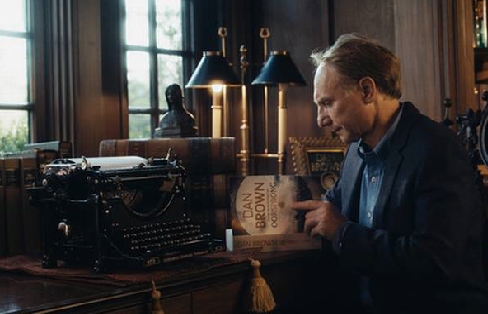
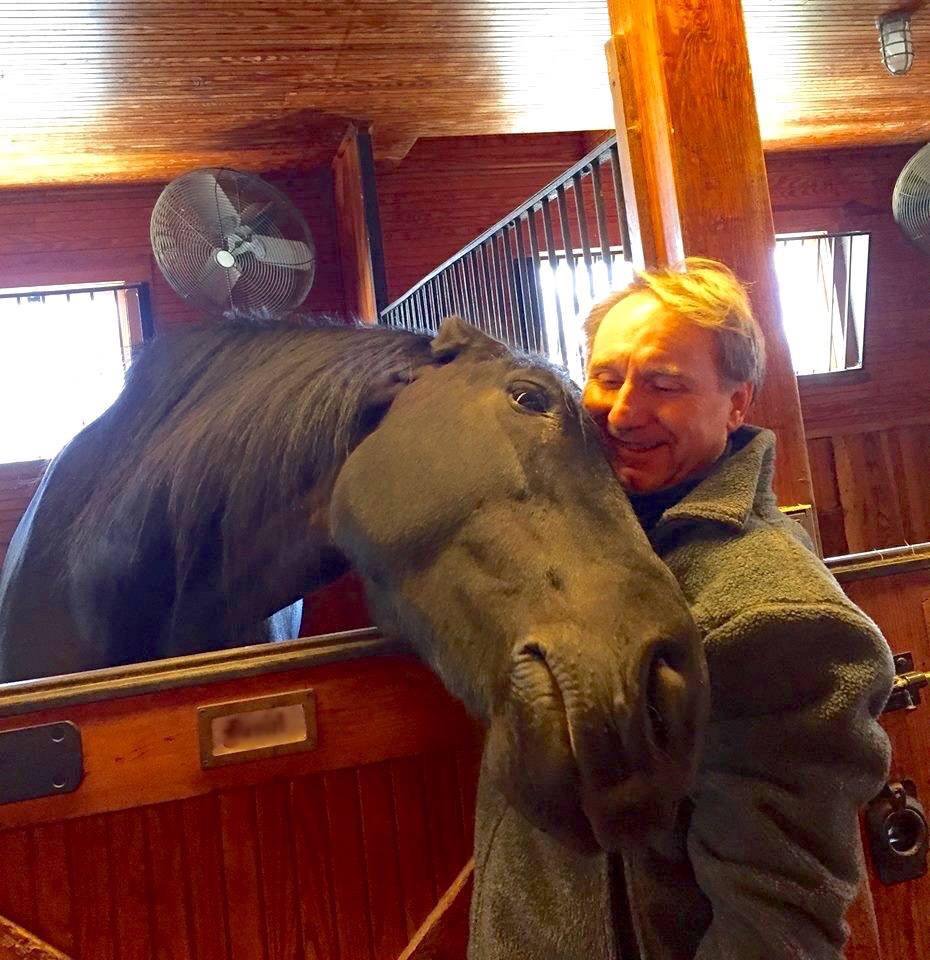
The author Dan Brown of, among other things, The Da Vinci Code and Origin is a well-known fan of Frisian horses, of which there are about one hundred sparkles in De Stormrider. He came to Leeuwarden in 2014
for example for the stallion inspection and Fader horse at the WTC Expo Leeuwarden, Friesland (Northern province in The Netherlands), an earlier performance by Stormrider director Jos Thie with a leading role
for the Friesian horse. Brown also has several Frisian horses with his wife. Droog: "His wife was still at the last stallion inspection, and he has also been here a few times. A Friesian horse also appears in his book Inferno. "
Within the LF2018 organization, Brown was already suggested at an early stage as one of the possible ambassadors of the Capital of Culture Year, says Droog. "But that was never really done."
A month and a half ago Siebe Annema, marketing man of De Stormrider, did. He wrote a letter to Brown, also signed by LF2018 director Tjeerd van Bekkum. Droog: ,, In it Brown was invited to come to Leeuwarden
to get some of the Cultural Capital Year - we hope to welcome him in September for example at the premiere of De Stormrider - but also asked if he has something in the program want to do."
In response, an invitation came back. "He was enthusiastic about the ambassadorship and in turn invited a Storm Rider delegation to come to his New Hampshire ranch in early May to continue talking."
With currently the best-selling thriller author in the Netherlands, the interpretation of the ambassadorship can go many ways, thinks Droog. "A funny anecdote he told Siebe is that as a child he had two posters hanging
in his room: one from a painting by Leonardo da Vinci and one with work by M.C. Escher. Brown's father was already a fan of the artist born in Leeuwarden, and passed it on to his son. So there are more links with
Fryslân that also join the LF2018 program. "
King Lear, Faderhorse, Stormrider (in collaboration with the South France: Theatre du Cenaure), all those big Friesian productions including these horses. Click HERE for a short Youtube overview.
The Friesian province cultural capital 2018 of Europe. Click here for a short overview.
With a royal touch
That band goes back to 1981. It was the year after the inauguration in 1980. Beatrix, from a very young age, a gifted rider, received two Frisians as a gift from the Royal Friesian Horse Studbook (KFPS), of which
she was and remained patroness. The gift was well received. Beatrix was happy with it.
There are 33 horses in the Royal Carriage and Riding Stables at Noordeinde Palace in The Hague; 24 carriage horses and 9 riding horses. In consultation with the queen, Wassenaar's predecessor decided to increase
the number of Frisians. Half the number of carriage horses became Frisian. Below Princess Beatric, former Queen and her son William Alexander. Beautrix is a guest of honor during the premiere of De Stormruiter.
Together with her oldest son, king Willem Alexander.
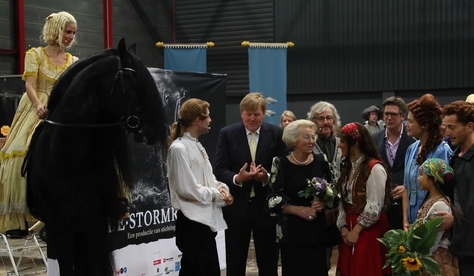
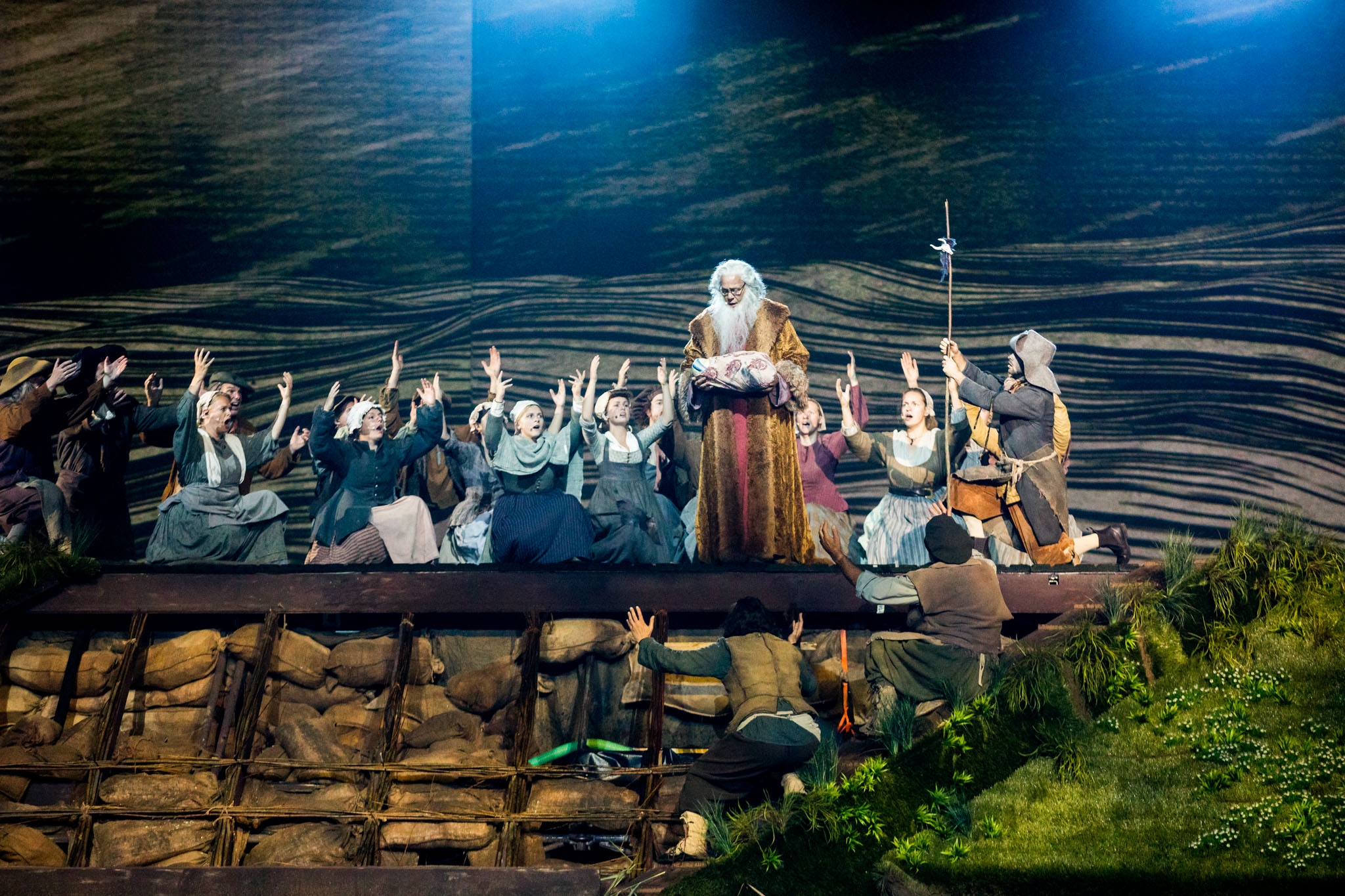
The set
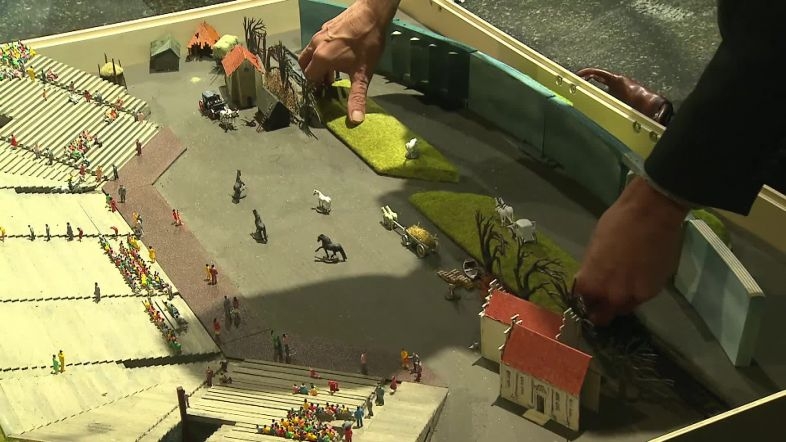
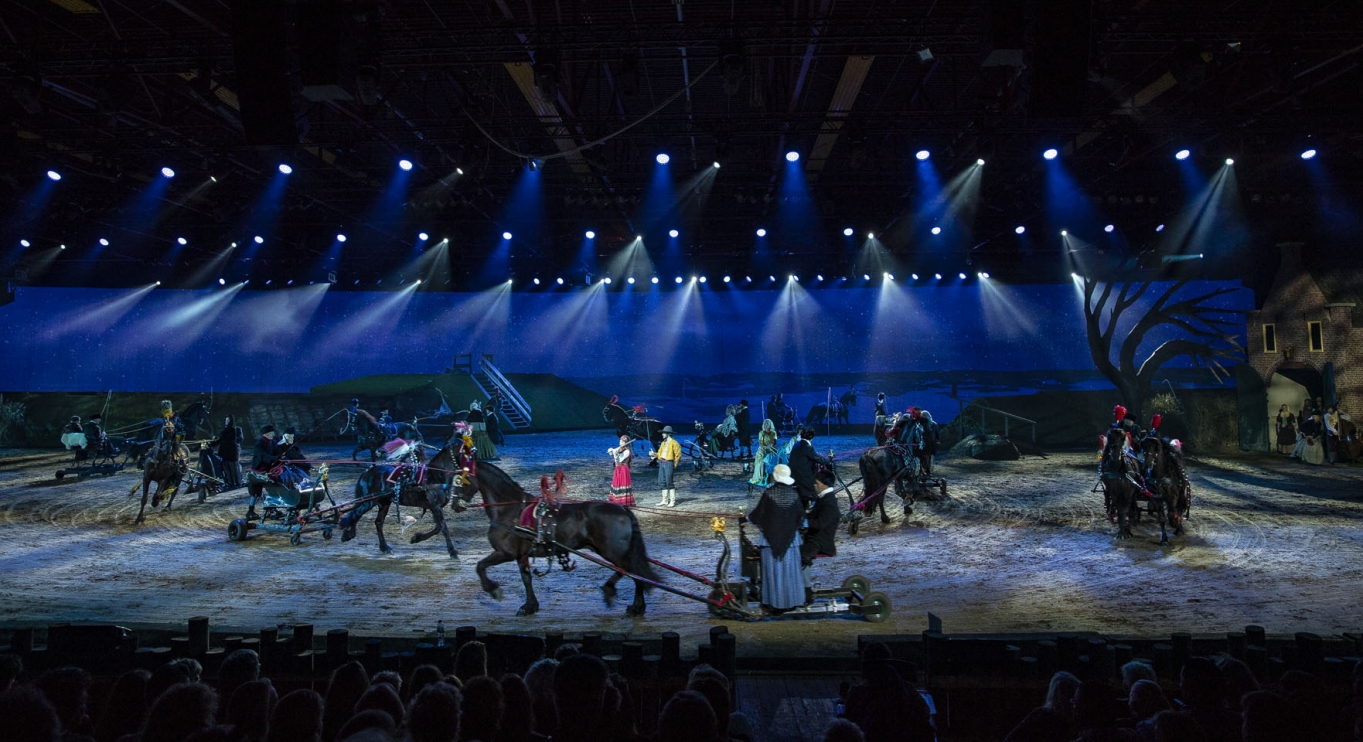
A huge screen with moving background shots, a beautiful large decor and many people and 100 horses. Beautiful traditional costumes and official carts and sledges. There is a lot of water, storm, falling large trees, a burning
church in the rain. It was very realistic. The players have trained for months, also to learn how to ride a good horse. The guard of the dyke on his white horse. Right: The dyke opens up and a white mist covers the fields.
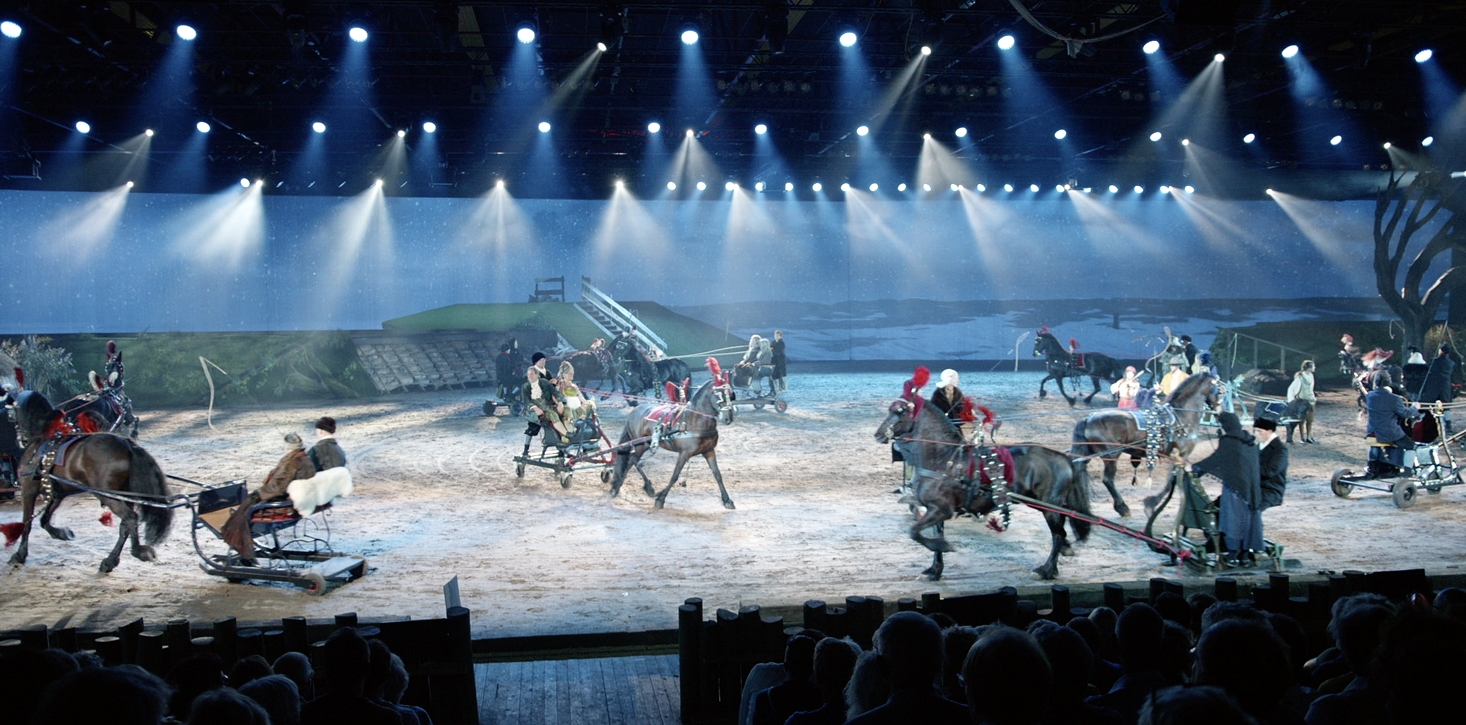
The mist is the symbol of ghosts, in the back the stormrider shows himself as a ghost. Impressive set!
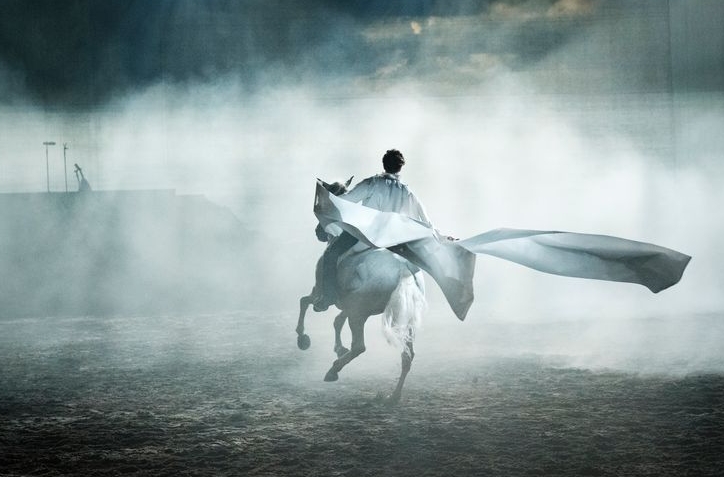
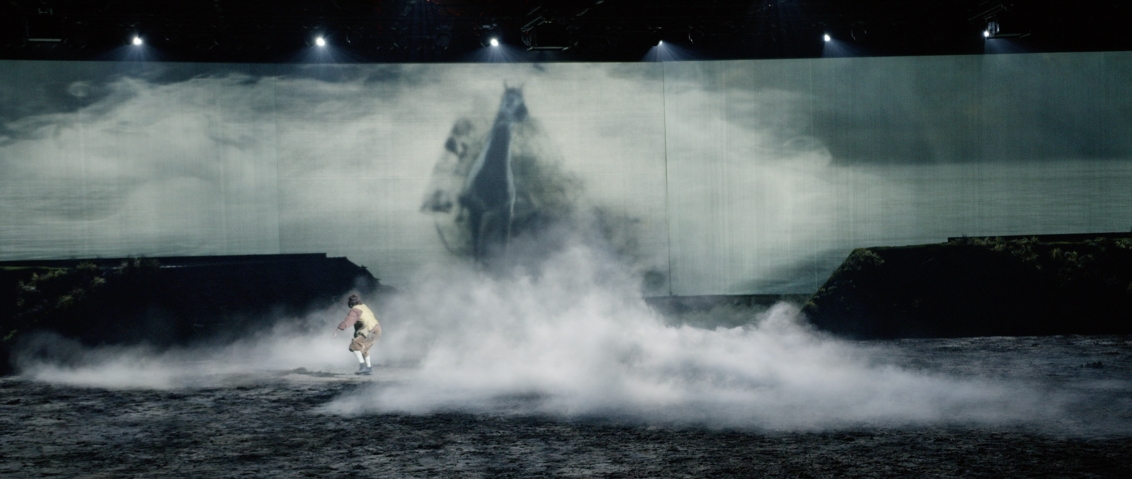
Publicity photo outdoors; the horse of the stormrider.
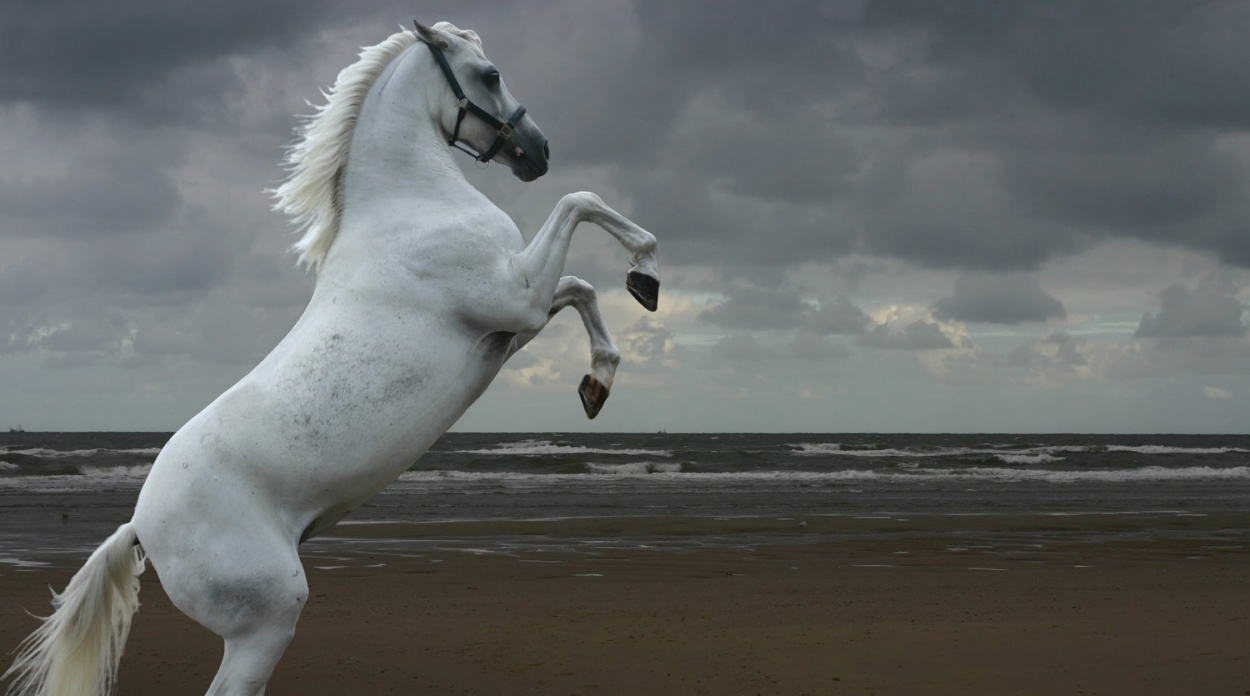
'The Tour of Tours' Elfstedentocht project is yet to come. Click here for the new huge project in Leeuwarden after the Stormruiter. It will be a spectacular
musical that will be very big and beautiful, called The Tour, referring to the largest ice tour in the world The Elfstedentocht. (eleven cuity ice skating tour).
Almost reality
This is really in a hall not outdoors, a real dyke, grass, a horse on a high dyke and a dyke that can open, let real water flooding through.
Churches on fire, flooding, trees falling and the background hundreds of tv screens making one screen with sharp beautiful backgrounds from the maker of the nature movie WAD, 'Ruben Smits.'
Jelle de Jong (main character) on a Friesian Right and Andalusian horse and left the Fries Théâtre du Centaure
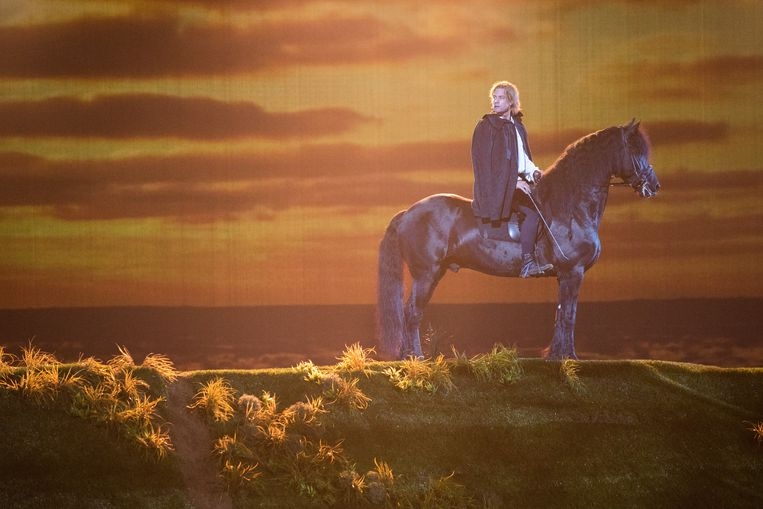
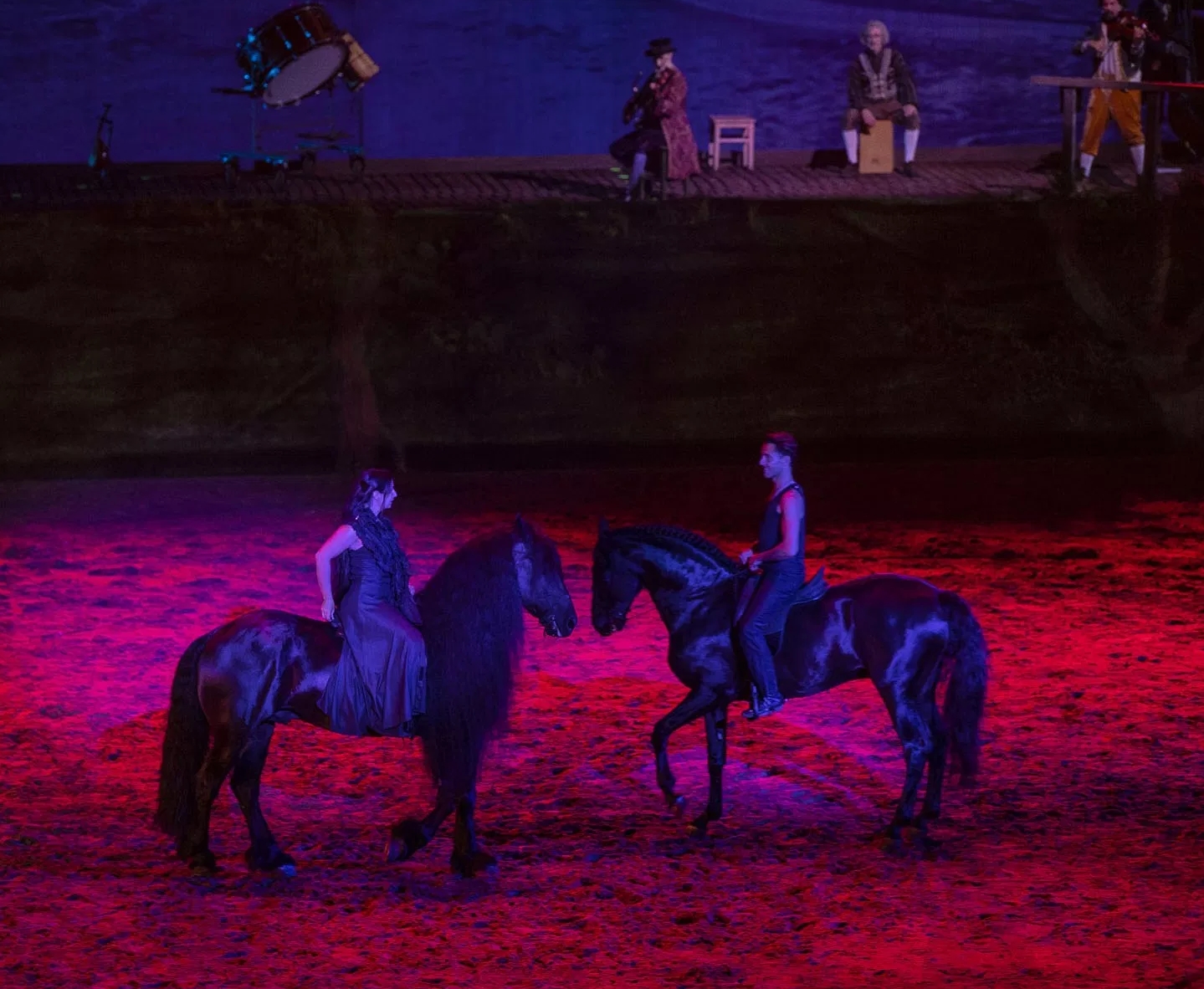
Below Théâtre du Centaure. See what he can do with a horse, you can click here
Although from 2015, he does almost the same in Leeuwarden! So you see again, centaurs really exist! Man merged with the horse!
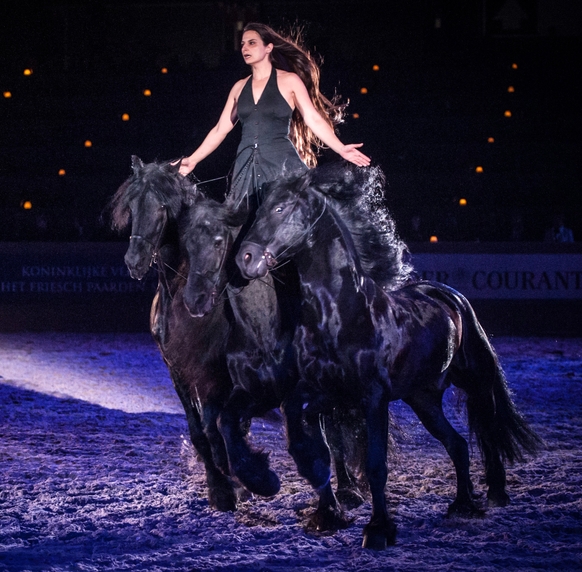
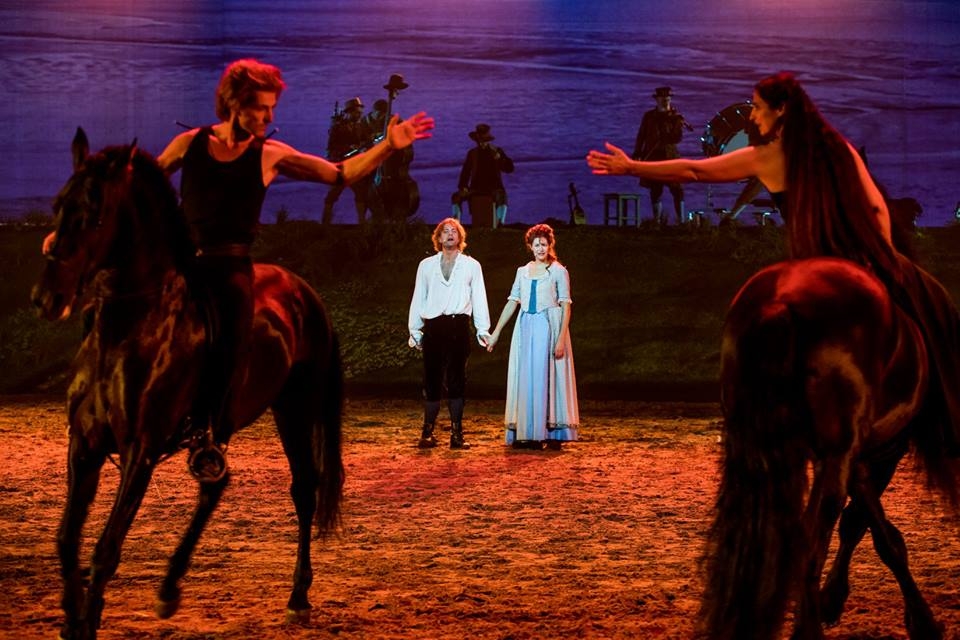
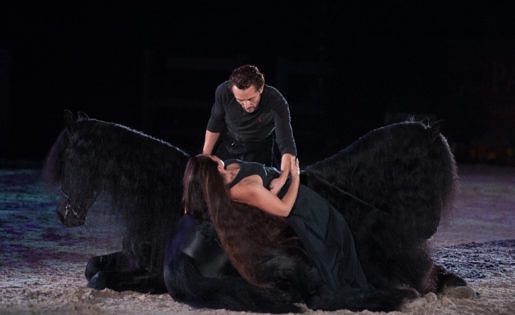
Friesland and the culture
As a Friesian resident, I'm a proud resident. This link is about part of the culture the Friesian Horse came from. It might sound a bit patrionistic, it's a sense of pride. Patriotism is generally not experienced
as negative, but related concepts such as "nationalism" and "chauvinism" just are. There is so much to include that I choose to make a selection, this link should not become a book. If you are interested,
you can read the extra's and otherwise you are free to skip it. It's about the 'Elfstedentocht' (Eleven city iceskate tour, this ), the Friesian horses, the Friesian sports (Fierljeppen and Kaatsen) the
nature and culture. The beautiful Wadden islands are pearls in the Waddensea and Unesco heritage.
For the Dutch: The Friesian History
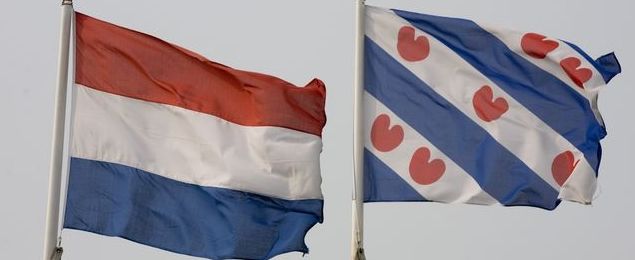
The Horse resque Marrum, Friesland
MARRUM, Netherlands — Rescuers on horseback lured a stranded herd of about 100 horses off a mud-soaked knoll where they had been stranded for three days and led them through receding floodwaters
to safe ground Friday. Before they could be saved, 19 horses drowned or died of exposure from the days and nights on the earthen mound that was turned into an island during a storm Tuesday night.
The plight of the horses has riveted the country, which followed rescue attempts on television and in newspapers after the storm surge pushed sea water into the wilderness area outside the dikes of Marrum,
a town 90 miles northeast of Amsterdam. Four women on horseback guided the animals back, and the entire herd — except one horse — followed without hesitation. One of the women fell into the brackish
water during the ride back to higher ground about 650 yards away, but she was uninjured and remounted her horse to finish the job.
Last horse collapses
The remaining horse was led back later, escorted by riders. It collapsed after
reaching shore, and was being attended by veterinarians.
Photo below is copyright: Peter De jong / AP
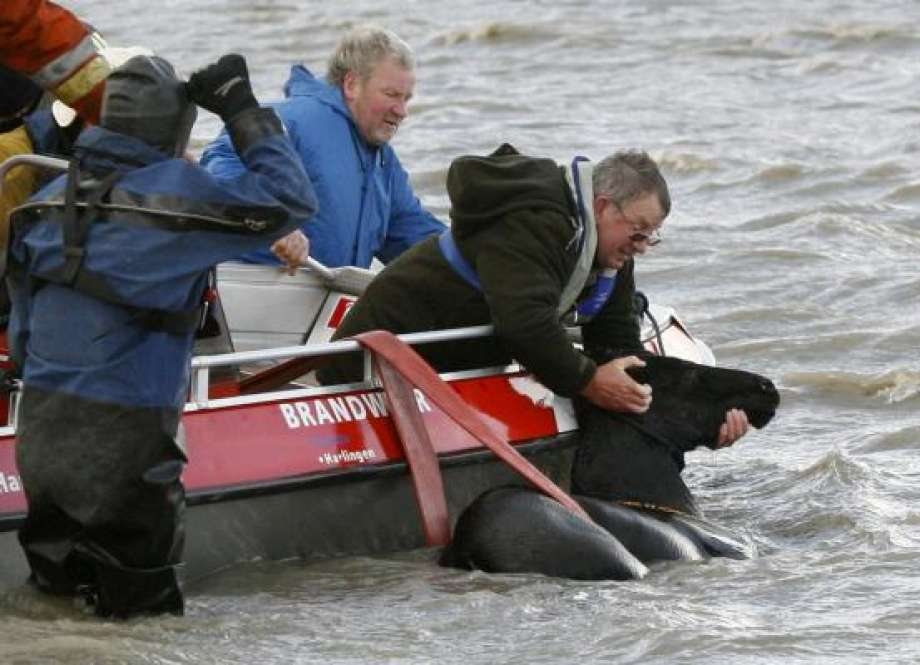
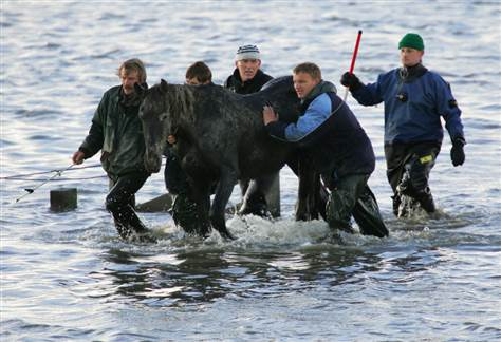
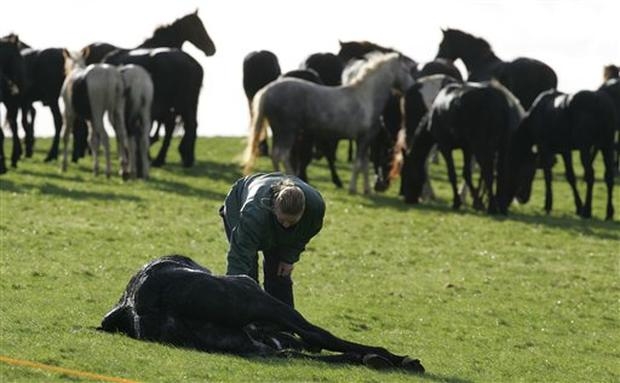
The quality of these films are bad
Rescue workers lead the last horse off the knoll. The horse later collapsed and was taken to a stable by tractor.
Earlier in the day, firefighters and animal welfare officers had carefully mapped out the return route.
The storm lifted the North Sea waters as much as 13 feet above normal. Three days later it was less than 3 feet deep in most flooded fields, but up to 6 feet deep where they are crisscrossed with drainage
channels and barbed wire. Marrum's fire department floated or ferried around 20 horses, including the smallest foals, to safety with the help of small boats Wednesday, but rescue efforts later stalled.
Dutch television and newspapers earlier showed dramatic images of the horses huddled together, their backs to the wind that was whipping up small waves in water surrounding their isolated island.
Rescuers had been feeding the animals with hay and giving them fresh water to drink to keep up their strength.
Boats
grounded, helicopters too loud
The Dutch army also tried to rescue the animals Wednesday afternoon, but called
off the operation when water levels receded to less than three feet in some
places, grounding pontoon boats.
Marrum's mayor, Wil van den Berg, said helicopters were ruled out for transporting the animals, as the noise and lights might have panicked the animals and caused more to drown. An animal rights group said it
has filed a complaint against the horses' owner and the operator of the wilderness area where they are stranded, since the Netherlands' national weather service had put the country on alert for rising flood waters early
Tuesday. The Agriculture Ministry ordered an investigation into the incident."We're going to work together with prosecutors to see whether there was any criminal act committed," spokeswoman
Anita Douven said. "That could be negligence, or possibly mishandling of the animals."
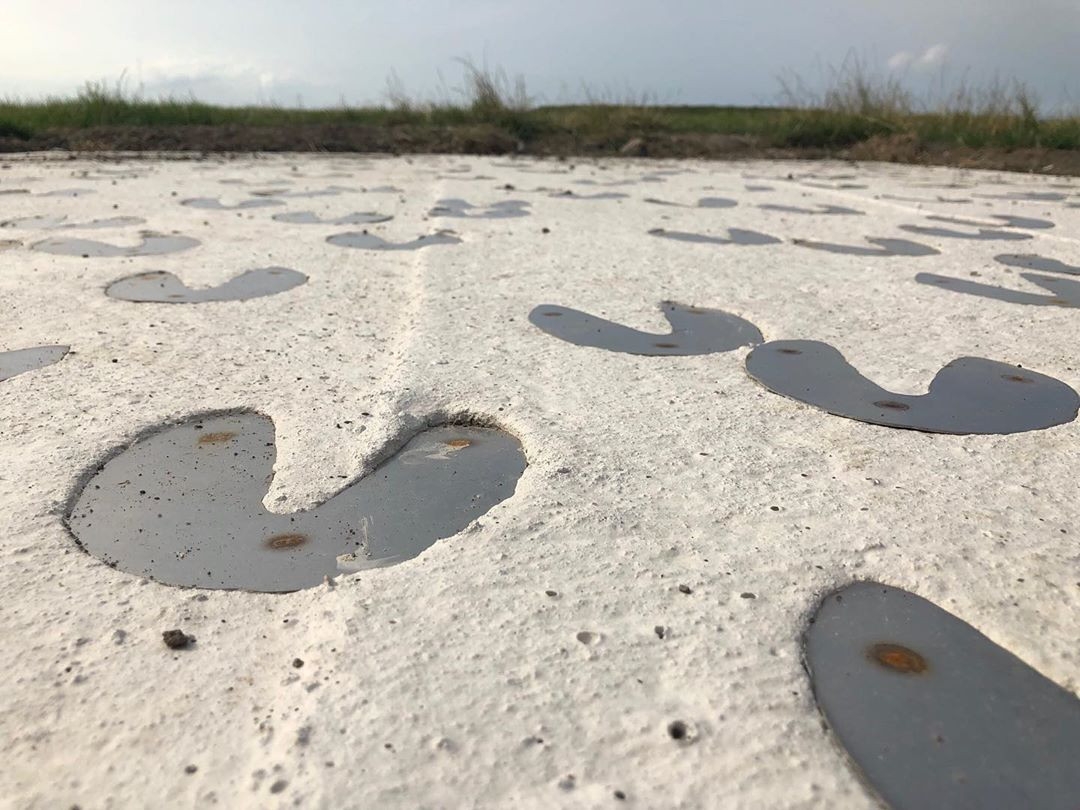
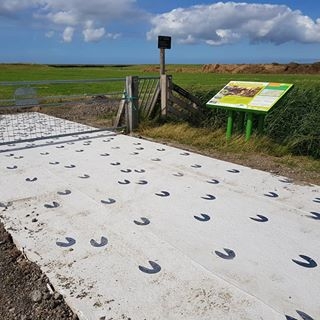
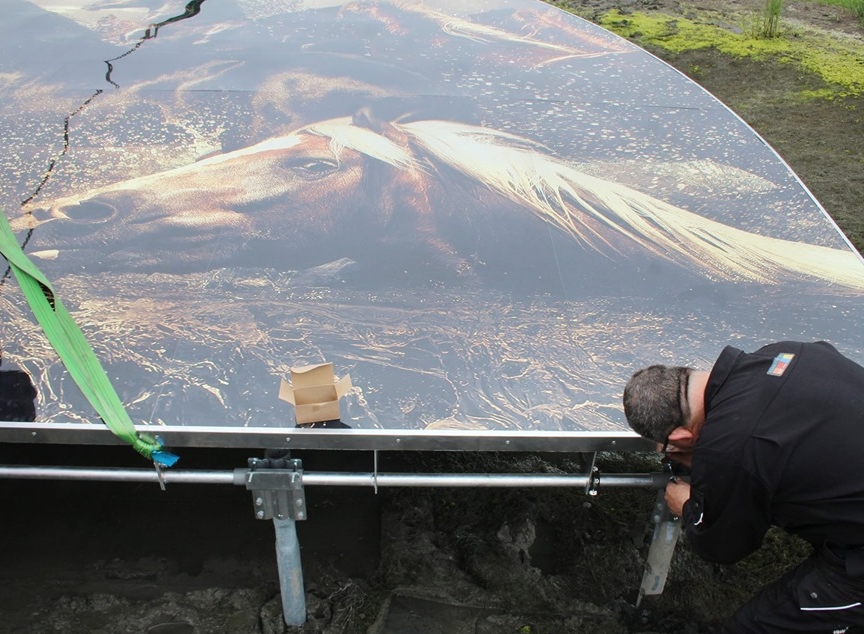
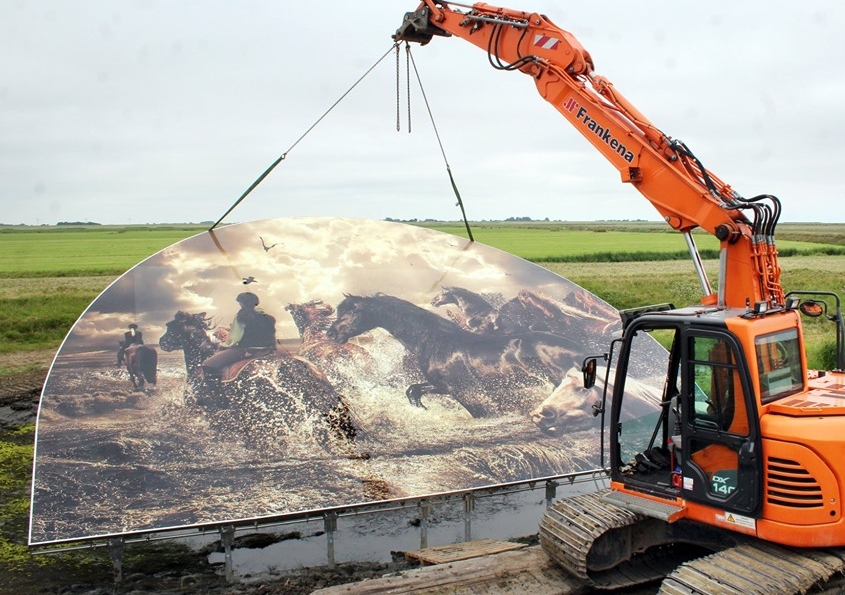
Horse hoof decorations and a symbol of the Friesland flag. On the right the monument.
The tricky thing is that the Noorderleeg area is outside the dikes. In the crashing season the animals have to leave on time because with wind from storm, high tide the water is pushed up and everything is submerged.
The area has three high hills (called 'dobbes') with fresh water in it for the sheep and the horse to drink. The sheep were already gone but the horses were not. the farmer has been fined for negligence. He himself says
that he did not get such a group of horses away so quickly and drove them to the highest 'dobbe' before the storm, but that they had gone with the group to a lower one that was closer to land. You can see that the
floats are hollow, so they can only be on the edges that were completely trampled. People react indignantly to the farmer and that they cannot get away from animals. it is also more difficult than you think.
Unfortunately, the area is divided into sections, that is to say many channels with wire, including barbed wire. If you walk in the beautiful area, the amount of closed fences and lines always bother me. A few horses
had swum to the dike themselves and swam against the dread all morning ... no one cut it off ... it was because there were irregular messengers and you could barely see the lines because of the high, restless water.
many people have seen those horses drowning in front of them just in front of the dike every day in the early morning. They were there but could not land and then there is also a very deep ditch. pretty horrible.
The locals were not allowed to do anything. I have been there 3 days day and evening to offer my help together with many others from the area but the did not know what to do. an army pontoon was to be rolled
out and the horses could walk on. That soon became nothing ... another day lost from the pontoon came from far away ... the locals suggested drawer from day 1 to ransom horses ... yet it had to take days.
The dangerous thing was still ... a route was laid out but that route was only narrow ... there are so many canals and barbed wire pieces that it is very dangerous if the horses arrive at the same time or panic.
therefore everyone held their breath until the last step. And then the discharge of emotions ... all hundreds of horses running across the dike .... beautiful! Some are exhausted and are rubbed dry with straw
by a number of animal lovers.
The white horse Freya (you see below) is bought by the farmer opposite the drama and has always taken good care of her and a foal from her. His always stood in the stable with my horse (2017). I still know
Freya but unfortunately she is no longer alive. Freya the white horse that caught the eye of the press in the storm and among the dark-colored horses. She was in many newspapers ... the symbol of hope.
This video has clearder shots! It's worth watching. Freya was old and her brown foal doesn't live anymore, had something in her head. (2019)
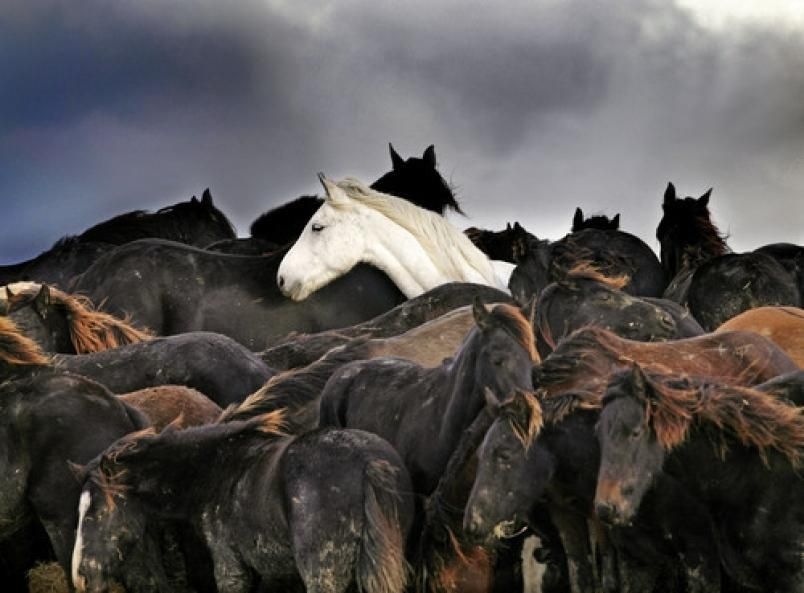
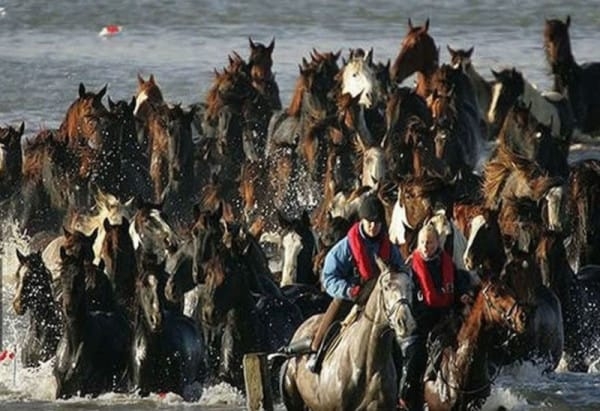
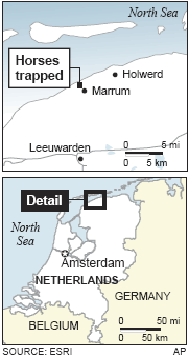
When a huge storm surge pushed seawater into the earth outside the dikes of the village of Marrum on the night of October 31, 2006, 150 horses ended up stranded on a ‘dobbe’ (a type of small island)
behind the dike. After a joint effort involving wranglers, firefighters, veterinarians, animal welfare officers and the Dutch Army had failed to bring the animals to safety, six local women on horseback successfully
herded all but one of the horses across the path. It was an extraordinary event, and the story of the Marrum Horse Rescue is etched in the collective memory of Dutch nature lovers and horse aficionados alike.
A memorial was subsequently erected in 2011 to mark the bravery and ingenuity of these women.
The area of the horses
‘Noord-Fryslân Bűtendyks’ consists of summer polders, ‘dobben’, salted grasslands, mud fields and salt marshes. The area is over 4180 hectare. You will find many birds here, including meadow
birds like the redshank and yellow wagtail. They are joined in winter by the brent goose and barnacle goose, finding their food for the winter.
The Elfstedentocht
The 11 cities (iceskate) tour
The biggest Ice-skating tour in the world
The biggest ice-skating tour in the world became very rare because of the warm winters we have nowadays. The first Elfstedentocht took place in 1909 and has been held 15 times in total. There is an
alternative skating tour on the Weissensee in Austria. This tour is every years and didn't go through cities like in the Netherlands, but perched high in the cold alps it can go on every year and the Dutch
Elfstedentocht is rare, because it has to freeze long enough to carry so many people. And rare because all those 11 towns are connected via the water (200 km). When it starts to freeze in Holland in
the Netherlands an Elfsteden fever starts.
The tour is held at most once a year, only when the natural ice along the entire course is at least 15 centimetres (6 in) thick; sometimes on consecutive years, other times with gaps that may exceed 20 years!
When the ice is suitable, the tour is announced and starts within 48 hours. The last tour was in 1997. There has never been so much time between two editions as now. The old record stood at 8070 days,
between the editions of 1963 and 1985. 2012 and 2020/2021 we were pretty close to riding it. I skated it myself in 2012, not official. Because the official didn't come because of the thaw.
Our governorment decided it wasn't allowed because of Corona. This event may attrackt half of our national population.
One day and 200 km........
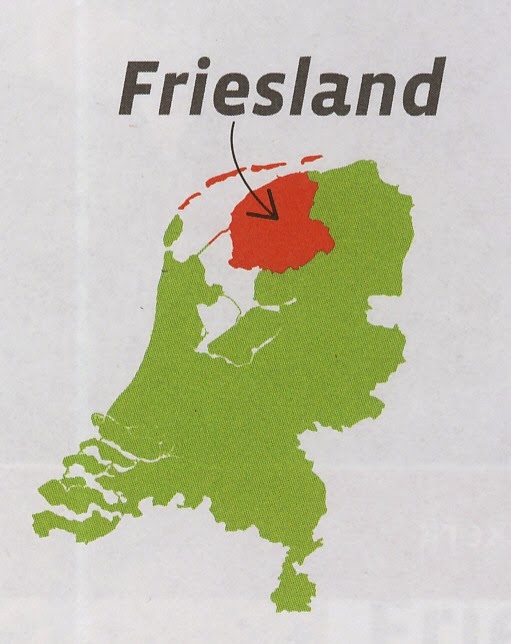
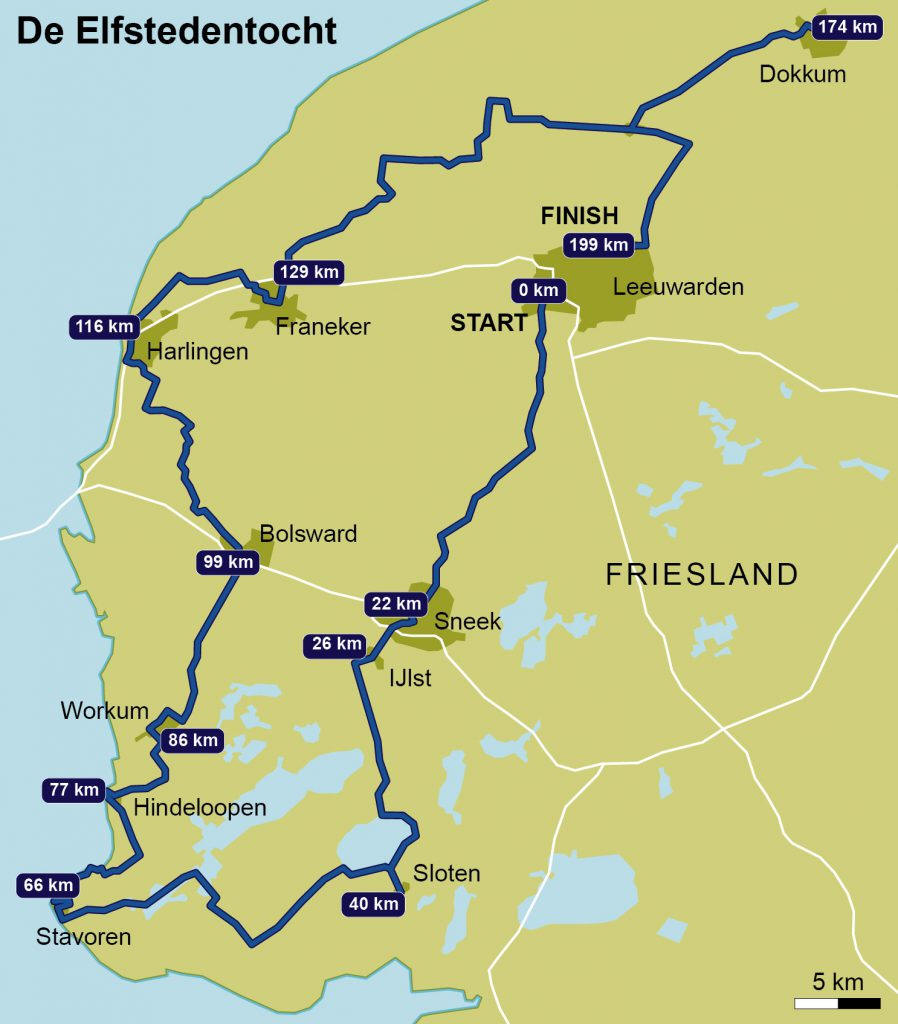
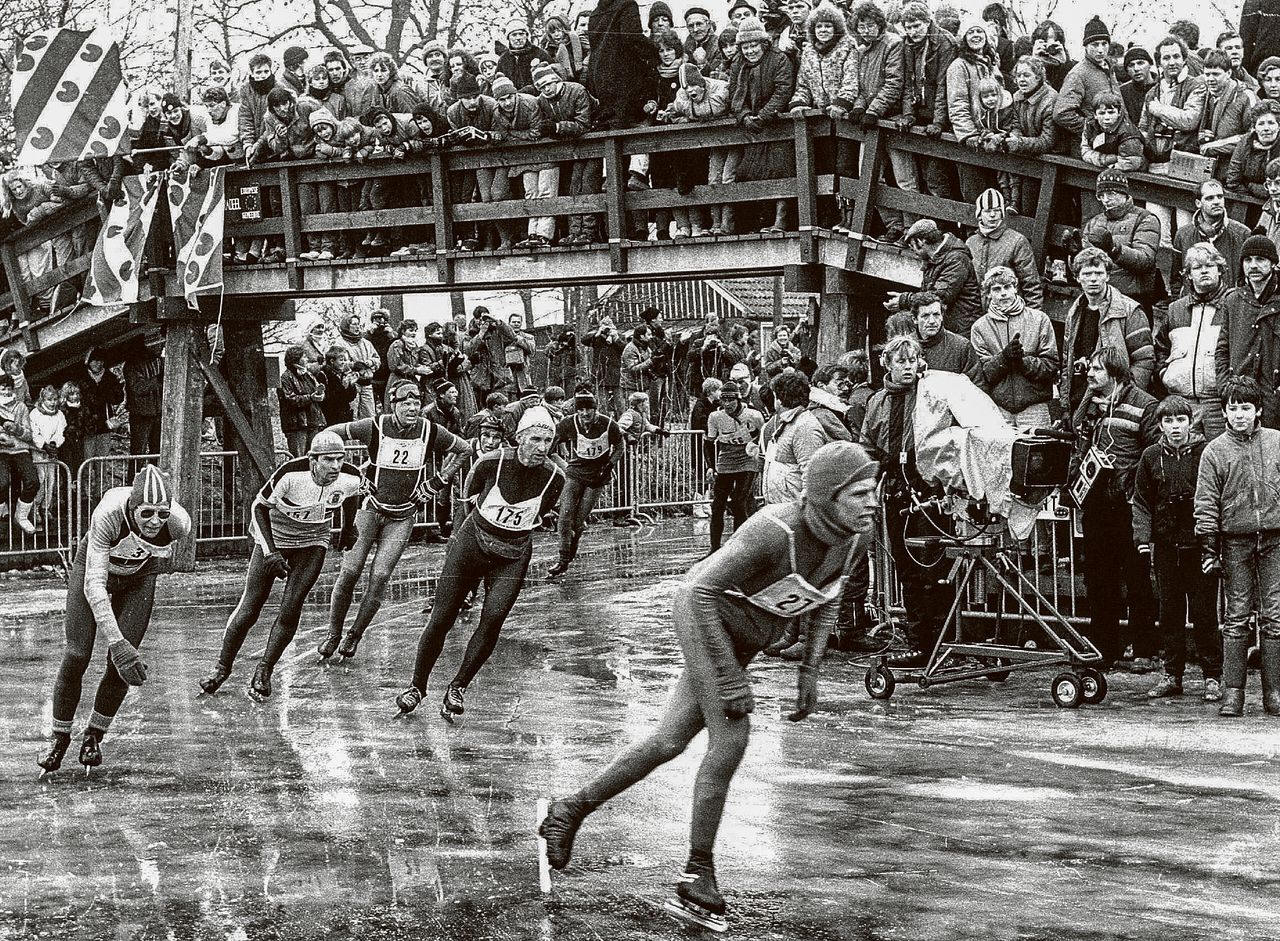
Skated since 1909, you can click here to read about the history.

In the city Sneek. The waterpoort (the watergate) in the distance. This year 2021 it we skated as well in front of the
waterpoort. Corona or not, it is outdoors. So many people enjoyed and looked so happy...music around, all people were kind and looked happy.
The atmosphere is amazing on the ice in Holland. It seems all the good people came. People who enjoy being together and loving the elements.
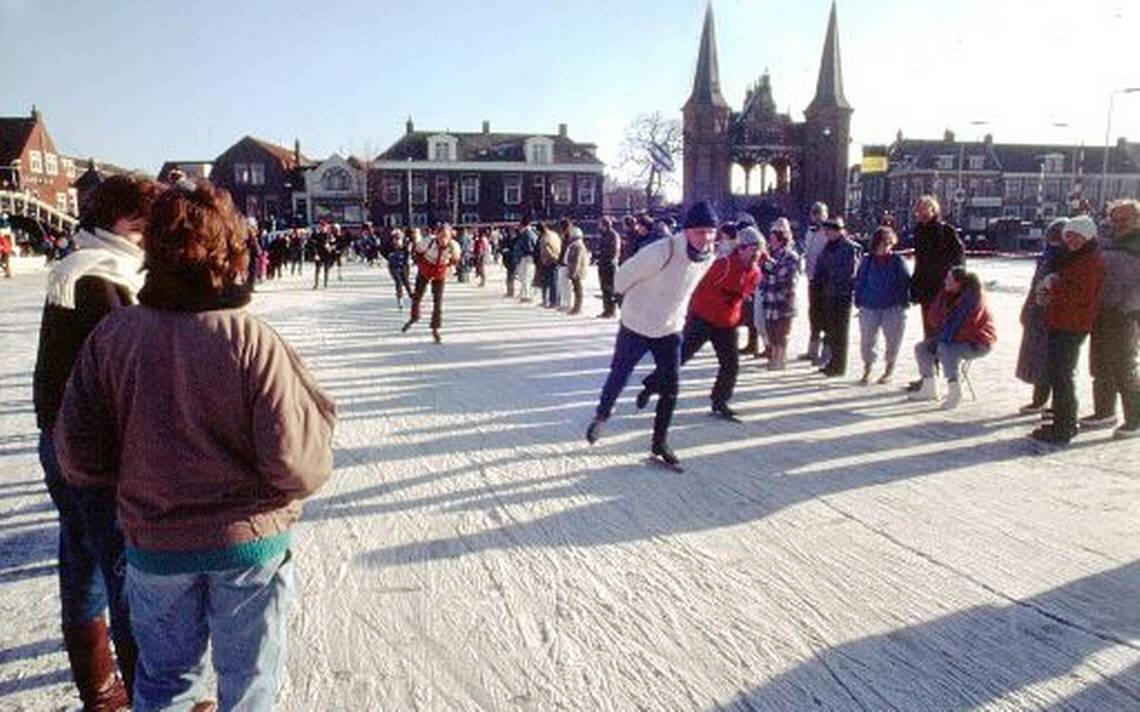
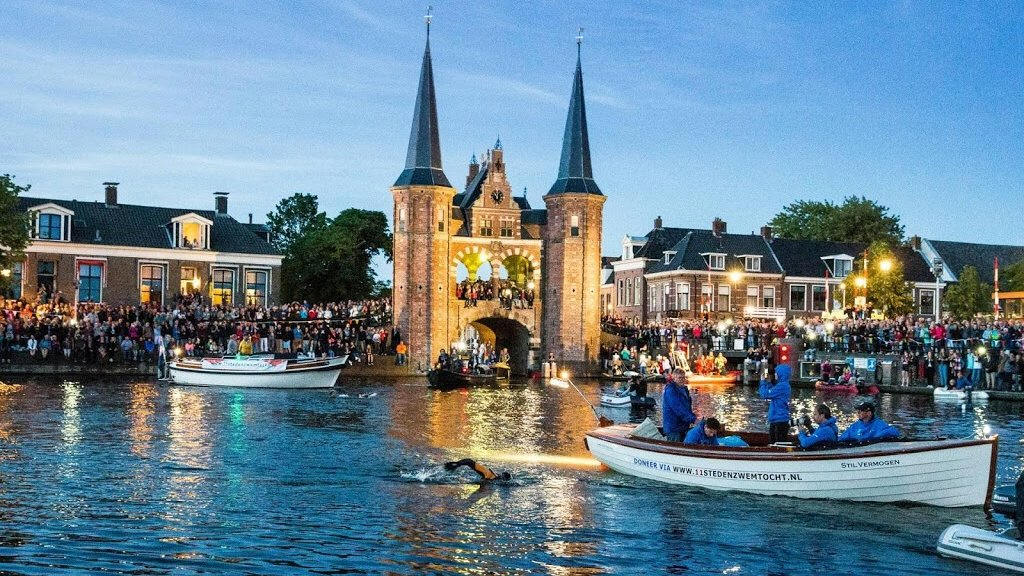
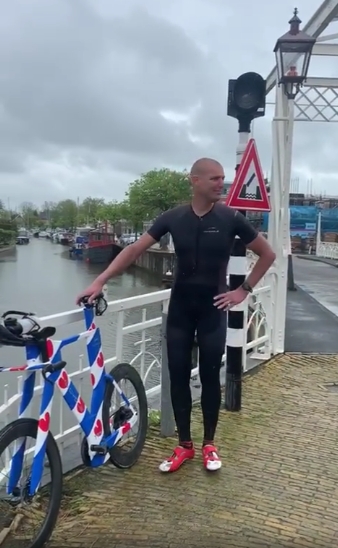
The photo in the mdidle is also of Sneek with a swimmer! Elfstedentocht in 3 days with a few hours sleep for cancer.
Sneek during the swimtour (summer 2019) with our Olympic Maarten van der Weijden (Multi) National and Olympic (2008) champion. He once fighted against
cancer and lost a good friend, he gave all to beat this disease. It seemed half the province walked out to support him on any spot of the 200 km! Fantastic rare
atmosphere for a very good cause! And Maarten did it again in May 2021 by bike (right photo). Not as heavy as skating or swimming, but for a good cause charity.
1963 Dokkum Dokkum, this was probably the last tour in 1997
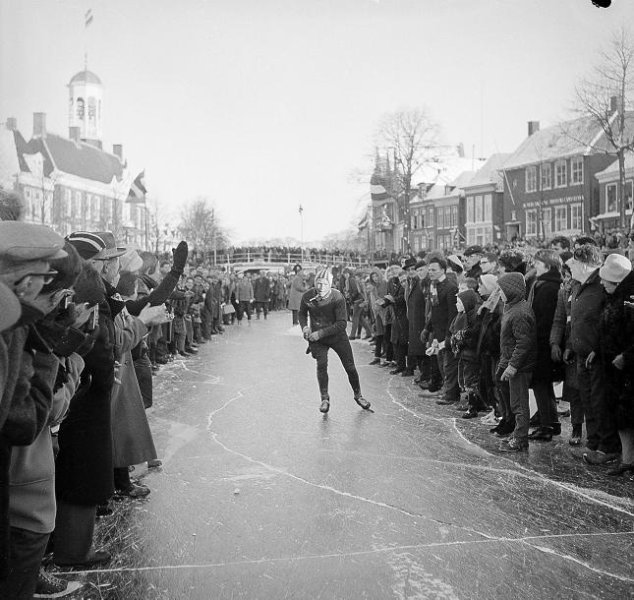
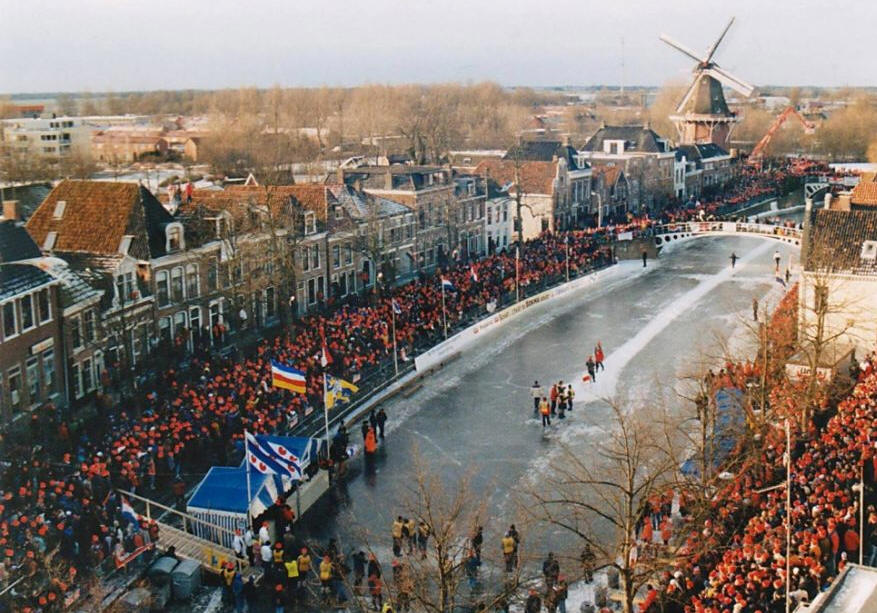
The Enclosure Dam
"Enclosure Dam" is a major dam and causeway in the Netherlands. It was constructed between 1927 and 1932 and runs from Den Oever in North Holland province to the village
of Zurich in Friesland province, over a length of 32 kilometres (20 mi) and a width of 90 metres (300 ft), at an initial height of 7.25 metres (23.8 ft) above sea level.
the dam attracts tourists but I don't like it myself. They have been struggling for years to find out which project should come up and now many wind turbines have been put into the sea that do not prove
that they are green. Nature is minimal and you can only see the lake from the road and not the sea. They have been renovating for three years and no cyclist can get over it for three years, much to
the discontent of the cycling association. The Wadden Sea and the islands that you can see in the distance are of a special great beauty! that's a completely different world. the Friesian mainland still has
a lot to learn with regard to biodiversity, which is increasingly being squeezed by very intensive arable farming. causing meadow birds to disappear on a large scale. The result is very quiet meadows and that hurts.
I think the biggest challenge will be to conserve our nature, but land prices are rising so there is no margin for extras for the farmers and we produce too much for export while
we are a densely populated small country. The full history can be read over here.
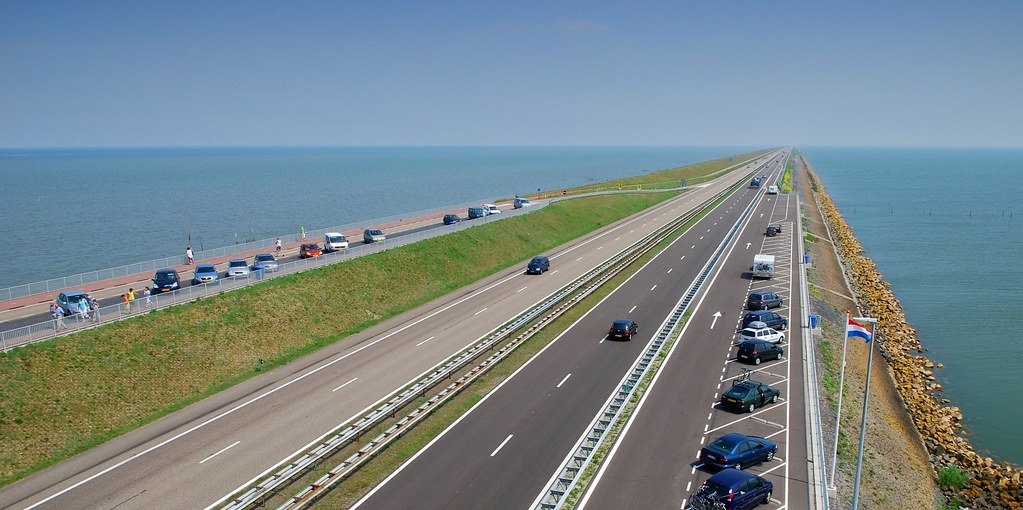
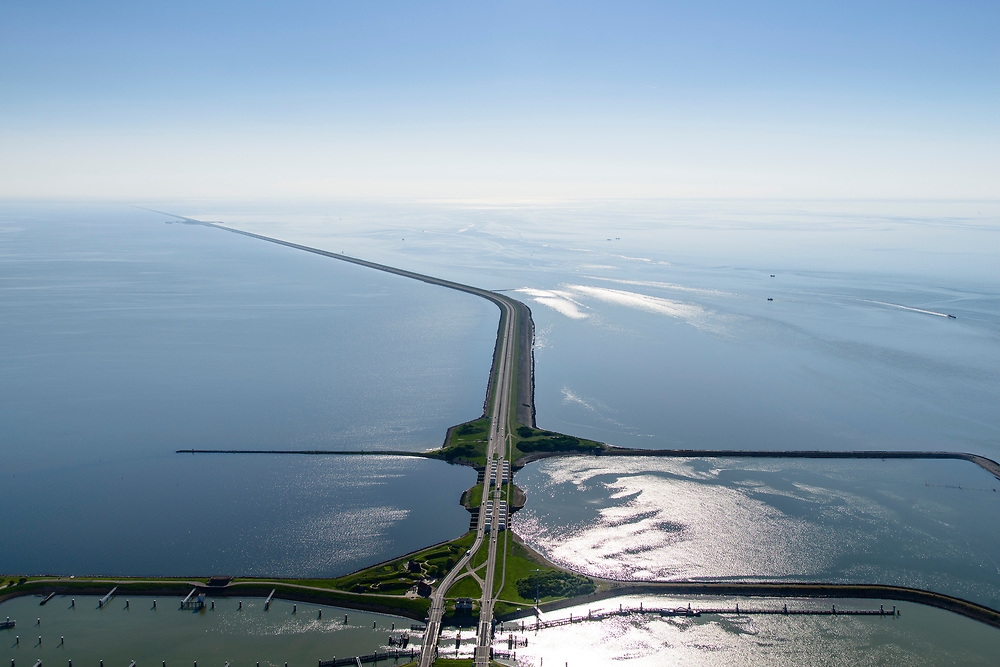
The Enclosure Dam / Afsluitdijk is a fundamental part of the larger Zuiderzee Works, damming off the Zuiderzee, a salt water inlet of the North Sea, and turning it into the fresh
water lake of the IJsselmeer. The dam serves as a sea barrier to protect the inland against flooding.
The Dutch map, the line attached to Friesland is a 30 km dyke, since that dyke is built the water in the middle that used to give straight acces to Amsterdam became no longer a see but the biggest lake.
Gates of Light is a futuristic entrance at both sides of the dike. Inspired by retroreflective wings of butterflies, Daan Roosegaarde brings a new light on the 60 monumental floodgates which were designed
by Dirk Roosenburg in 1932, the grandfather of the Dutch architect Rem Koolhaas. They have been restored with a retroreflective layer which is illuminated by the passing cars' headlamps.
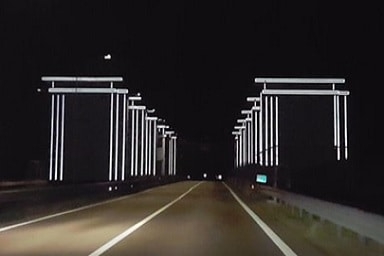
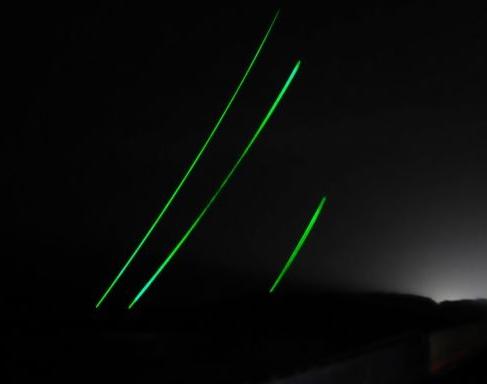
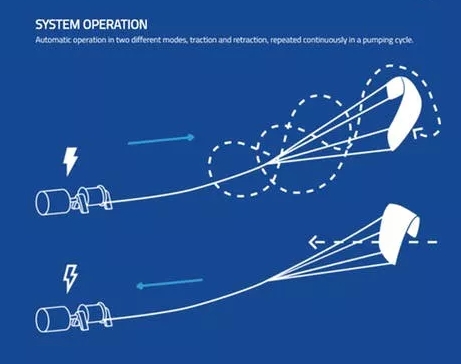
Windvogel is a tribute to the Dutch astronaut Wubbo Ockels. Ockels had the dream to realise smart kites which generate power by having them stay aloft for long periods of time.
He was one of the pioneers in the field of kite power generation and professor of the research group at Delft University of Technology from which the startup Kitepower arose. Each of the
Windvogel kites generates from 20 to 100 kW which can supply energy for up to 200 households.
the contours of the monumental lifting towers (of the locks) are literally highlighted as they are illuminated by the headlights of the moving traffic over the dike.
The gates of light are cool, but peronally the Afsluitdijk was cleverly made in the past! Personally I find the dyke ugly and unnatural. I would like to see many more nature and recreation projects
alongside the long dyke. After major maintenance, I think it's a shame that they didn't make the road at the highest point of the dike so that you can see both sides of the water with the Wadden
Islands in the distance. Now only the lower lake side. there is much more beautiful to get out of it.
There were also plans for a huge Friesian horse at the entrance of Friesland, lighted in the evening, but still it's not there anno 2019. I think it's a shame our governorment
didn't get such a project off the ground. Here it's in Dutch but with drawings, photos and English words.
Windvogel was presented as the last component, which happened in the evening when the guests from politics, social institutions and the business community were invited. Huge kites generate
electricity through movement. This is reflected in the lifting of the cable. The idea comes from the deceased astronaut Wubbo Ockels, Roosegaarde has included this in Icon Afsluitdijk in
consultation with his family. In a film made about this project, the attendees saw the widow of Wubbo Ockels together with Daan Roosegaarde watching a test with the Lichtvogel, touching.
Wubbo Ockels was the first Dutchman in space. Like most astronauts who saw the Earth from a distance, Ockels came back like a different person. He saw our planet in all its
vulnerability and knew: we have to be careful with this, there is only one.
Sustainable projects
Back on Earth, Ockels wanted to give us that feeling, but how do you do that for people who have not been in space? He started several sustainable projects to show us that a sustainable
life can also be a fun life: kites to generate energy with, an electric superbus, a sustainable ship. His projects attracted a lot of attention and Ockels was one of the first to make us think about sustainability.
Save the earth
In the end, his most important fight became the fight against death. Ockels died of cancer in 2014 at the age of 68. He made a call on his deathbed. Save the earth. Do something,
even if it is something very small. His call has been answered. Now, exactly five years after his death, dozens of students from Ockels are busy developing his findings and ideas.
There are now kites generating energy, a solar car team that wins almost every major race and its sustainable sailing ship is being prepared for a trip to the North Pole.
Now the lake is full of windmills, which I think is terrible, it is very bad that this project of him has been canceled.
The horse statue
Will it come? It's still not there...such a shae.
The large statue is not there yet. It is already designed. People are still collecting money for unexpected costs and there is still a permit for a definitive place.
I hope that it will be at the head of the Enclosure Dam so that it will be visible from all sides and at the entrance of Friesland. Such a statue deserves a high promiment place.
Kelpies sculptor Andy Scott talks about his moments of inspiration
Left: the design of the huge horse. People prefer to see it placed on the Enclosuredam, entering the province.
Right: The statue in the centre of the Friesian capital 'Leeuwarden' (in the Friesian language: 'Ljouwert').
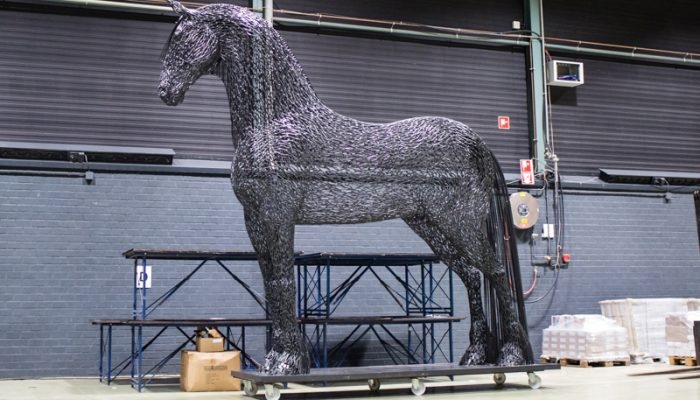
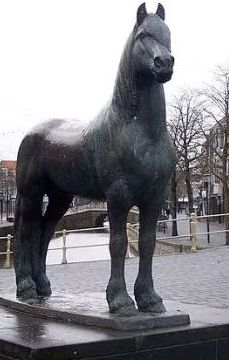
Designer: Andy Scott
The sculptures that Andy makes are handicrafts. Like a traditional sculptor, he processes the steel into a work of art. For the larger projects, we work together with teams of
professionals such as constructors, steel builders, light designers and landscape architects. Andy Scott's work has been awarded several times for "Best Equine Sculpture in the World"
by Art Horse magazine in the United States. One of his sculptures has also been named "most popular sculpture in Ireland". Andy is currently being followed by a camera crew for a
BBC documentary about his work. Below the design, not placed yet (2019). I've been told the amount has been collected but they needed reserves for extra costs and the
location of it is not yet completely determined. This is what it could look like.
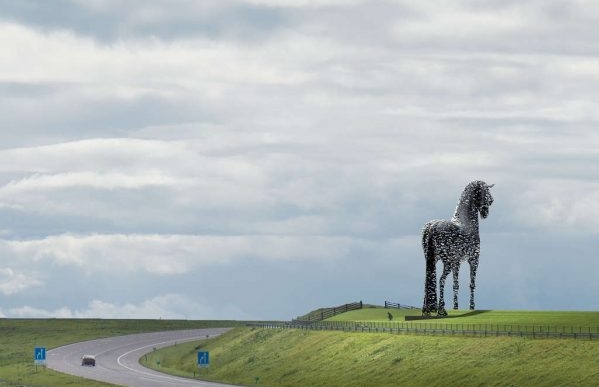
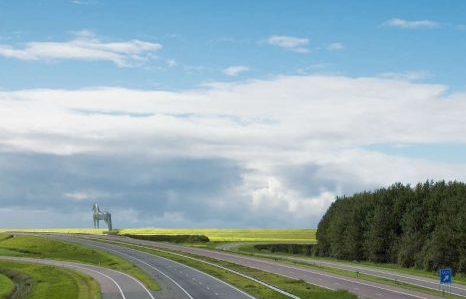
Handmade
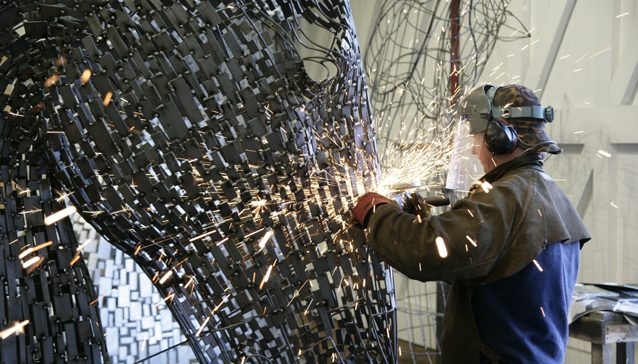
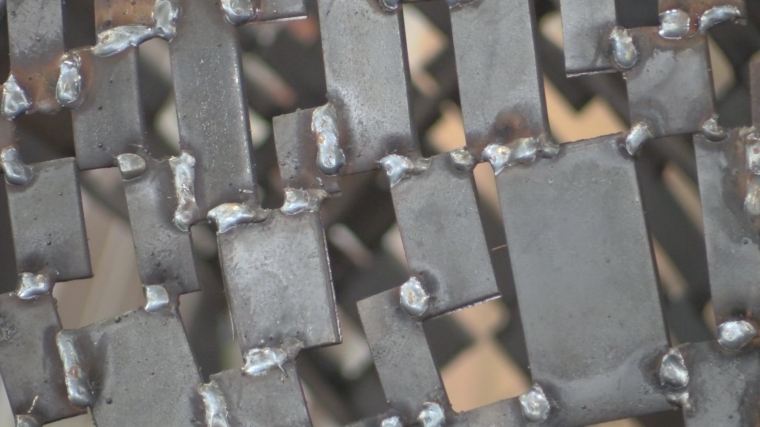
Andy’s images can be seen in America, Spain, England, Ireland, Australia and of course Scotland. He is currently working on "The Kelpies", two steel horse heads 30 meters high,
Other examples of workhorses in his oeuvre are: "The Heavy Horse" along the M8 between Glasgow and Edinburg, "Clydebuilt" on Bondi Beach in Australia and "the Cob" on a roundabout in London.
On the photos you can see his most important artworks of horses from the past 20 years. Click for a larger image. For more information about Andy Scott and his work, see here.
The idea for The Horse of Fryslân is partly inspired by the work of the Scottish visual artist Andy Scott. Many of his sculptures represent pure-bred workhorses and their rich
history and connection with a specific region. The artist is specialized in the realization of images on a large scale.
Andy Scott graduated from the Glasgow School of Art in 1986 and is an associate of the Royal British Society of Sculptors. He has made more than 70 images that are placed in the public
space or visible from the public space. The sculptures are commissioned by a government, a company or a private individual. For several years the artist has been married to the Dutch architect Hanneke.
The previous Designs of Andy Scott
The two steel horses; the largest equine sculptures in the world
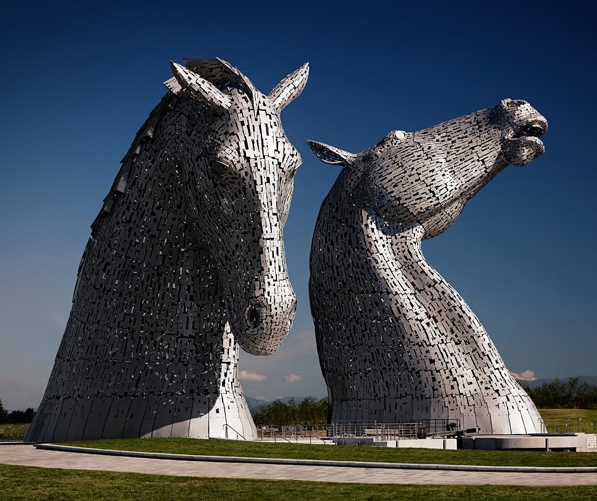
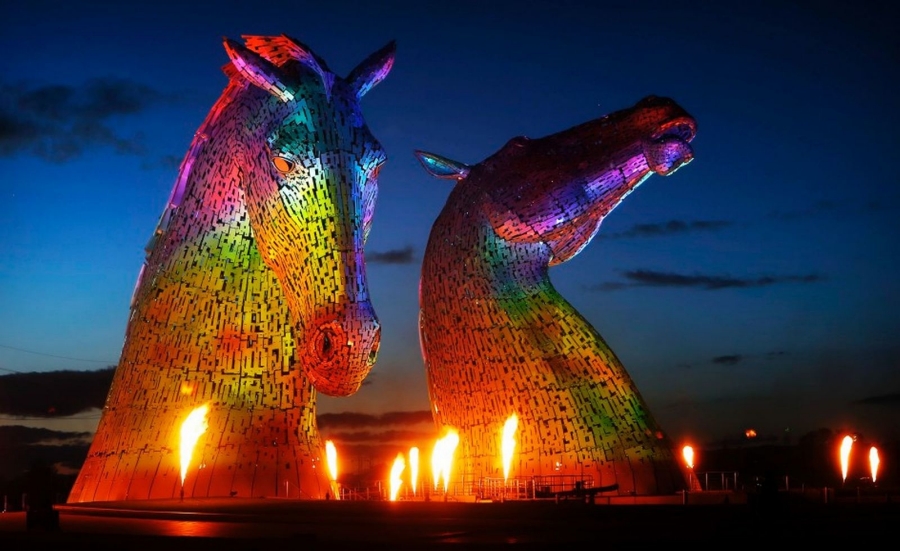
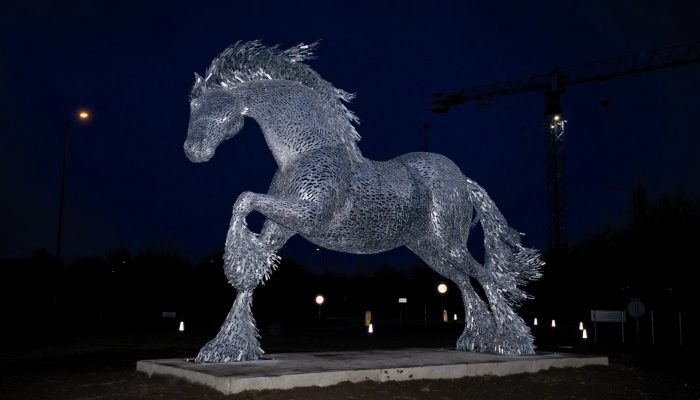
Sculptor Andy Scott is well known for the iconic Kelpies in Scotland, which are sited at the Forth & Clyde Canal in Falkirk. The two steel horses heads are the largest equine
sculptures in the world, inspired by the cultural heritage of the Clydesdale horses, draught horses, which worked hard to help people along the canals and on the land.
Below Andy Scott's The Cob installed in Belvedere COB. Bexley, London
The Heavy Horse by Andy Scott, overlooks the M8 motorway in north east Glasgow, photographed at sunset.
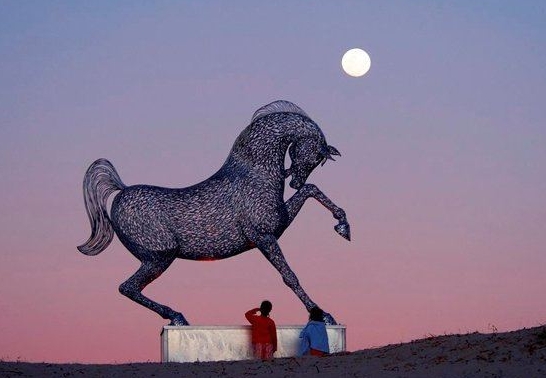
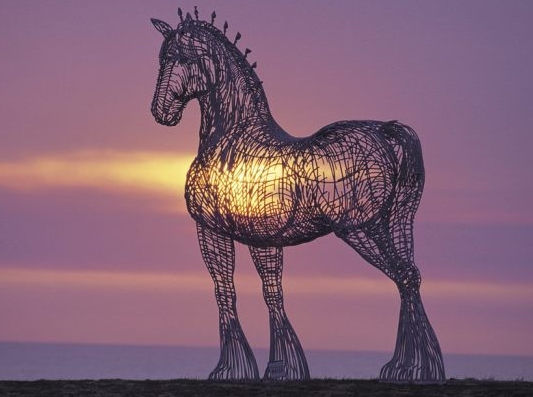
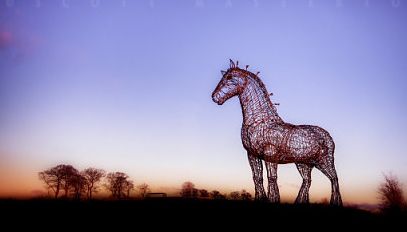
Sneekweek
The Royal Yacht Club Sneek (KWS) has organized this special event sinds 1934. It takes place in the north of the Netherlands,
in the province of Friesland. In 2020, the event
will be held from 1 through 6 August.
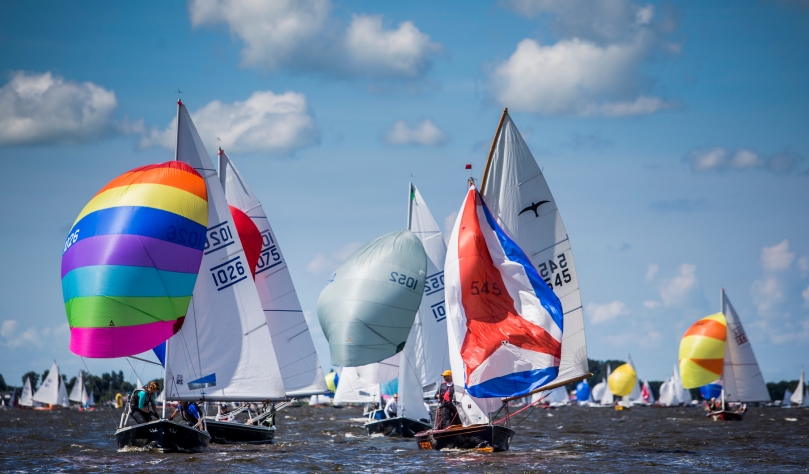
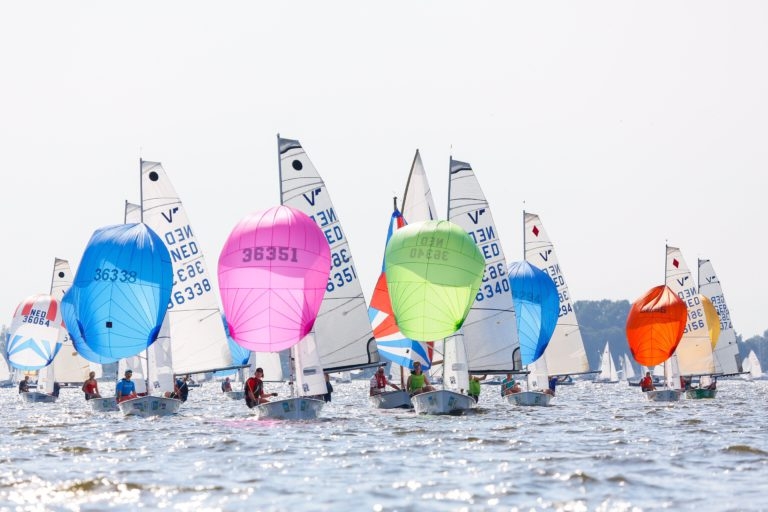
The Sneekweek is Europe’s largest inshore sailing regatta. The most important thing for many people, however, is the fun and hugely enjoyable atmosphere for which we are famous!
Sailors compete in 40 different classes. Vaurien, Yngling, Optimist, Finn, 2.4mR, J22, Laser and Splash among others offer loyal fleets that keep coming back for more. Sneekweek
easily compares Travemünder Woche or Kieler Woche, except it is much more personal.
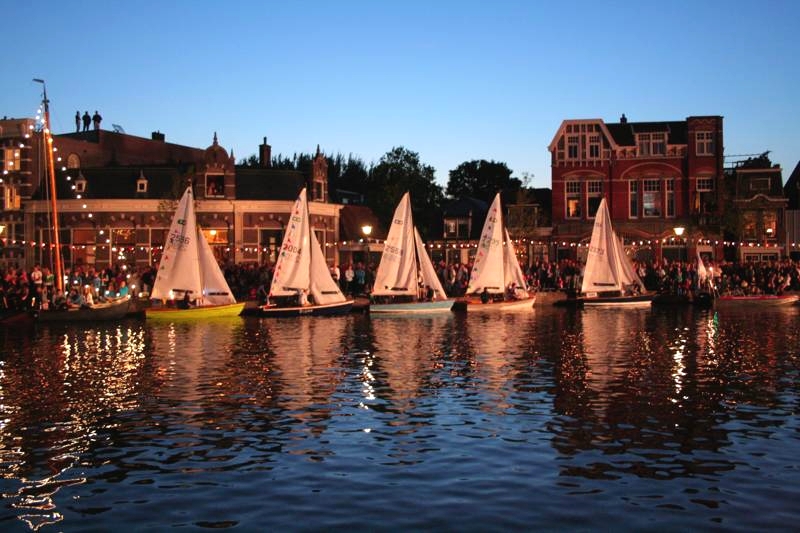
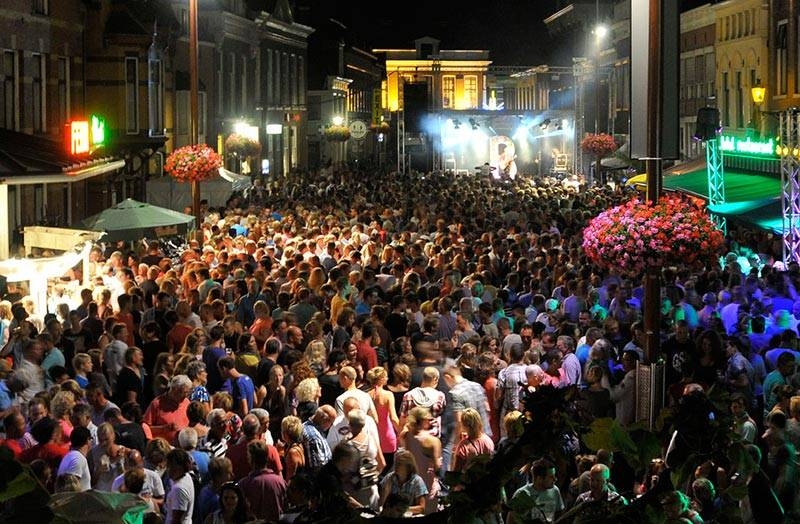
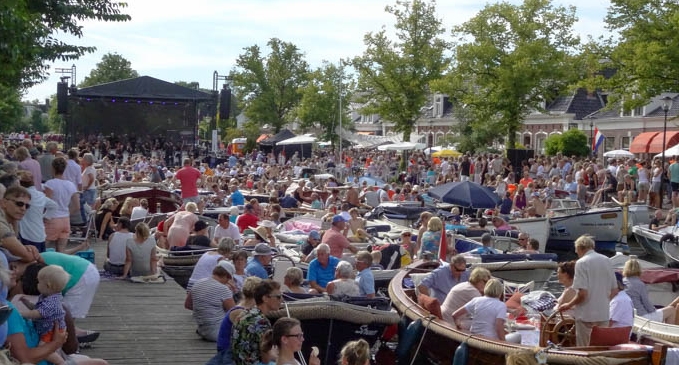
The opening ceremony
The opening ceremony will take place in the centre of Sneek on Friday 31
Juli at 9.30 pm. The event will be kicked off with a traditional “vlootschouw”.
Forty boats, each representing its class,
will be accompanied by classical boats and music. This ceremony ends around midnight with huge fireworks.
The races
The next day, the race committee will mark out the courses using 24 buoys,
spread out across different connecting lakes. The audience will come to the
Start Island in large numbers,
ensuring an excellent atmosphere. Sneekweek is a challenging, professionally run, but most of all very unique and down-to-earth event!
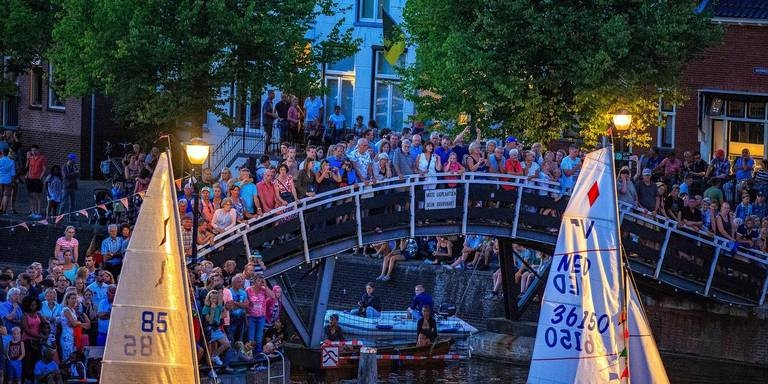
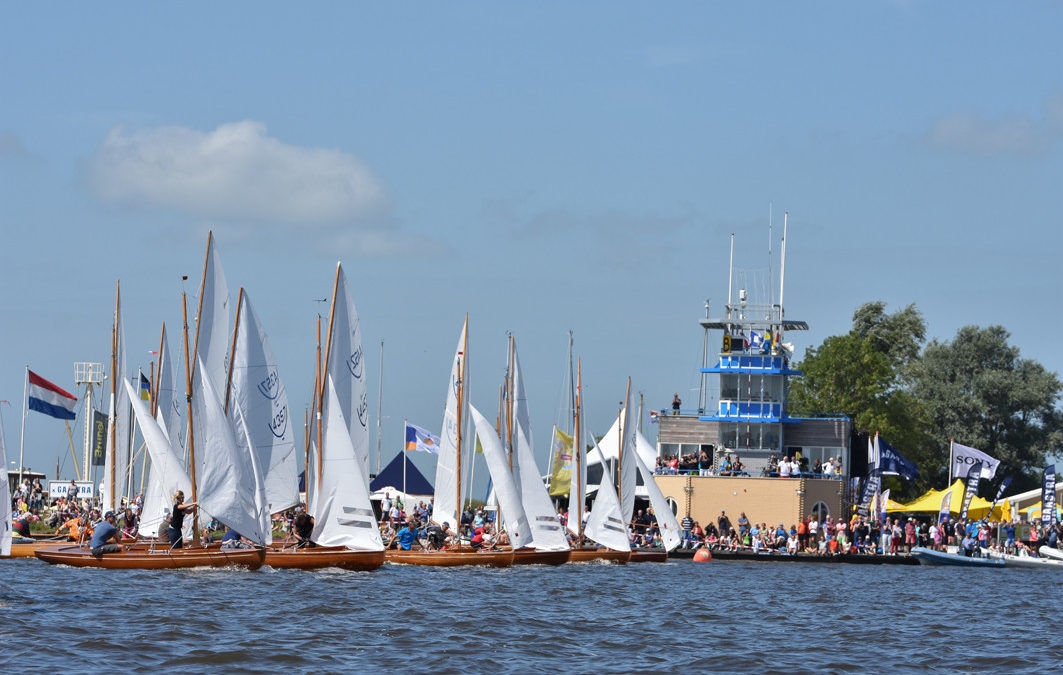
After racing
When racing finishes, the party begins! During Sneekweek the city of Sneek
dazzles more than ever before. In the heart of Sneek you will be entertained by
lots of different bands and
you can visit the local fun fair. Even the Start Island rocks with music night and day in a huge party tent.
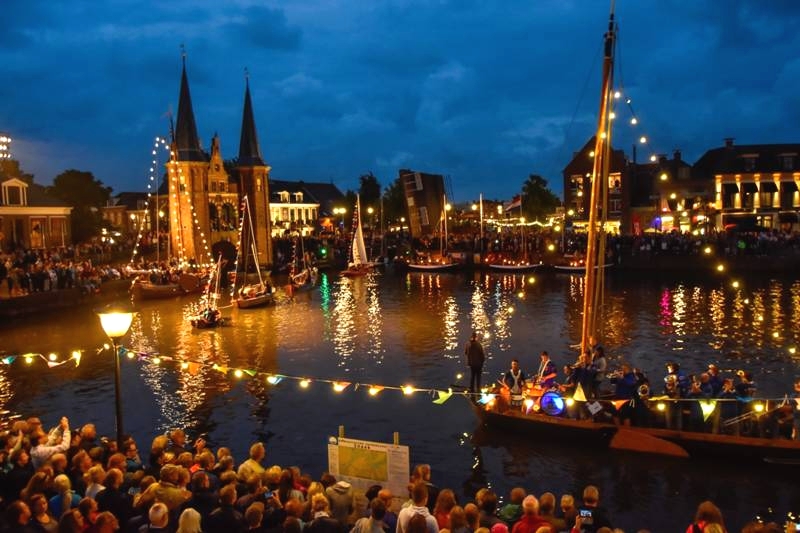
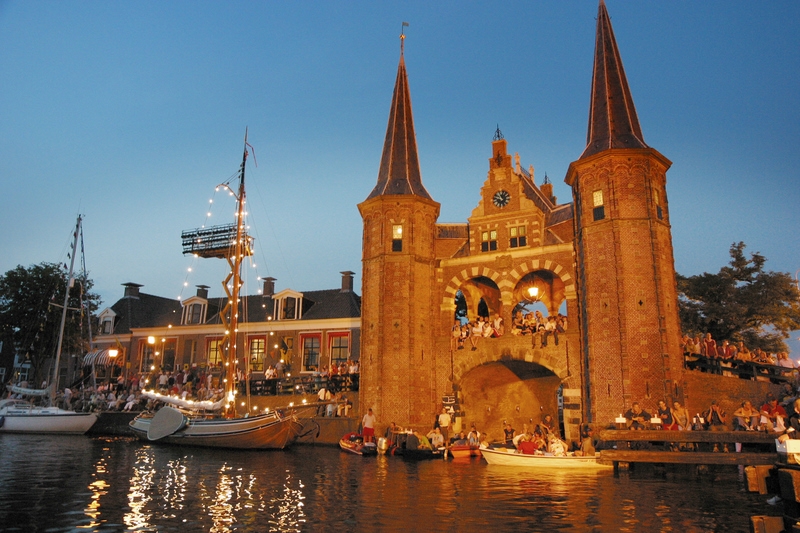
SKS Sailing
SKS sailing here you can read in English (click on the upper right of the following site) https://www.skutsjesilen.nl/
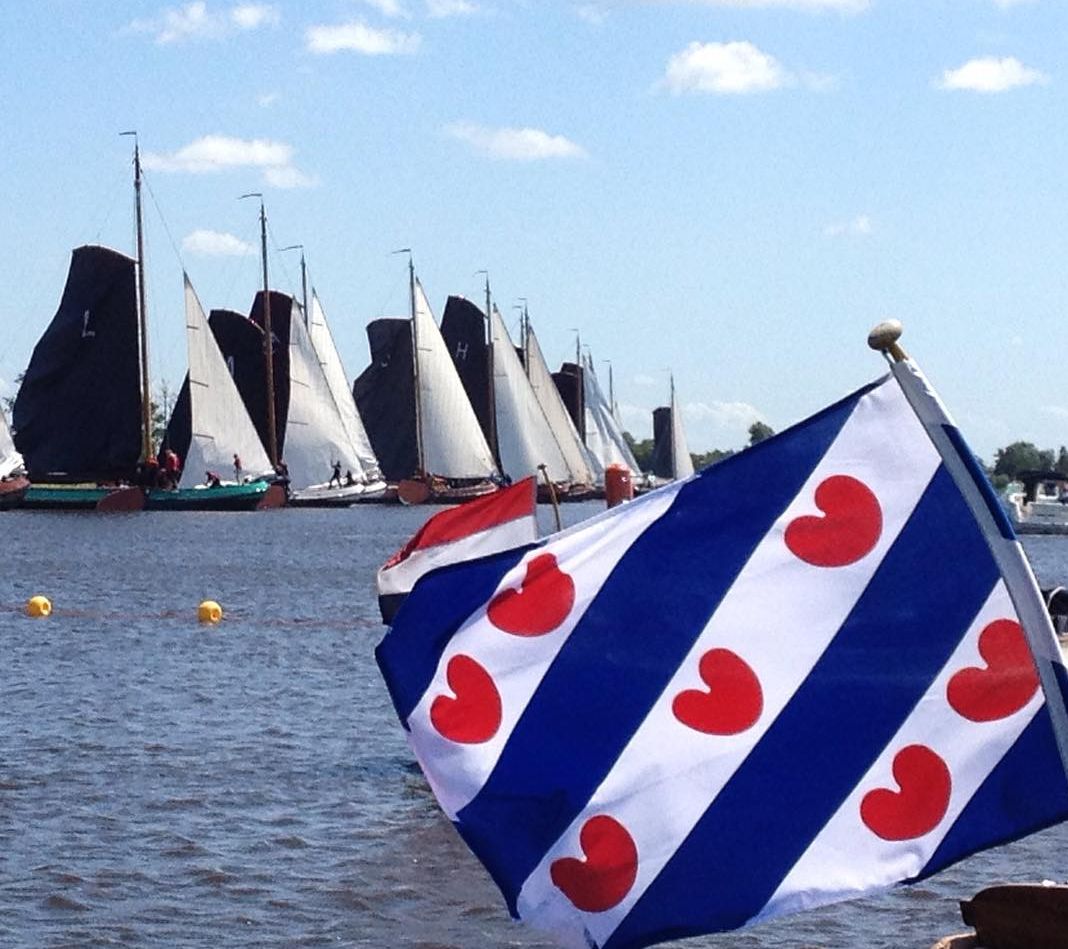
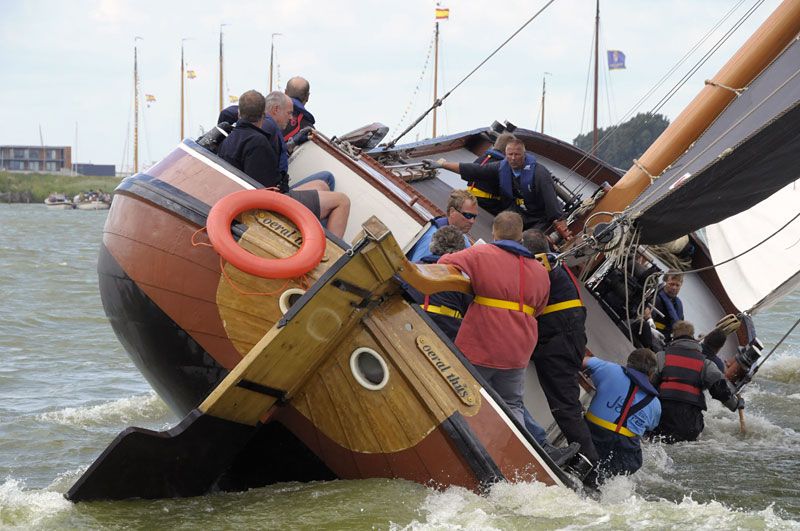
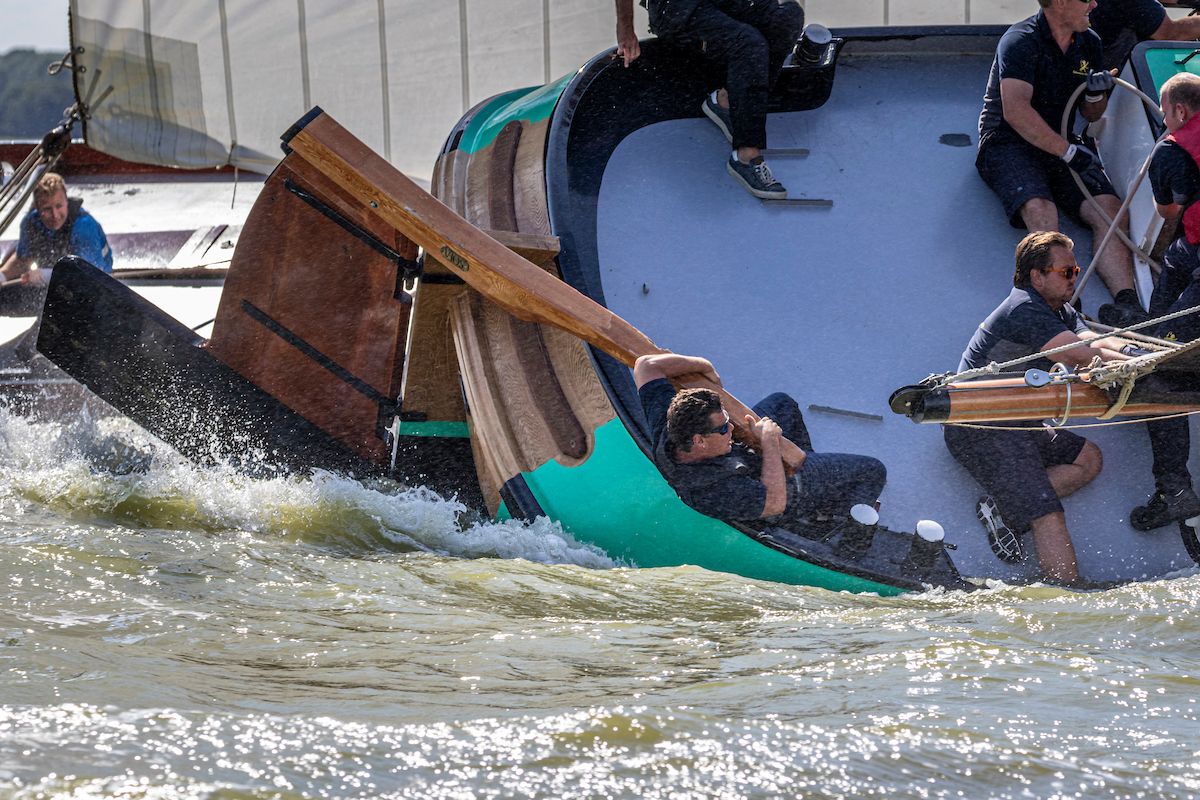
The 4 Friesian islands
The fufth Island 'Texel' belongs to another province. A brief look at the island.
Island 1 Vlieland
Below: Both pictures is Vlieland, the smallest island with only one village, in contrast with th neighbour island Terschelling, which has 8 villages. A storm surge in
1296 probably separated Eierland from Vlieland.Erosion further diminished the size of Vlieland from the west, leading in 1736 to the disappearance of a second village on Vlieland,
West-Vlieland (Westeijnde), after the inhabitants had tried for decades to rebuild the town following numerous floods.
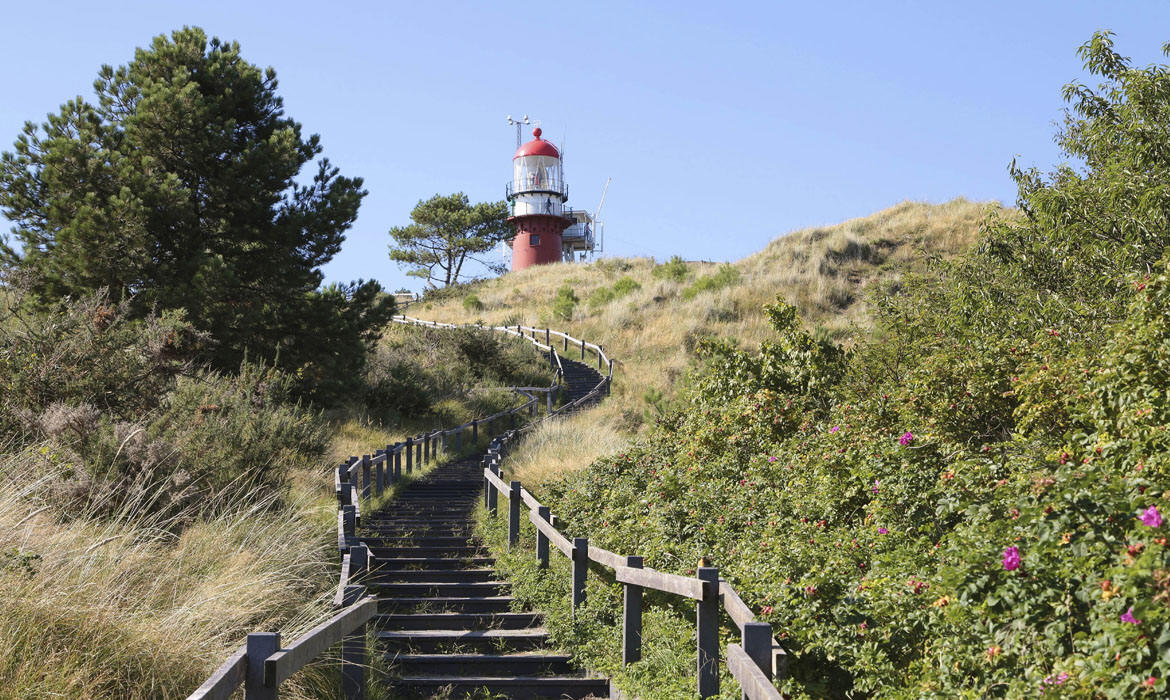
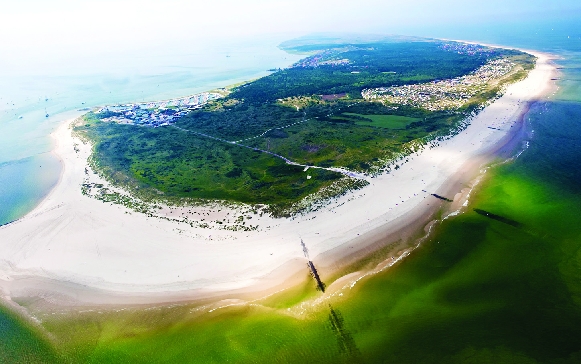
Island 2 Terschelling
It is special. The Netherlands does not have any mountains or rocks, but high dunes, no blue sea, or a clean sea, but due to the sandy soil we do not have real blue water like in France, Spain and Greece.
Yet this is considered to be THE island with everything. Conviviality, beautiful nature and many accompanying stories and 8 small villages with a history and own traditions. It is pure and real.
You can have the beach alone and look for the crowds.
Terschelling (West Frisian: Skylge; Terschelling dialect: Schylge) is a municipality and an island in the northern Netherlands, one of the West Frisian Islands. It is situated between the islands of Vlieland
and Ameland. Wadden Islanders are known for their resourcefulness in using anything and everything that washes ashore. With few trees to use for timber, most of the farms and barns are built with
masts recovered from shipwrecks. The islands are surrounded by shipwrecks, and even today many containers wash ashore that are blown off the decks of container ships in the North Sea.
The main source of income on Terschelling is tourism. There is some agriculture, but a large part of the island has become a nature reserve. Terschelling is well known for the yearly Oerol Festival
during which theatre performances are played throughout the island, making use of its landscape and nature. Terschelling can be reached by ferry from the mainland Frisian town Harlingen
and from Vlieland by high-speed catamaran.
The natural bay of the island, West Terschelling. One of the 8 villages.
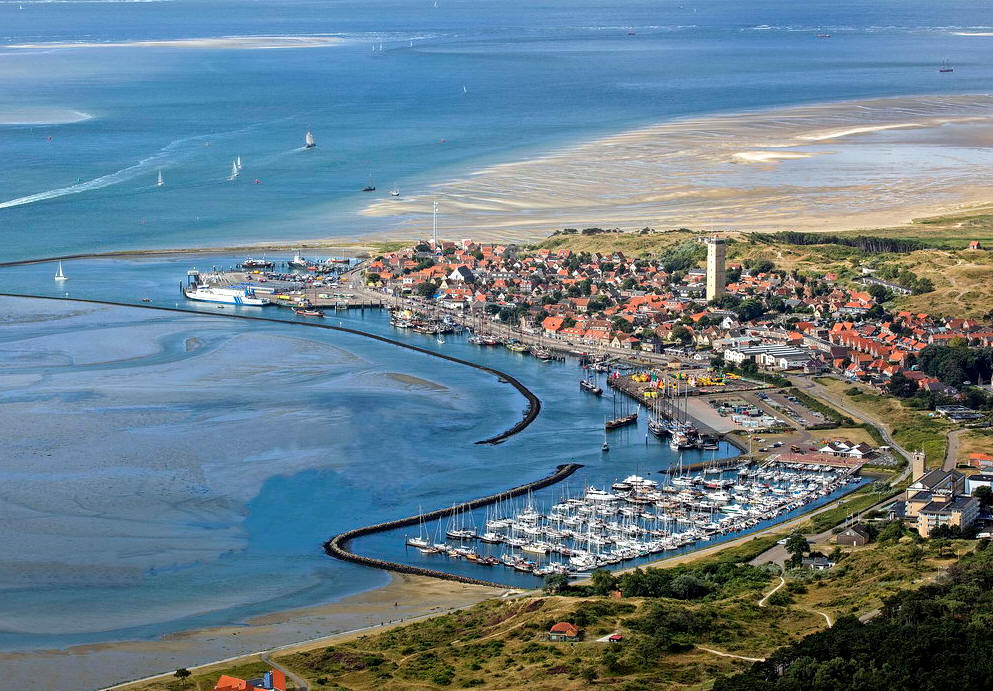
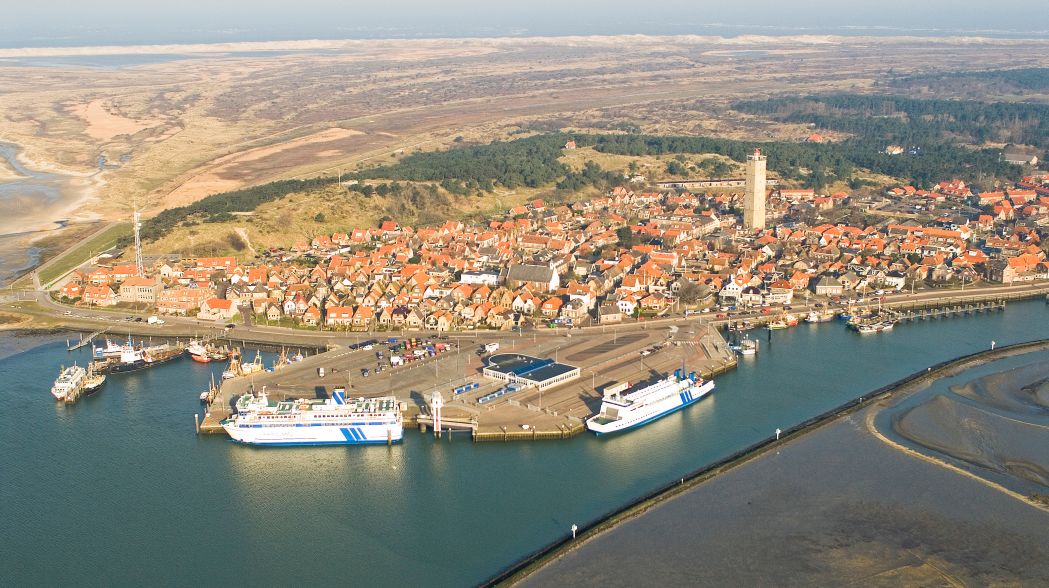
Broadcasted in the Netherlands as a TV-series, a magnificent drama. Documents a family history of an orphan found by a family living on one of the Dutch Islands (Terschelling) and
shows a wonderful cinematography as well as a captivating story. Romance, hardship, intrigue and gives a very realistic idea of what life was like at that time.

The Cranberry
The Cranberry is an exotic plant species in the Netherlands. Once discovered in the seventeenth century by the pilgrim Fathers. The Cranberry ended up on Terschelling by chance.
Indians lived in the northern states of the United States, who, as it turned out, already had much knowledge of cranberries. Already in the early centuries these Indians knew how to use the multiple functions
of cranberries very well. They also use the cranberry juice to treat meat wounds from wild animals and arrows. The settlers saw a future in this and a long history of the Cranberry begins here.
The cranberry berry is originally from the coastal region of North America. A man, in search of flotsom, once found a washed up barrel with sour berries. He was disappointed that there was no drink in the
barrel and threw the barrel into the dunes. the birds have spread the berries there. They have been part of Vlieland and Terschelling for a long time. They thrive here. Many products are made of it.
I love them. I make cake with cranberries and apple in it. It makes the somewhat sour taste of the Cranberry lifted somewhat and it tastes nice and fresh.
The cranberries, finding the environment favourable, established themselves on the island. Nowadays, the Cranberry fields cover 0.48 km2 (0.185 sq mi) or 48 ha (119 acres).
The cranberries are mainly sold to tourists and used by the island's restaurants and bakeries. For a huge map you can click here.
Island 3: Ameland
The municipality of Ameland had a population of 3,683 in 2017. The inhabitants are called Amelanders.
Like all West and East Frisian Islands, Ameland is a unique piece of nature. The profusion of different plants on the island is caused by the immense variety of landscapes. One of the scenic
areas is the Oerd, a large complex of dunes which is still expanding by the year. Because of the differing landscapes and types of flora, over 60 different species of birds are sitting there every year.
At the eastern part of the Oerd lies a beach plain called the Hon. Besides dunes and beaches, Ameland has some woods, like the Nesser bos ("Wood of Nes").
My grandma used to live here.
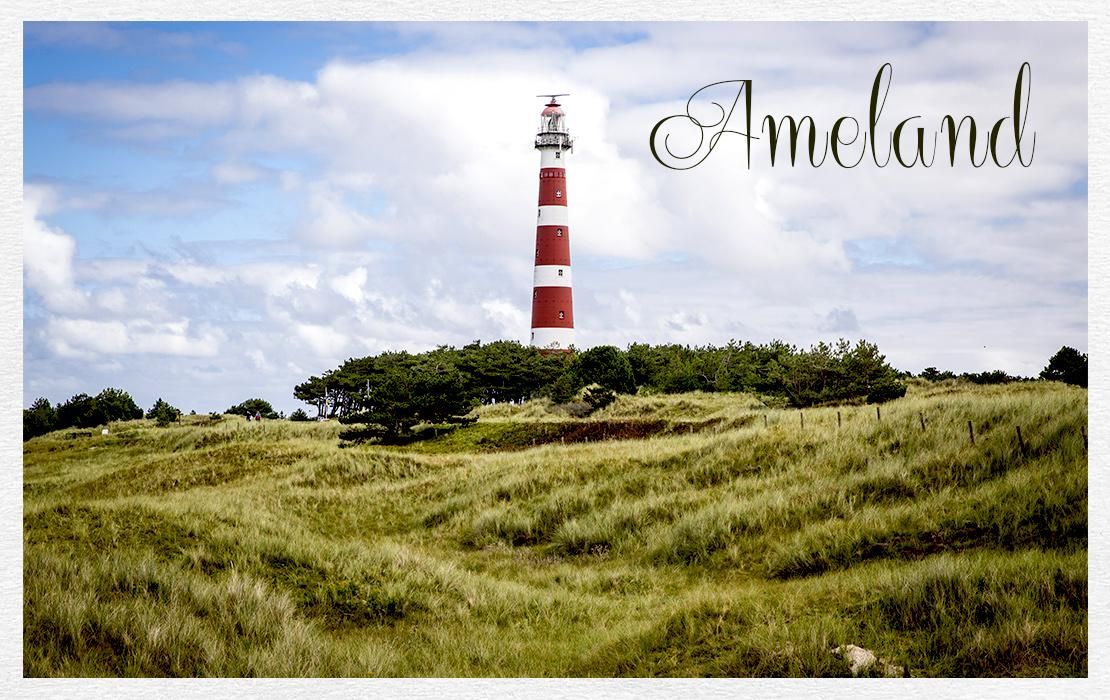
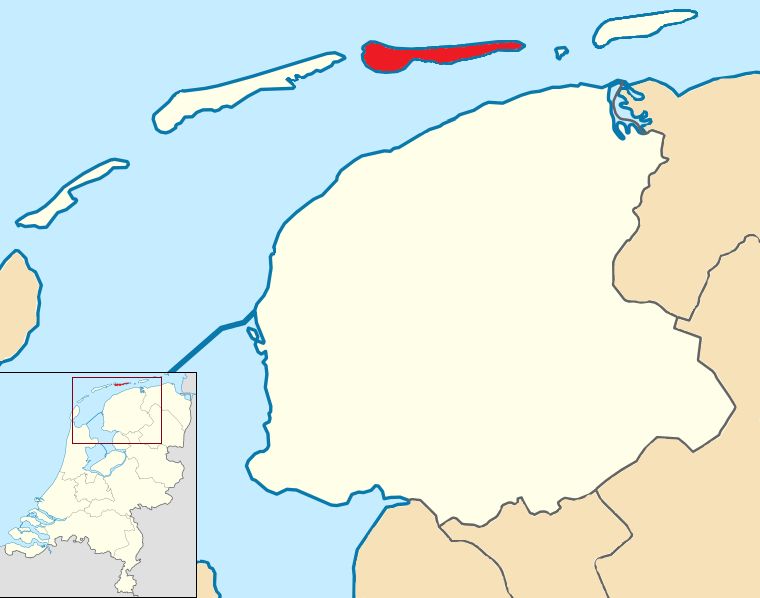
40 years ago, eight horses drowned on Ameland at the launch of the Hollumer lifeboat (Hollum is a small town on the west of Ameland). The drama received international attention because it was unique
at the time that a lifeboat was still launched with horses. The deployment of horses at KNRM is now a thing of the distant past, but still appeals to the imagination. The tradition is kept alive by the
Salvation Museum Abraham Fock on Ameland. On 14 August 1979, the Hollum lifeboat was alerted to the distressed German ship Windspiel 4. There was a stormy wind from the southwest and a
strong ebb current. The whale boss of the rescue station inspected the seabed and judged it was safe to launch the lifeboat at that location. However, due to a coincidence, things went wrong. After the
lifeboat was launched, the heavy boat wagon slipped into a deep trench and dragged the eight stuck horses along. The crew of the Windspiel could be saved by the lifeboat. Critics were disgraced
that the rescue system used horses in such dangerous situations. Nevertheless, the Rescue Society decided, after a thorough evaluation of the accident and partly at the insistence of Amelander
drivers, to continue working with horses. That remained so until 1988, when a new fast lifeboat was stationed in the Ballumer curve. Since then, the use of horses for rescue work is a thing of the past.
A grave was dug in the dunes for the drowned horses. A wreath is laid at the memorial stone on 14 August. A tribute to the loyal animals, who were eager to send the lifeboat into the sea with every
alert and had no fear of seawater. The Ameland horse rescue boat still exists. The Ameland Horse-Riding Boat Foundation launches the former lifeboat about ten times a year for demonstrations.
Below the farmer who provided their 1 or 2 horses per man to rescue people. They are standing next to the horse grave.
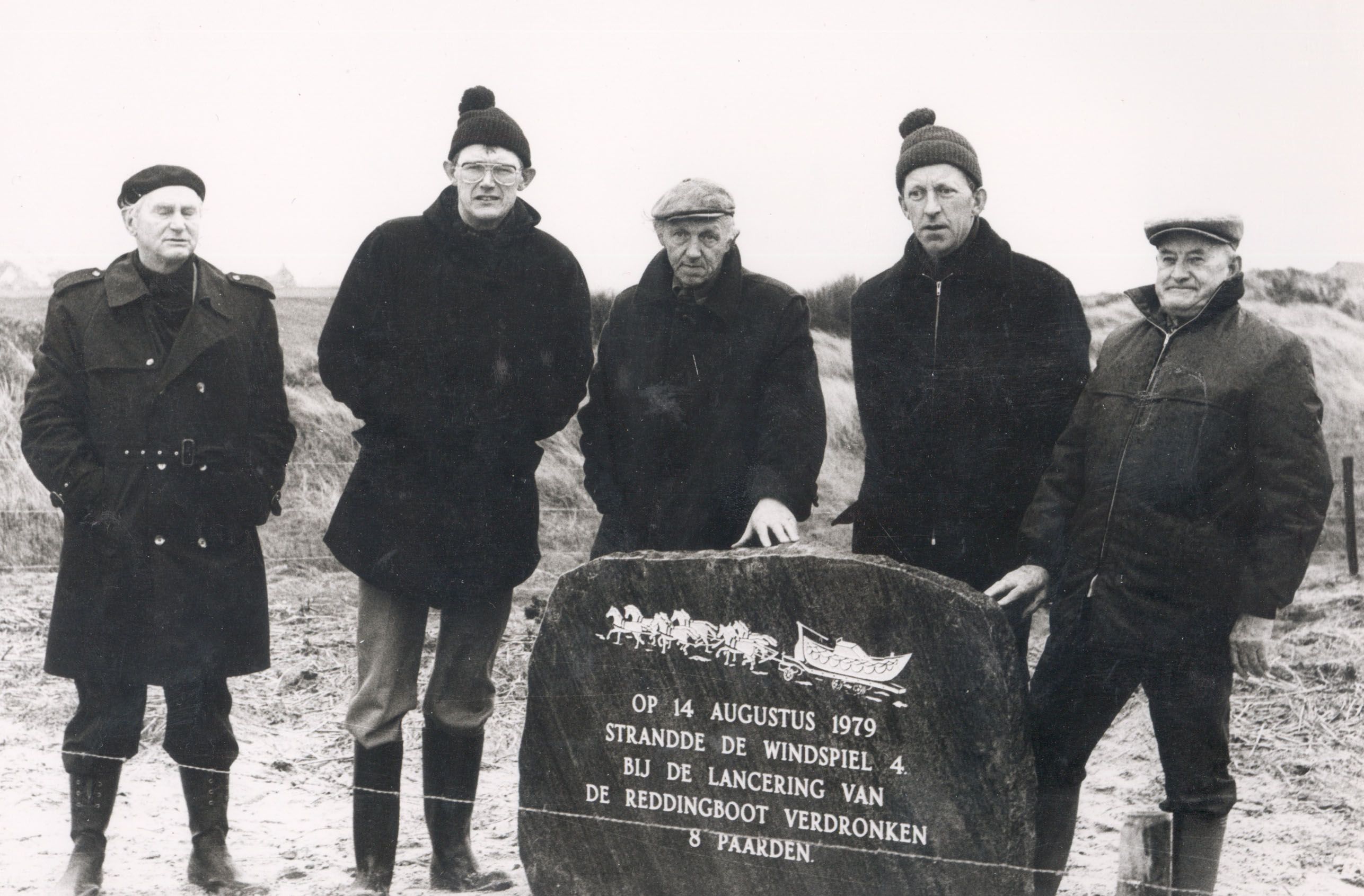
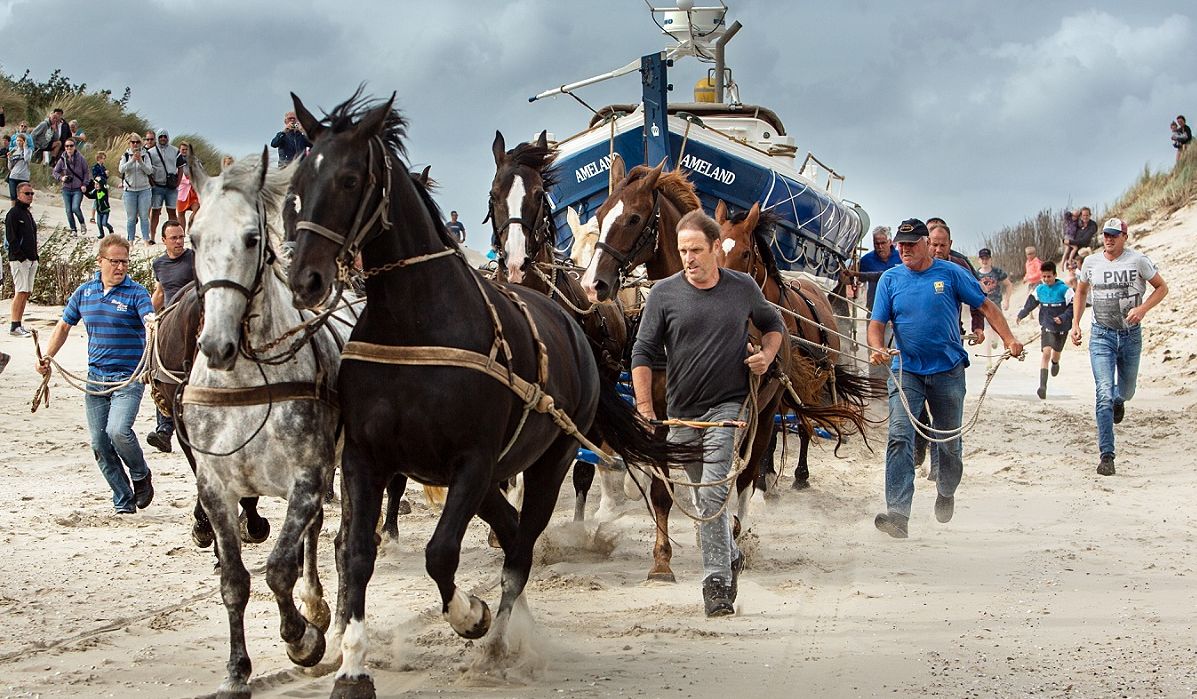
Penny's Shadow is shot on Ameland, this movie is made for Dutch horsegirls. Click here for the trailer from 2011. Movie is made by Steven de Jong
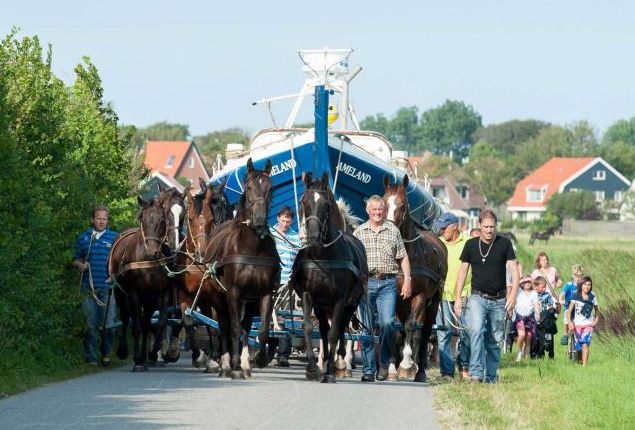
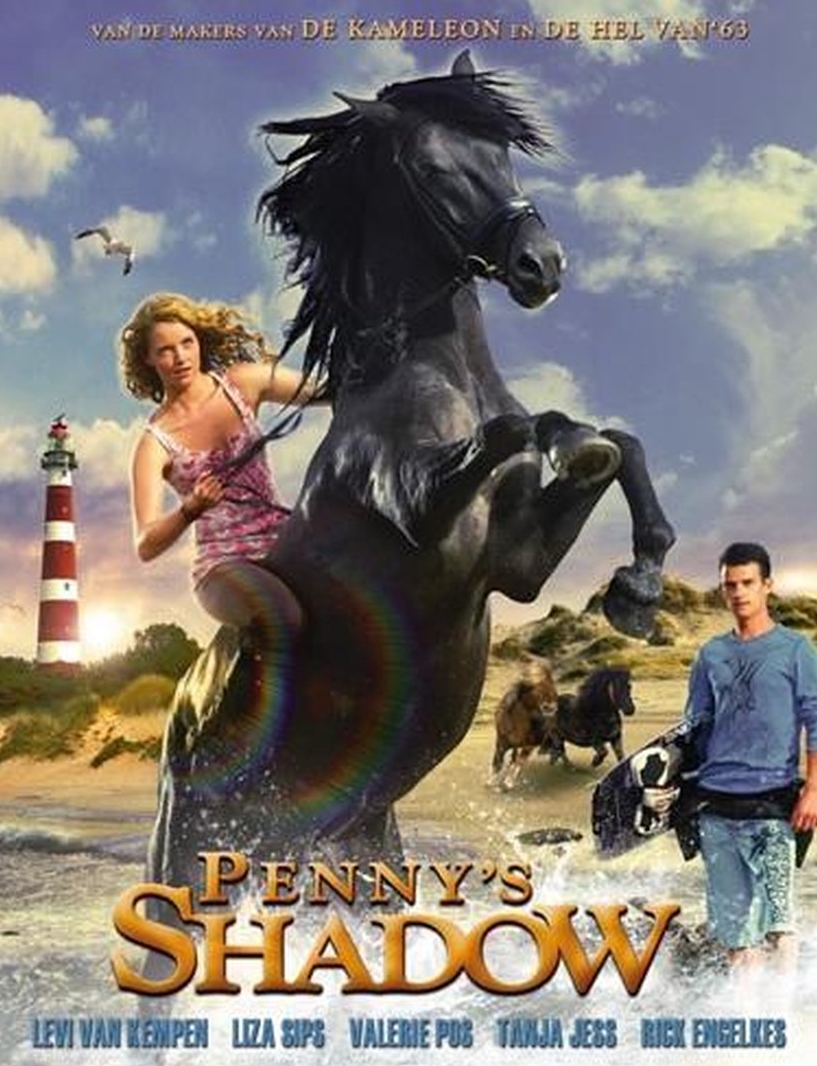
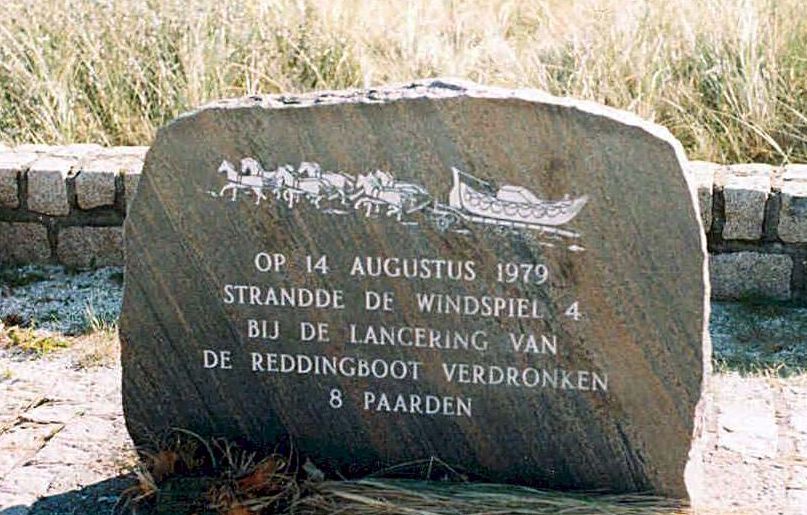
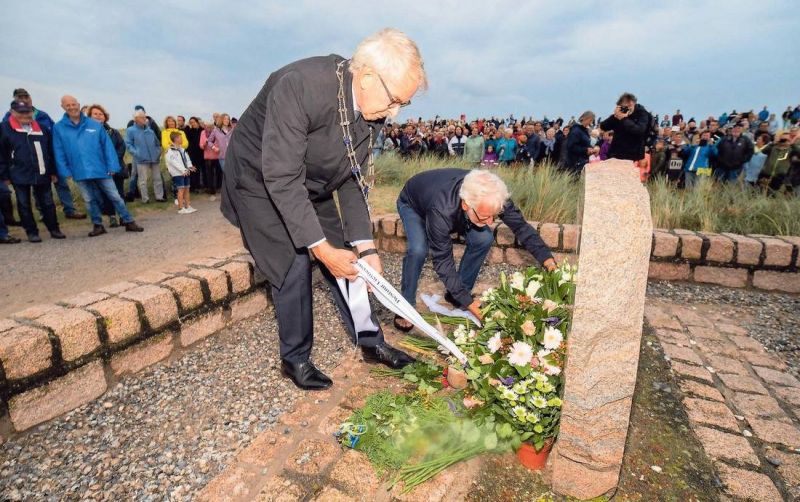
These farmers of Ameland gave their horses and labored day and night to save people at sea, losing their brave horses before their very eyes because the cart pulled the horses into the sea
For the English people who are interested, a short impression of old film but it's sproken in Dutch, you can click here (dutch and Belgium people the story from the farmers who lost their horses that evening).
For the old movie parts you van click here With a local song about the boat. Now they made sure this never ginnan happen again! For better quality film you can click here
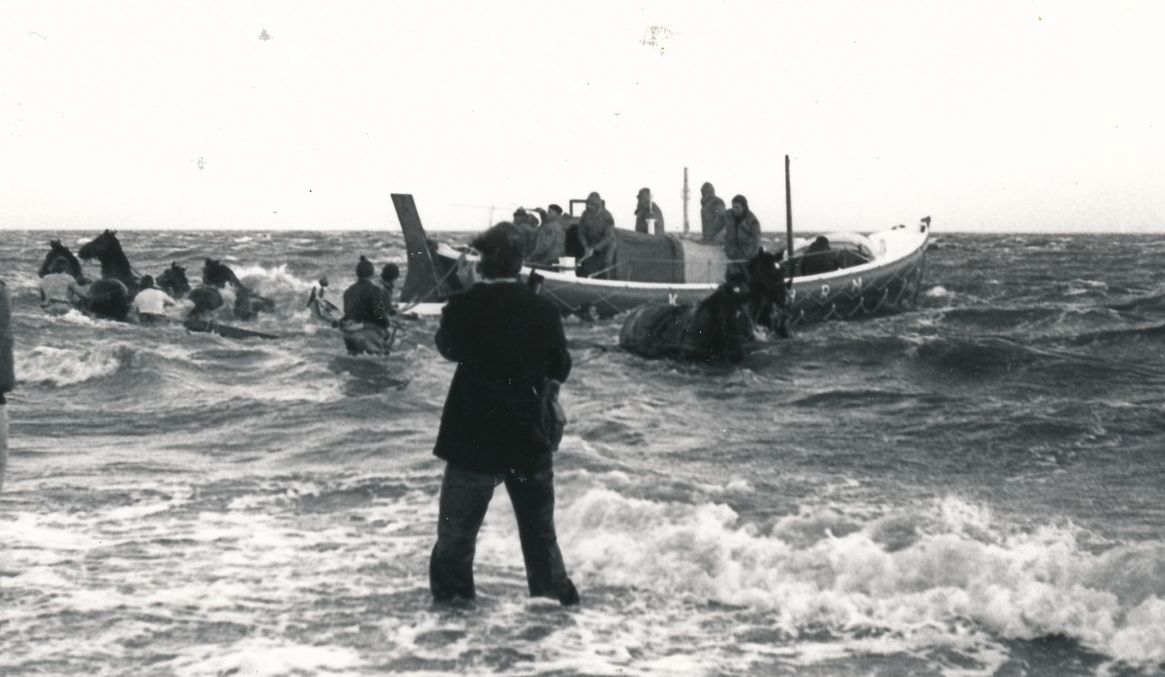
Island 4: Schiermonnikoog
Thanks to the tidal current, the prevailing winds, and North Sea storms, the island is slowly moving to the south and the east. In the year 1250, it lay roughly 2 km to the north
of its present position, and it then had a significantly different shape.
The earliest mention of Schiermonnikoog in writing dates from October 1440, in a document written for Philip the Good. The island's first known owners were the monks of Klaarkamp Abbey,
a Cistercian monastery near Rinsumageest, on the mainland. "Monnik" means "monk", "schier" is an archaic word meaning "grey", referring to the colour of the monks' habits, and "oog"
translates as "island". The name Schiermonnikoog can therefore be translated as Grey Monk Island.
During the Reformation, the monasteries in the northern Netherlands were dissolved. In 1580, Schiermonnikoog became the property of the States of Friesland. Around 1640,
the States sold the island to the wealthy Stachouwer family, and for the next three centuries, Schiermonnikoog remained private property.
Around 1700, the population of Schiermonnikoog was divided among four villages or settlements. The largest of these was Westerburen, which had developed around the medieval buildings
of the grey monks. In 1717 and 1720, storms flooded Westerburen, which had to be abandoned around 1725, because of drifting sand and the advancing sea. In 1756 a new town, named
Oosterburen, was built to the east. Nowadays this second village is named Schiermonnikoog, after the island. Also in the 18th century the people of the island rebelled against Lady Catharina
Maria Stachouwer, and the States of Friesland sent troops to protect her and to restore law and order. Source and more about the history: https://en.wikipedia.org/wiki/Schiermonnikoog
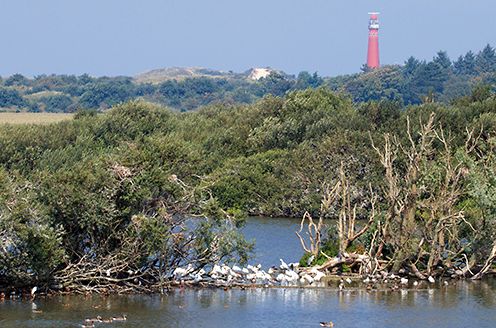
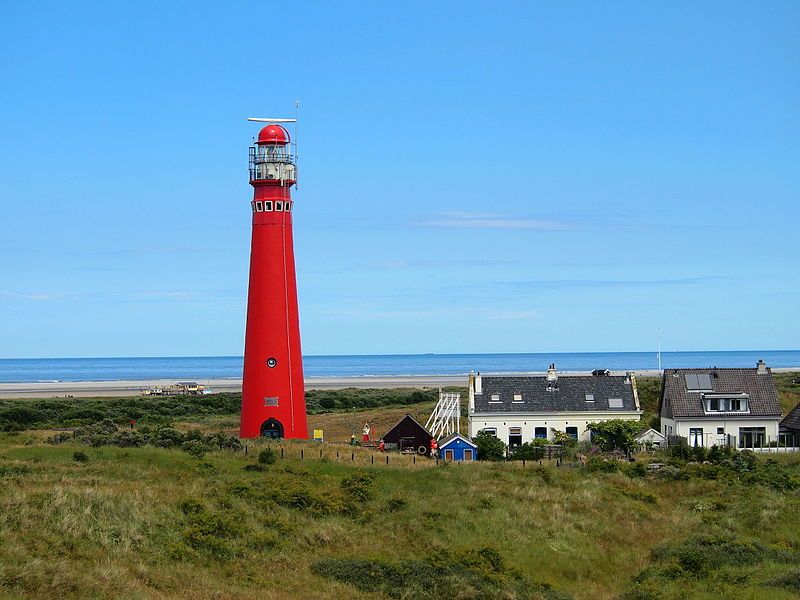
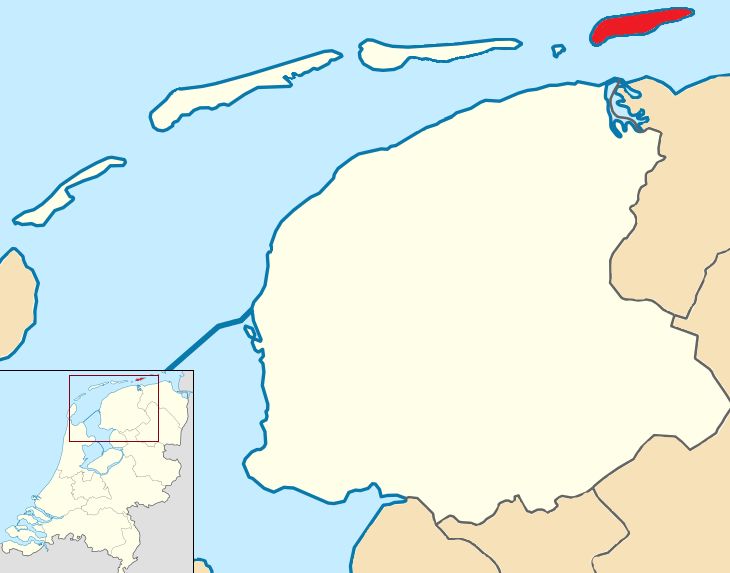
The current threats affecting Friesland
So I made short impression to show that I Care about my environment.
Ecomonical interests. Our government is a major shareholder
The Wadden sea is world heritage. The Netherlands does not handle it with such care. Economic interests are unfortunately too important under the Rutte cabinet. As a result, the province
has become an earthquake area alongside Groningen, where there are intensive drilling for natural gas. In some parts, people live in fear, cracks in their houses, etc. The Wadden Sea also drops.
natural subsidence is also a cause, but gas and salt may still be used. There is also a waste incinerator placed next to the Wadden Sea in Harlingen which causes serious nuisance for the
Wadden Sea and the surrounding area, there is a lot of agriculture in the area that absorbs these substances. It is a shame that these areas do not remain better protected because the
Netherlands does not have much room for nature and is very densely populated.
Although I am in favor of green energy, I remain critical. I also hate windmills. The project in the year 2019 is a large part of the IJsselmeer, adjacent to Frisian land, complete with it.
There are alternatives. it is horizon pollution and raw materials and transport from these mills are also not clean ...
Places where and around gas drilling. Drilling locations in a vulnerable and low area, which can easily cause subsidence and tremors.
Source photo: NAM
Drillinglocation in Natura 2000 Wadden area Earthquakes
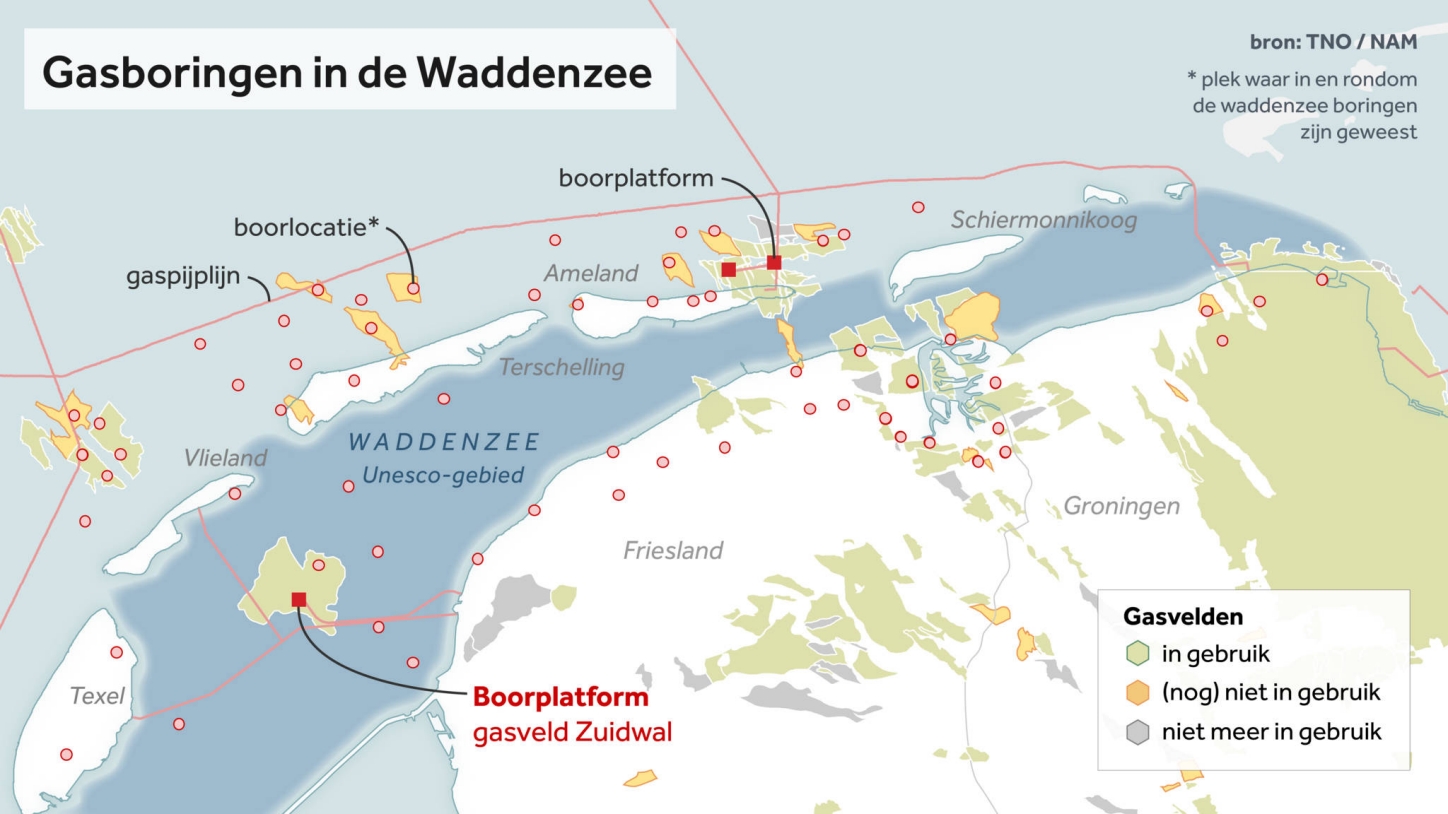
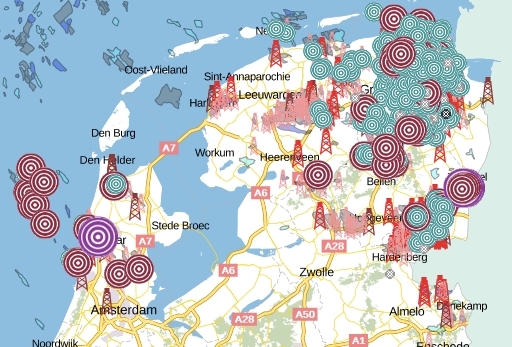
Gas extraction by Vermilion in the north of the Netherlands. In green concession areas, in red drilling locations. After the NAM in the Netherlands, Vermilion is the largest gas extractor on the mainland.
The Canadian drilling company has recently also been active on the Wadden Sea, via the Zuidwal drilling platform between Vlieland and Harlingen. In Northwest Friesland, gas extraction from
Vermilion locally overlaps with salt extraction by Frisia Zout, resulting in extra complex subsidence.
Earthquakes due to gas extraction in the Northern Netherlands (the larger the circle, the heavier the quake). The officially valid figure for maximum earthquake force in the "small fields" is (for years)
3.9 on the Richter Scale - that is heavier than the heaviest earthquake in practice in Groningen. The figure comes from statistical analysis of all Dutch gas fields, carried out by the KNMI. In 2016,
TNO re-examined this risk on behalf of the then Minister Kamp, and concluded that this force of 3.9 on the Richter Scale is only possible in "some small fields".
Friesland still seems pretty safe but houses have become uninhabitable and the damage is difficult to recover. The government just shuts the gas tap slightly and the residents do not
feel helped. They have unsaleable houses and houses with cracks that have been declared uninhabitable.
But companies want to drill and try again and again. Salt extraction is also continuing considerably. but the neighboring province of Friesland has serious problems. see here next to all the
circles that are the many shocks that have caused serious damage to the many houses in Groningen
Windturbines
Let's get straight I am no activist but I care about my environment and people who can enjoy it and handle it well, also for the quality of life and future of our children.
Not for the quick money and endless economic growth, an economy in which we can no longer even raise our own children and make time for free
A zoomed map of the enclosedam. This nightmare started at the beginning of this year 2021. Running on a subsidy that does not help the environment and nature.
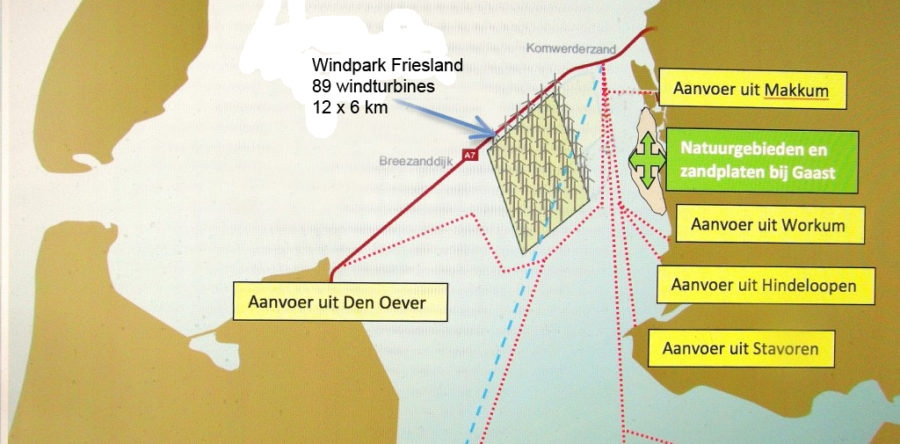
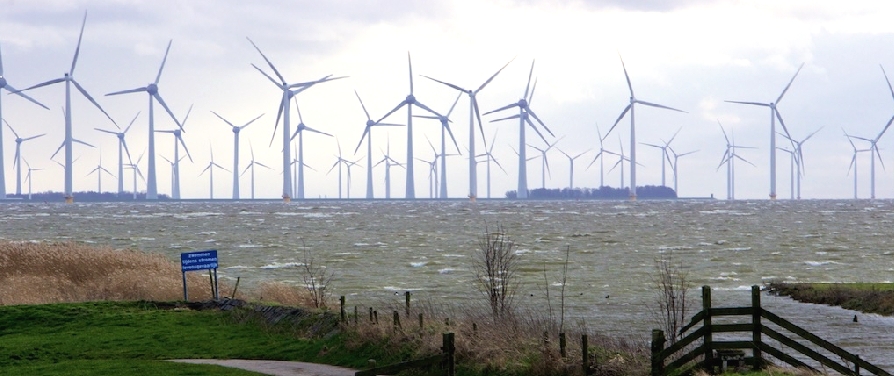
Yes is care about the environement and yes I like to think green but there are other ways. It is said that we are living in a democracy, but that seems no longer the case.
Who likes this? Holland is already overgrowded, real nature is scarce and people need it.
Producing, transporting, building a big windmill (and the relatively short lifespan) make these ugly things almost unprofitable. I am thinking more about tide electricity and
combined fresh and salt water power generation, solar panels (no black solar fields but compulsory on the roofs of companies.
After the threats above, below more positive information. About the big festival 'Oerol.'
Oerol festival
Terschellings Oerol festival has become to be known as one of the most exceptional landscape arts festivals in Europe. From its roots as a small festival in 1982, Oerol has grown
to become a true phenomenon. Often international theater groups. French people who put up a nice street theater for example are no exception that makes it diverse.
Every June, the island of Terschelling in the Wadden Sea is transformed for ten days into a unique natural stage for theatre, dance, art installations and music. More recent projects display a
combination of arts, science and nature. These projects are becoming more and more important, shaping new aspirations of the festival. With a huge audience participating as fieldworkers in laboratory
projects the festival becomes a fun but serious living lab. At Oerol new perspectives on society, nature and culture can be explored, by addressing how people move and behave within their surroundings.
The shows and lab-projects where mankind and nature meet one another are created for the specific locations in which they take place. From a theatre spectacle to acrobatics and interactive installations:
you will find all of this and more in the dunes, on the beaches, in the woods, on the dikes, in sheds or barns and simply in the streets of Terschelling.
When is Oerol?
Oerol 2019 – 14 t/m 23 juni Oerol 2020 – 12 t/m 21 juni Oerol 2021 – 11 t/m 20 juni Oerol 2022 – 10 t/m 19 juni
With 130.000 tickets sold each year Oerol is a big 10 day festival and year round research lab for landscape arts that bridges the gap between emerging artists, renowned scientists, nature
conservationists and a large general audience. Also hundreds of (inter)national programmers scout new work here. Besides this significant contribution to promoting mobility, Oerol also creates a
temporary society in which artists and audience meet for several consecutive days over which relationships deepen. With 75% of revenues coming from non-governmental bodies Oerol is
an ambitious cultural entrepreneur. We are delighted to be your guide to the next edition of the Oerol festival. Born from the fascination and passion of one man – founder Joop Mulder –
since then host to tens of thousands. It is a great privilege to be able to share this fascination with so many others. Each year, the energy the festival generates attracts hundreds of artists to the island,
and thanks to the endless curiosity of all the visitors, they feel the freedom to create new works, to experiment, investigate and present these.
Unfortuntely Joop Mulder died Januar 2021. We hope Oerol can stay the same.
Concert and theater in a real bubble.
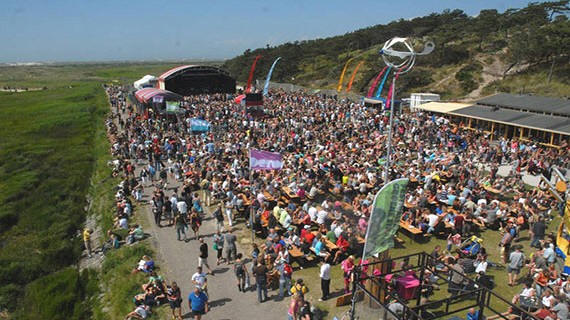
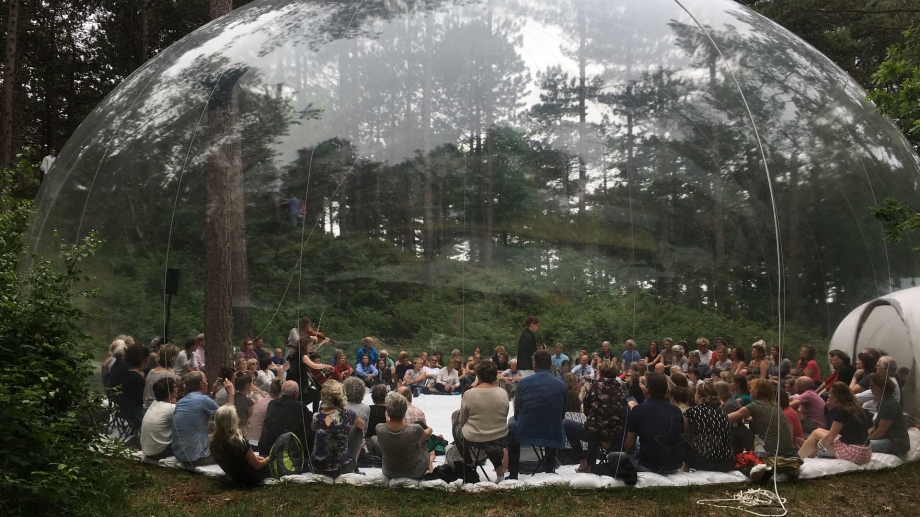
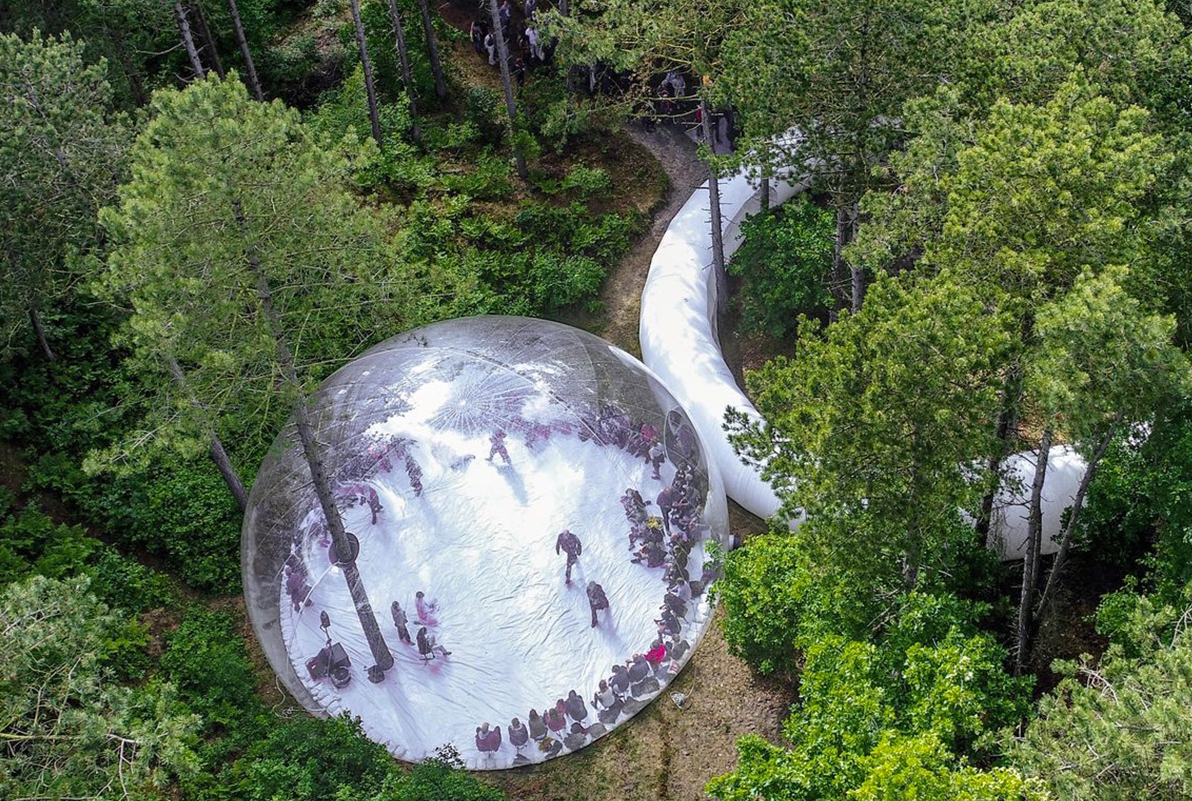
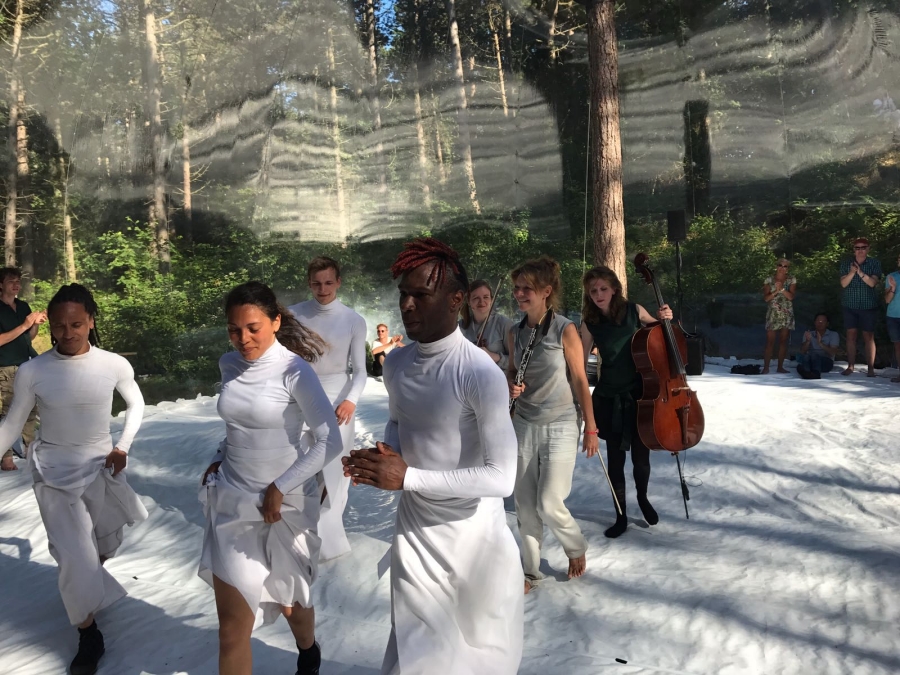
The same place. This is what you see when you are up in this tower. Mirrors show the whole environment and yourself in it.
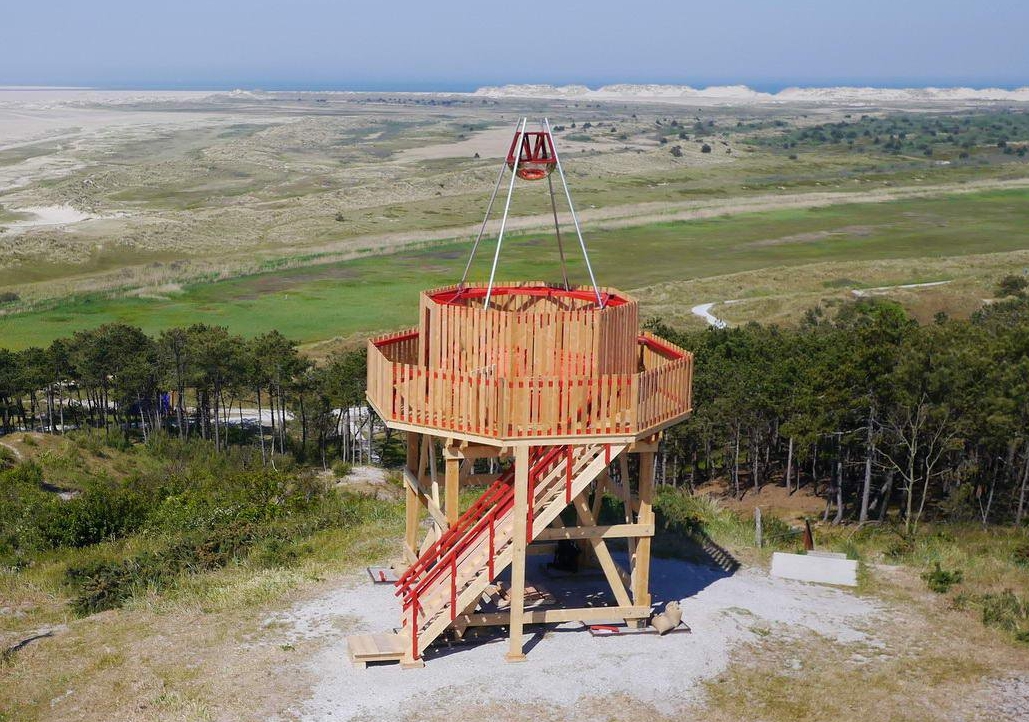
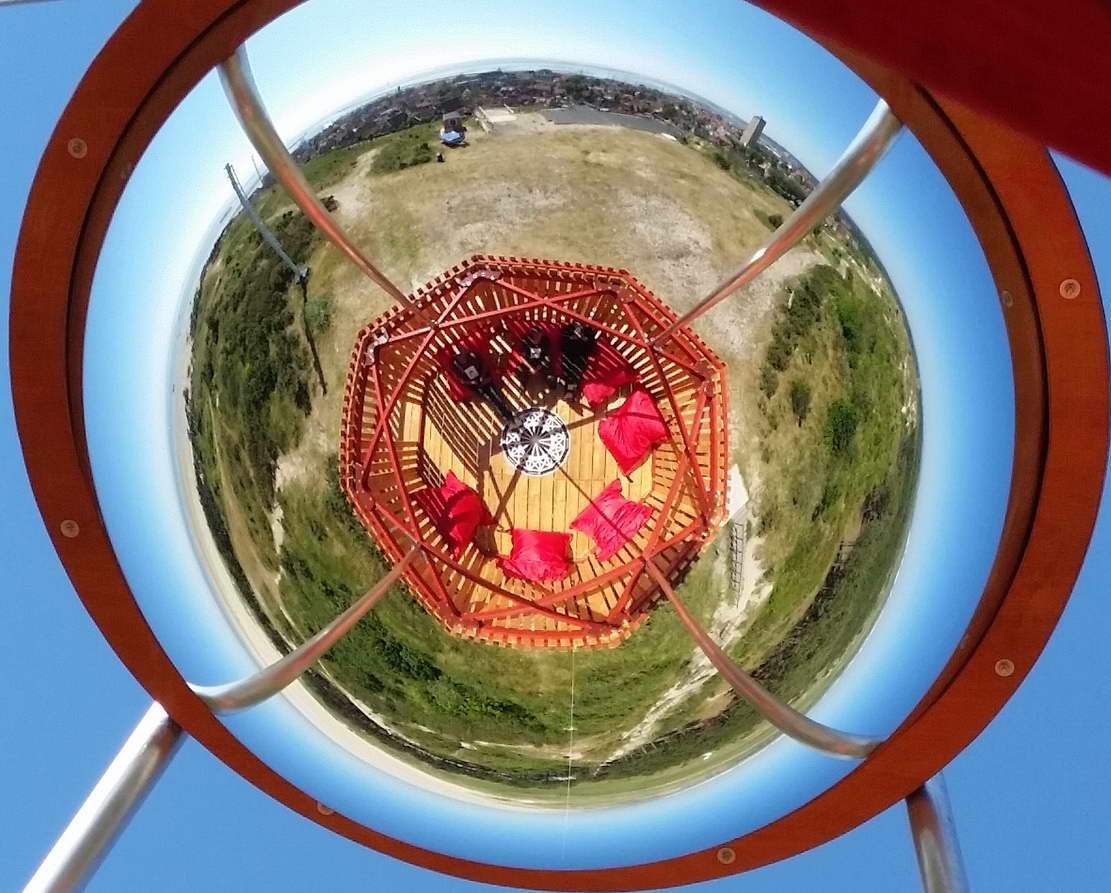
Change during tide
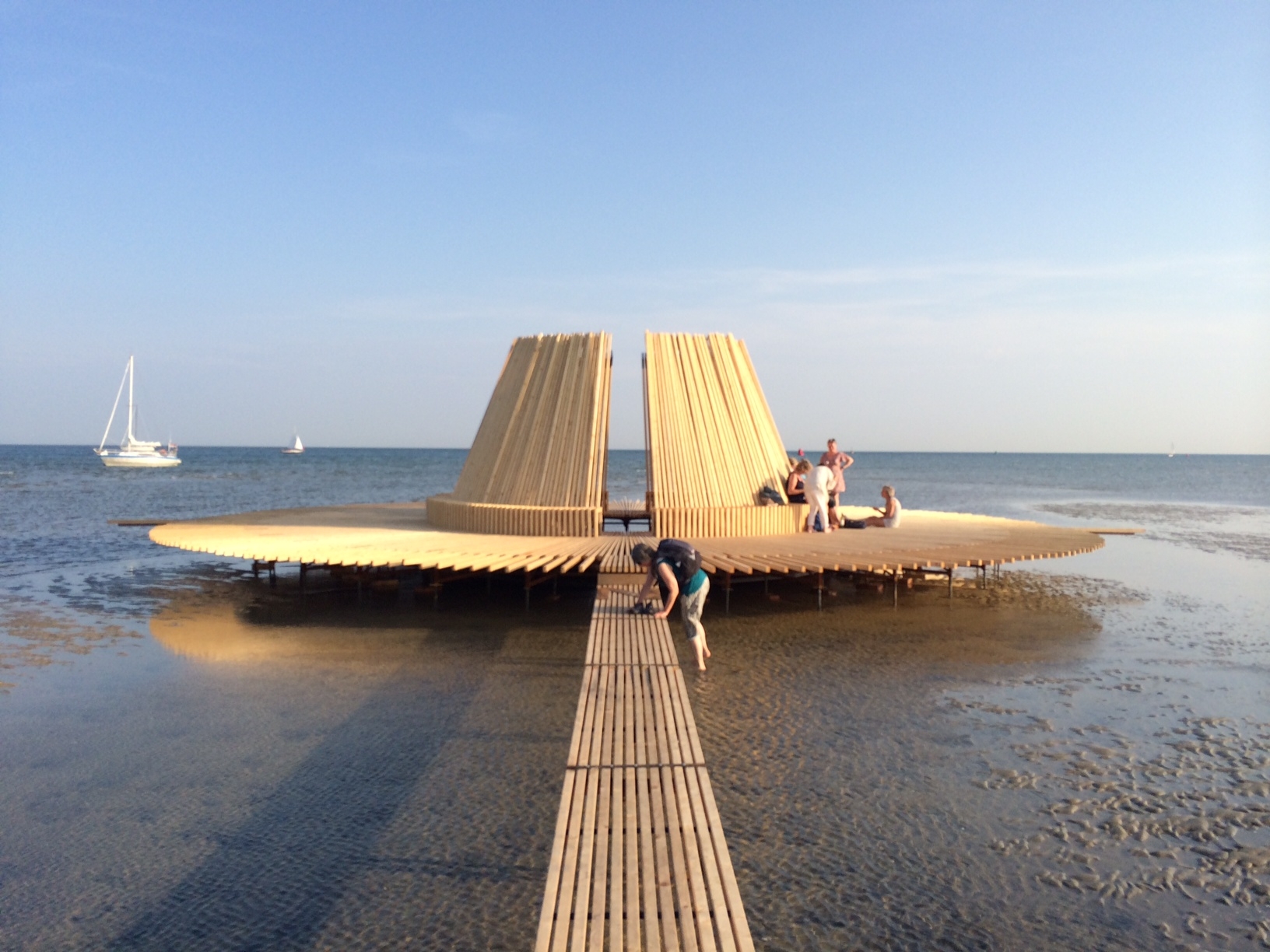
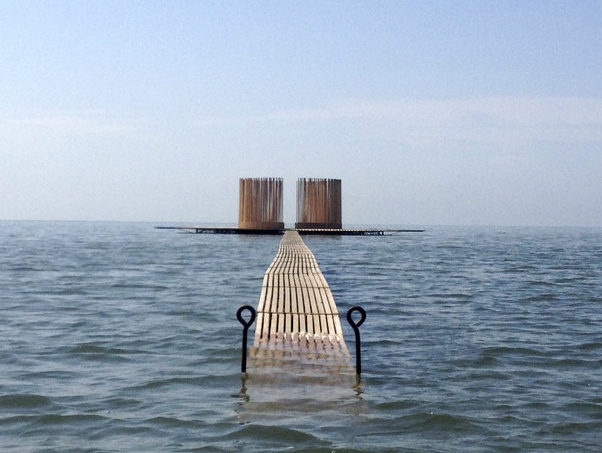
You can expect something, somewhere on the island. (Amphi)theater or art with a message.
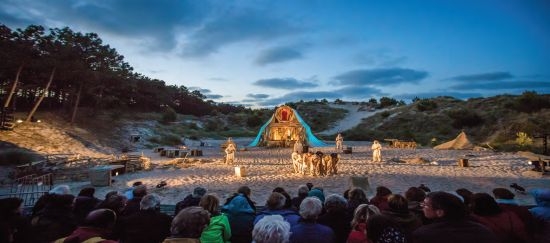
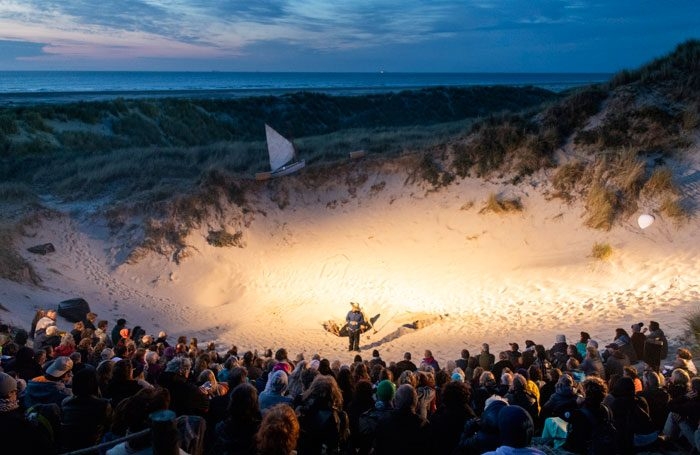
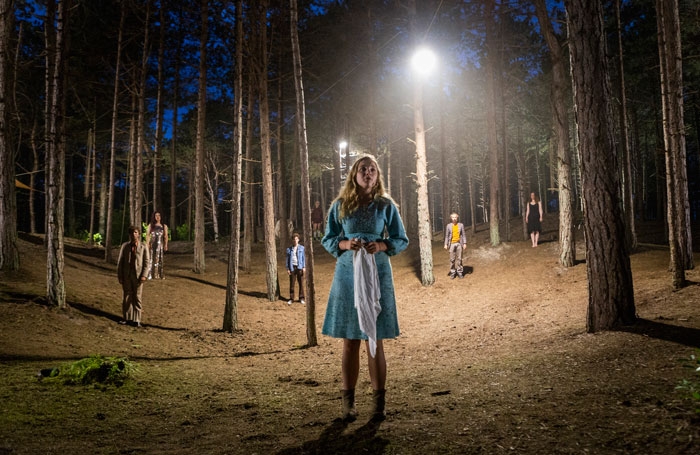
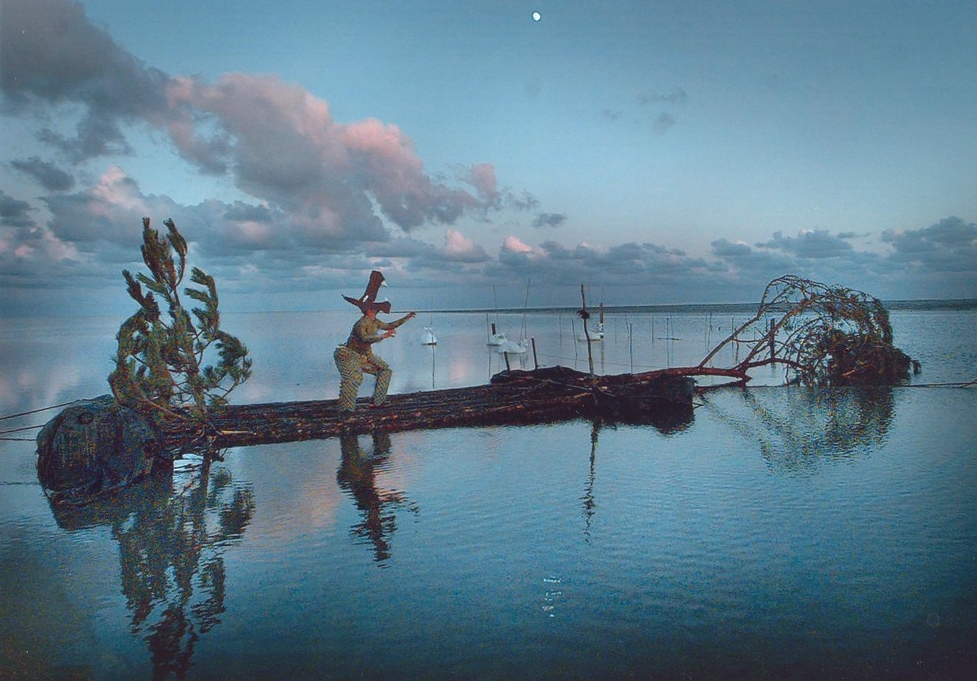
Find your bike...these bikes looking like an art project as well.
Katie Melua once sung 'there are nine million bicycles in Beijing' Not only in Beijing...perhaps more in our small country Holland
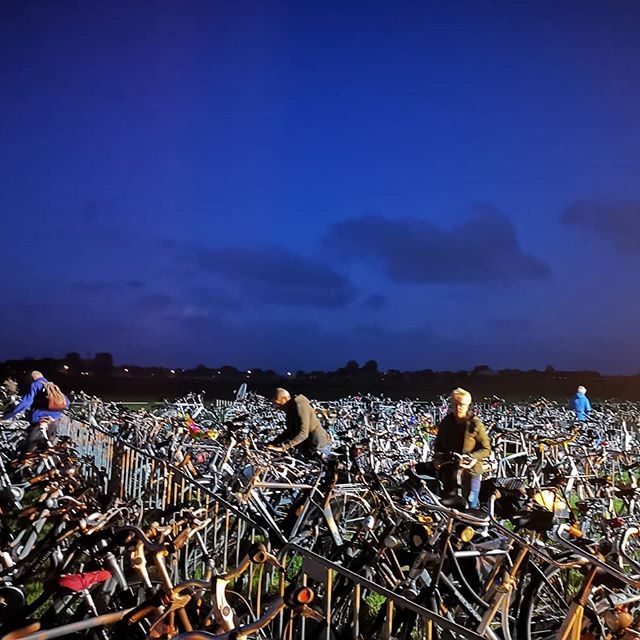
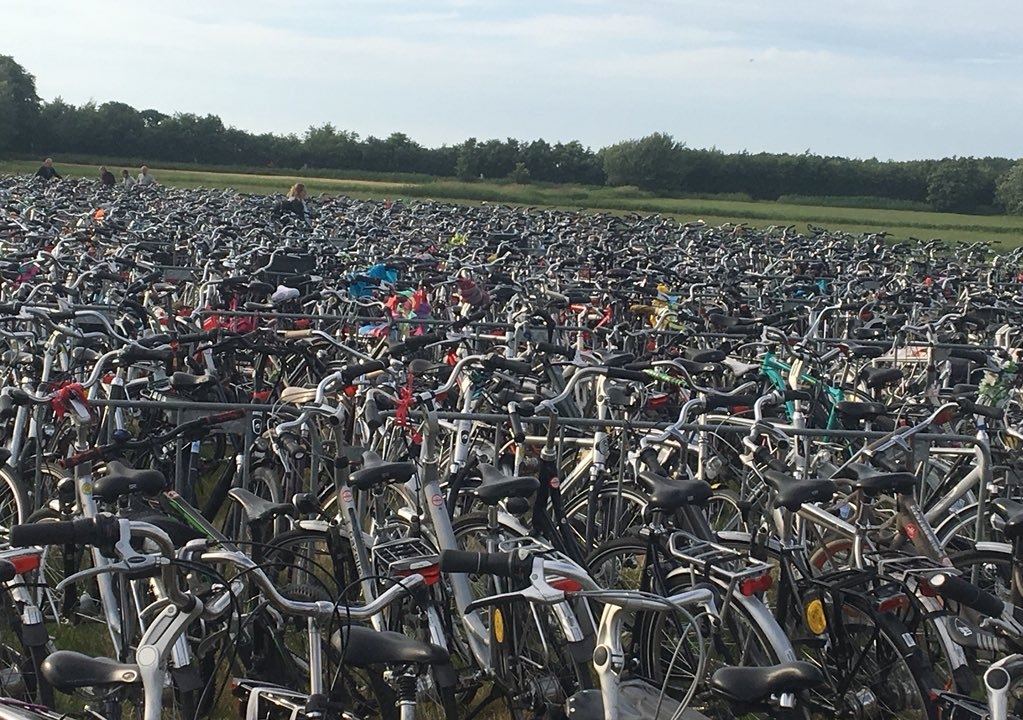
Roof tiles field Huge sanddunes in circles
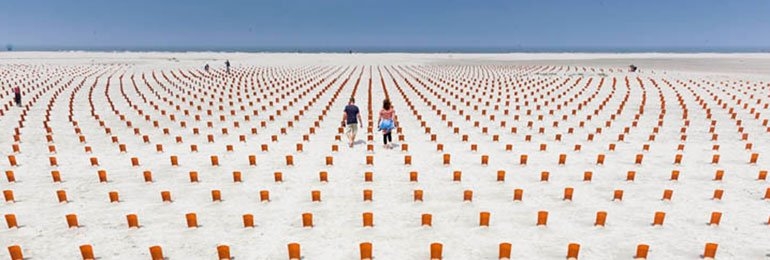
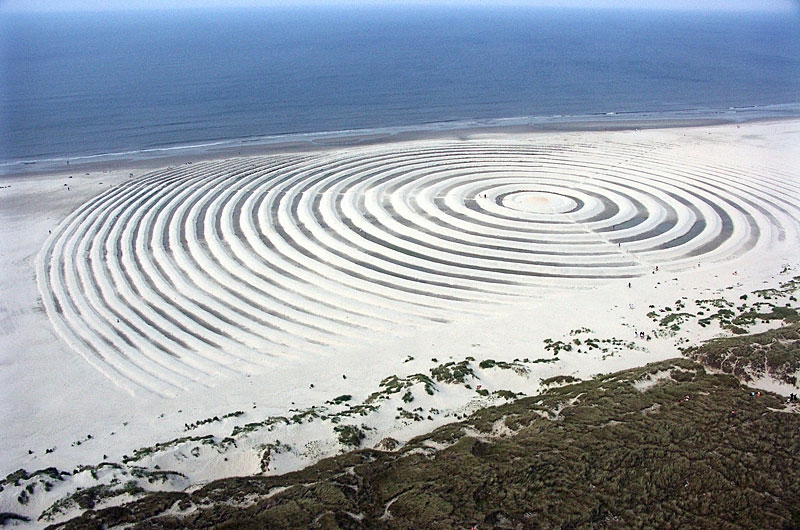
Look at this! The 'Wind Wagon' has arrived....
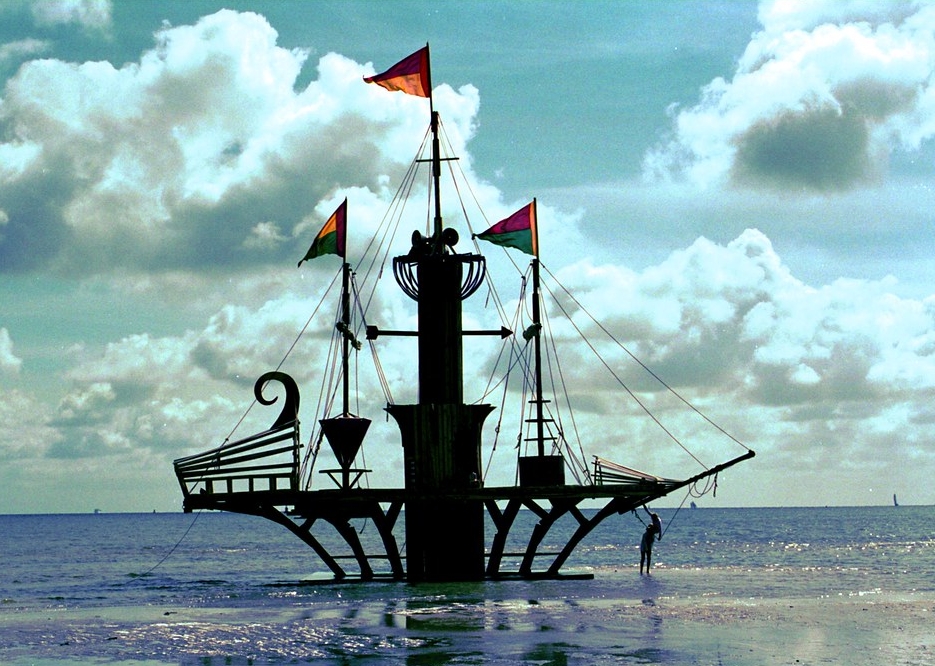
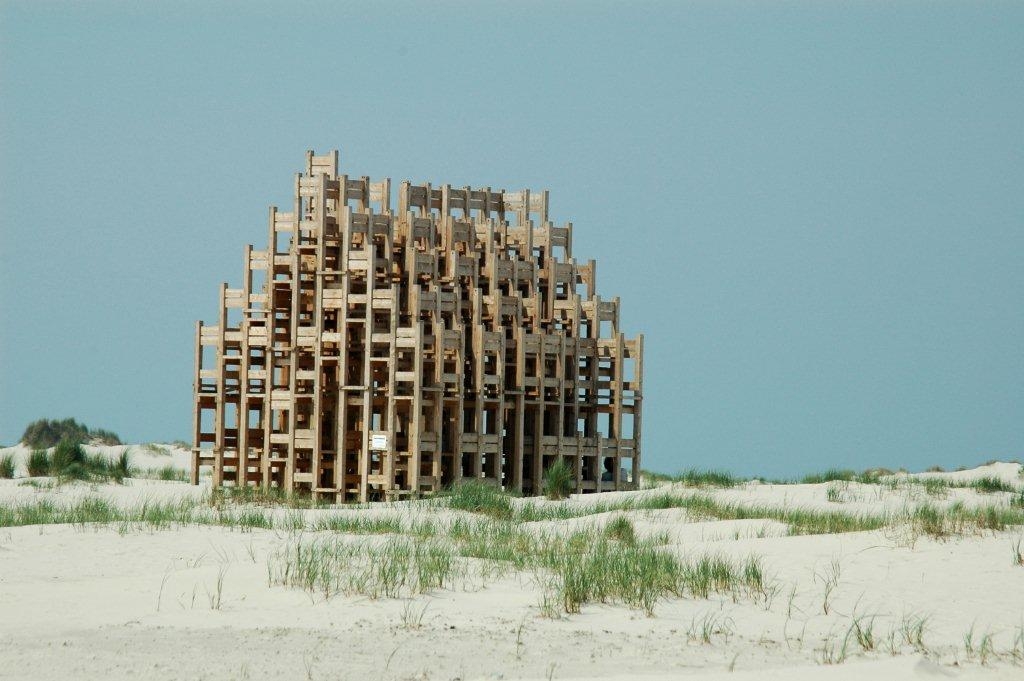
A group of TU Delft master's students will leave for Terschelling on Monday. They will install their installation
'Gap the Border' at the Oerol Festival (from 14 to 25 June). Editorial Delft 06-06-18, 16:04
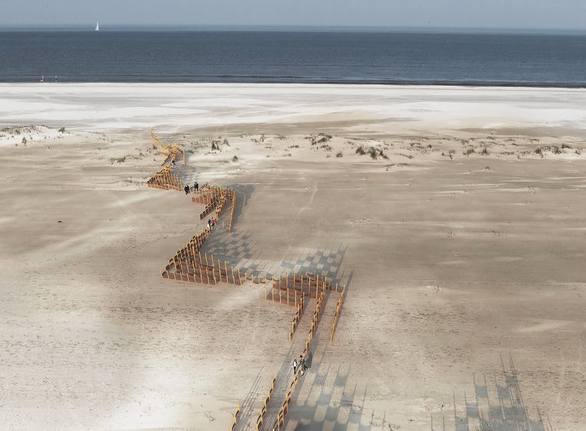
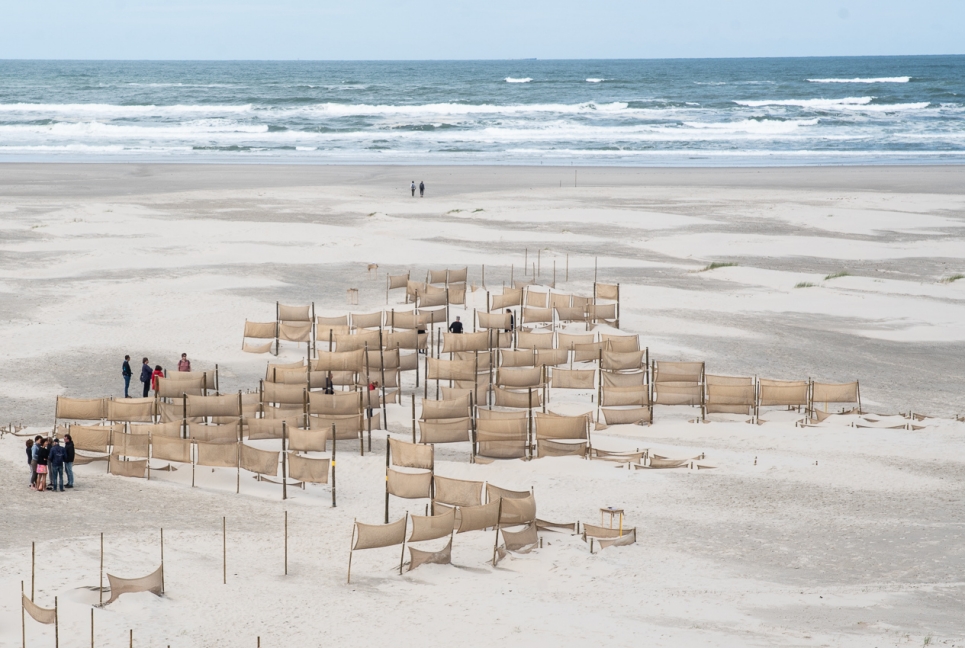
The project is part of a research program on the defense of the Dutch coast. The students take along 349 wooden posts of different lengths in vans, with which they construct an
installation on the beach based on the principle of building with nature; by placing the piles in a certain figure, dunes are created quickly.
Architecture student Jorren Verheesen explains: ,, We use the Oerol Festival as a platform to experiment and to make the concept of this method of coastal defense understandable
for the spectators and to link it to culture and art. We want to make the public aware of the influence of human interventions at the Oerol Festival. "
The construction of a kind of 'fencing' of the piles makes it clear how rapid dune formation is possible. Verheesen: ,, In fact, this refers to a very old technique, in which nature is simulated.
Just as mar ram grass promotes the formation of dunes, the formation of dunes can also be controlled by placing a formation of piles in a certain way. We want to breathe new life into this technique.
With our presentation at Oerol, we hope to reinvigorate the discussion on this. "
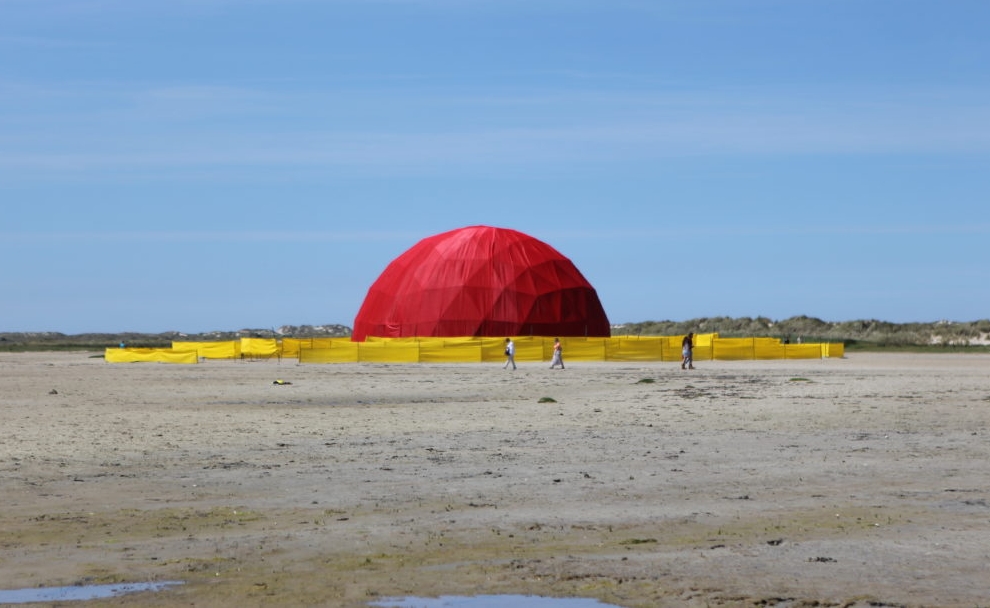
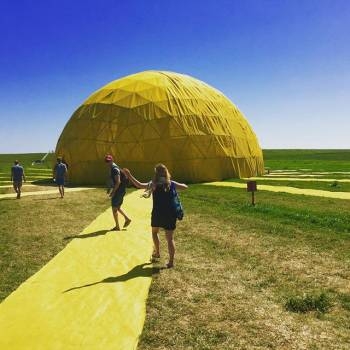
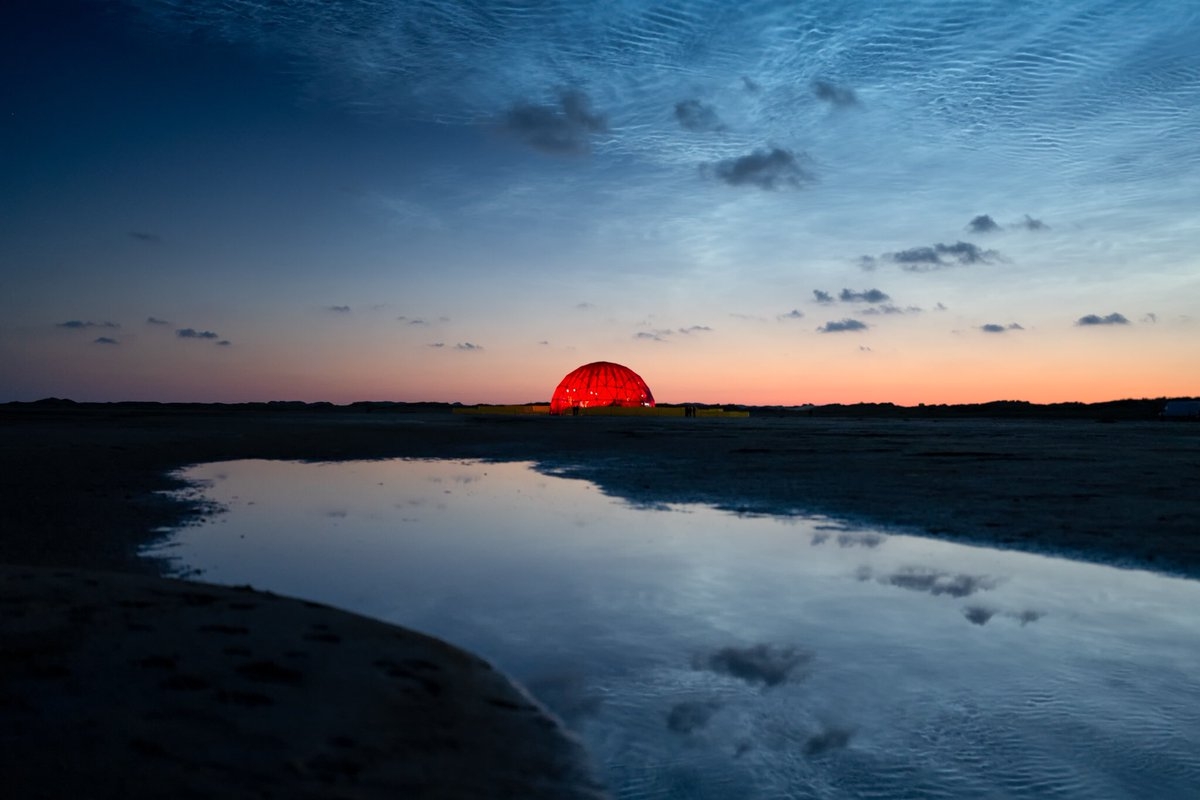
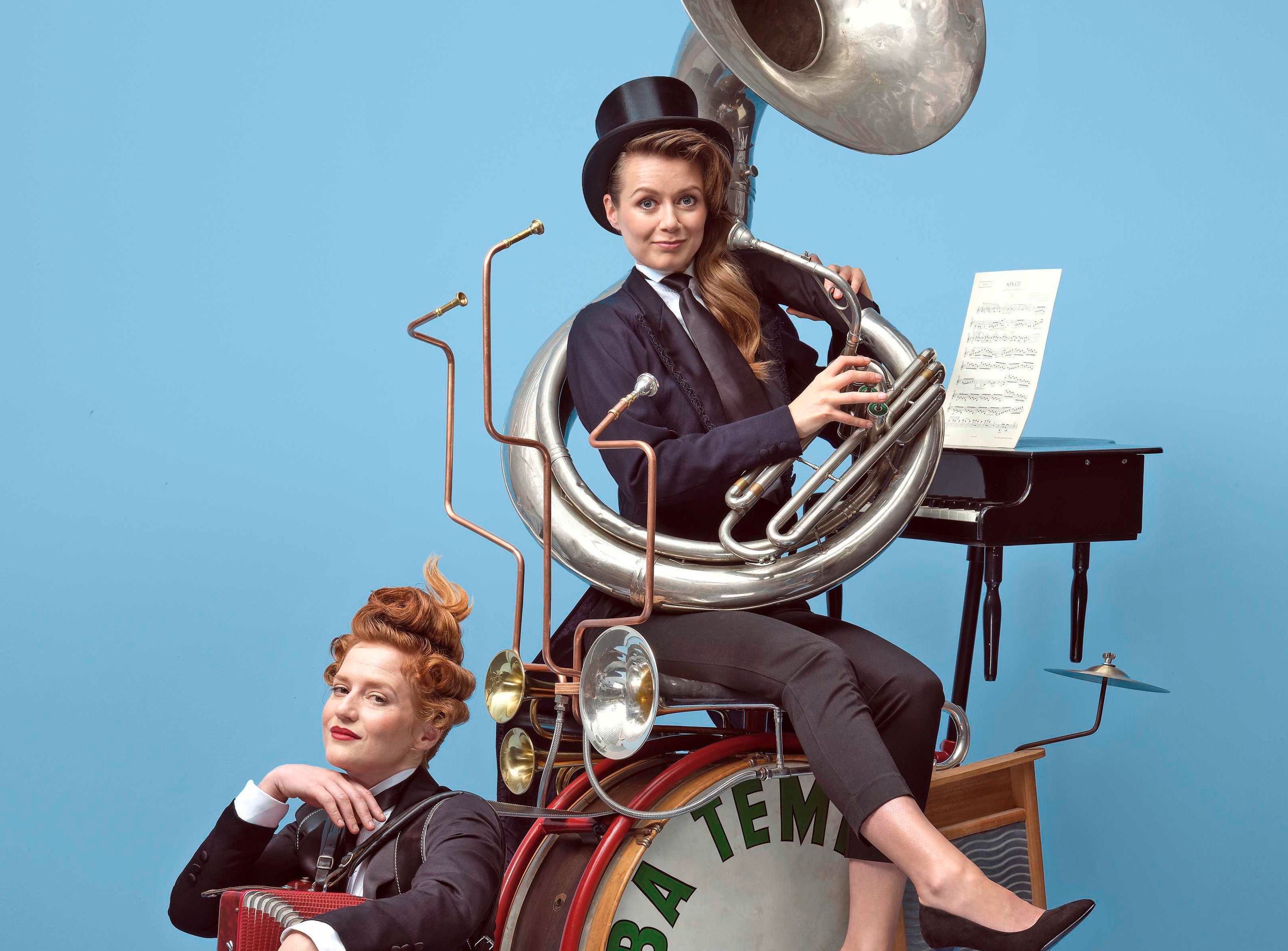
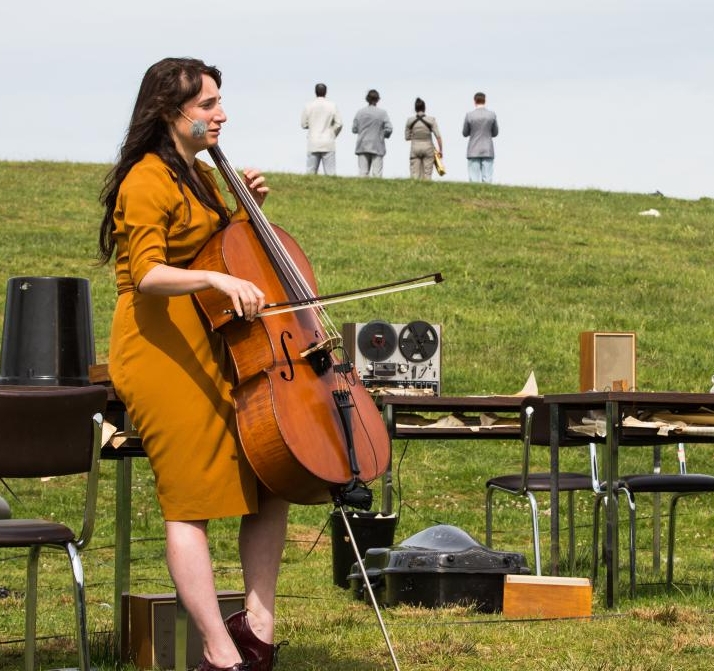
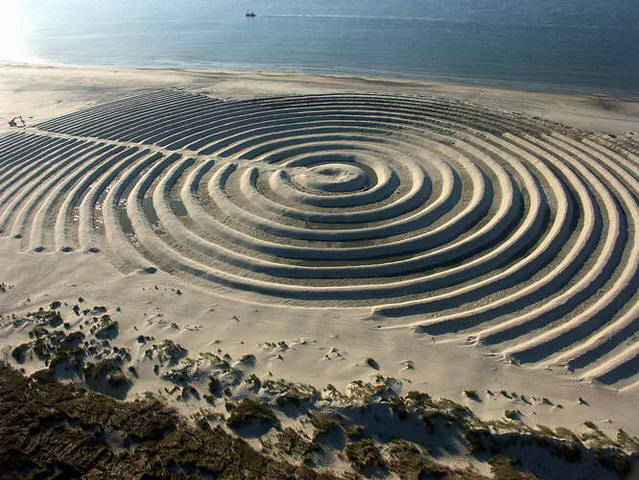
Magic horse dressage
The French actors and riders Manolo and Camille form Théâtre du Centaure. In De Stormruiter they ride several stallions that play
a determining role in the story. The contribution of Theater du Centaure will enchant the public. Below in Festival 'Oerol.'
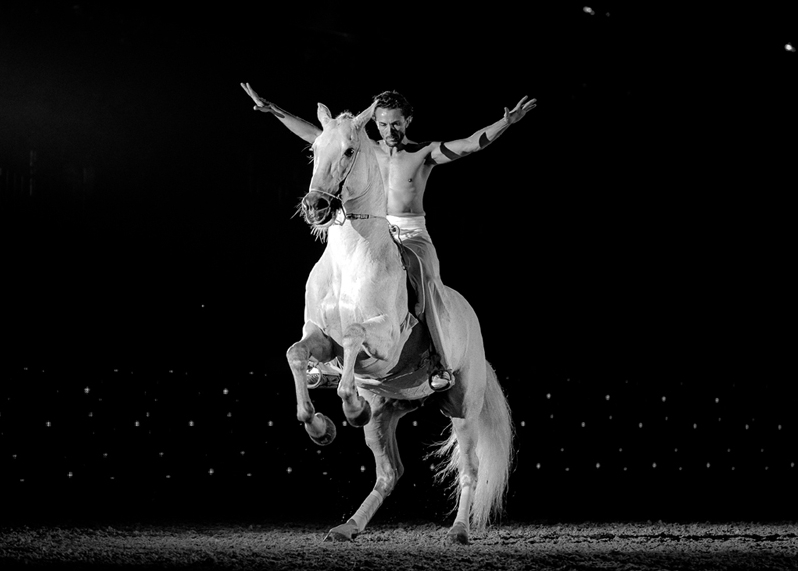
In addition to the fact that Manolo almost completely refrains from using reins, it also seems that he is riding without a saddle. But that is outward appearance.
It is, however, a very small saddle model. For example, he performs a complete dressage test, but also performs from the Spanish driving school as (several times)
a capriol. That counts as the most difficult jump in the horse world.
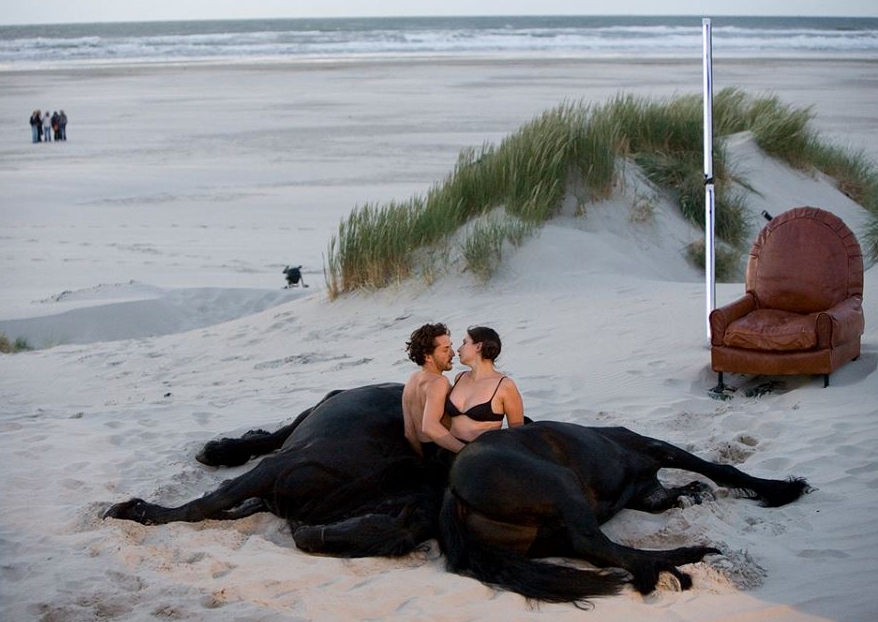
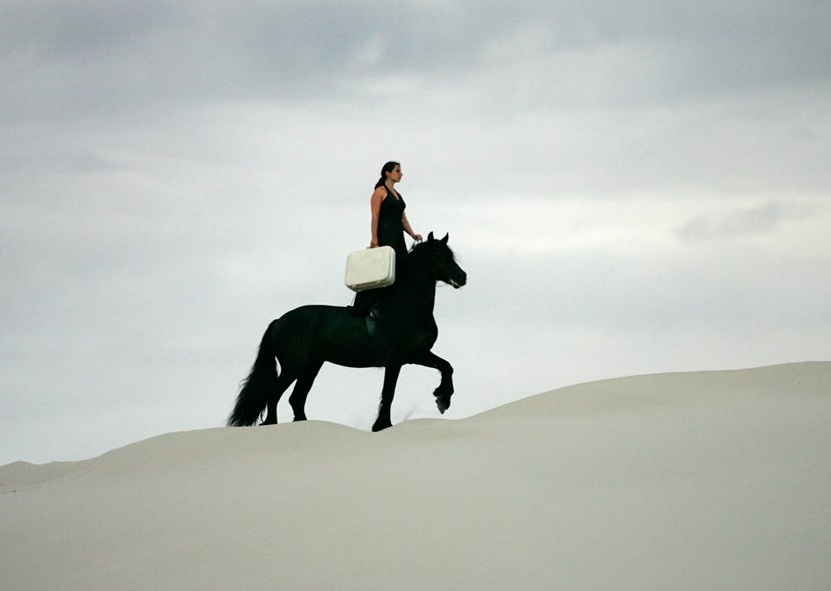
And ...'Théâtre du Centaure' in the Dutch 'Storm Rider.'
As if a Greek myth comes to life. That is the magical effect of the French theater company Théâtre du Centaure. The myth of the centaur, or horse man, has inspired many
artists through the ages. The same applies to the actors and riders Manolo and Camille from Marseille, France. They sometimes seem to actually be one with the horse on which they ride.
In their performances they combine an impressive piece of top dressage with theater, poetry and film projections. The centaur is central to everything they do. Manolo and Camille have
already impressed many audiences with their acts, including at Oerol in 2007 and 2008, and during the Frisian horse show Faderpaard.Below Théâtre du Centaure. See what he can do with a horse
Although from 2015, he does almost the same in Leeuwarden! So you see again, centaurs really exist! Man merged with the horse!
Graceful dance
Two large Lusitano gray stallions play an important role in the theater performance. One will be ridden by Camillo, the other by Jelle de Jong, who plays the role of Hauke Haien.
They are very well trained animals, especially when it comes to acts. They can include pirouette, piaffe, passage but also kneeling, prancing and all kinds of theatrical arts.
Camille rides two Friesian horses during De Stormruiter. With the gray stallions, but also with Friesian horses, the two French riders and a large part of the extremely difficult but graceful dressage.


Singer Ellen ten Damme
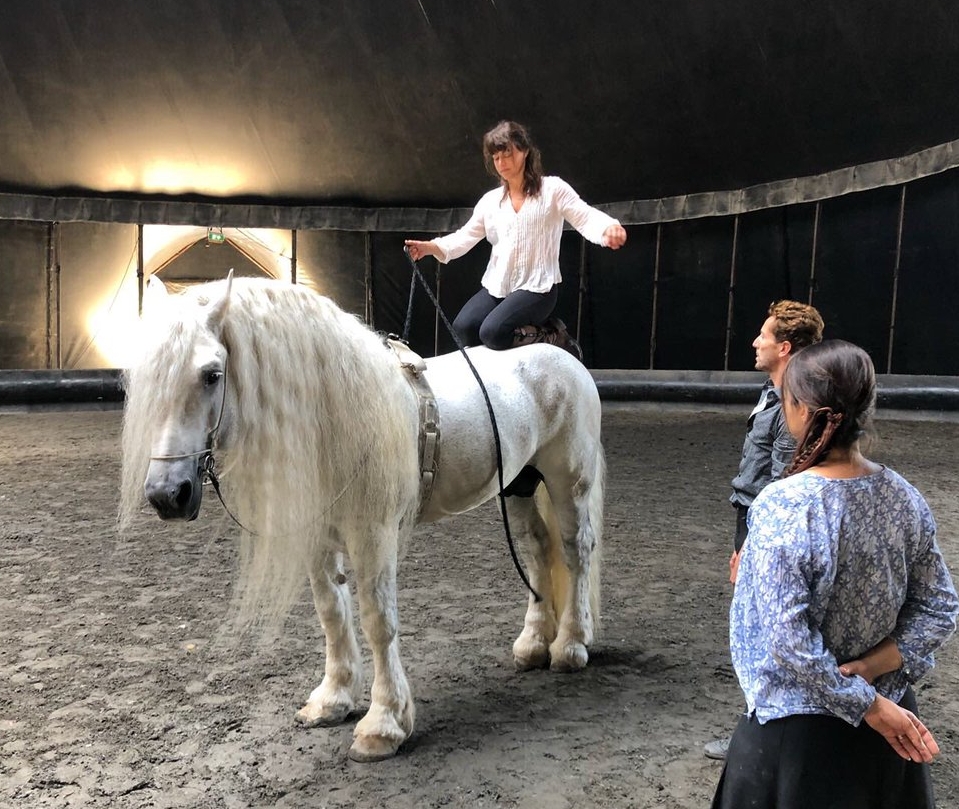
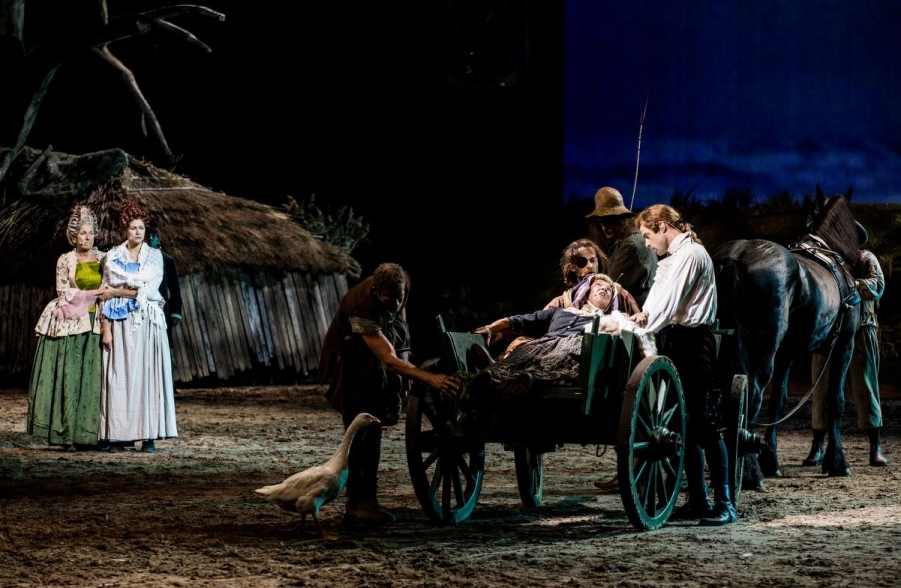
A nice impression of Oerol
Leeuwarden was the European Capital of Culture in 2018. In that year it was all about connection. Connection within the Netherlands and connection
with the rest of Europe. A wonderful program was presented throughout the year consisting of large and smaller events.
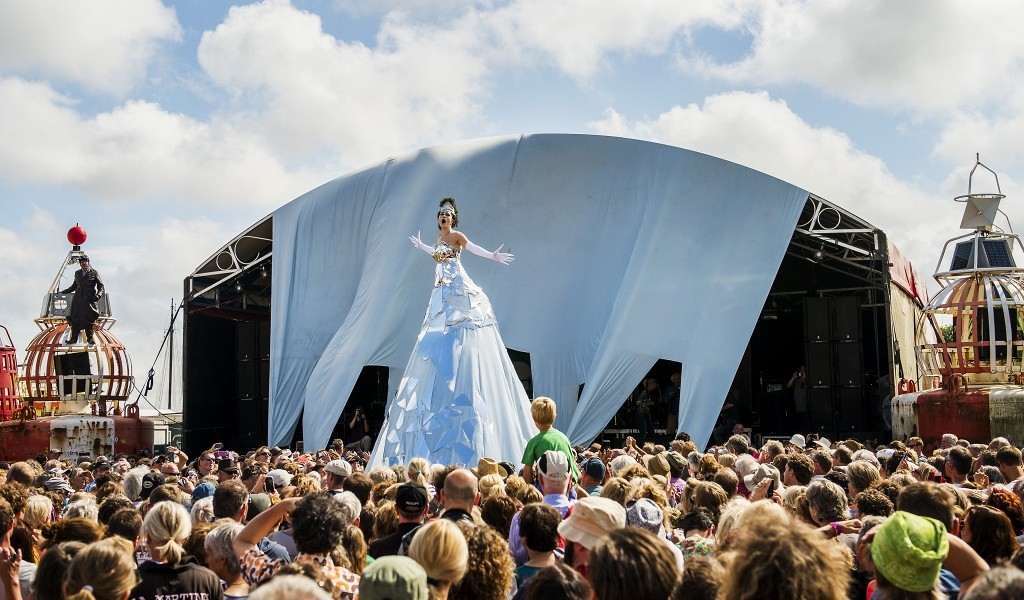
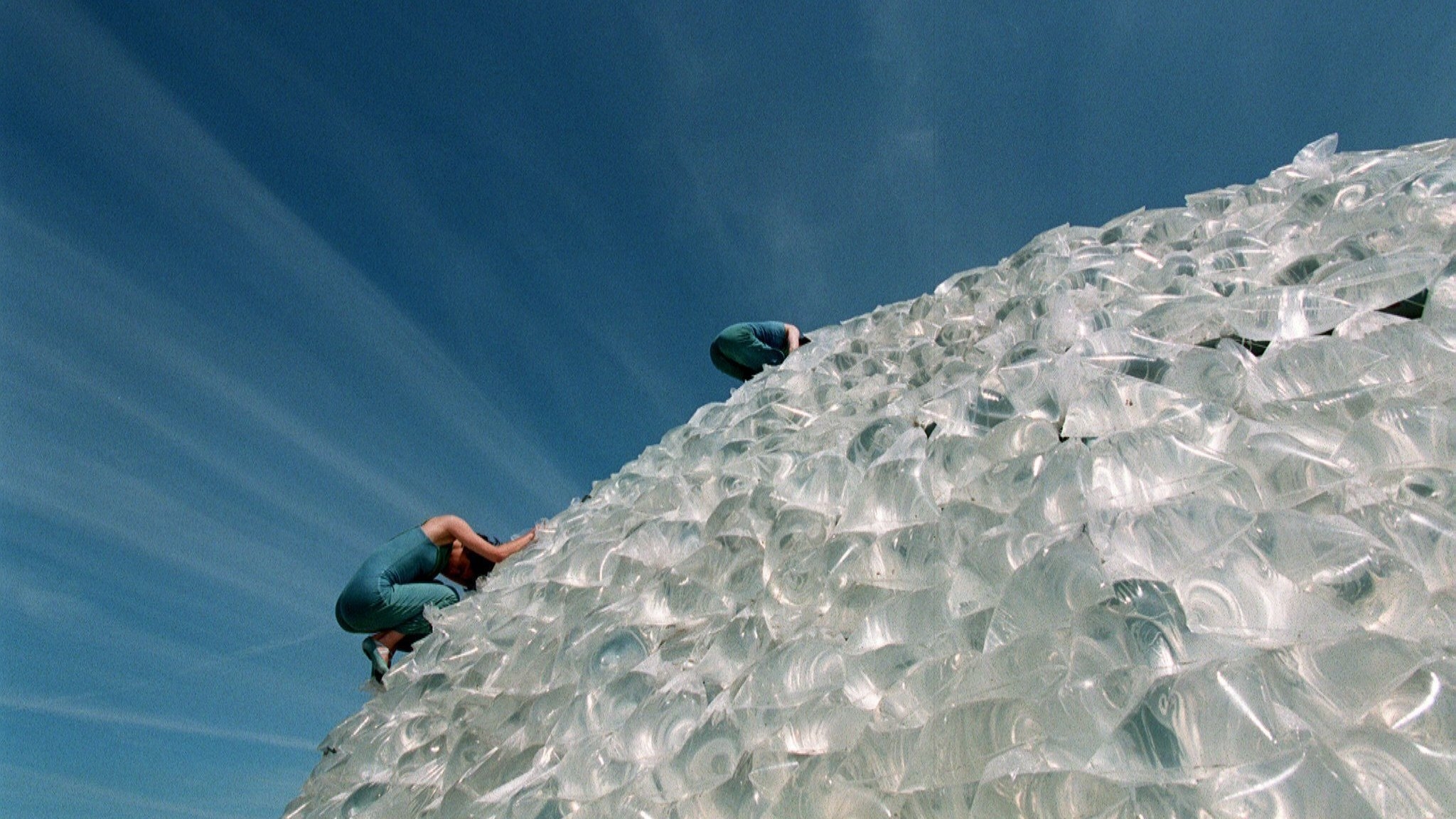
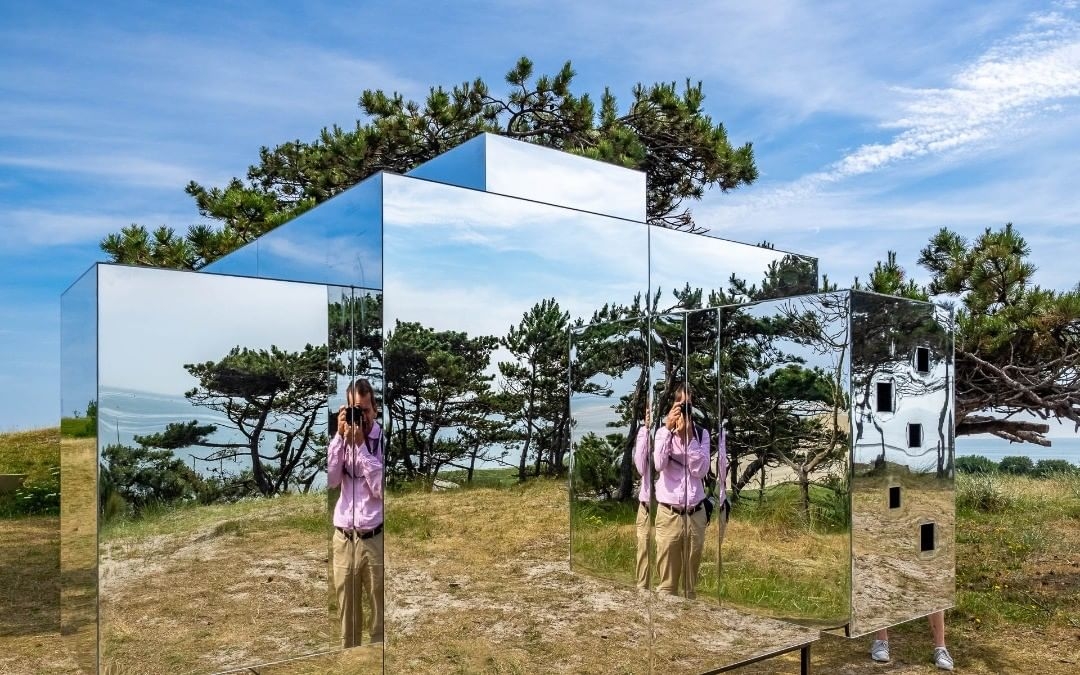
Every years Oerol works with a theme
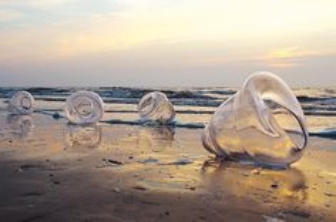
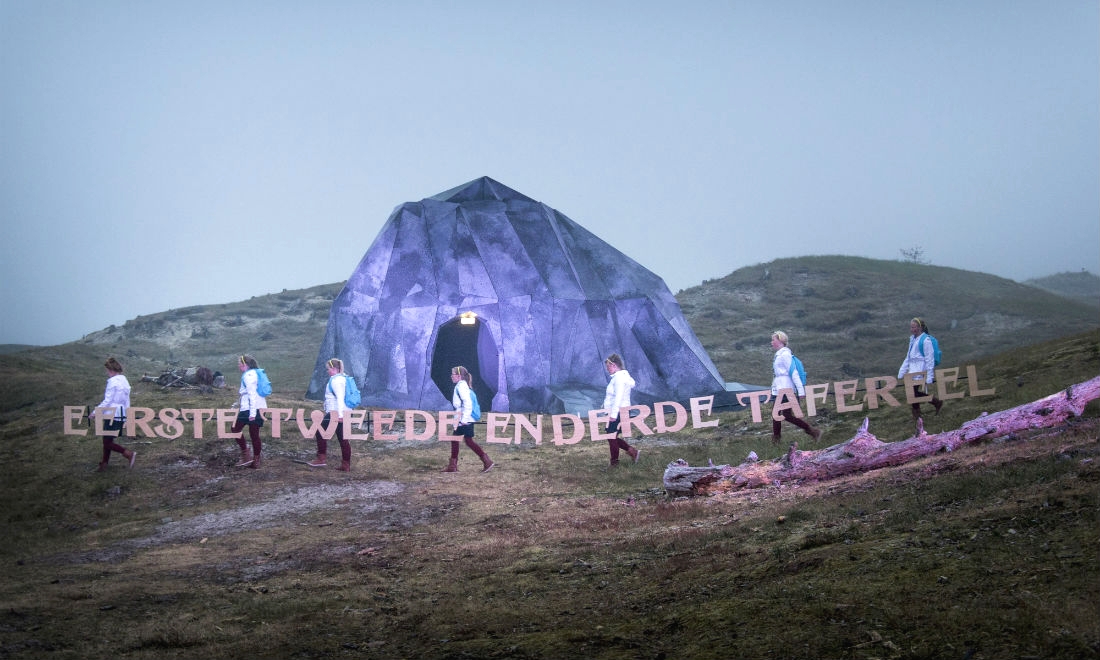
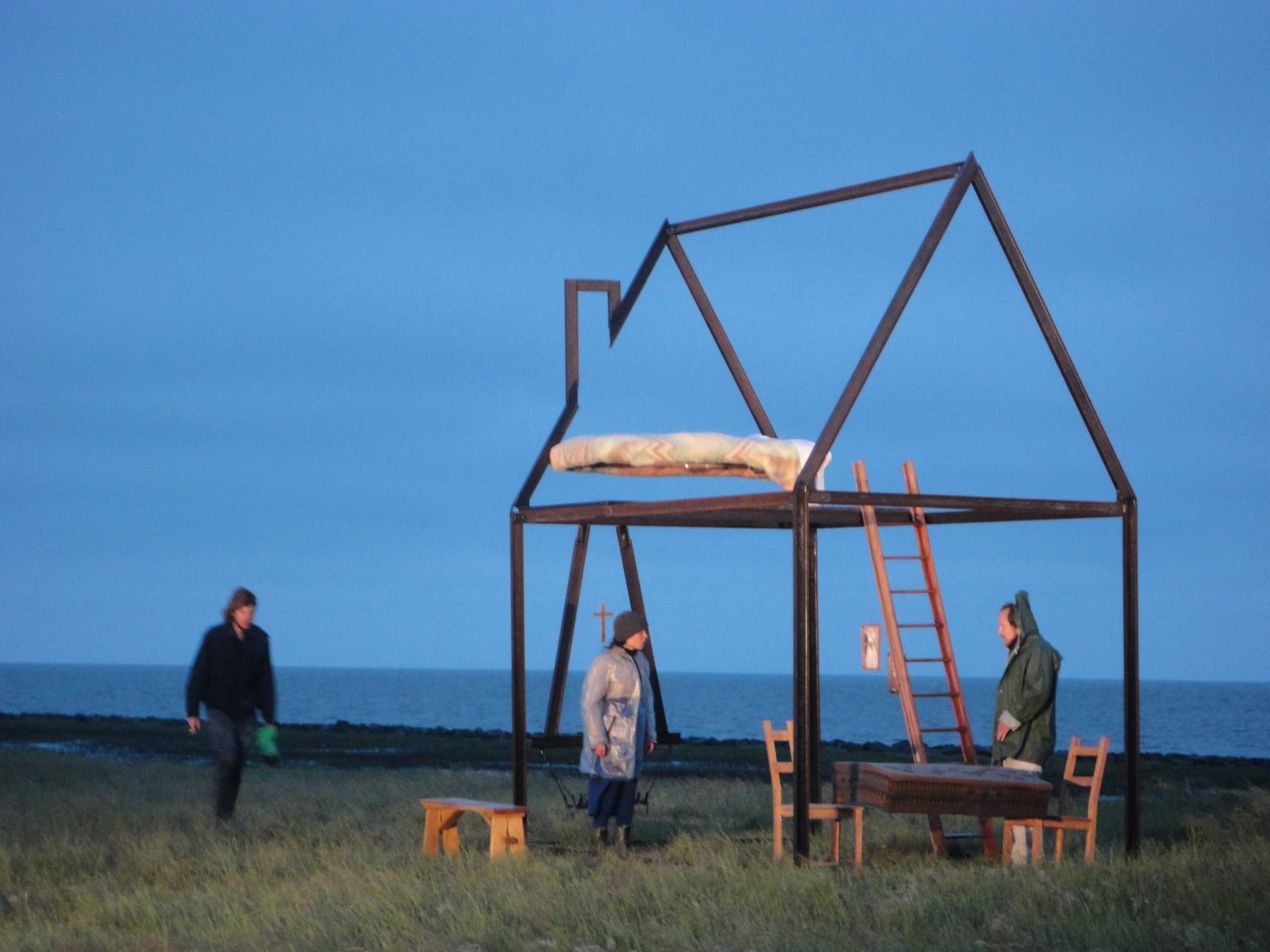
The 12 Fountains
11 Fountains are a group of fountains in the eleven Frisian cities that were placed in the context of Leeuwarden-Fryslân in 2018. The fountains were created by various international visual
artists under the supervision of curator Anna Tilroe. The eleven fountains were unveiled simultaneously on May 18, 2018. The IJsfountain in Dokkum was put into operation on 22 February 2019.
The fountain of Leeuwarden, capital of Friesland
They were also featured in the Euro Songverstival may 2021, which The netherlands organize due
to the victory of Duncan Laurence in 2019. (2020 there was no song contest due to corona).
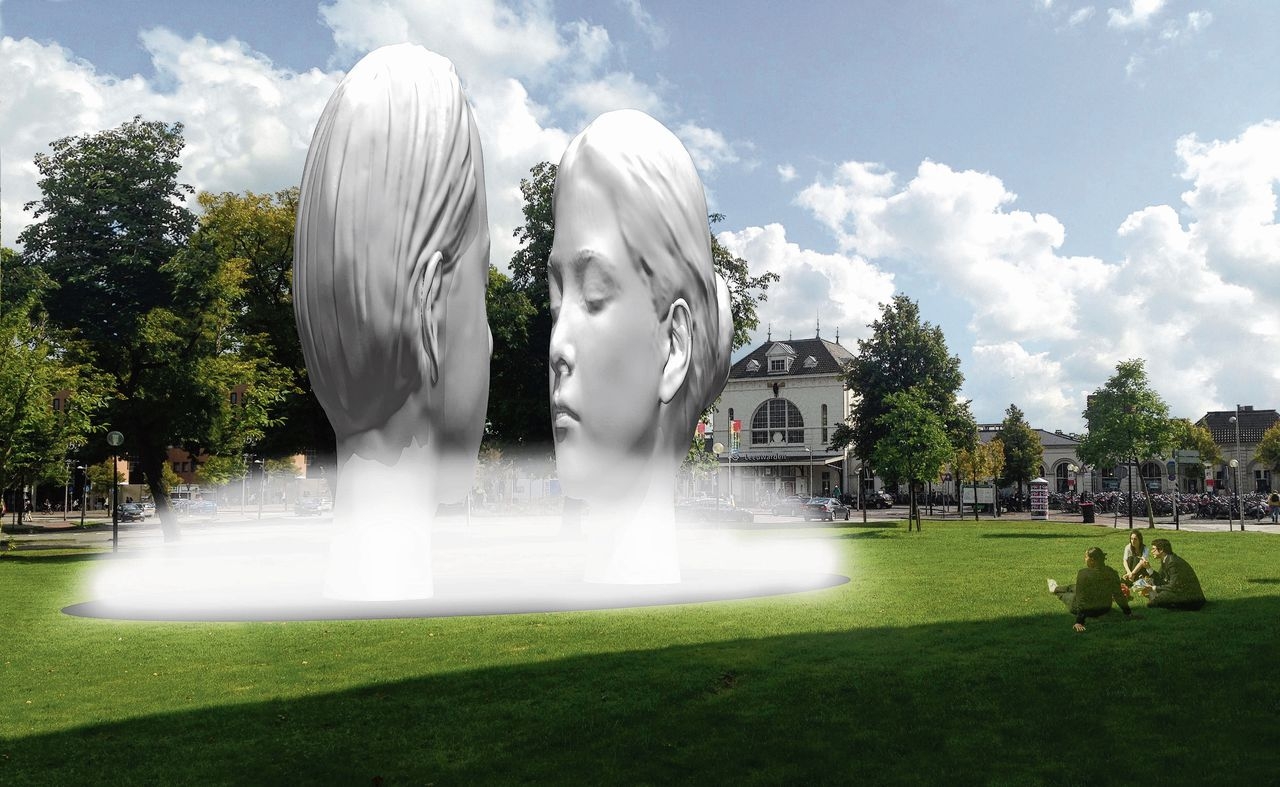
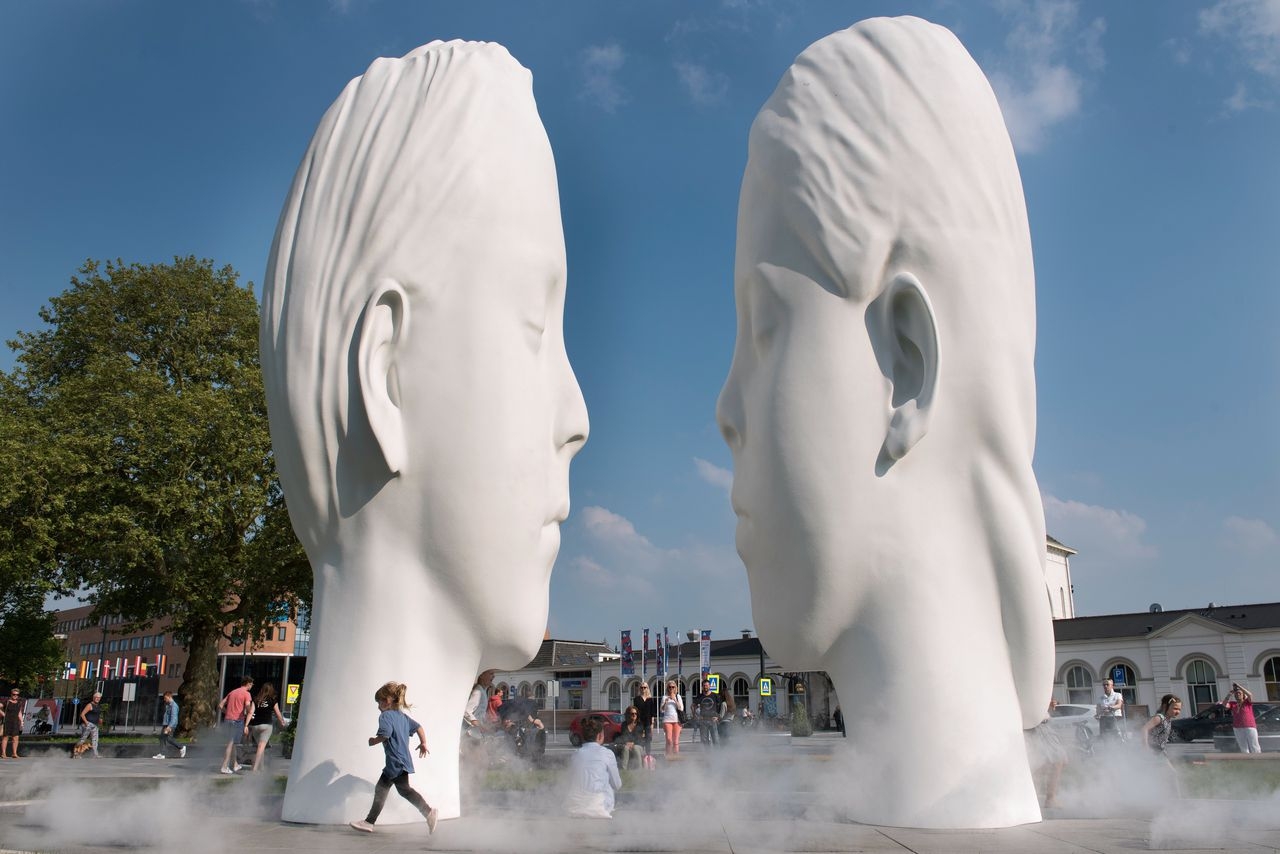
Fountain Stavoren
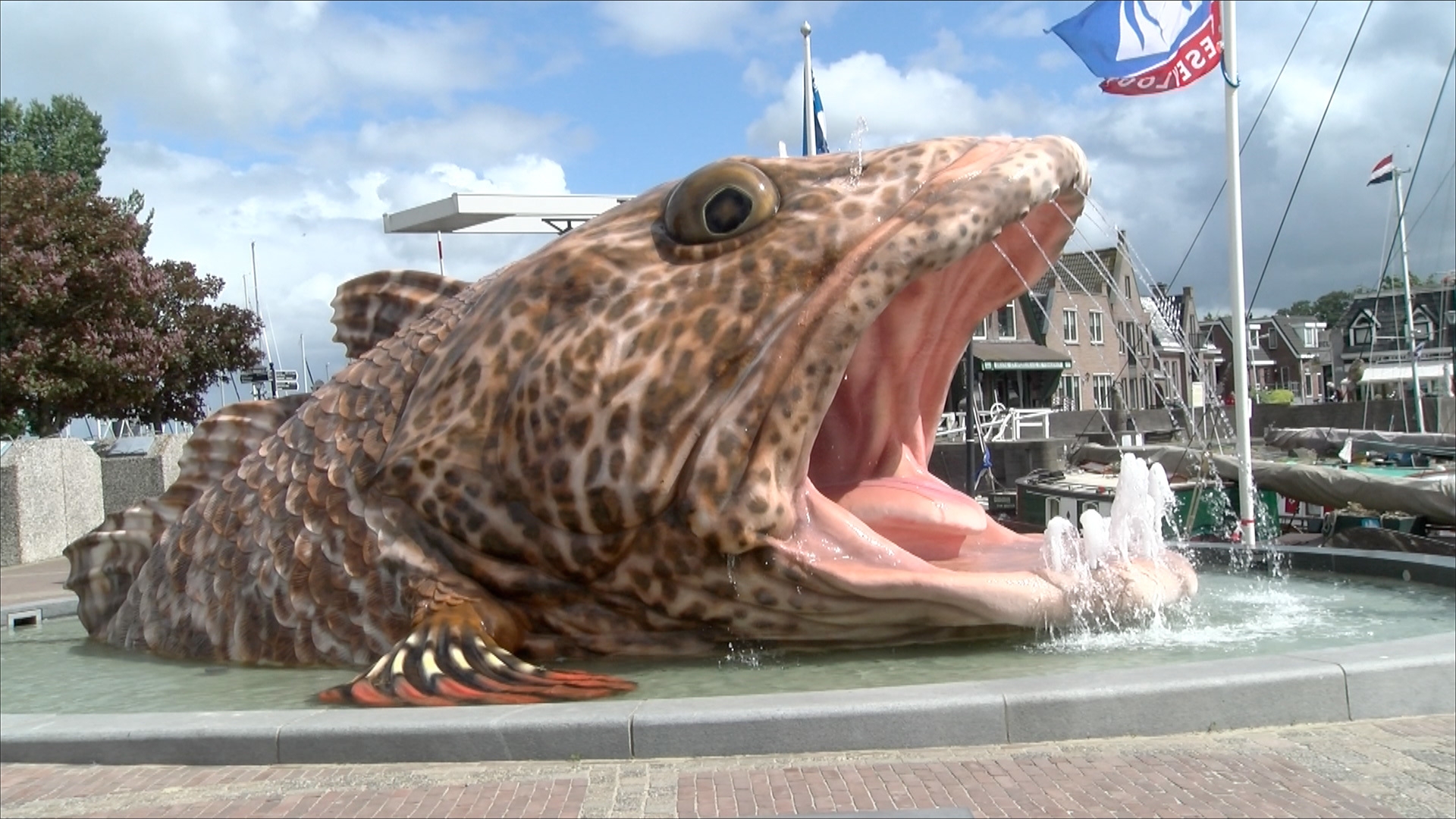
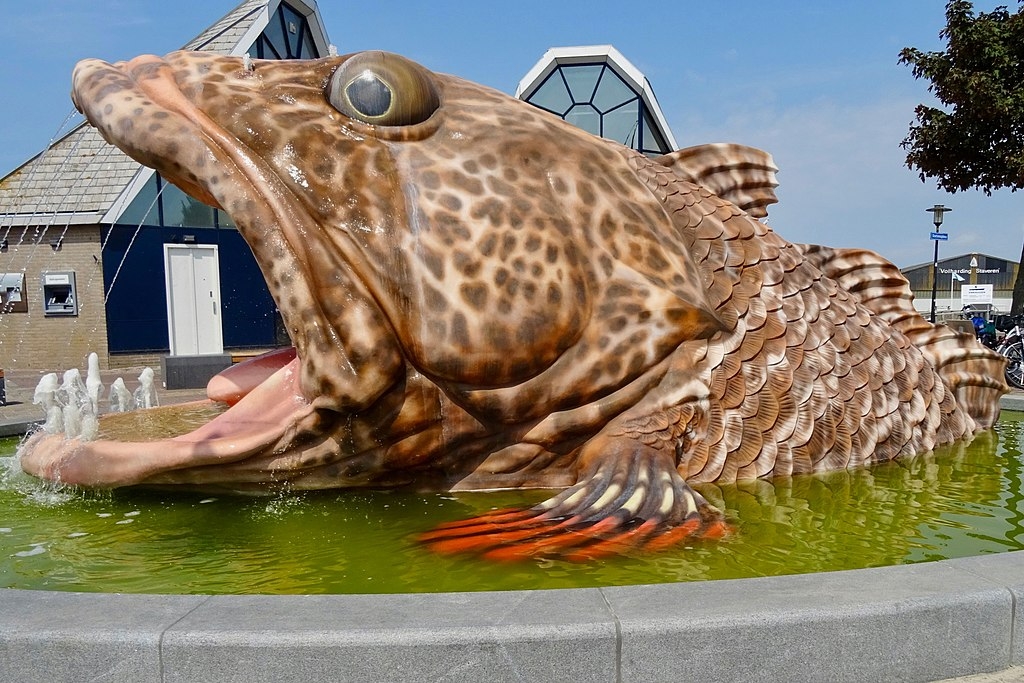
Fountain Bolswart, my favourite
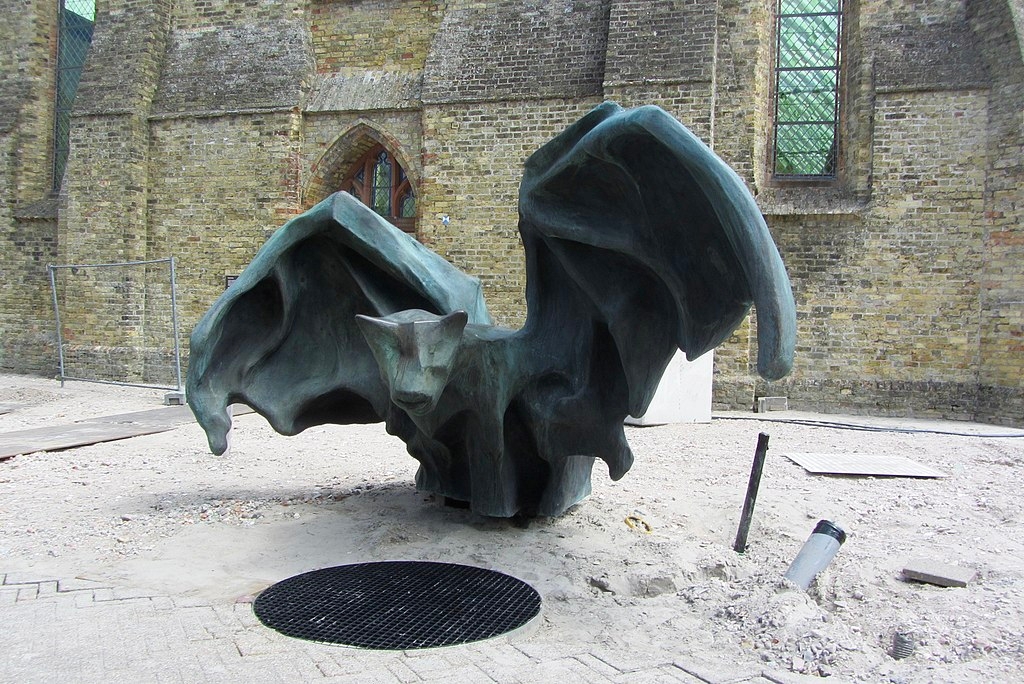
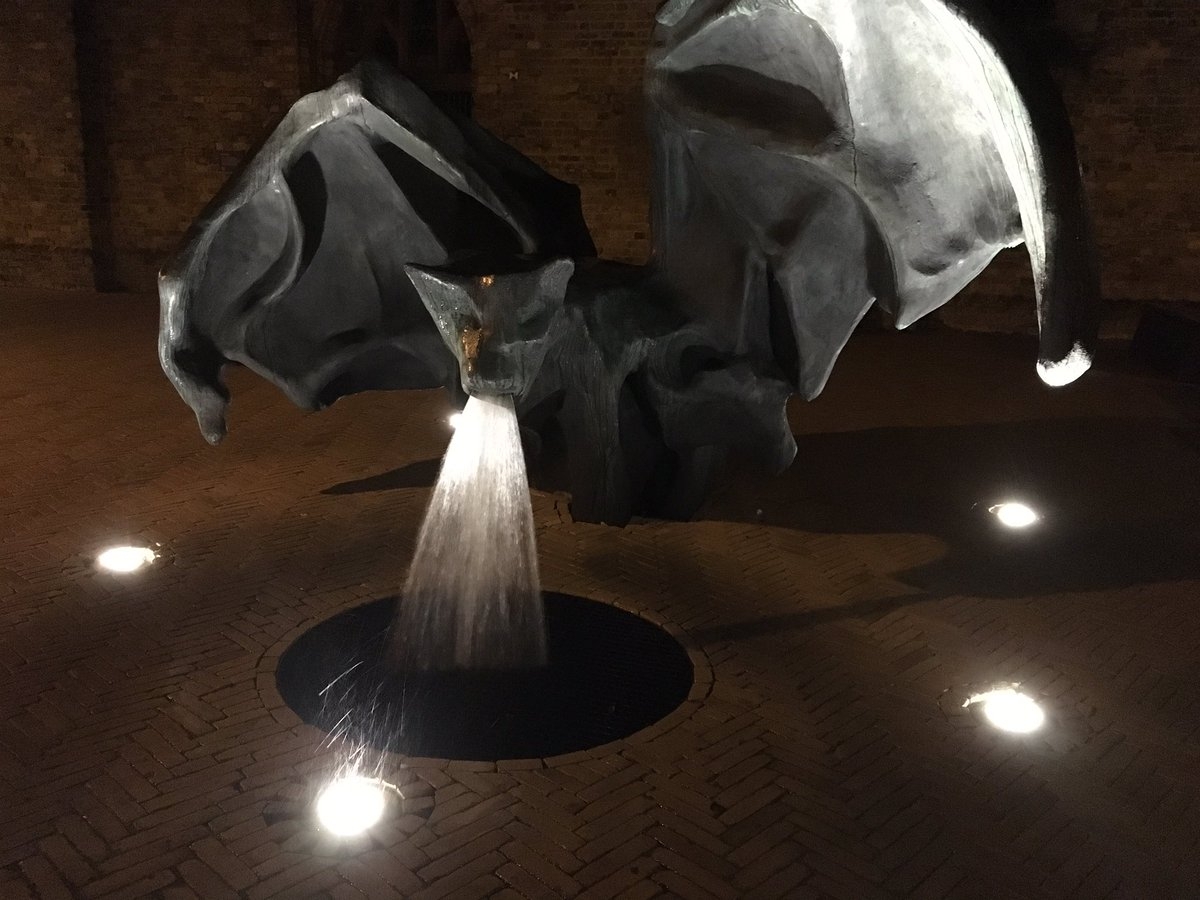
Fountain Harlingen
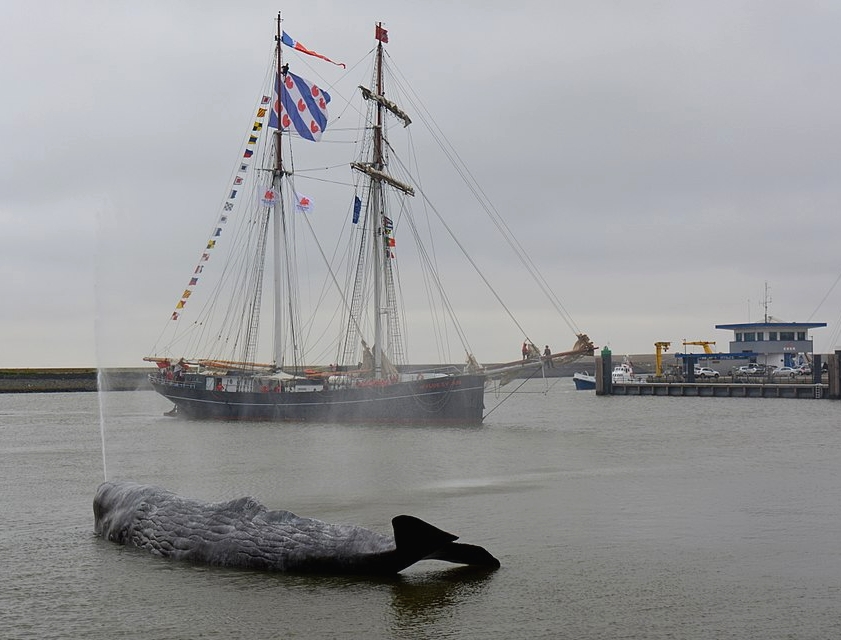
Tallships Harlingen
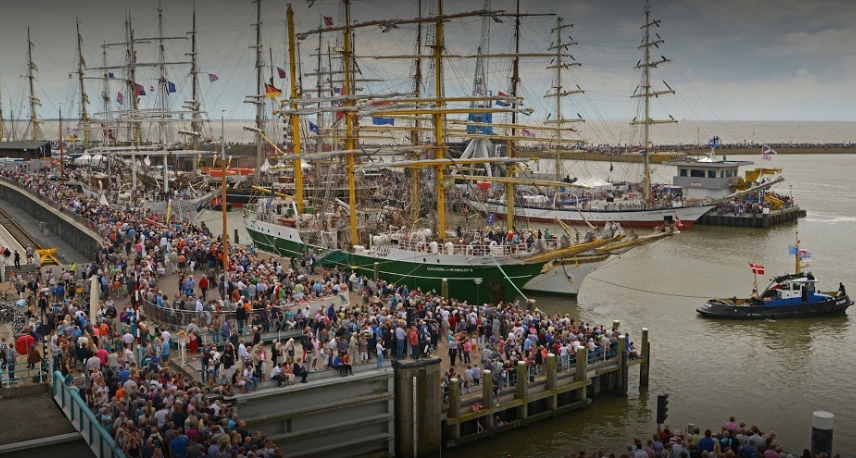
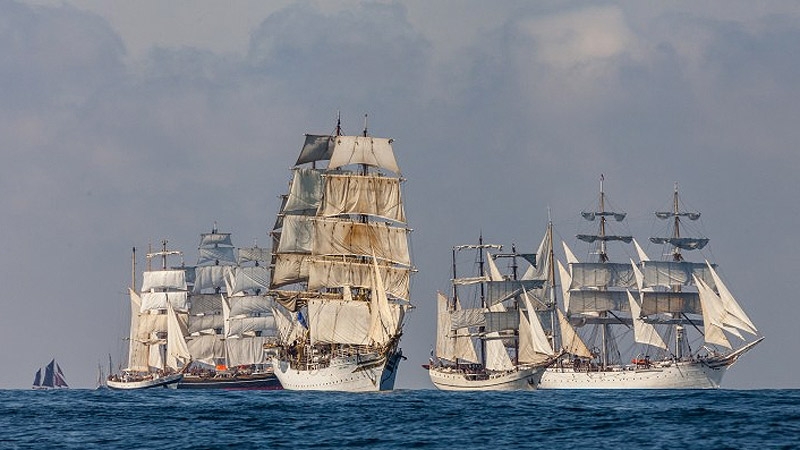
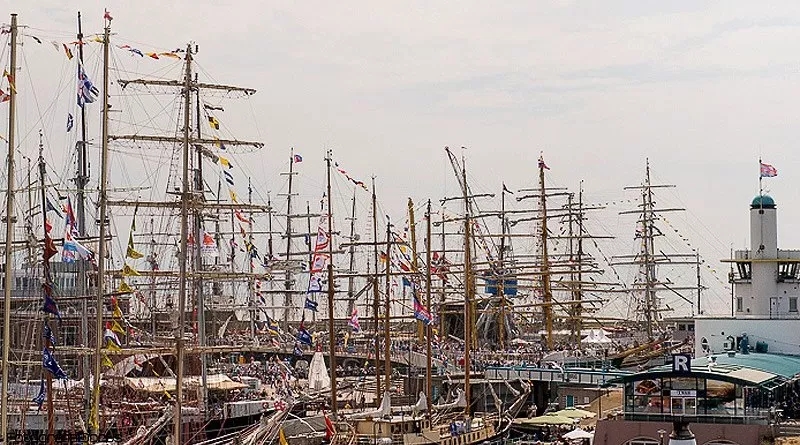
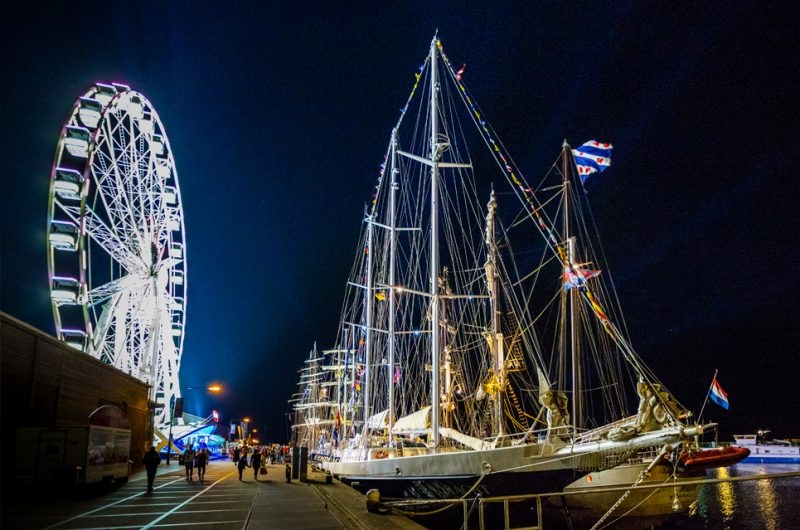
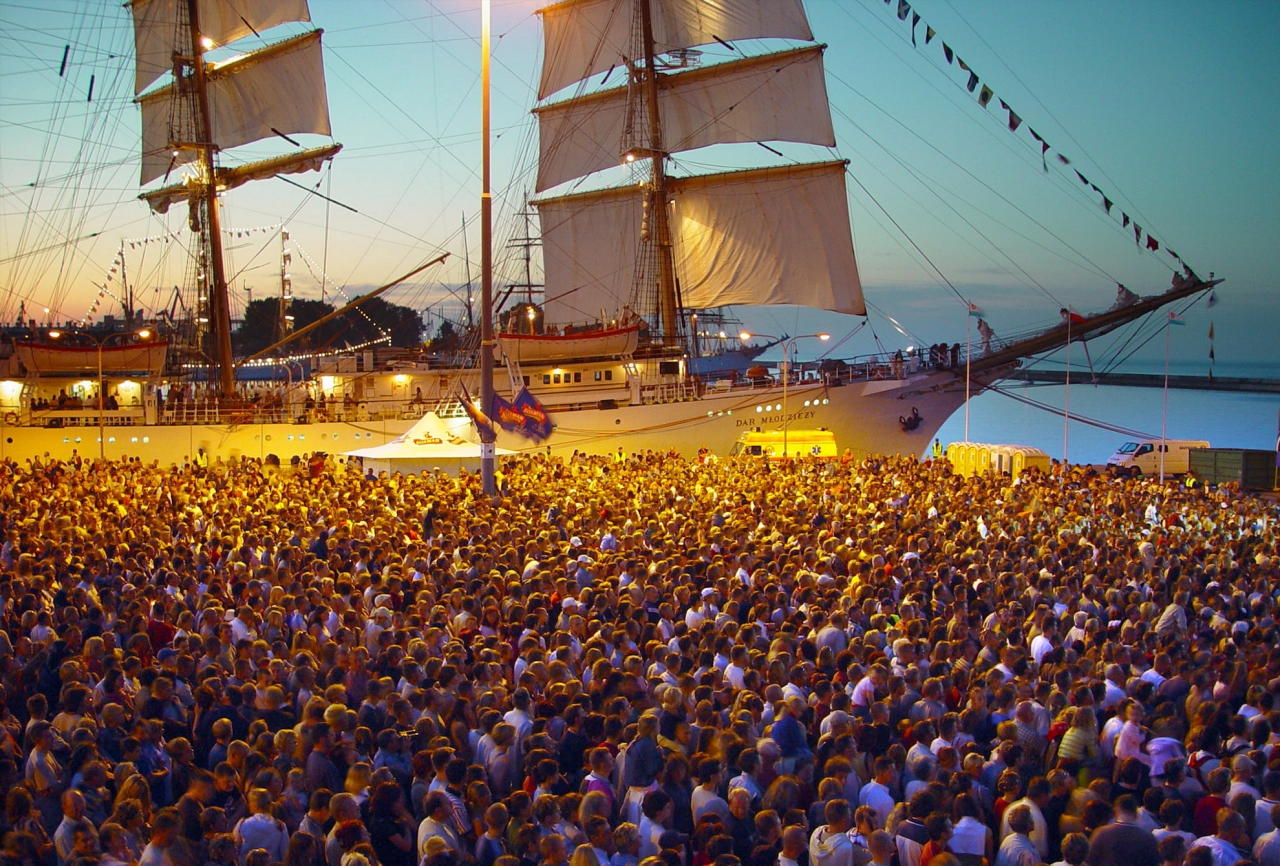
And there is
- And 'Grutte Pier' (tall Pier) A movie about him is coming soon. - Radboud/Redbad (last year a huge filmproject is shot here called Redbad)
- Mata Hari was born in Leeuwarden, Friesland
Maurits Cornelis Escher was a Dutch artist, known for his woodcuts, wood engravings and lithographs, in which he often played with mathematical principles.
He signed his work with MCE. Born: June 17, 1898, Leeuwarden, Deceased 27 March 1972, Laren
Periods: Op art, Surrealism, Expressionism, Realism, Cubism, Northern Renaissance, Modern art
Full name: Maurits Cornelis Escher. Series: Regular Division of the Plane. Children: Giorgio Arnaldo Escher, Jan Escher, Arthur Escher
Holland artistic
We are one of the most densely populated countries in Europe and even though we are a small country, we still have quite a few artists, clever inventions and a good organization of things.
Rembrandt and van Gogh
Rembrandt's wife Saskia came from Friesland and van Gogh from the Netherlands. van Gogh visited many countries like England but has a good binding with France. In Though he came from
Holland and stayed here, returned ..he prefered to stay in France and ma de a lot of French paintings. Les Baux I've seen most of the works on the huge walls with music and it's special! We
visited some spots he once painted and the atmosphere is so nice and the use of the colors too. Funny his wife came from the toen I live now and he painted in Avignon etc.
Van Gogh is seen as one of the greatest painters of the 19th century. However, this recognition came late. He even painted Montmajour!
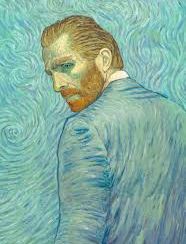
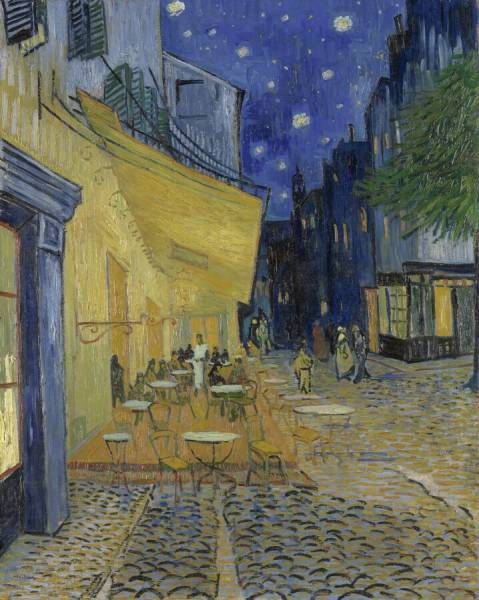
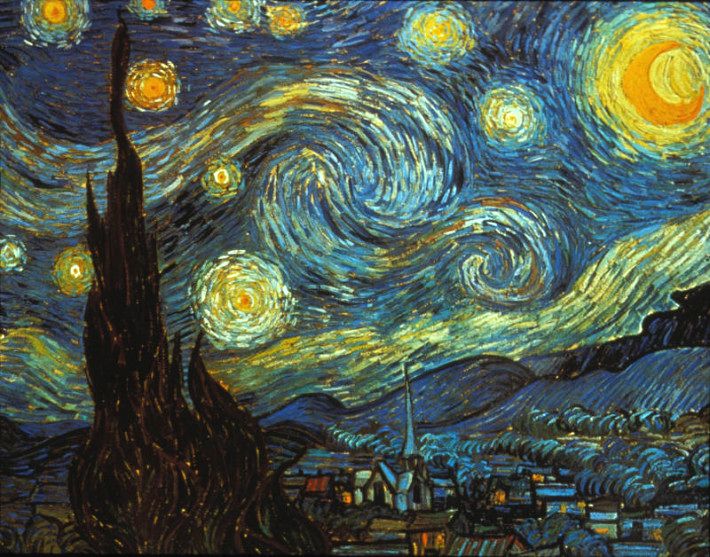
And Rembrandt van Rijn, his wife came from Friesland Leeuwarden enad they married in Sint Annaparochie (FRL)
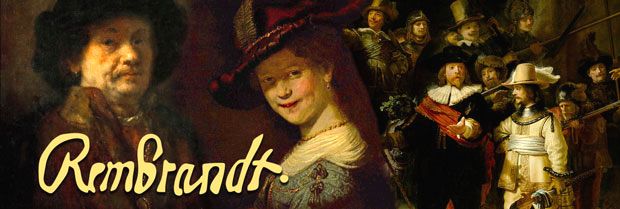
Escher
The artworks of Maurits Cornelis Escher (Leeuwarden, 1898) mainly raise questions with the average museum visitor. The way in which the Escher plays with perspective in his
imaginative artworks causes headaches, but the man himself is also a big unknown to many.
Marcel Westerdiep knows what he is talking about when it comes to the image people have of Escher. In his position, he has been traveling the world for years to admire the art of the
native Frisian at exhibitions. A few years ago Westendiep was at an Escher exhibition at the Centro Cultural Banco do Brasil in Rio de Janeiro. "That turned out, if you divide the number of
visitors by the number of days, the most visited exhibition in the world."
It further emphasizes the popularity of Escher abroad. If you drop his name in the Netherlands, not everyone will realize that it is a Dutchman, let alone someone who in some countries
without a gene is mentioned in the same list as Rembrandt, Mondrian and van Gogh. "The Dutch tourist office in Germany is busy making Escher one of the" big five "of our art world,"
Westerdiep explains. "And we notice the effects: more than half of our visitors are from abroad, including many Germans." Source
Owner: gallery of arts washington DC, from 1954
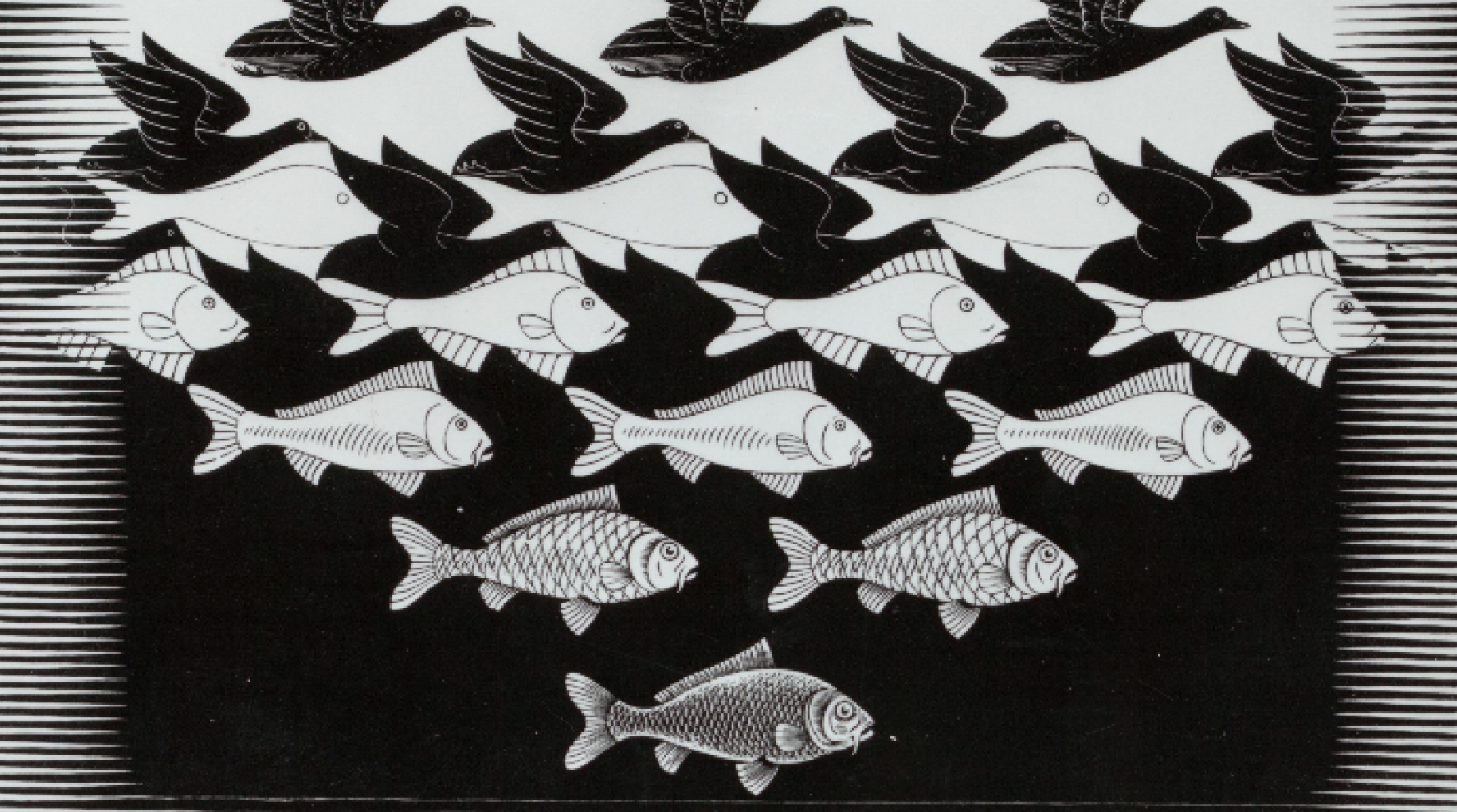
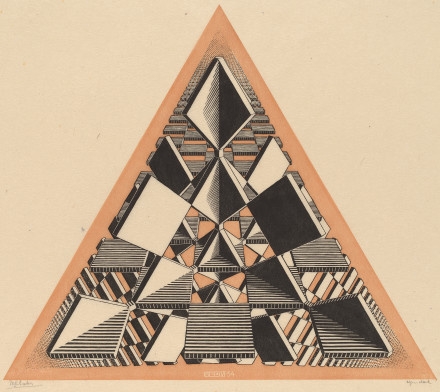
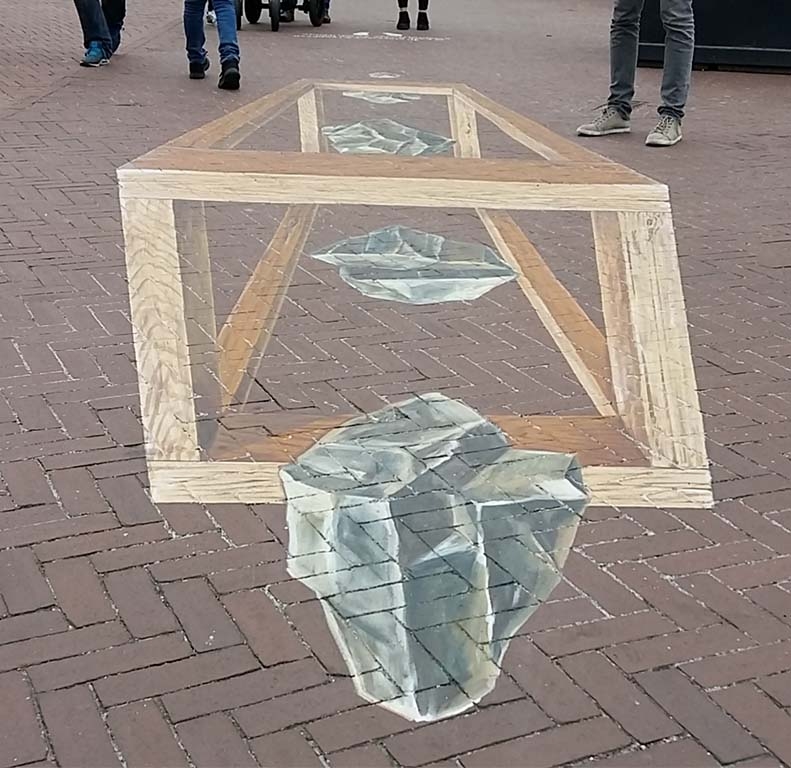
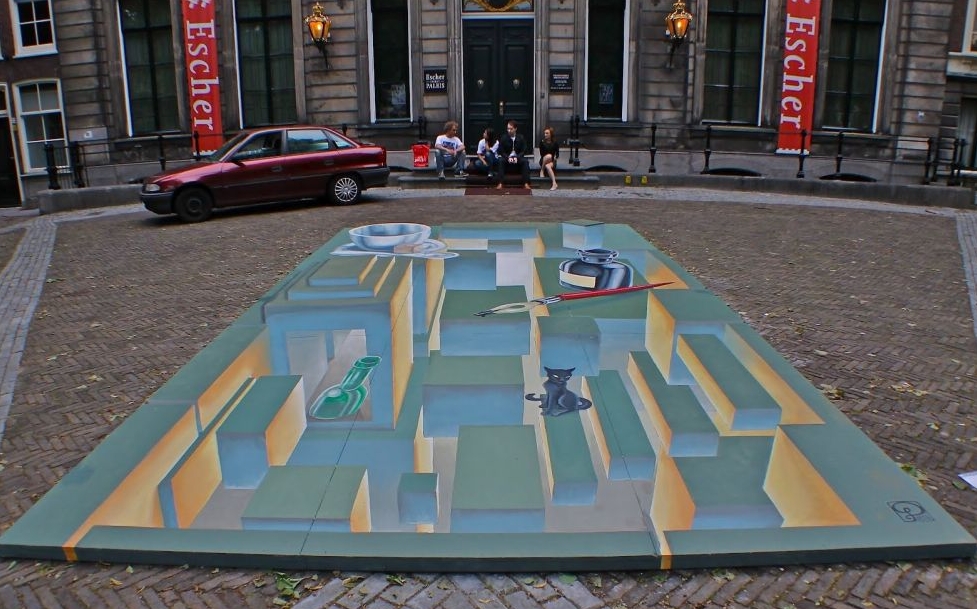
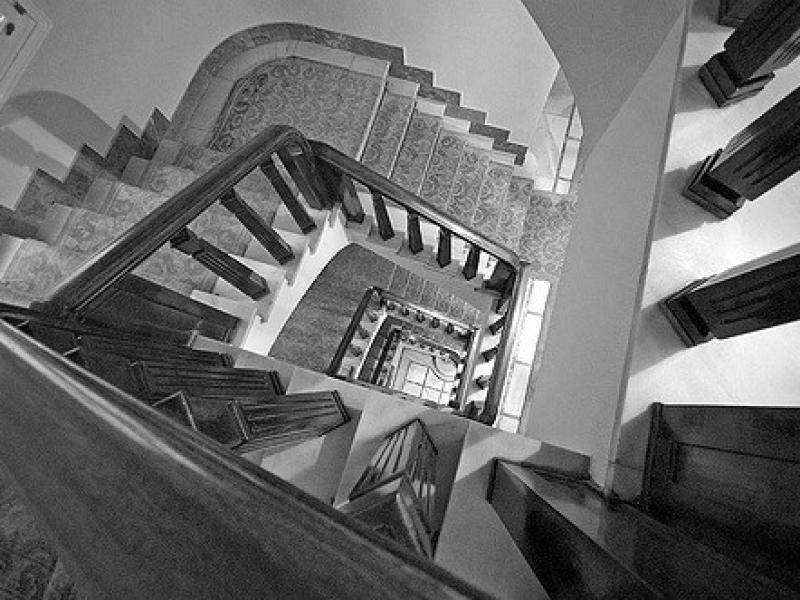
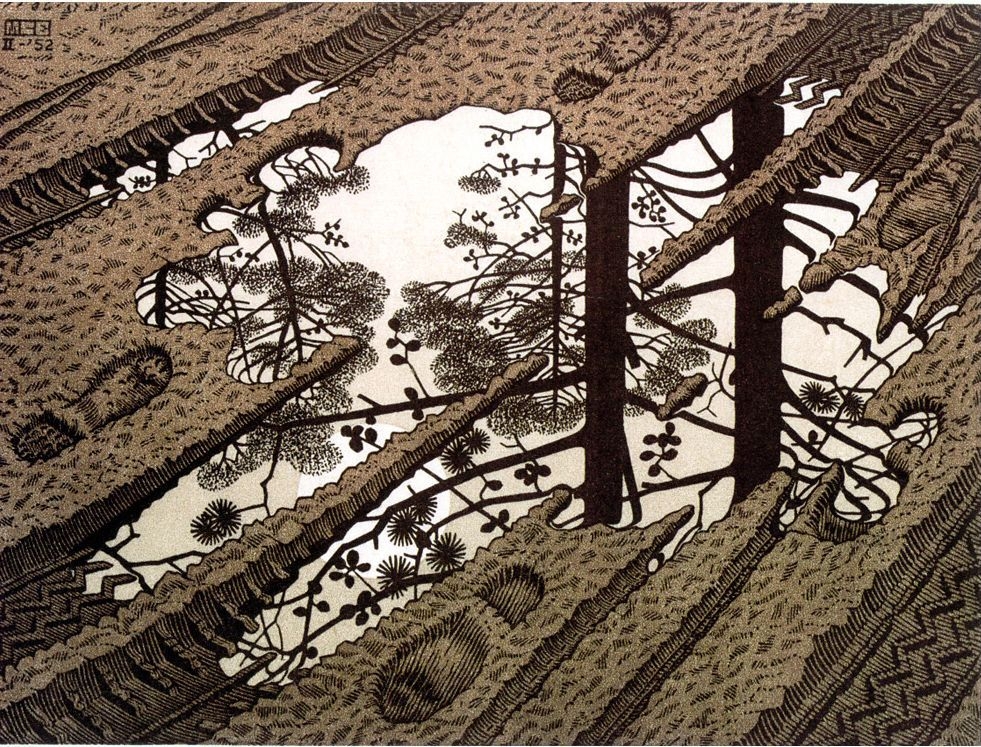
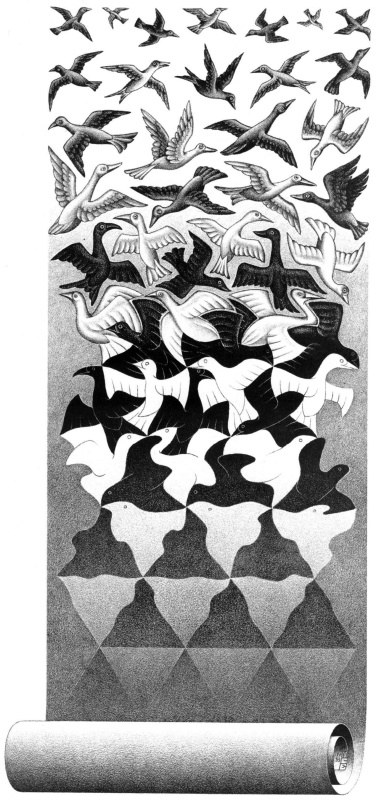
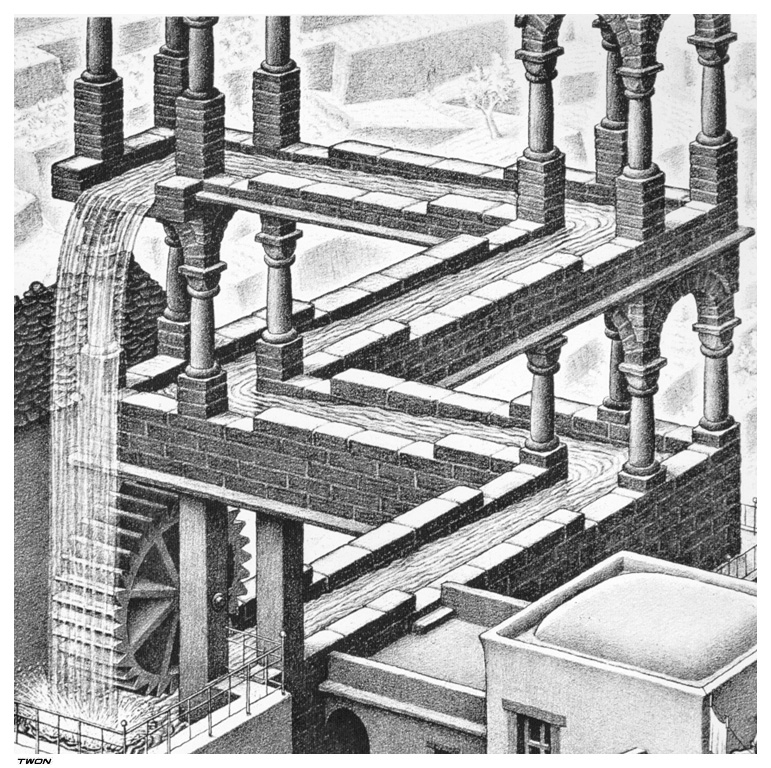
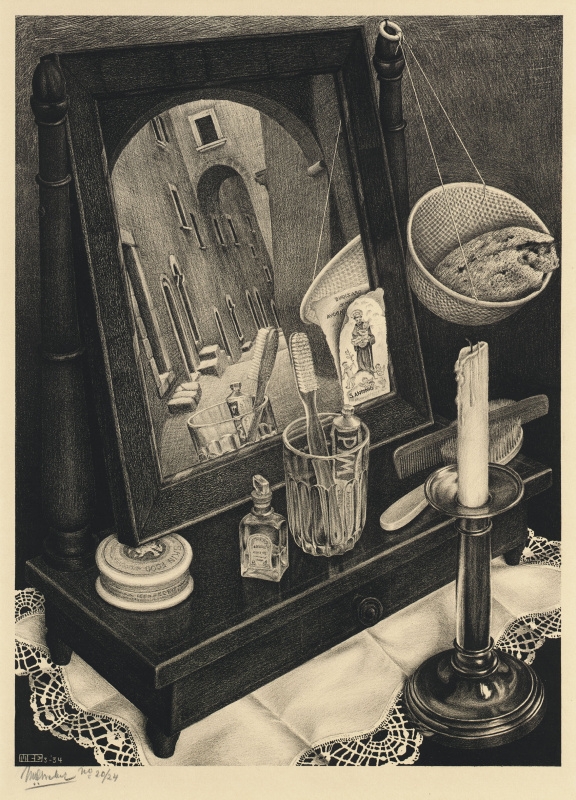
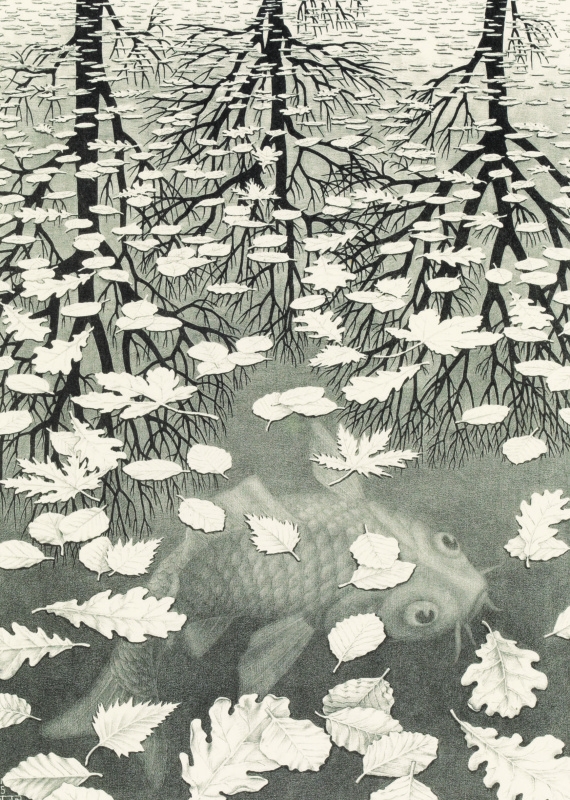
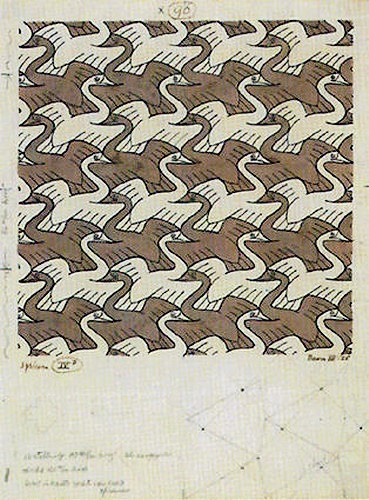
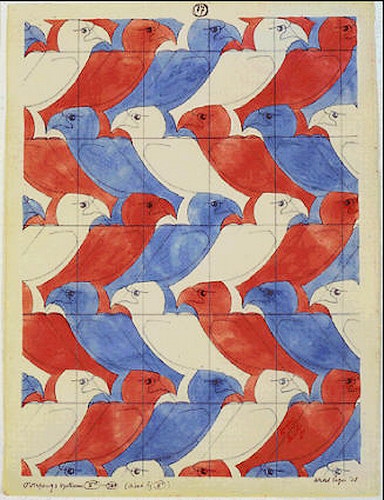
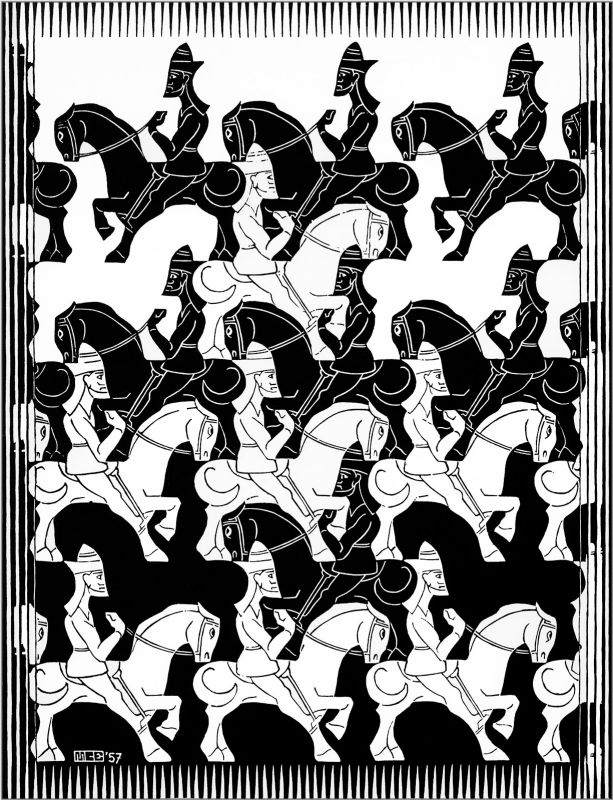
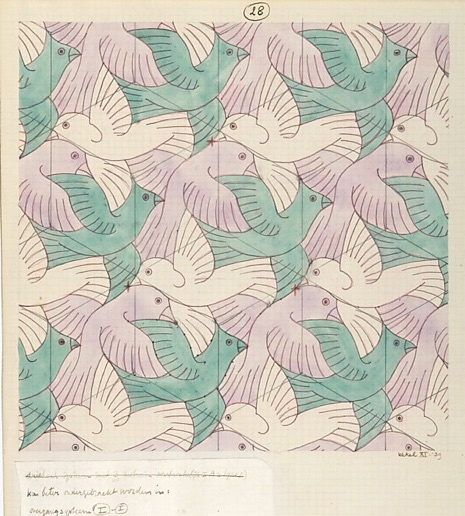
Escher, "that's the man who made you look different." That is stuck. At Escher in Het Paleis you can see how almost everyone is again captivated by this fascination. And then the first question
is always: 'How does the man do it? Why do I believe what I see, while at the same time I know that it is impossible? "It is therefore not only the memory and the recognition that fascinates,
the appreciation for the craftsmanship is certainly just as great.
During all those preparations, devising the subject, making drawings, setting up studies, making detailed drawings and finally working with a woodcut or lithograph,
Mauk Escher sat in the studio of his house in Baarn and looked at the antics of the birds with their food.
Nature, the landscape and later his garden and the forest near his house always inspired. When the family still lived in Italy, 1924-1935, he set out every year. He often made long walks with one or more friends through areas such as Calabria, Sicily or the Abruzzo, which were not yet accessible at the time. They traveled as men, a camera and the drawing material, paper, board and pencils, close at hand. Sometimes they were accompanied by a man with a donkey for the luggage. New prints emerged in the months following the trek, in which he combines those drawings with his memories. In those prints you already discover his great interest in perspective, in addition to a great eye for detail. Source
Tribute to M.C. Escher on the Bildt
Thursday, June 21, 2018, "Ode to M.C. opens Escher op ‘t Bildt’, made possible by Sense of Place. These are works of art in the grain fields of 't Bildt, in the municipality of Waadhoeke.
Artist Henk Rusman, initiator of this project, has been living on 't Bildt for years. In the summer the artist looks over the grain, it appeals to him and all those years he dreams of art in that grain.
In 2017 there was a taste. Together with the artist Marco Goldenbeld, he made a work of art inspired by the impossible cube of Escher. Before 2018, Rusman asked artists to deliver
designs for art in the grain. The artworks can be seen in 't Bildt from 21 June to 15 August.
Escher in my backyard in the fields of gold
The making of
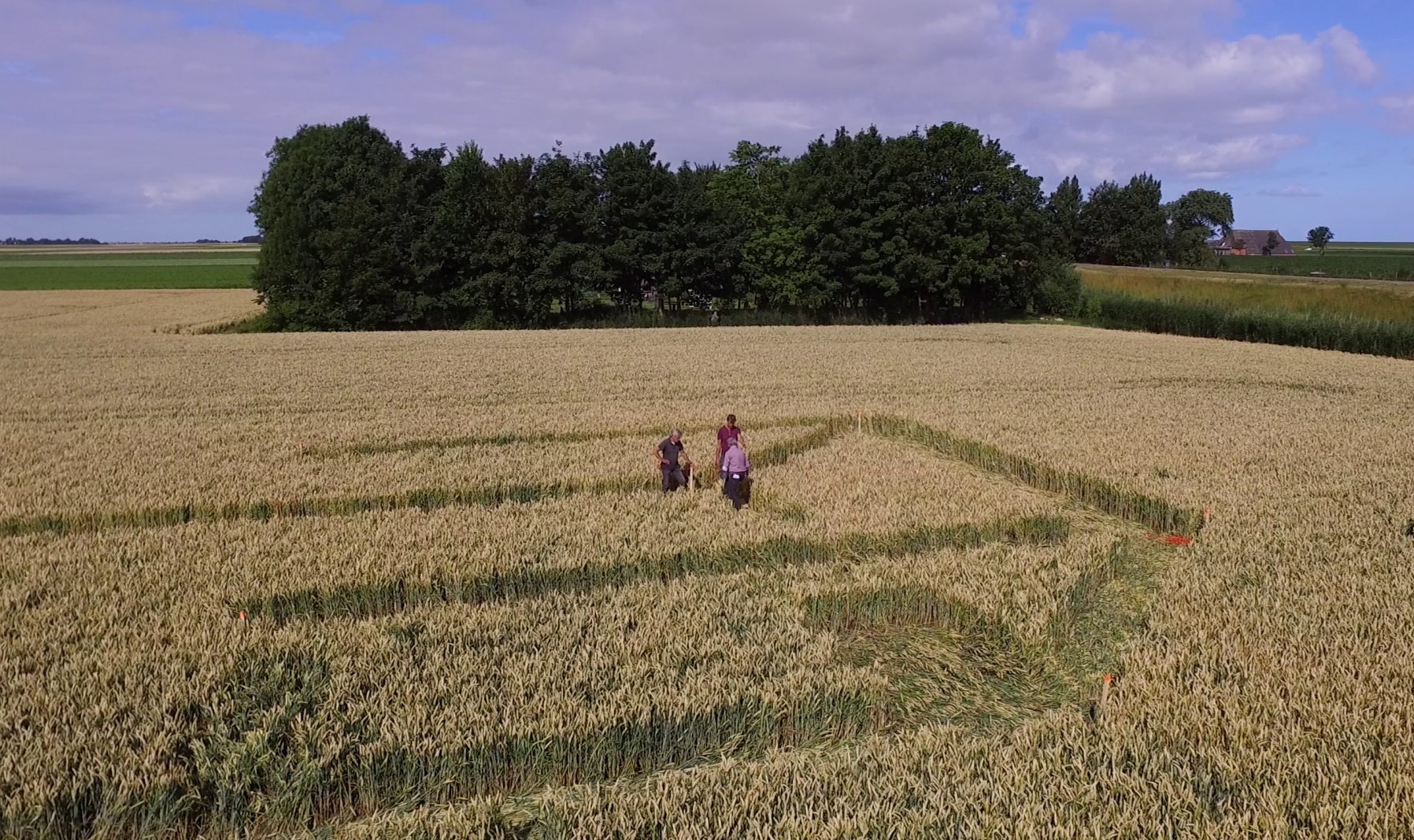
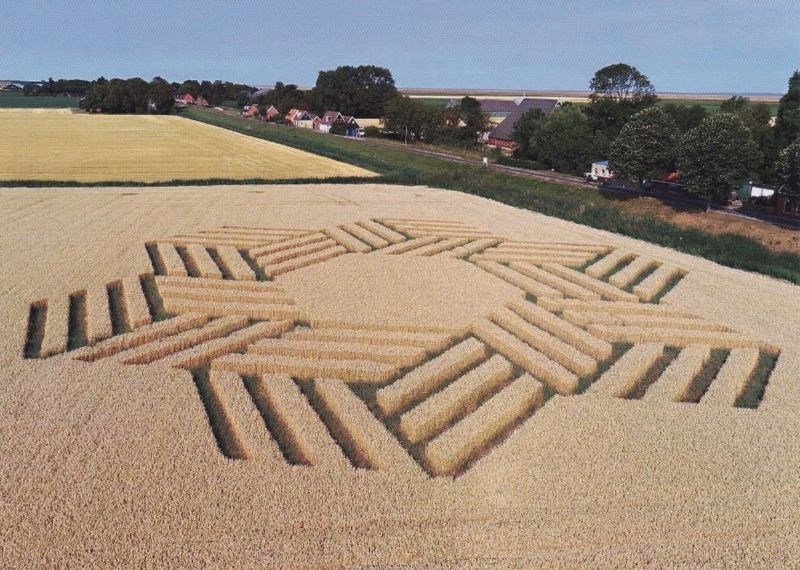
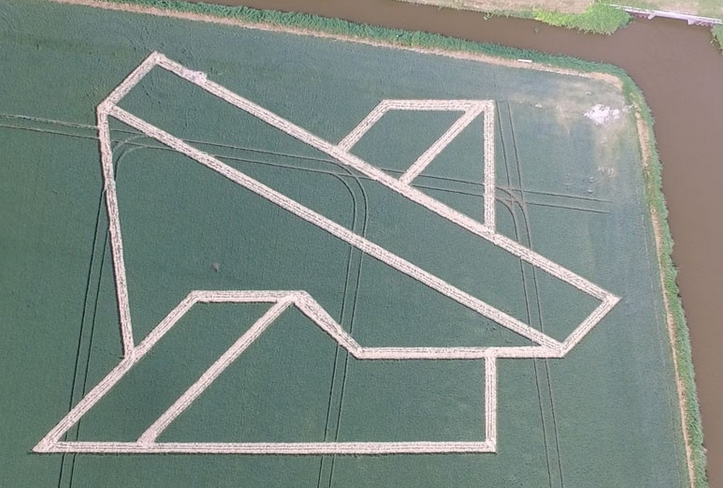
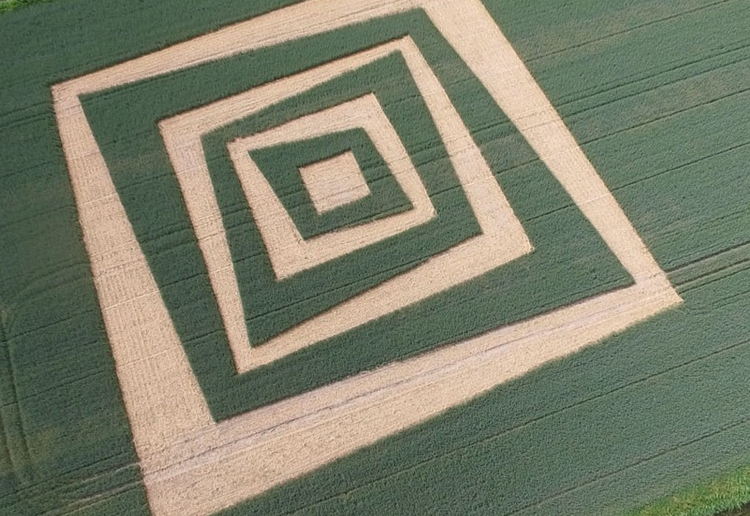
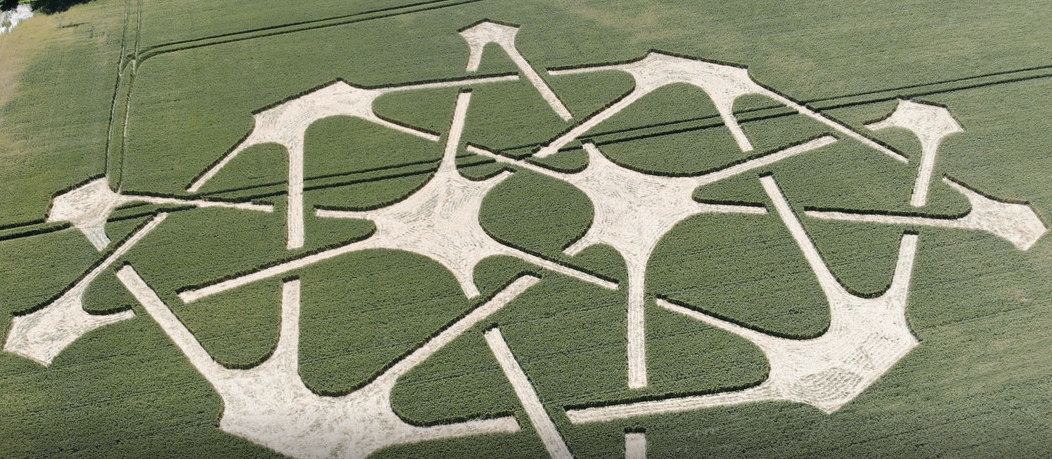
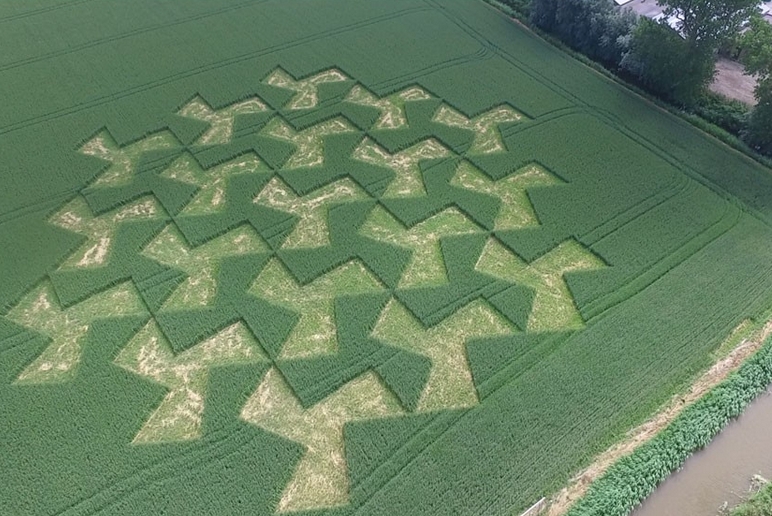
Movie Sil de Strandjutter
Lopke en Sil (Monique van der Ven and Jean Declair)
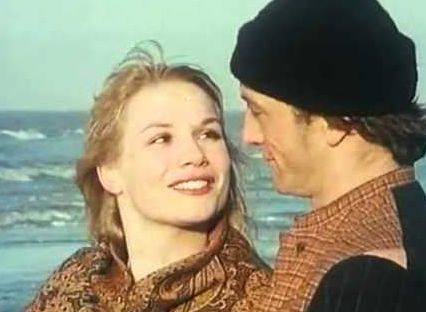
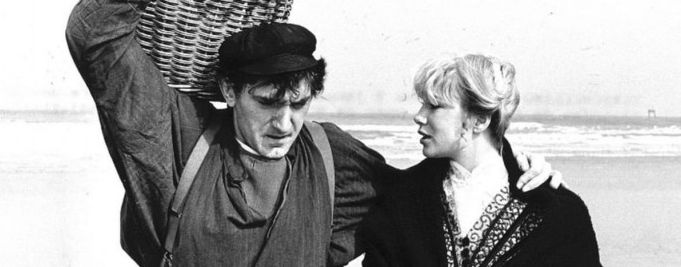
Sil de Strandjutter is a book by Cor Bruijn from 1940, illustrated by Anton Pieck, which was edited by Willy van Hemert into the television series of the same name. The television series (in seven parts) was broadcast
by the NCRV in 1976. The series is a co-production with the BRT, which explains why there is a mixed Belgian / Dutch cast. The director is Bob Löwenstein and the music is from Johnny Pearson.
The story is set on Terschelling, which was closed off from the rest of the Netherlands at the end of the 19th century. Sil Droeviger, a farmer in Oosterend, supplements his income for his family,
consisting of his wife Jaakje and sons Jelle and Wietse, with beachcombing. One day a strong storm starts and Sil rescues a girl from a sunken Swedish boat while the mother is drowning. Sil
takes the girl home and brings it up as his own daughter. He calls her Lobke, just like their daughter who died shortly after birth. If Sil comes to register her at the civil registry as his own daughter,
this causes the necessary problems. It is even more difficult for the pastor to have the child baptized, leading to a break between Sil and the church. The children grow up to be young adults.
The brothers are opposites: Jelle is a free bird, who likes to play with the girls and Wietse is gentle, calm and thoughtful. Wietse starts to think about whether juting is good; whether it is
really true that what you find can keep you. He refuses to juggle even further, much to Sil's displeasure, and leaves for the sea after a fight. Jelle then approaches Lobke. This also makes
Sil angry, he wants Jelle to marry Maam, the daughter of a friendly farmer. Jelle, however, becomes obsessed with Lobke, who repeatedly rejects him. It eventually leads to a tragedy
when Jelle walks away angry. A violent storm rages that night and a ship crashes. Jelle tries to save the crew on a horse but drowns. Wietse is coming back to stay forever.
He and Lobke now know for certain that they are meant for each other
Anton Pieck
Anton Franciscus Pieck was a Dutch painter, illustrator, draftsman, etcher and graphic artist. Pieck is best known for his romantic drawings with lively
scenes from an idealized nostalgic past and for his fairy tale forest in De Efteling 1895 -1987
Den Hague, 17 the century
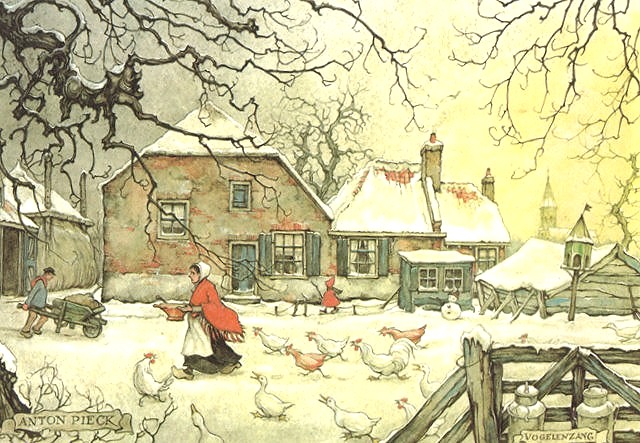
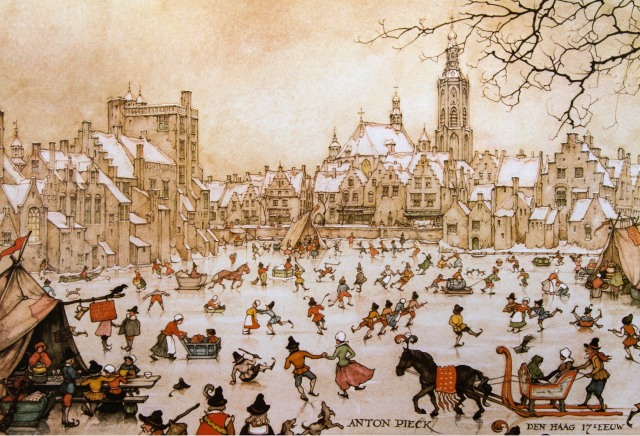
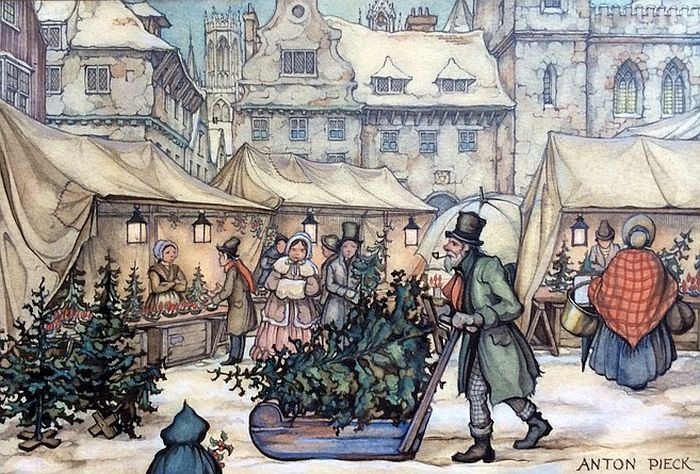
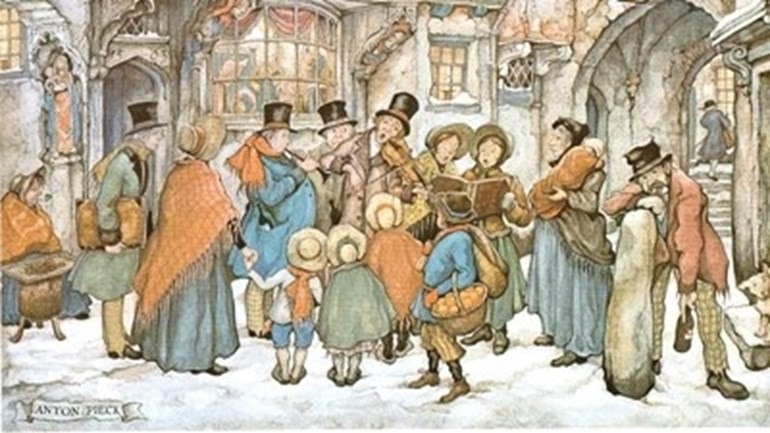
Below some of his paintings designed for the theme parc The Efteling.
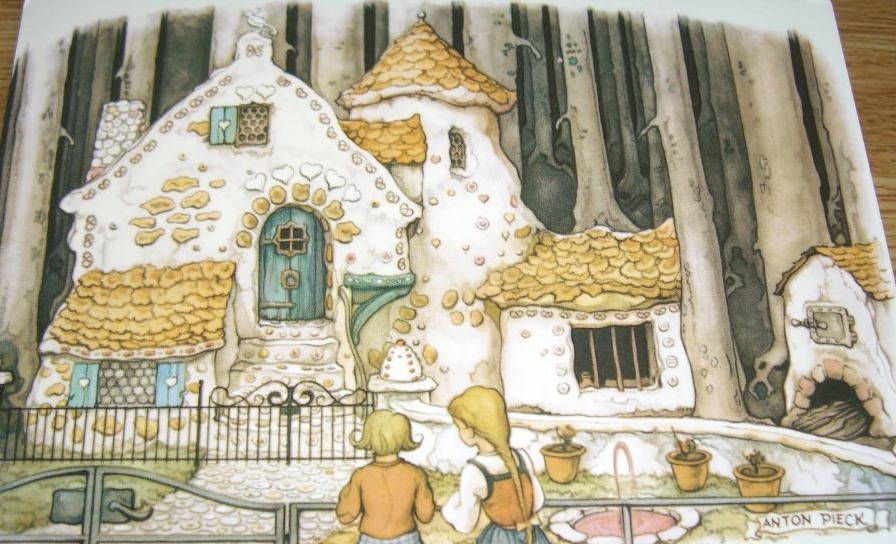
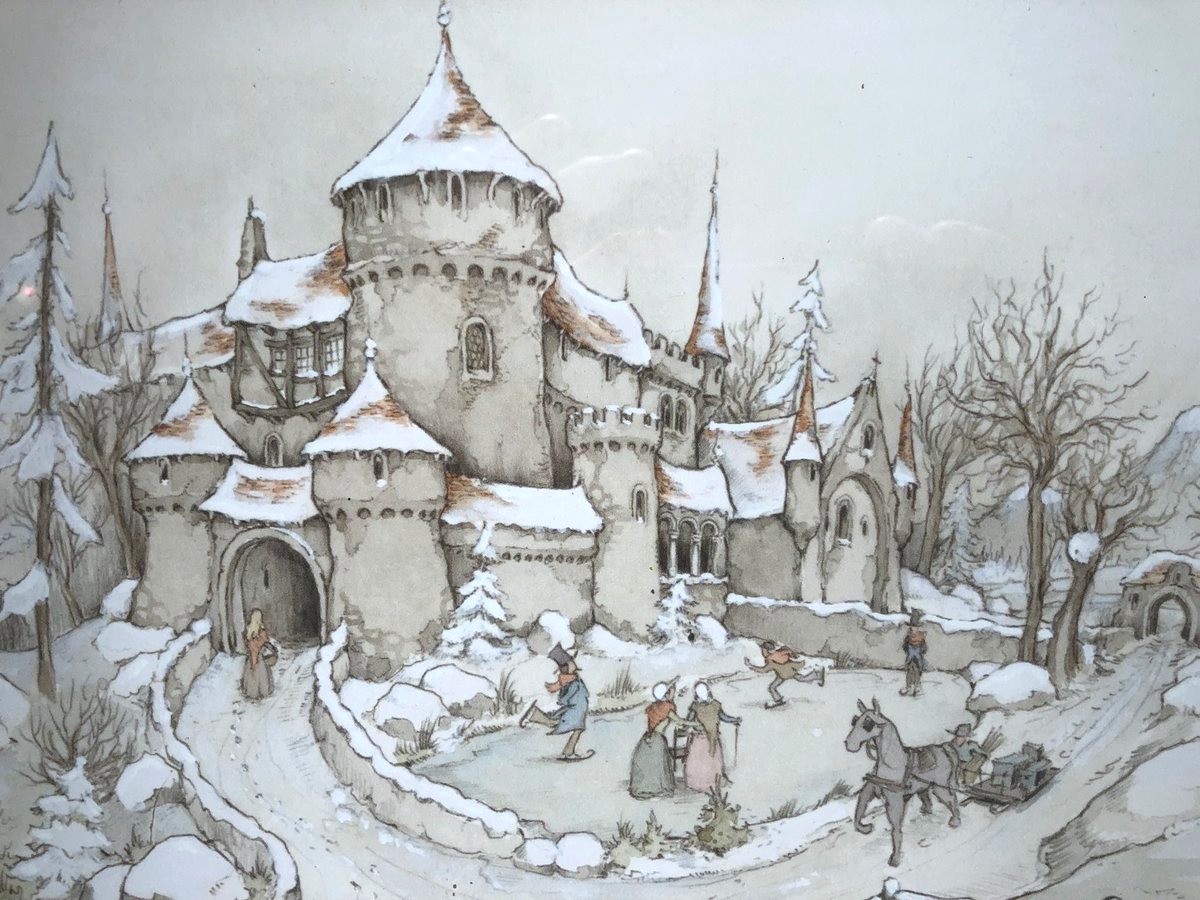
Anton Pieck was involved at the end of 1951 by filmmaker Peter Reijnders in the creation of the Fairytale Forest, the Efteling (biggest theme park of The Netherlands). He designed a dozen
fairy tales for the opening in 1952 and then made at least 1,500 designs for, among other things, fairy tales, attractions, hospitality, squares, attributes and book illustrations.
Pieck took on the design work in the Efteling until the mid-1970s. From 1975 his work was taken over by Ton van de Ven. Pieck then remained as an advisor and regularly visited
the park until his death in 1987
Pieck made illustrations that were recorded in both a Dutch and English version of "A Christmas Carol". The originals: six color drawings and six pencil drawings. Dickens was one of the
draftsman's favorite writers and the nineteenth century was the time to which he was particularly attracted.
They exude an very nostalgic and fairy tale-like character when depicting life scenes of Dutch towns, including Amsterdam and Den Hague. The typical Dutch
land/cityscape is beautifully captured.
Anton Pieck`s work reminds me of those magic winters of my childhood, with lots of snow, snow men, snow fights, beautifully wrapped presents under the christmas tree,
Sinterklaas (a tradition at 5th of december in The Netherlands and Belgium), my grandma`s cakes and their smell of cinnamon, orange and vanilla.
A short introduction to two Friesian series with our Dutch actress Monique van der Ven.
She acted together with a Crossbow actor Jean-Yves Berteloot in a Dutch movie. her husband is director and screenwriter and worked
together with Crossbow gueststar: Anton illustrated the book of Sil.
The book of Sil, illustrated by Anton Pieck
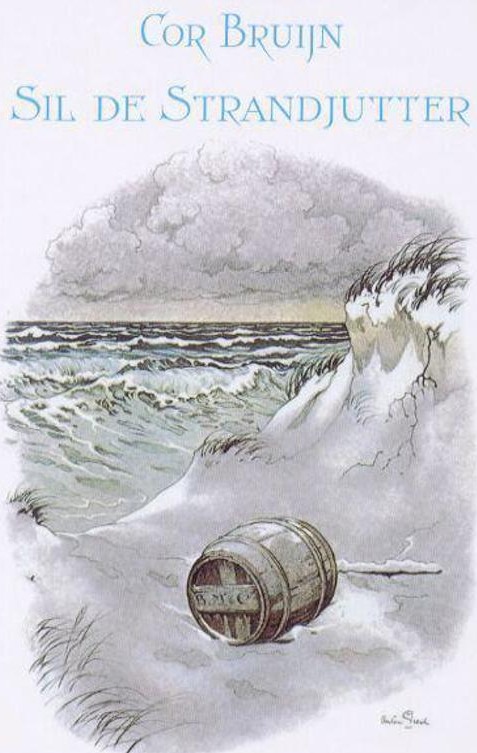
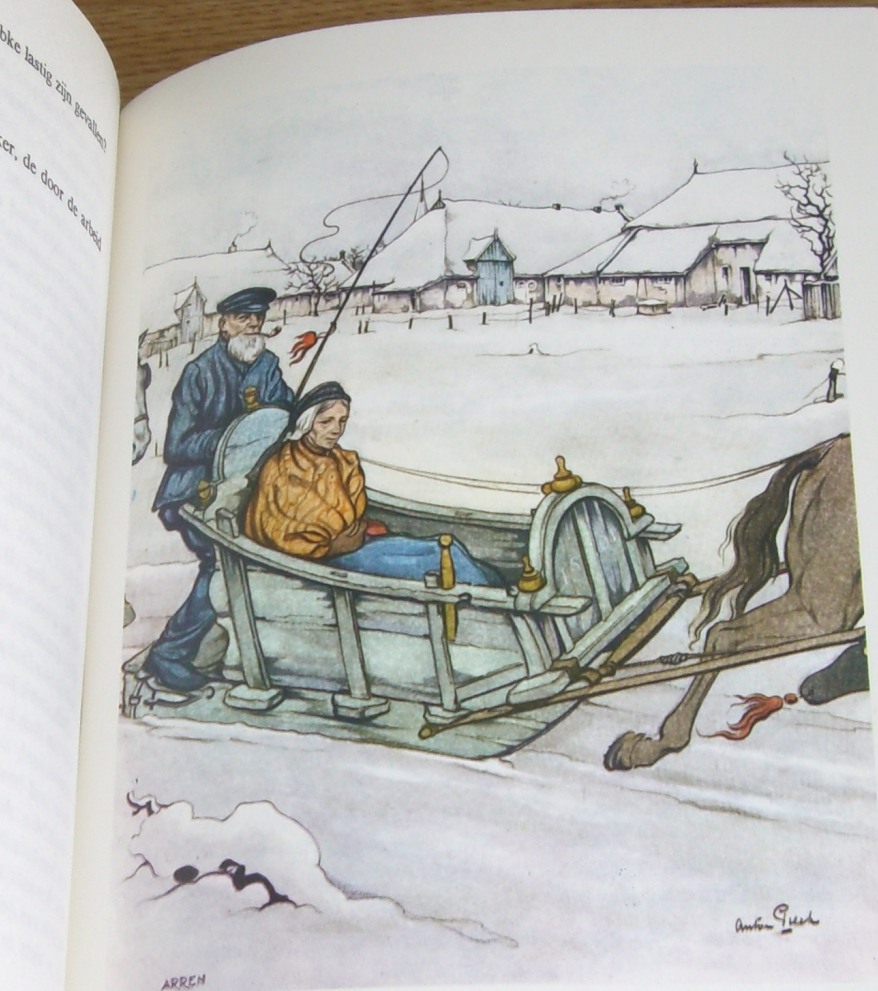
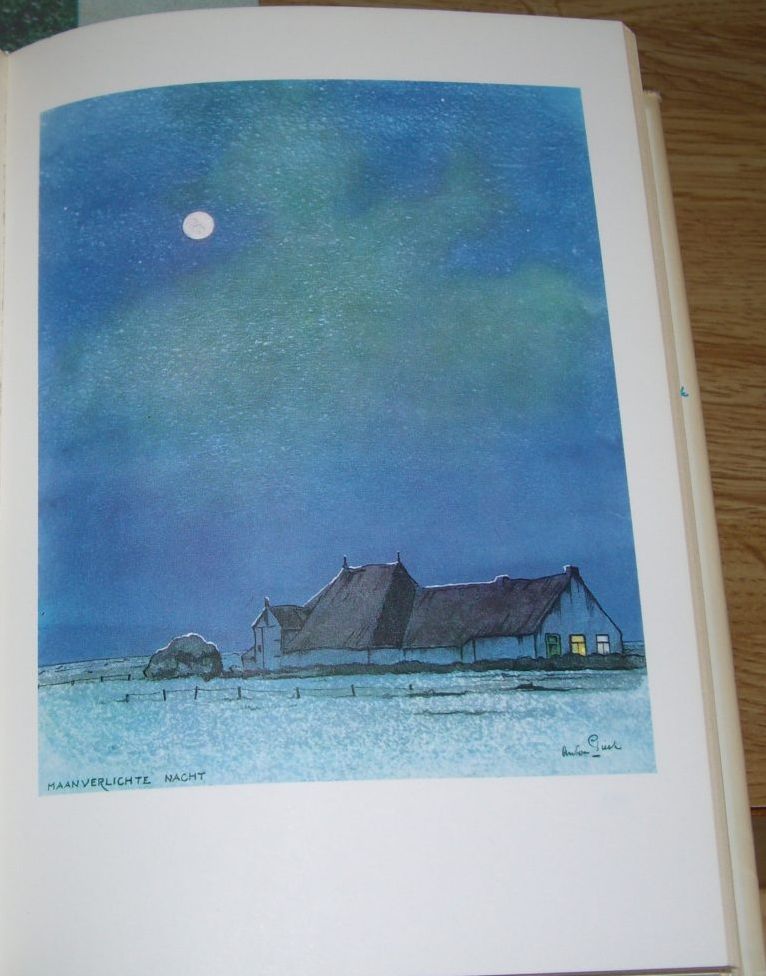
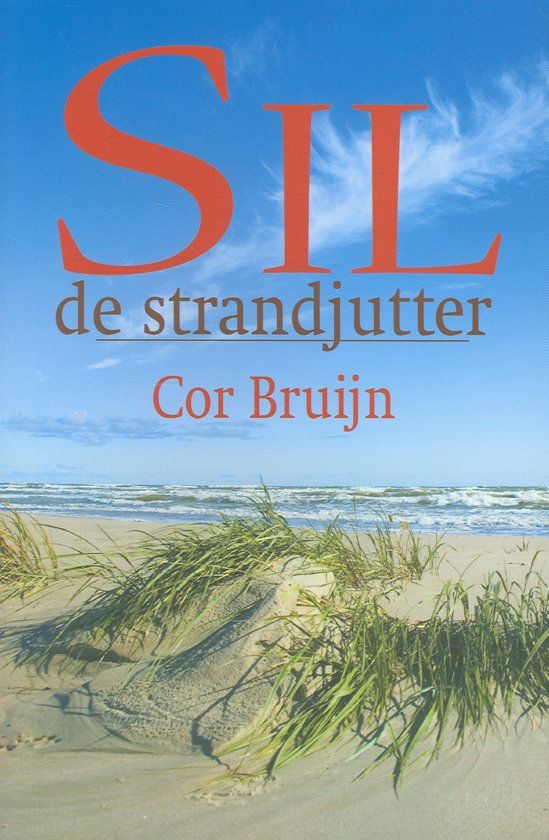
The monument of Sil on island Terschelling
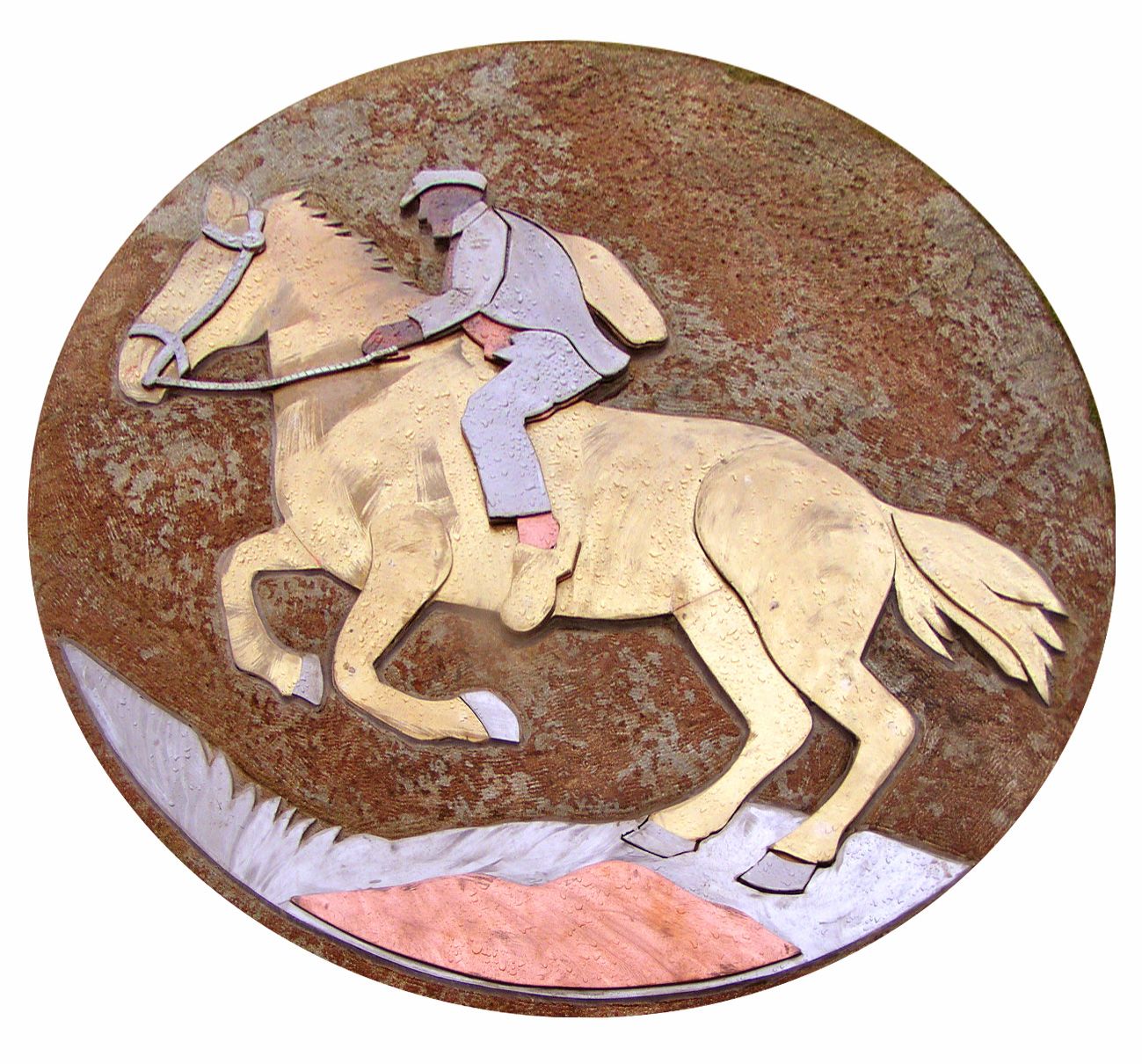
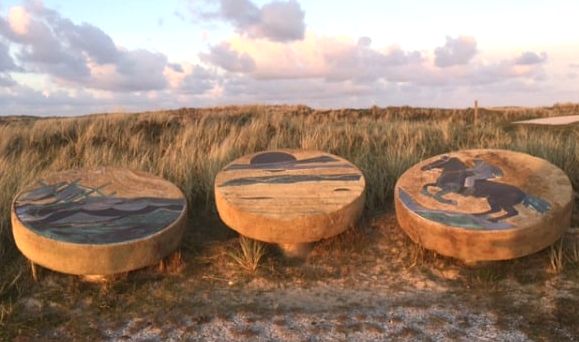
Introduction of Doctor Deen
it is quite different from everything that Monique van der Ven plays as a young actress Lobke (around 1977). Her husband Edwin de Vries with whom she has been together for 30 years, saw her in
the repetition of the series and thought how nice would it be if Lobke grew up as an island girl and is now a real woman in another time. And then also on the island next to it. This is because they
have a house there and they were happy with the good doctor who had Vlieland. His last name was Deen. As a doctor on the island you are a jack-of-all-trades, you have to be able to do everything
and in the summer season you have thousands of patients. Partly because of the toll this demands and the relocation of an entire family, finally my father did not apply as a doctor. Talented actress
Monique van der Ven took on the role of the existing doctor and her husband Edwin de Vries wrote the entire series and directed a large part. It was a great success. Small Lobke
(from neighboring island Terschelling) 'got older' and a beautiful series was launched on Vlieland with beautiful characters who experience situations that are recognizable and so real to many
people, you name it a theme such as dementia.
Monique van der Ven made two movies on the friesian island 1977 'Sil de Strandjutter' and around 2012 'Doctor Deen.'
Jean-Yves Berteloot was in Crossbow episode 'Masterplan' he acted together with Monique in a Dutch movie called A month later/ een maand later. A comedy about changing lovers for
one month. And Monique's husband Edwin (director and actor) worked together with another Crossbow actor.
Jean-Yves Berteloot, was in Masterplan, Crossbow
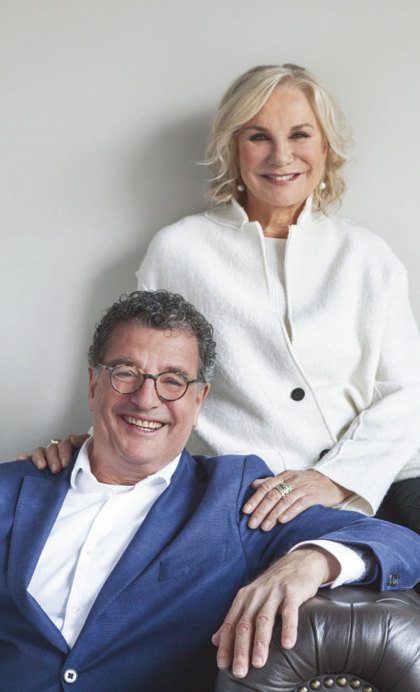
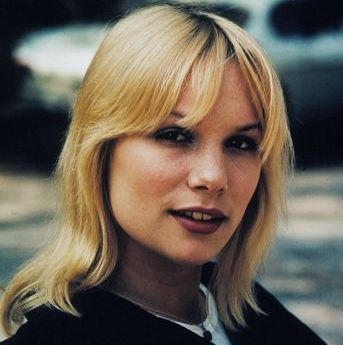
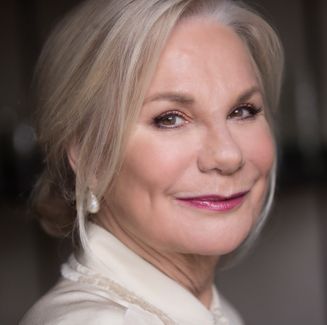
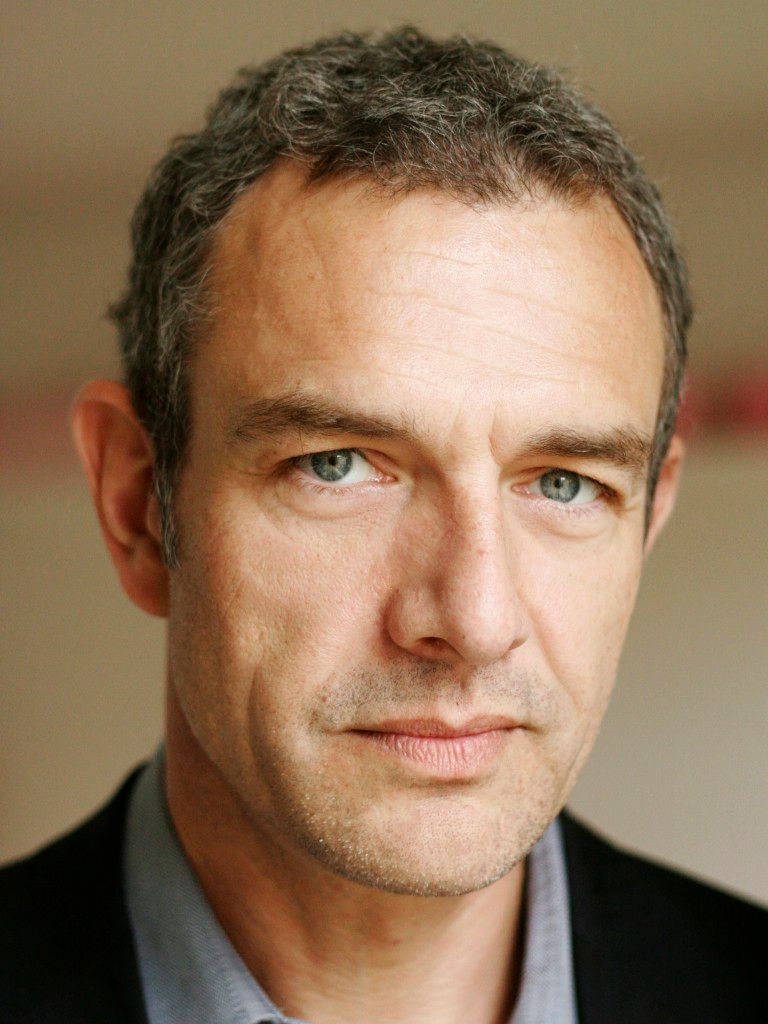
Edwin de Vries (photo left above) is married to Monique van der Ven. Edwin is an actor, director and screenwriter. At the age of twelve he debuted alongside his father,
the actor and resistance hero Rob de Vries, in the film 'The Last Passenger'. He became known to the general public for his role in the television series 'In de Vlaamsche pot'.
De Vries also acted in films. He played alongside Monique van de Ven - his later wife - in 'A month later'. He is currently playing with his son Sam in 'Westerbork Serenade',
a play about the life of his father who managed to smuggle a girl from camp Westerbork.
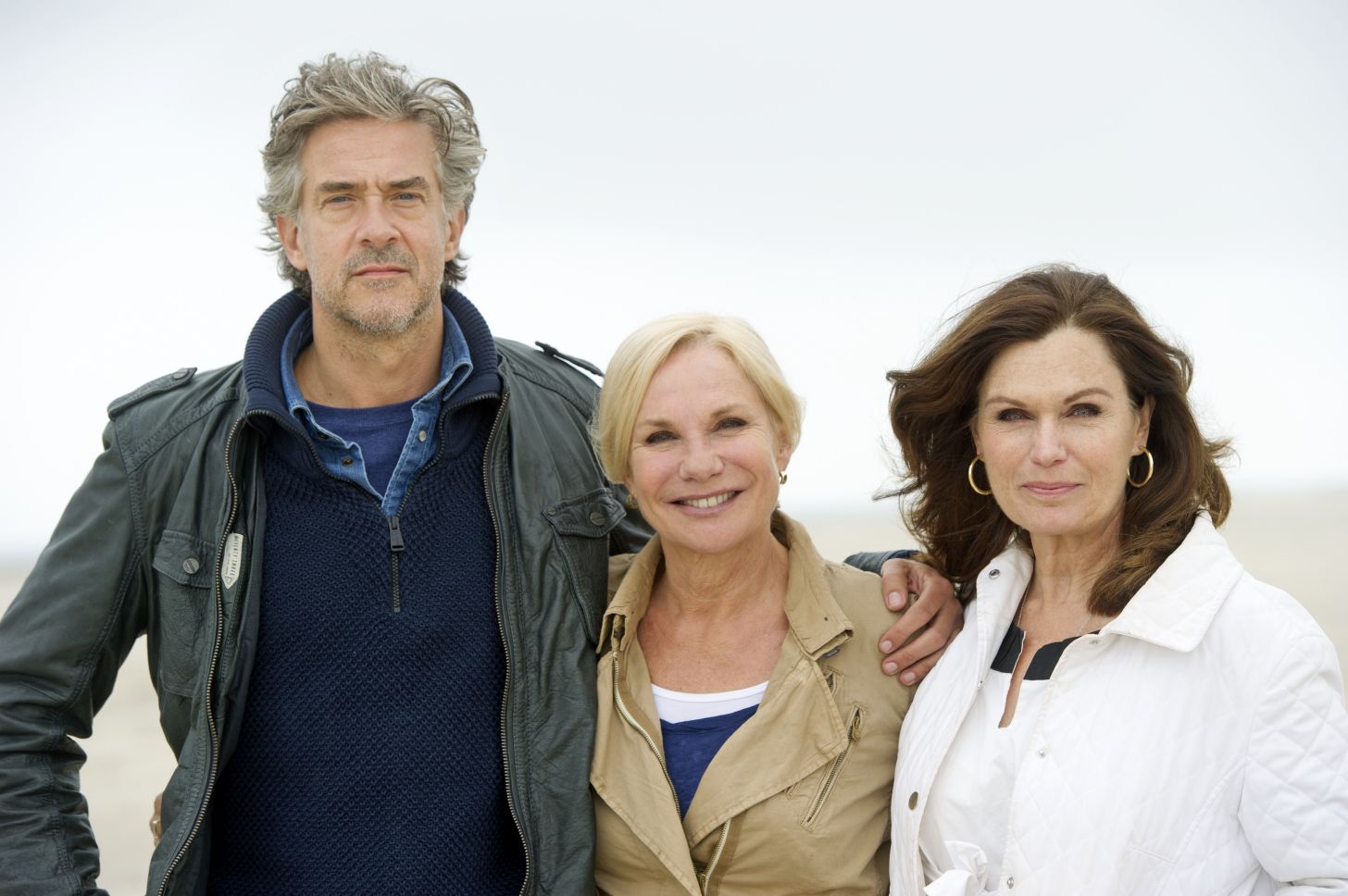
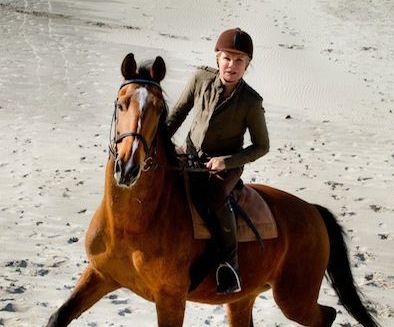
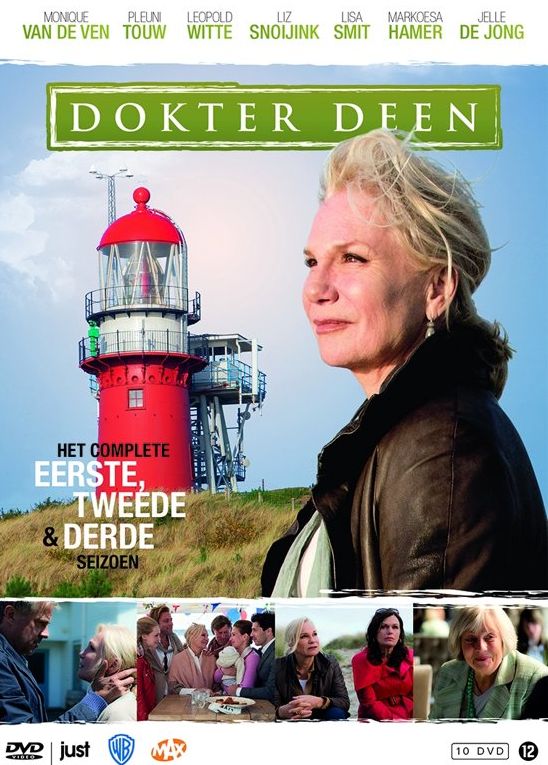
Doctor Deen is about a woman who became an island doctor. The island has 1200 inhabitants/patients but during the summer each year 155.000! You always need to stand by and you have to be a general practitioner, dentist and veterinarian. As a doctor on a remote island you are much more than just a doctor. If the need is there, the doctor is also called in in other situations. It's not a bad idea to make a series about it ;)
Monique and Edwin are connected to Vlieland by the fact that they have a holiday home there and come over frequently. And just like many people from Vlieland they have come into contact with John Deen in the past. My father also considered applying before Jhon was appointed as a doctor around '91, but ultimately did not choose this job due to the isolated position of the island and the long crossing by ferry. I am happy afterwards because Vlieland is small, but I am sure he would be greatly appreciated there.
Doctor Deen drama series shot on the island Vlieland It's a Dutch drama series by Omroep MAX, written by Edwin de Vries and Simone Kome van Breugel. Edwin de Vries got the idea for the series when his wife Monique van de Ven almost cut off her thumb and was operated on by the real Doctor Deen on Vlieland. In addition, the island of Vlieland and its colorful residents play an important role.
Sports
Kaatsen
Frisian handball (West Frisian: keatsen; Dutch: kaatsen) is a traditional Frisian sport, related to American handball and fives, that is most commonly practiced by people from the northern
Dutch province of Friesland (Fryslân). It is believed to be one of the oldest ballgames and was an unofficial demonstration sport at the 1928 Summer Olympics in Amsterdam.
The score is similar to tennis. The first team scoring six games wins the match.
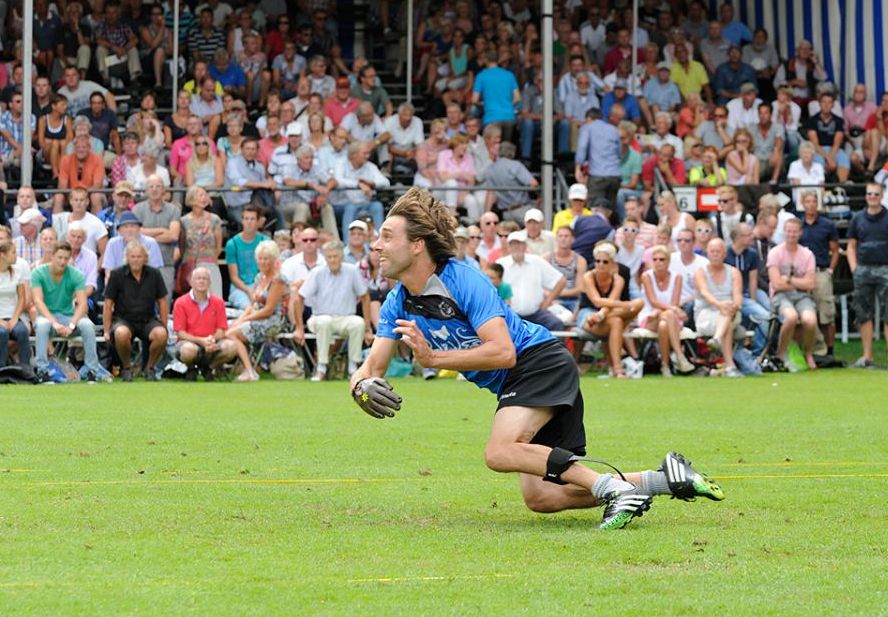
Fierljeppen
Fierljeppen (originally: graceful jumping)
Fierljeppen (West-Frisian compound of fier—"far" and ljeppen—"leaping") or polsstokverspringen is a traditional sport of the West Frisian people in the Dutch province of Friesland.
The sport is nowadays also popular in the province of Utrecht which produced record holder Jaco de Groot. The sports has been added to Dutch Intangible Heritage (is 'levend erfgoed'.
Het omvat sociale gewoonten, voorstellingen, rituelen, tradities, uitdrukkingen, bijzondere kennis of vaardigheden die gemeenschappen en groepen (en soms zelfs individuen)
erkennen als een vorm van cultureel erfgoed).
Description
The sport involves a long pole and a body of water. The pole is between 8 and 13 meters (26 and 43 ft) long and has a flat round plate at the bottom to prevent it from sinking into the
muddy river or canal bottom. A jump consists of a sprint to the pole (polsstok), jumping and grabbing it, then climbing to the top of the pole while trying to control its forward and
lateral movements over a body of water, and finishing by landing on a sand bed opposite to the starting point.
History
Due to considerable parts of the Netherlands being under sea-level, it has many waterways. Fierljeppen originated as a way for Frisian people to get around the waterways easily.
Over time it turned into a competition with the first official match in 1771 but the sport was not properly structured until 1957. The sport is believed to have originated with farmers who used
poles to leap over small water drainage channels to access different plots of land. In the German region of East Frisia this sport is known as Pultstockspringen. Today the sport is primarily
practiced for fun or to entertain tourists, but there still is an official annual National Fierljepping Manifestation (NFM) in the Netherlands, and championships are contested in six leagues and numerous clubs.
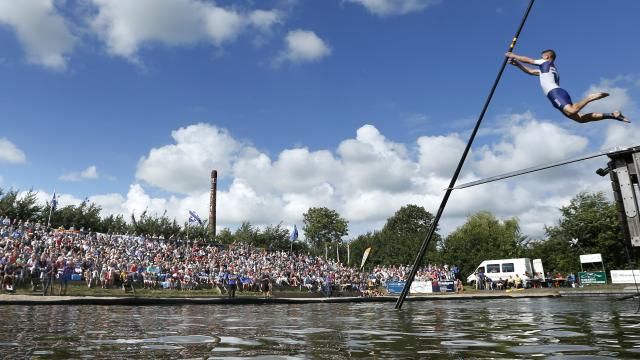
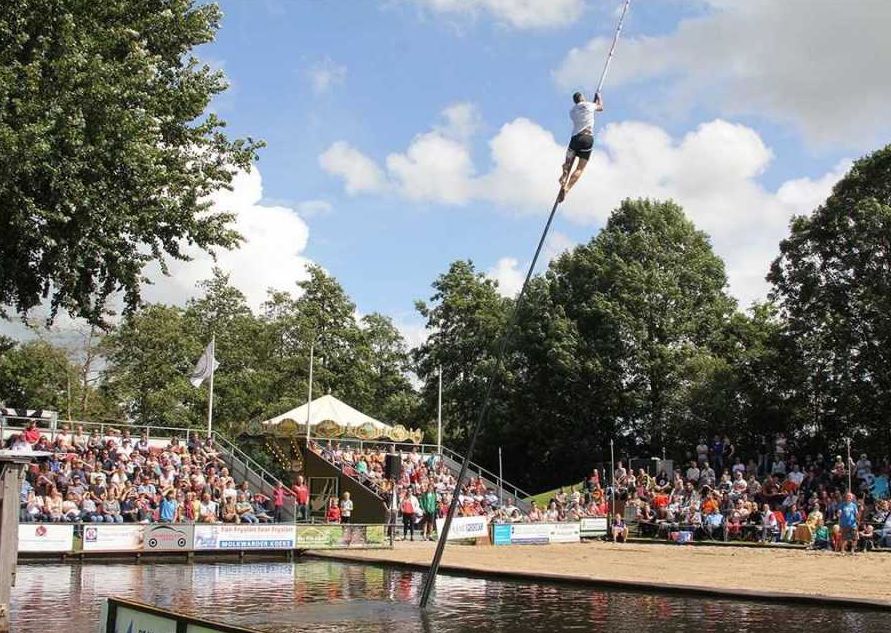
I think this sport is intensive and not entirely without risk. It is estimating, running, fast climbing and jumping far in 1. The landing is sometimes from such a great height that I am always surprised that it went well.
Ringsteken / Ring riding
Germany and Denmark, photo Jutland The Dutch Ringriding of Germanic peoples, 1863
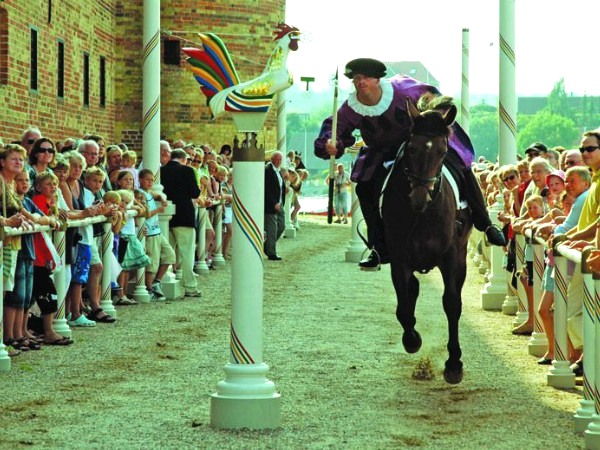
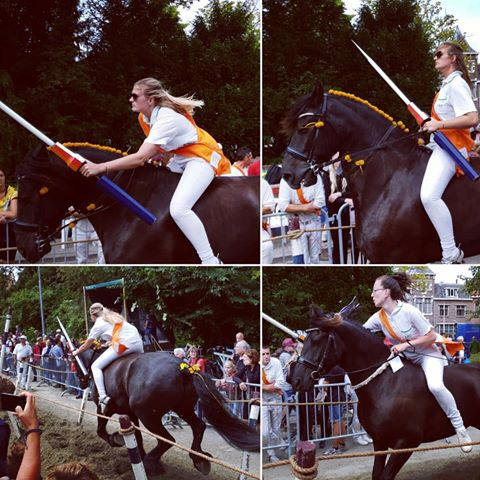
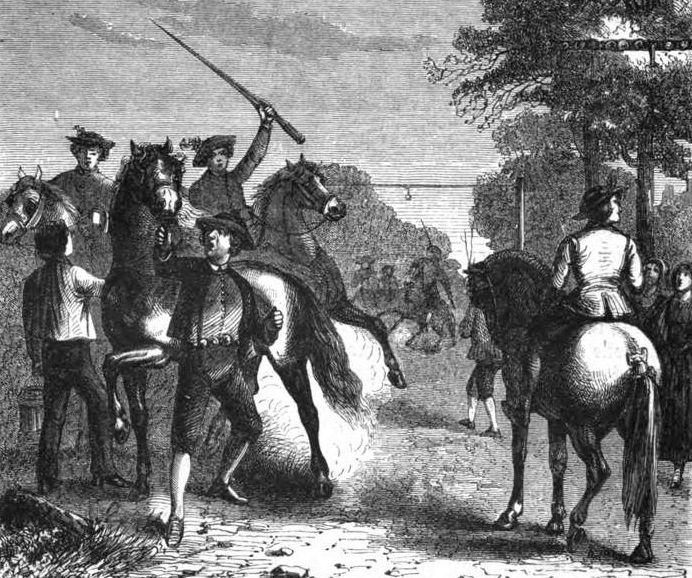
Ring riding or stabbing is ring driving, where as many rings as possible are put. The participants appear in beautiful old Frisian costumes and ride with a beautiful drive.
The folkloric ring stitches is a unique spectacle.
Ring-stabbing or ring-riding is a folkloric tradition in which people, seated on horseback or from a catch, try to stab a lance through a ring. This tradition, which is practiced as a sport in
some regions, occurs in parts of the Netherlands, Germany and Denmark (in Jutland, see the picture left). Some ring-stitch competitions (for example the Middelburgse)
succeed in attracting a lot of tourist interest.
In West Friesland, the participants are seated in a barrel tensioned with a Friesian horse. Next to the driver of the 'sjees' is the person who holds the ring stab lance and sticks the rings.
This form of ring stitches is more focused on the folkloric aspect. The ring stitches originated a few centuries ago as a game at annual fairs, where all farmers gathered. Nowadays special
events are often organized for this or the ring sign is performed on Queen's Day. It is often accompanied by other folkloric display, such as a parade with historic farm wagons or
a market with old crafts and traditional costumes.
Ring-riding is one of the oldest forms of equestrian sport in Friesland. The rings are inserted from hands which are arranged on the right side of the course. There is a magnet
in the hands so that the ring does not fall out. The ring is inserted with a wooden gun. The rings should be clearly positioned around the baton and thus be shown to the jury.
There must be a fast pace, canter is not allowed. Is driving too slow or does one have too much canter? then penalty points are awarded. In order to prevent a discussion about
whether or not to drive too slowly, the time of all participants is recorded and written down during the ring driving so that this can be shown to the participants after the race if there is any discussion.
Horse and carriage When it's a cold winter, they can do ring riding by horse and sleigh. This is at Terschelling.
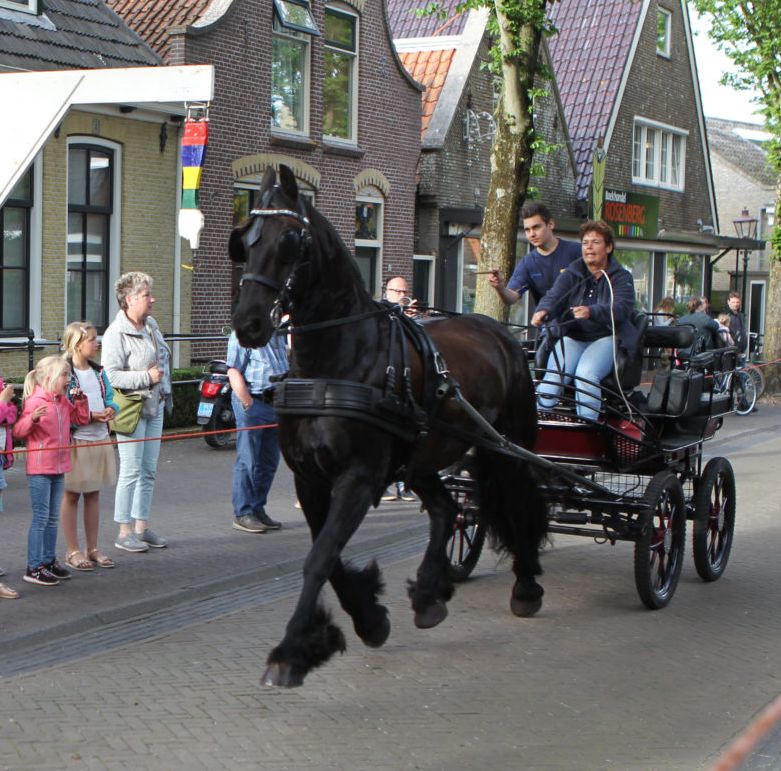
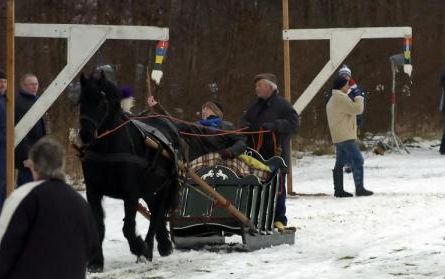
The HT race
(Harlingen-Terschelling race) is at sea with big rowing boats from Harlingen to Terschelling).

It is the weekend of the race of races: the HT-rowing race. From Harlingen to Terschelling. A long trip over the most beautiful water in the Netherlands, the Wadden Sea. Where the sloops,
accompanied by seals and many other ships, have to be steered between sandbanks over the salt water through venomous currents with the Terschellinger Brandaris (lighthouse) fire
hours as a beacon. Nobody knows how heavy the 34 kilometers will be, because the unpredictable Dutch weather determines here. Arisen from a challenge between two Terschelling
sloops in 1975, the race has since grown into a cult. What is true about the heroic stories about heavy hours of rowing in wind force 5 and waves coming in over the bow? About hard rowing
and hardly getting ahead due to the opposing current? How does the euphoria feel to arrive at Terschelling after 34 long kilometers along with many sloops? And the solidarity by undertaking
such a joint mission? Do you want to participate? A place on the starting list is not self-evident these days. The 130 starting numbers were acquired over the years by a huge mix of sloops
that have been licensed to participate annually. The waiting time to obtain such a license is long and there is hardly any room for more sloops to participate. In order to give this growing
sport the chance to participate (once) in the HT race, a few highly sought after wildcards are issued each year, but only to authentic sloops because fast high-tech sloops do
not belong in this traditional race. Below some photos.
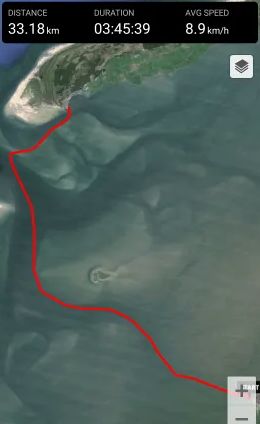
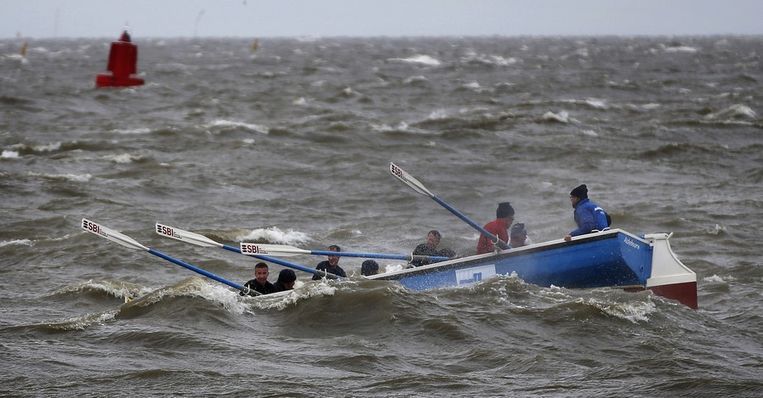
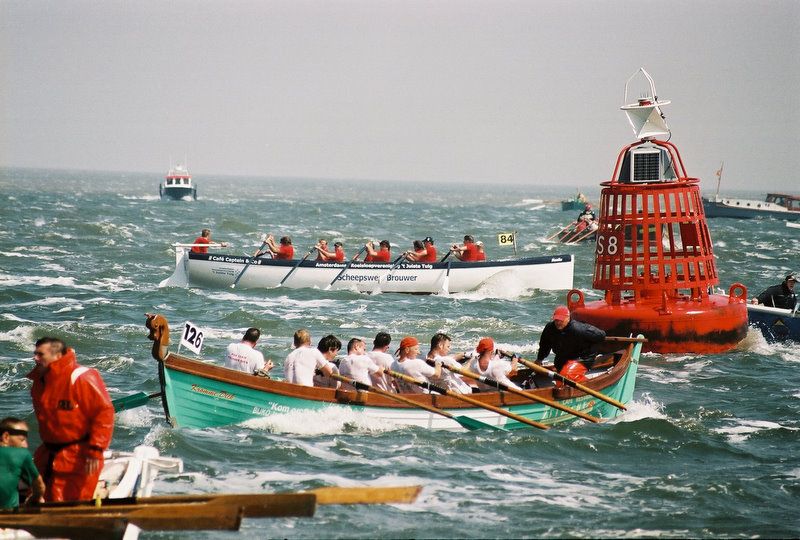
Terschelling in the back
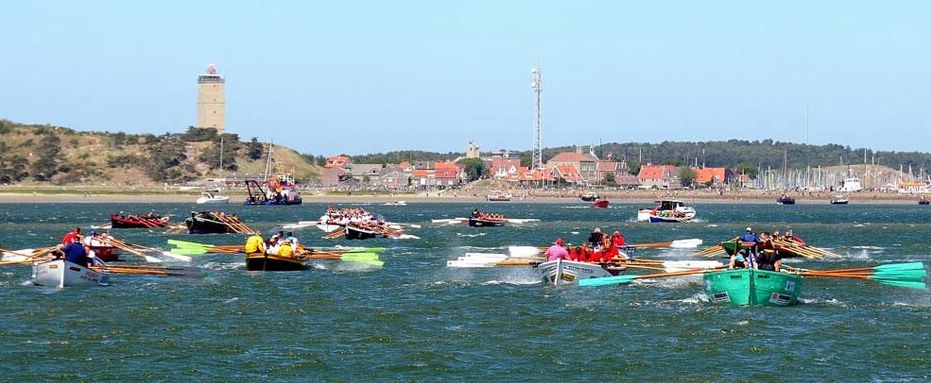
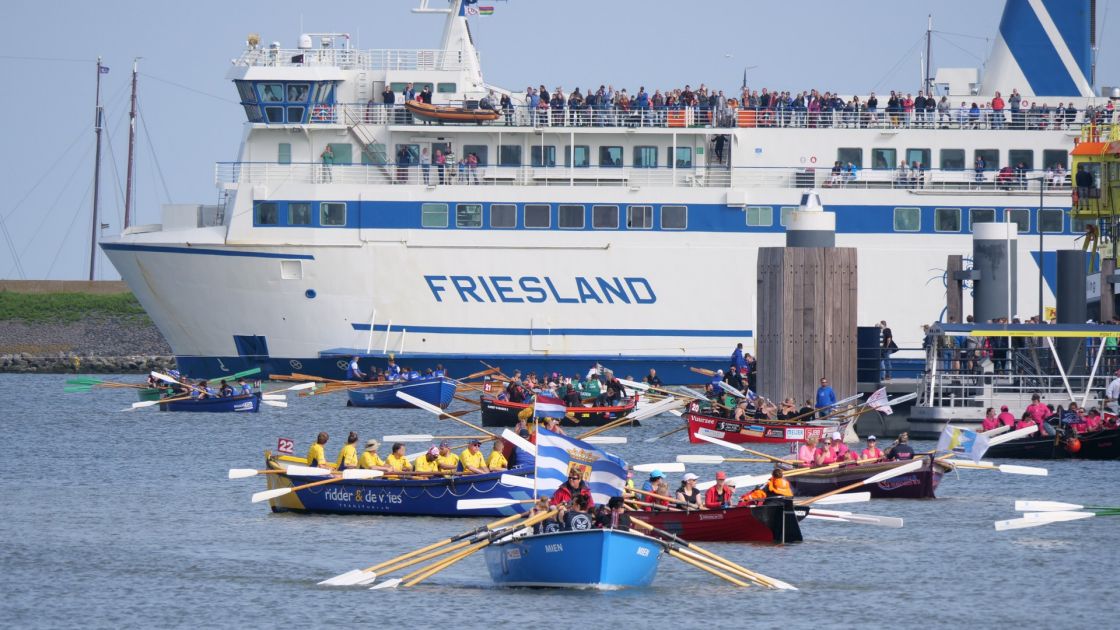
Extra photos of the Fries
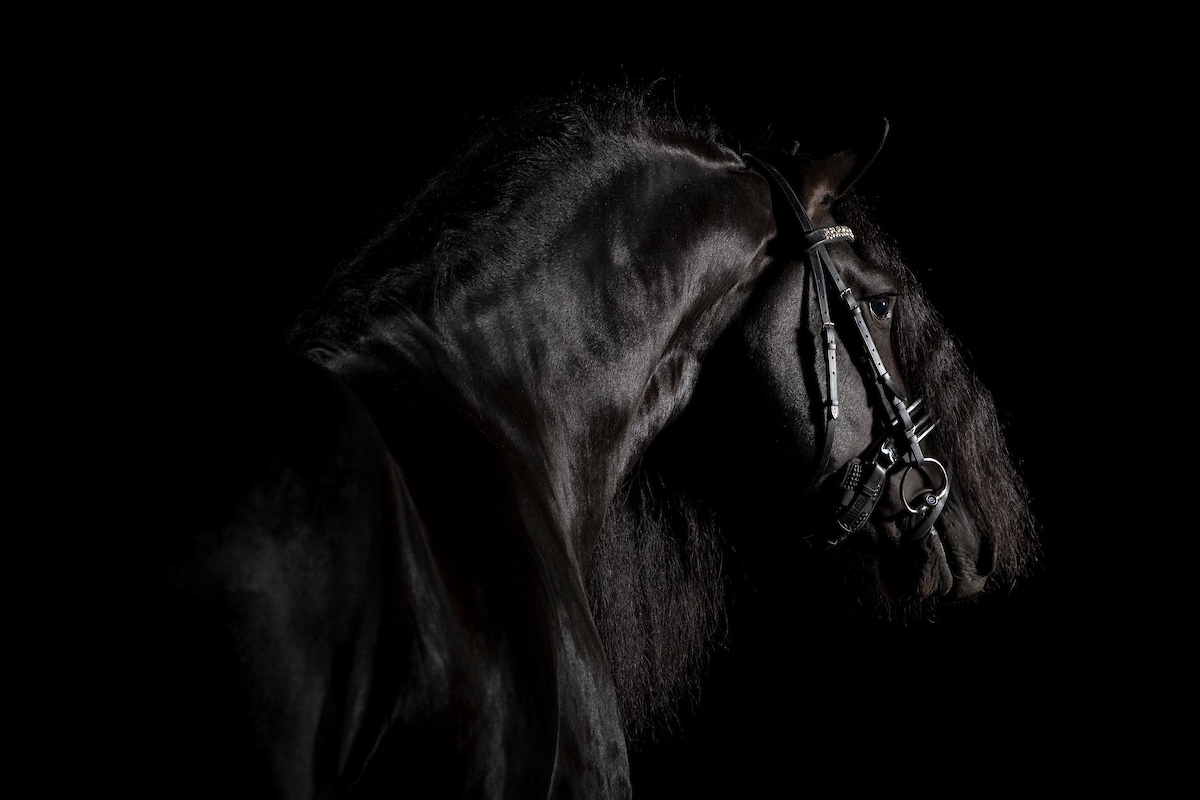
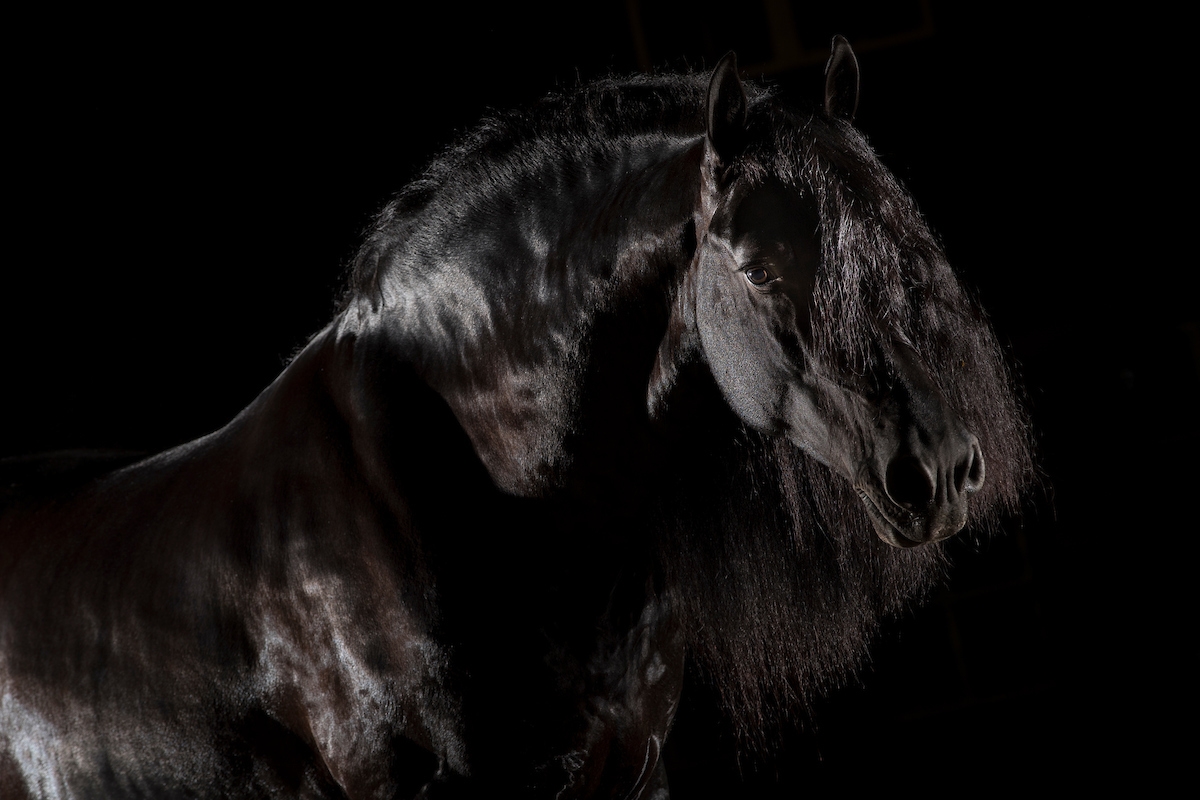
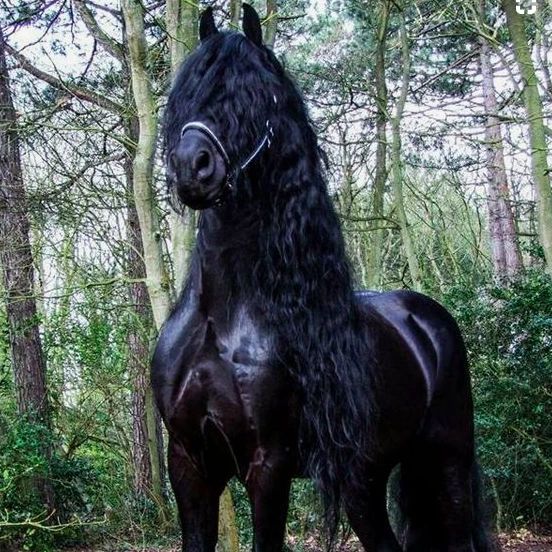
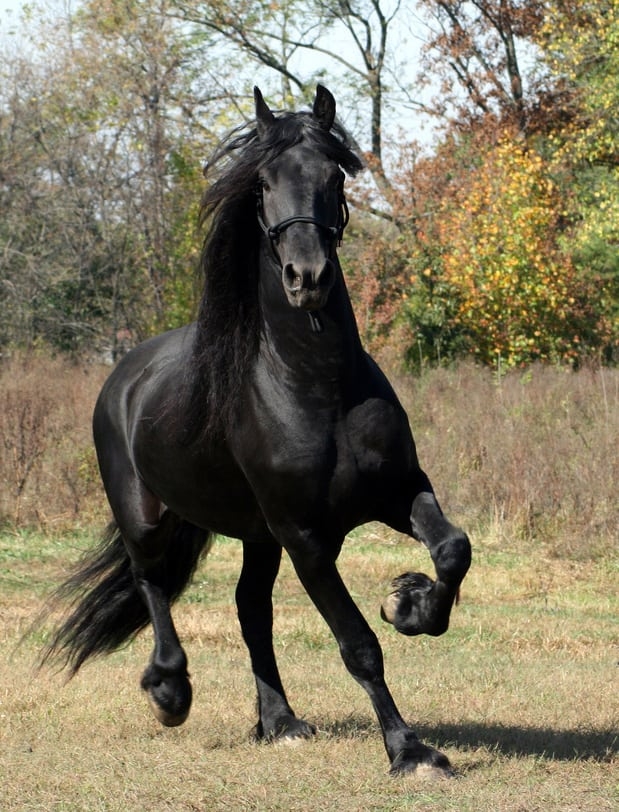
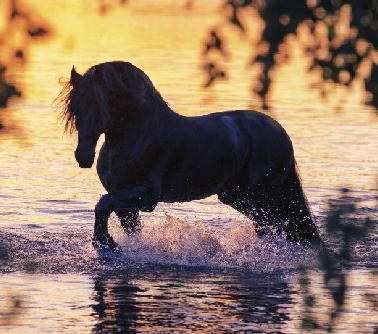
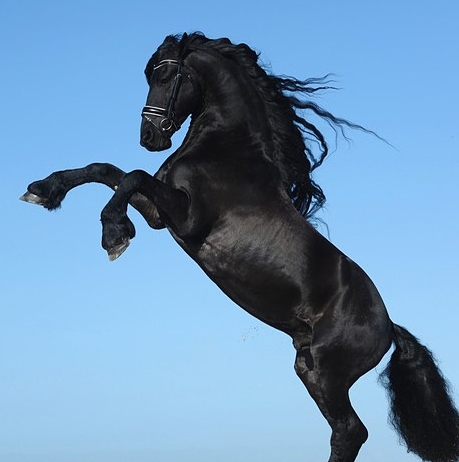
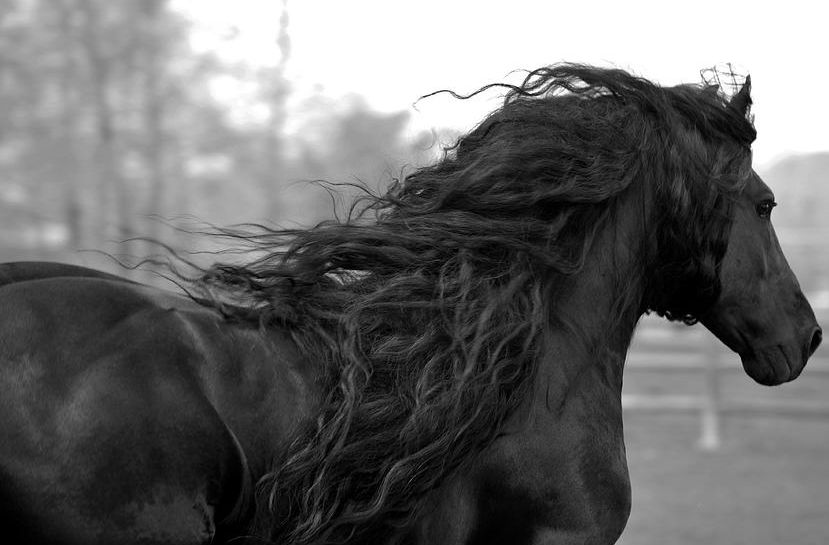
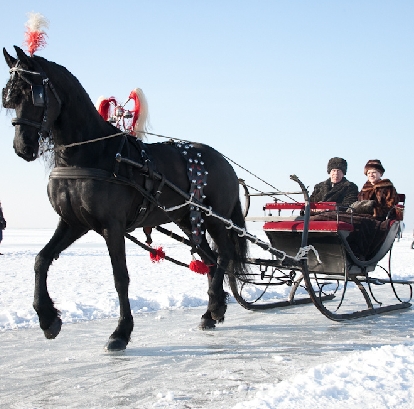
2019